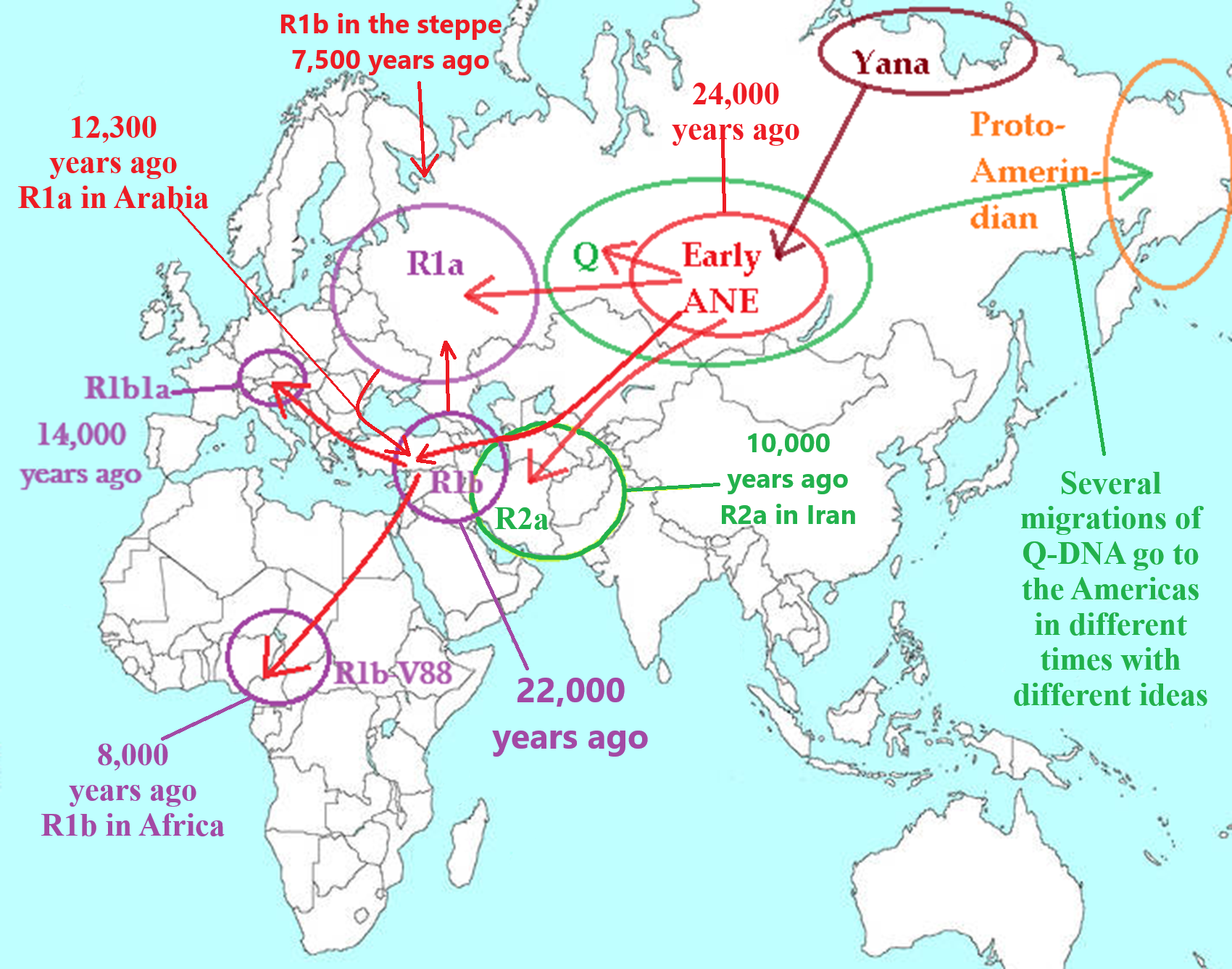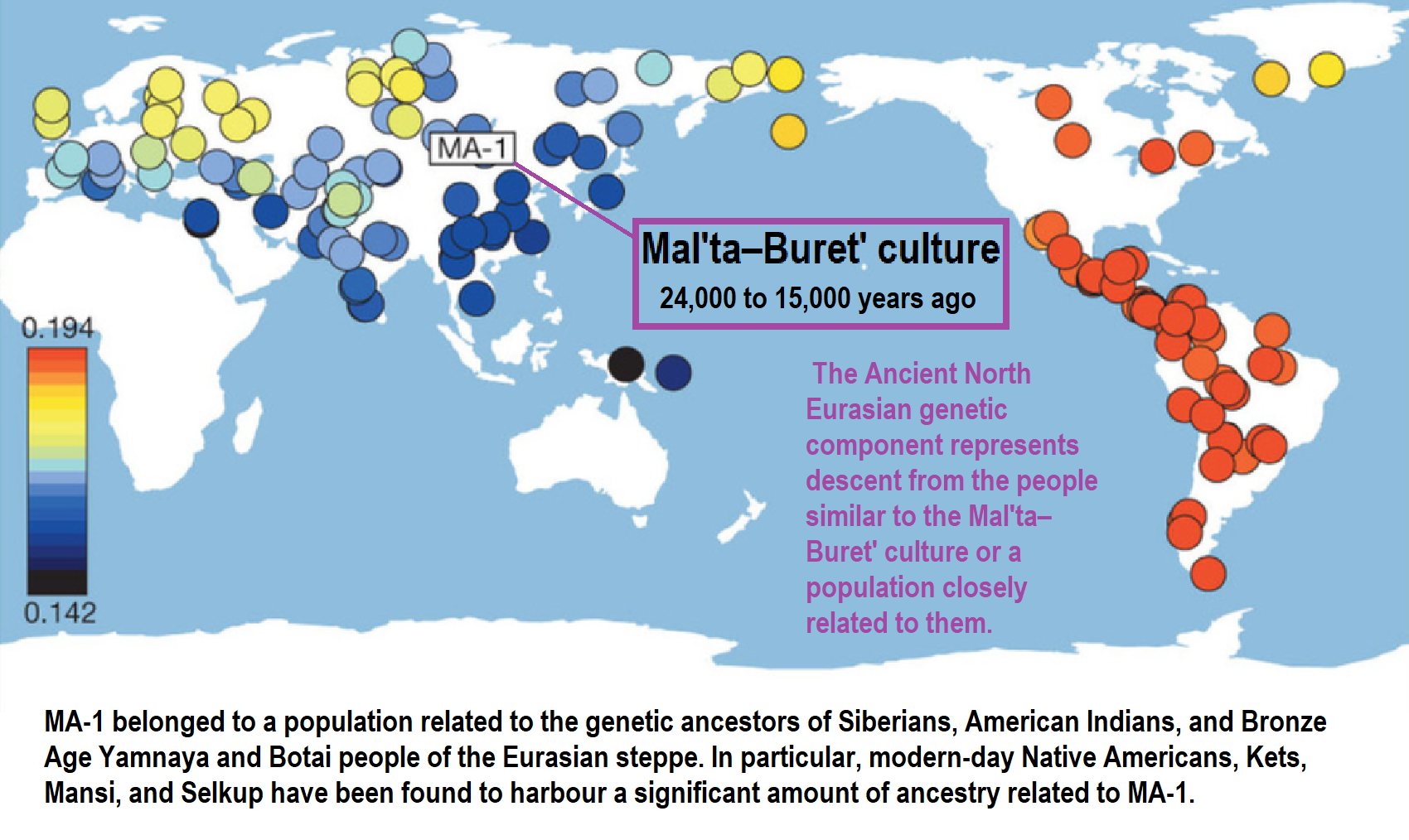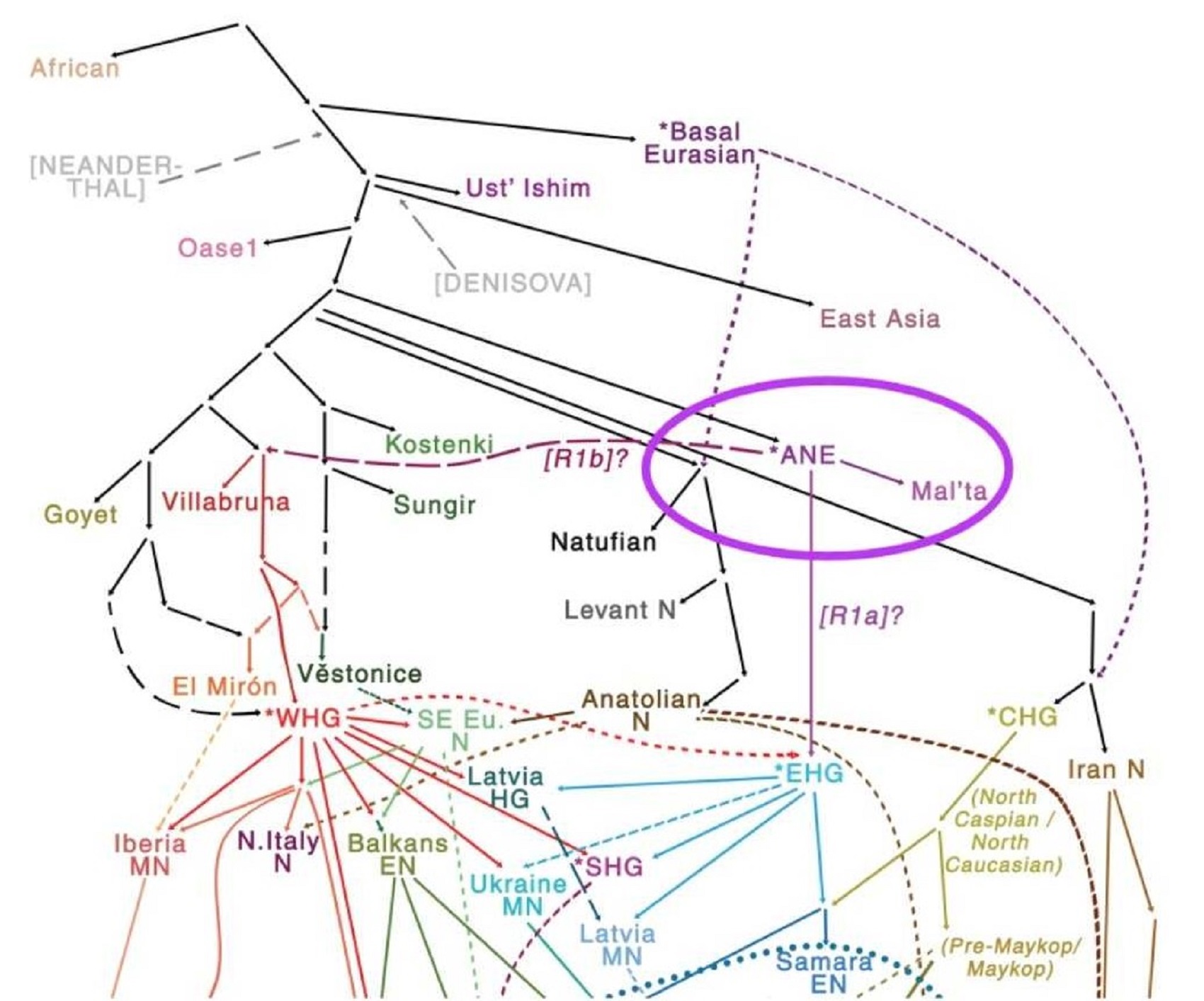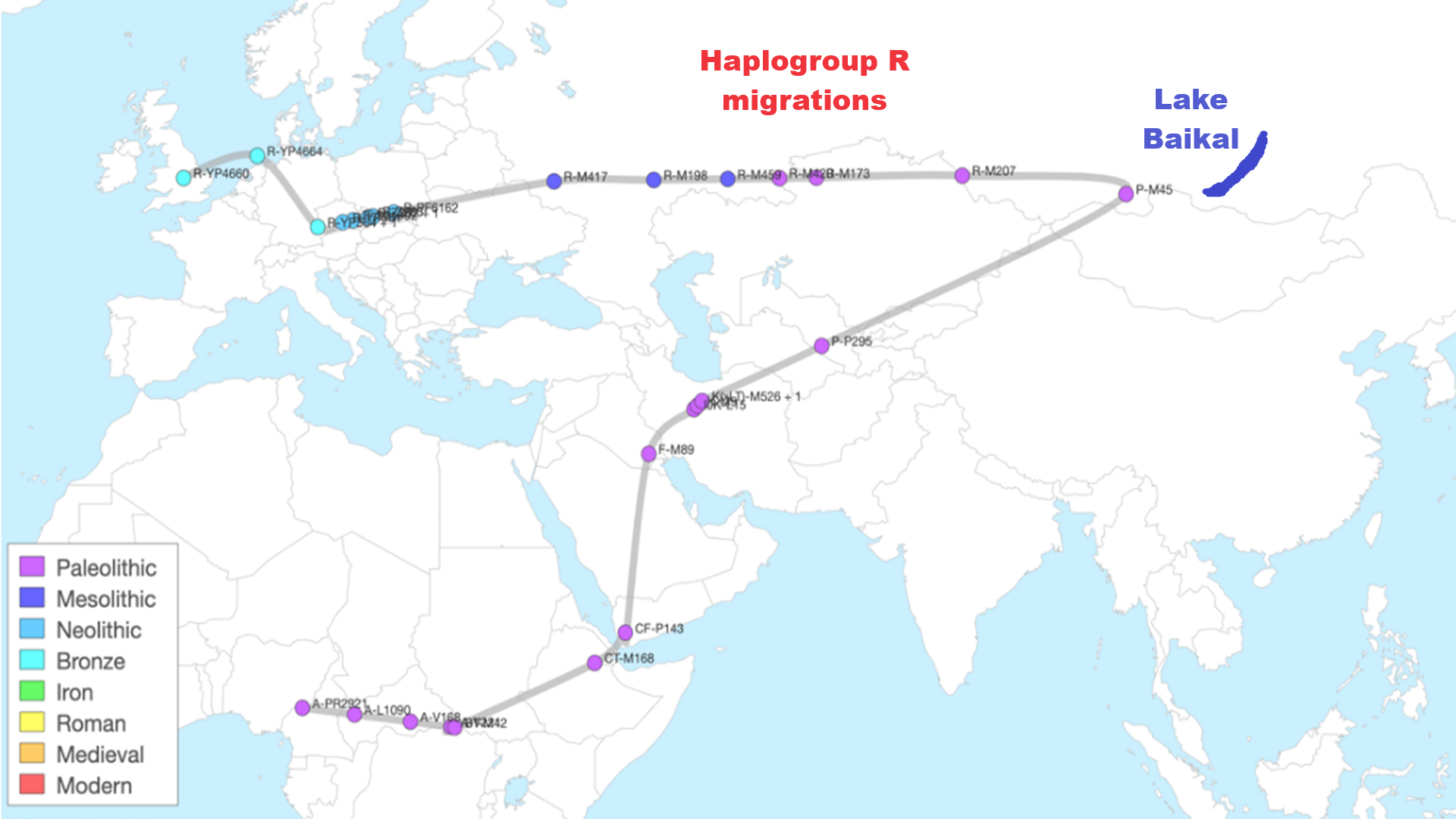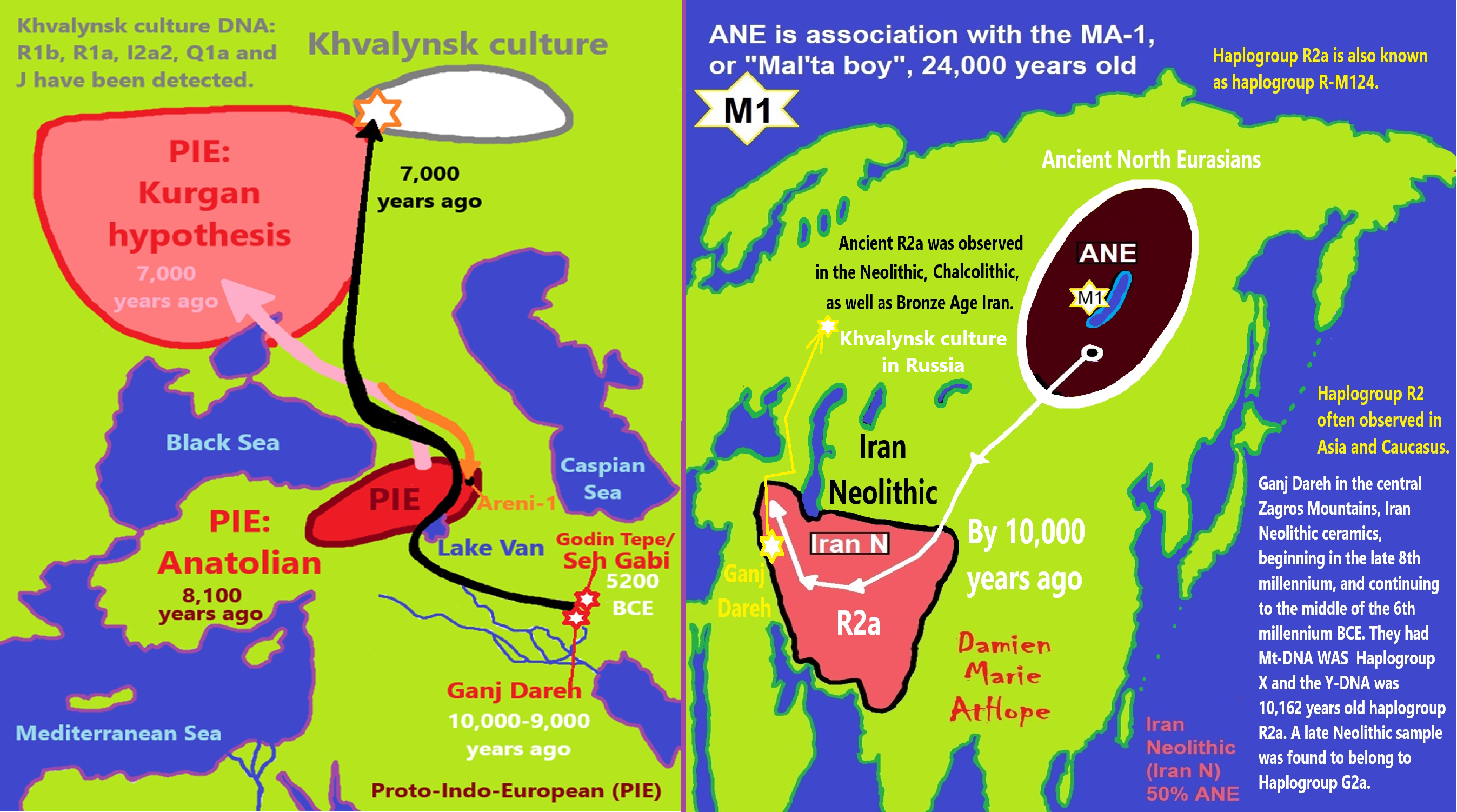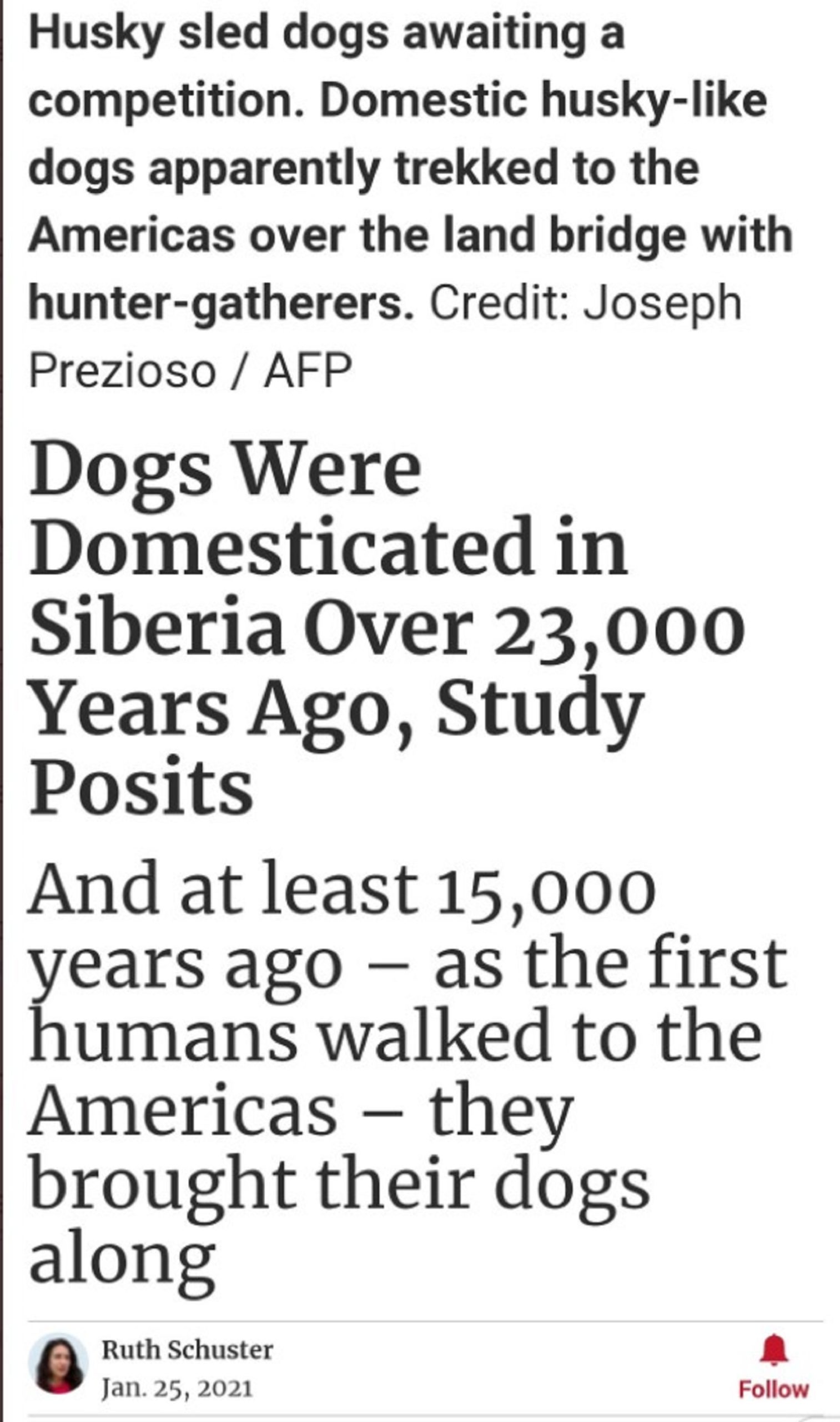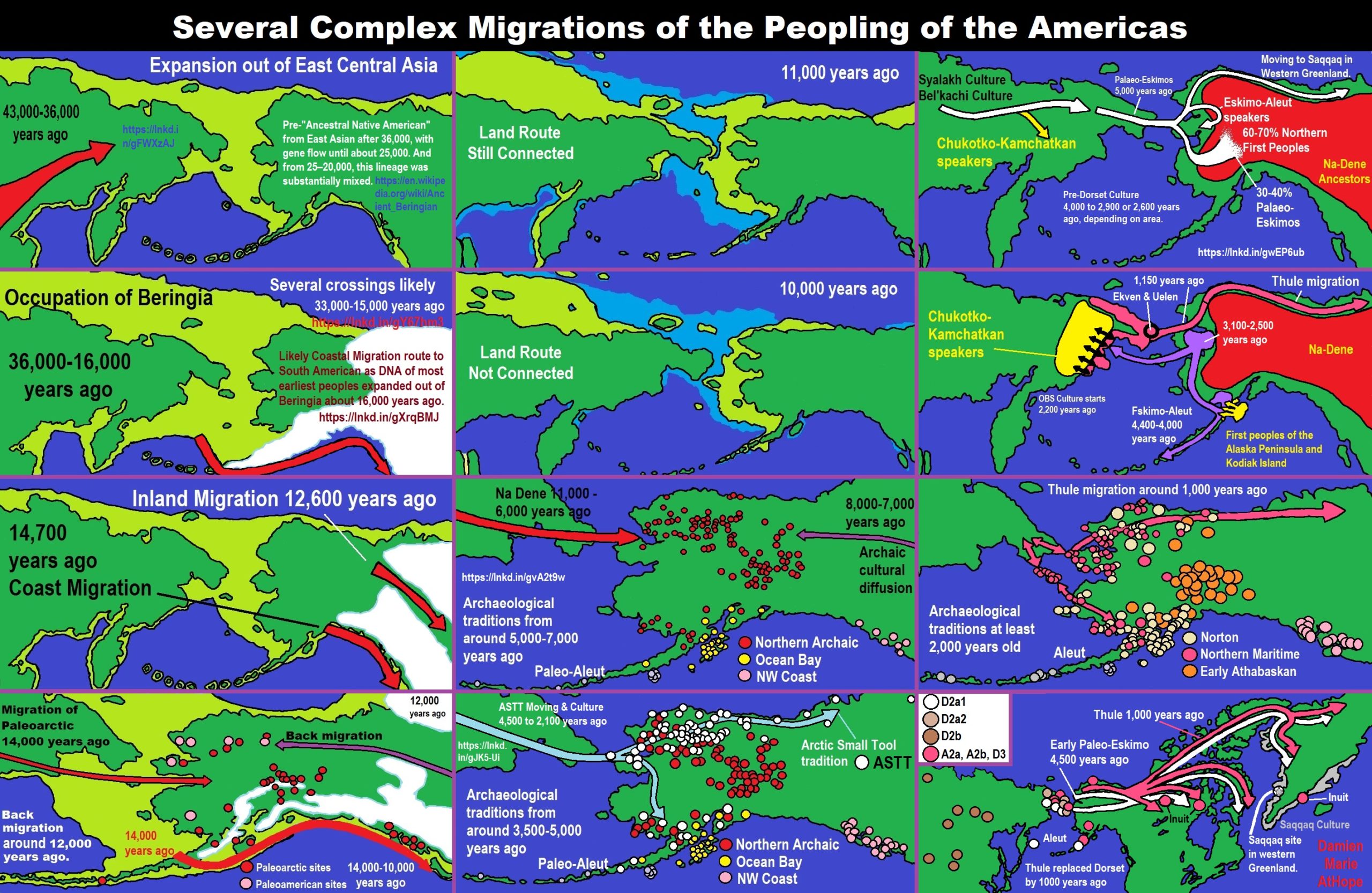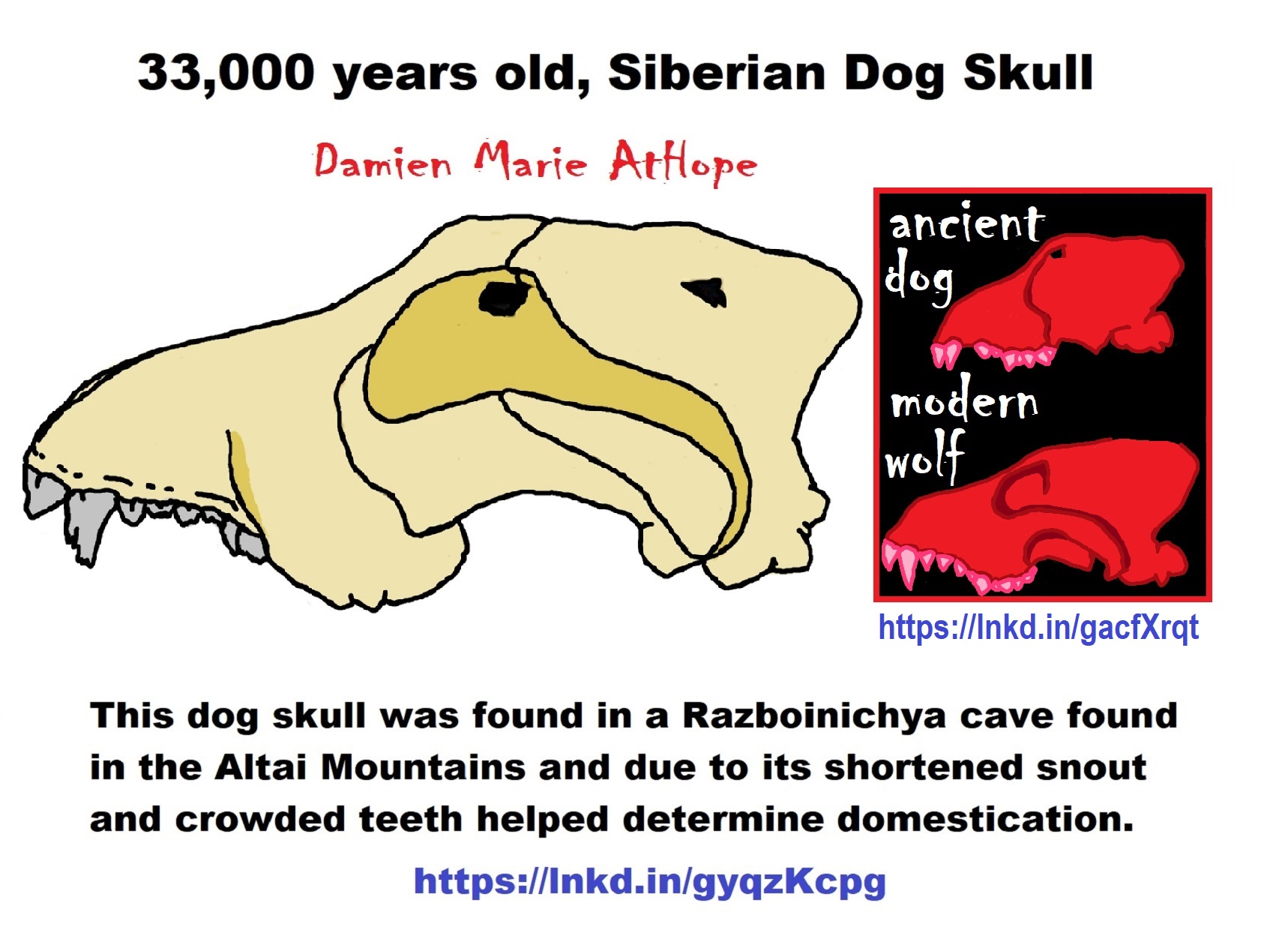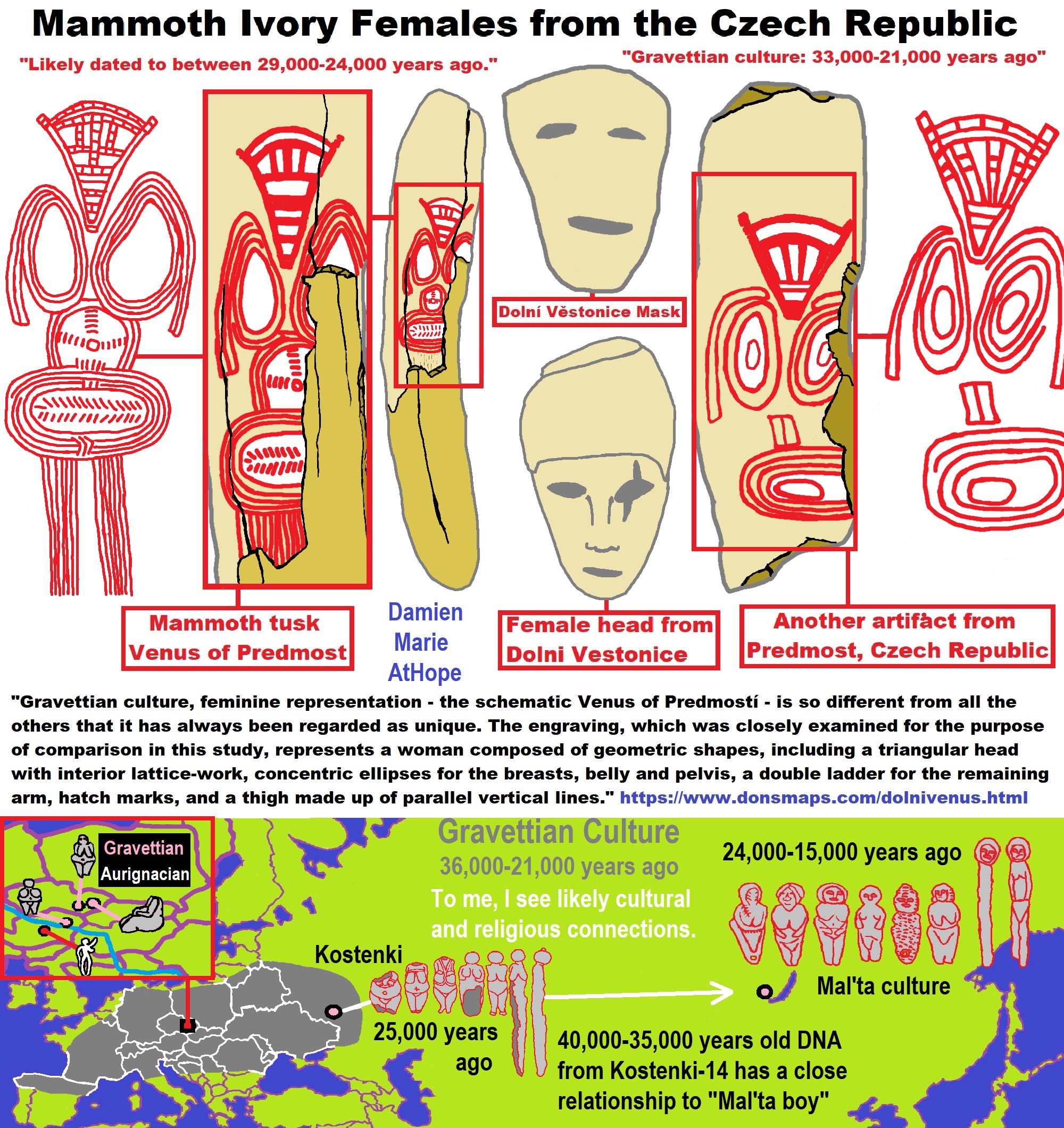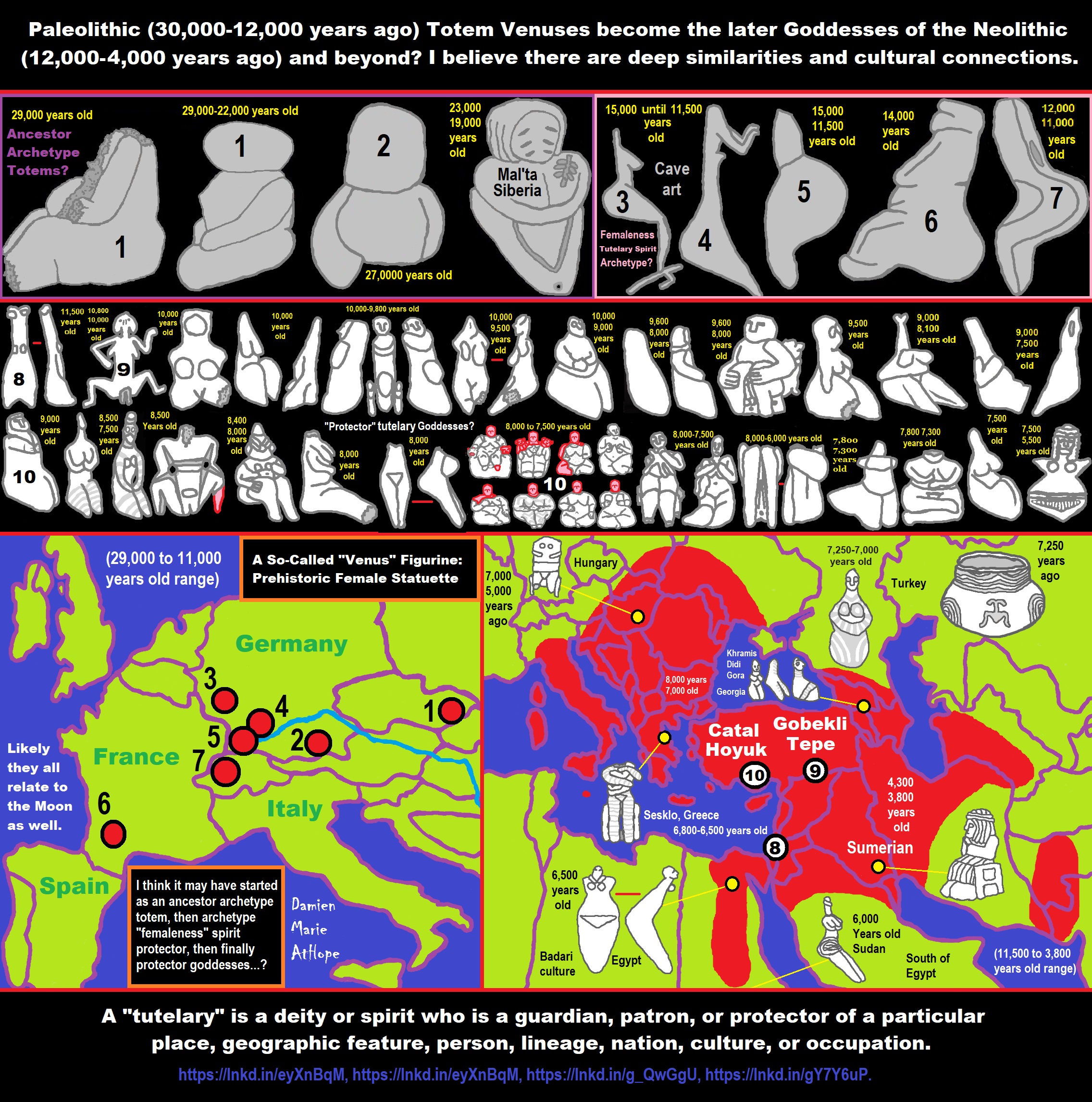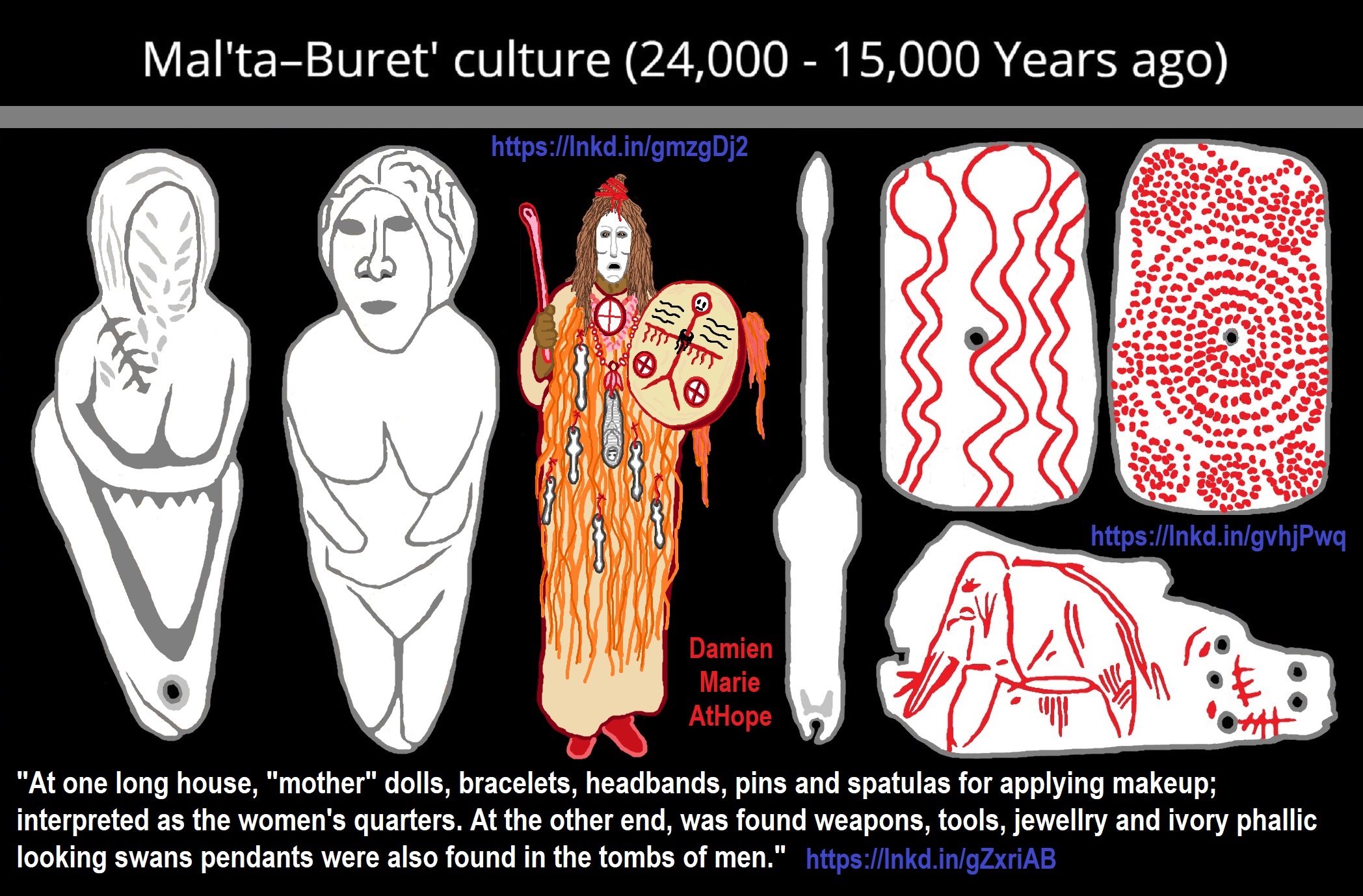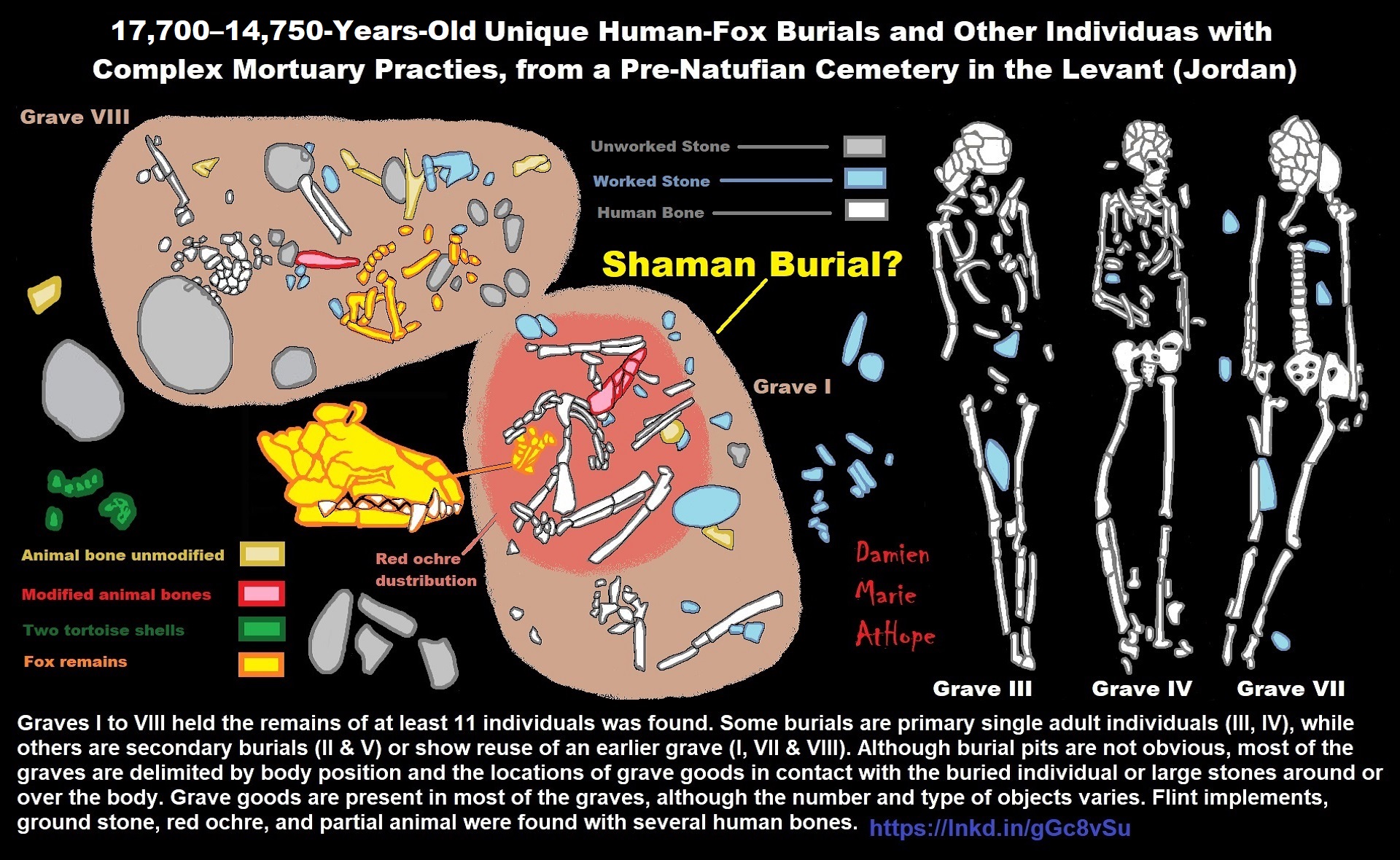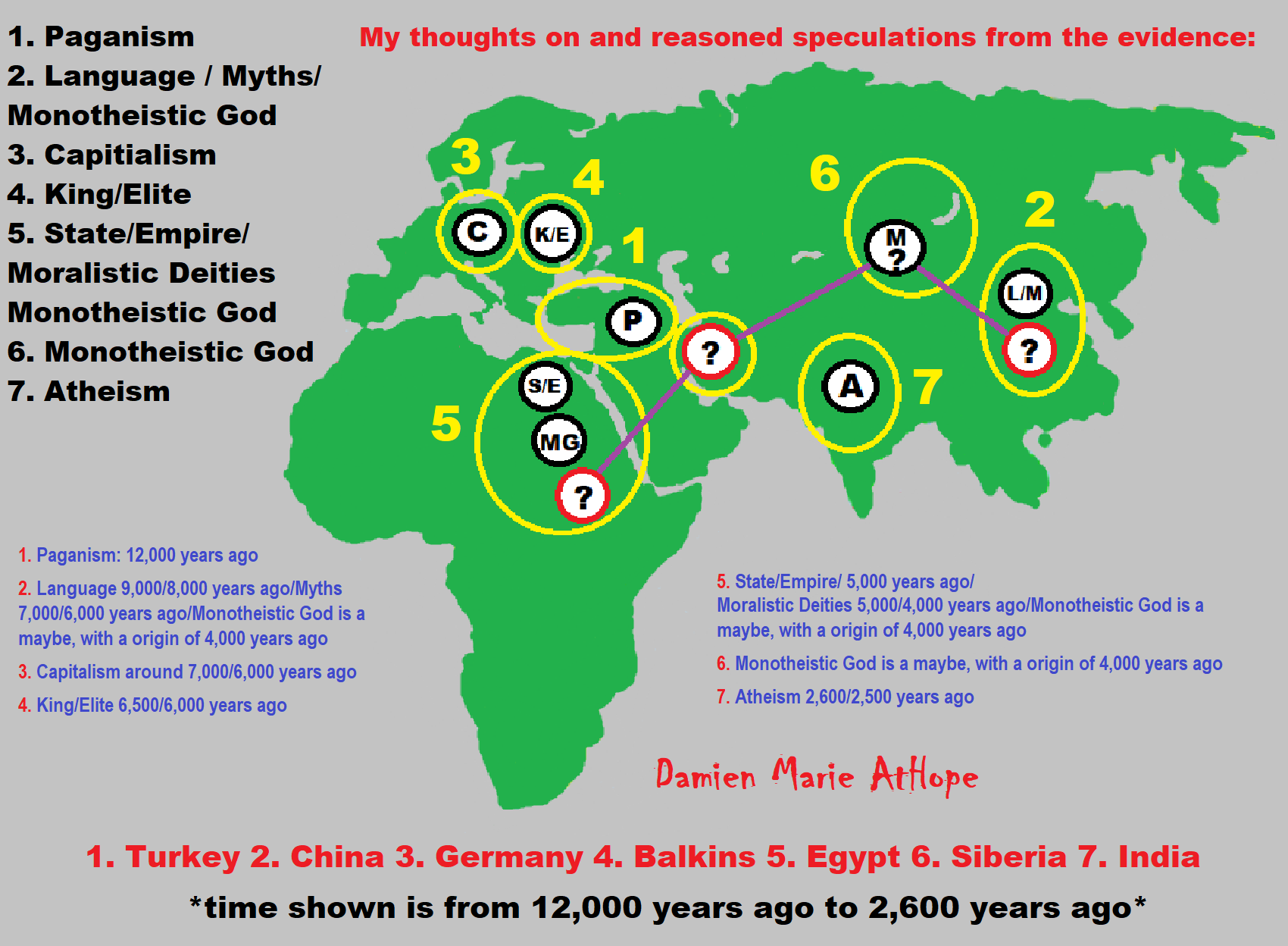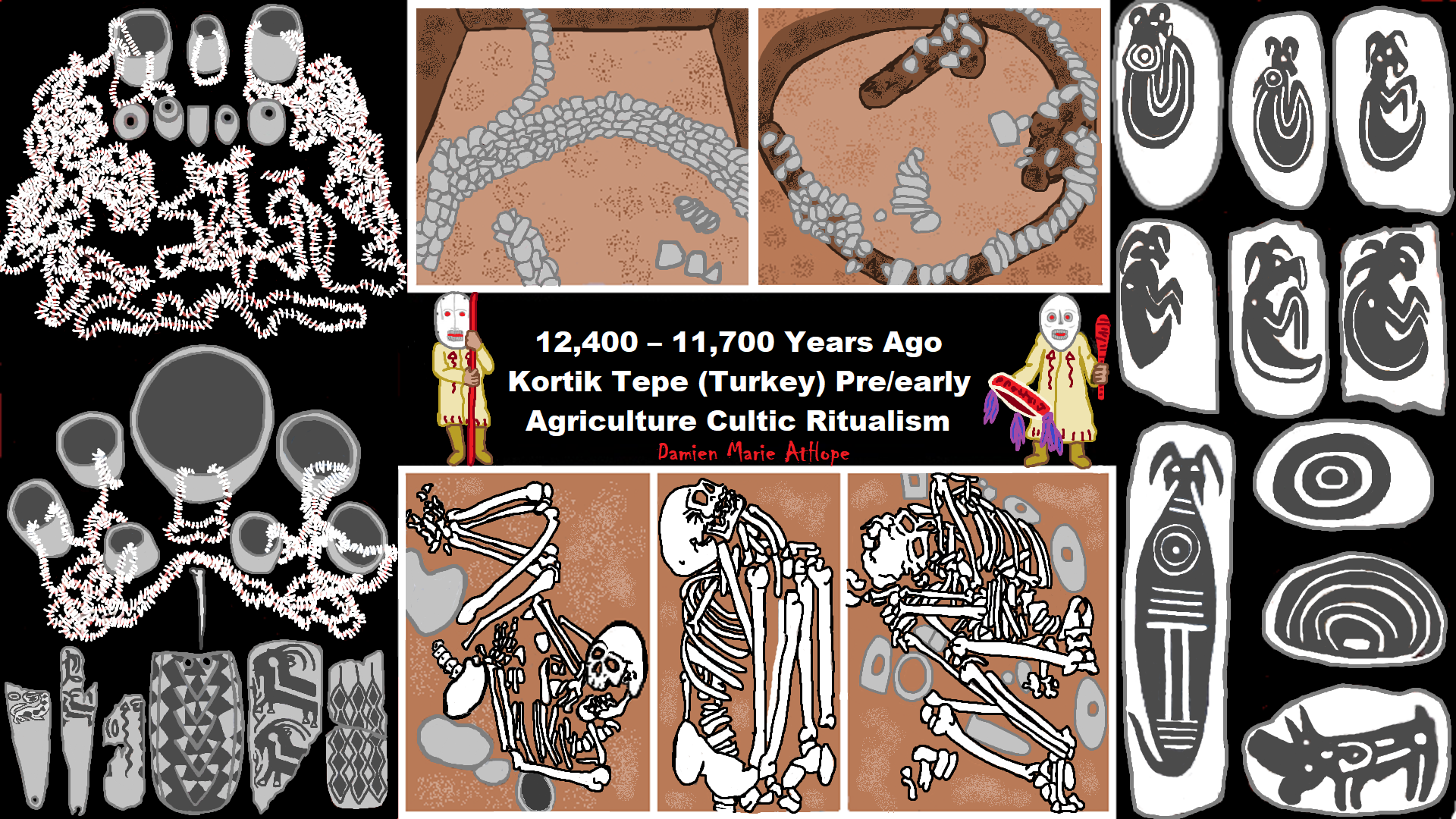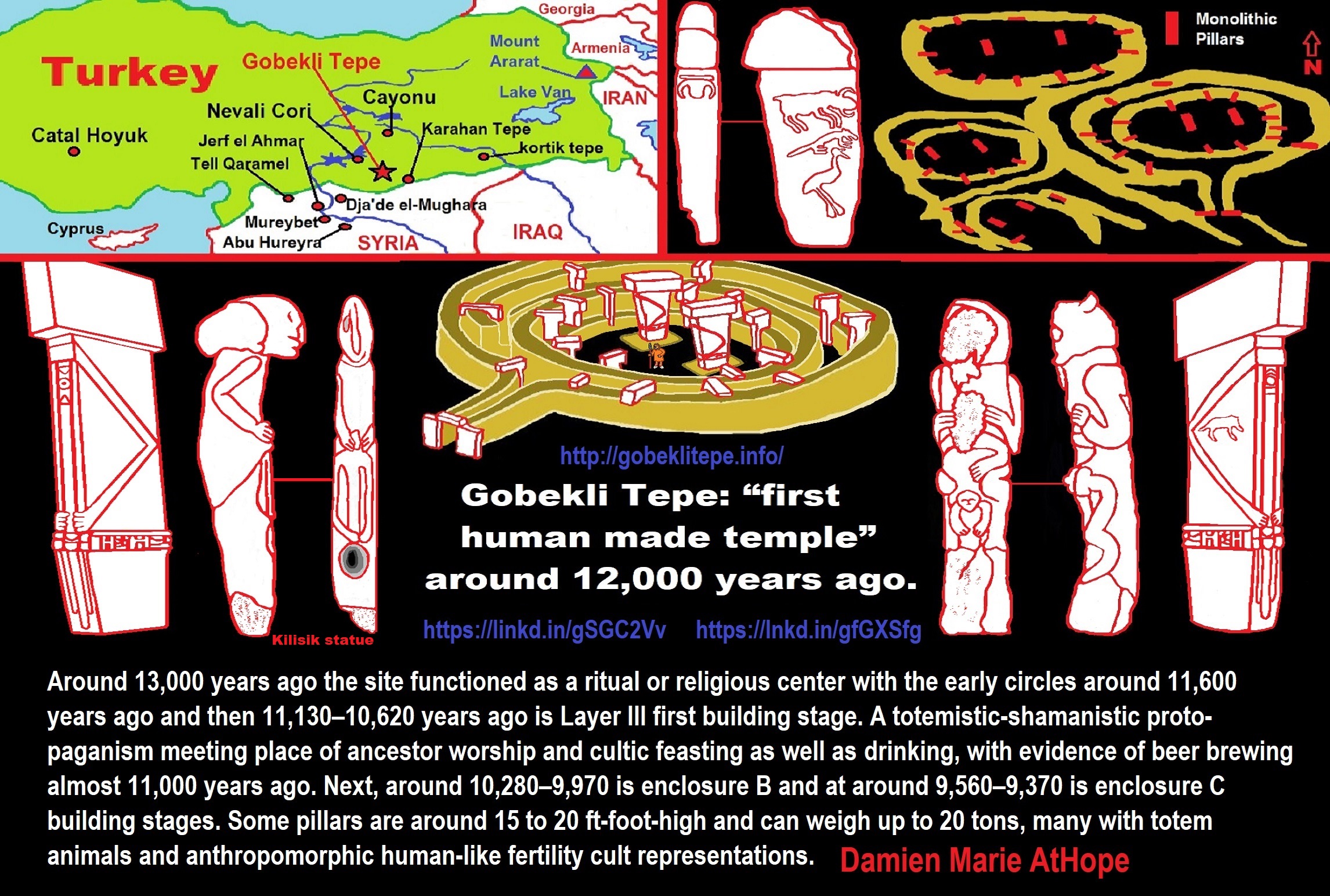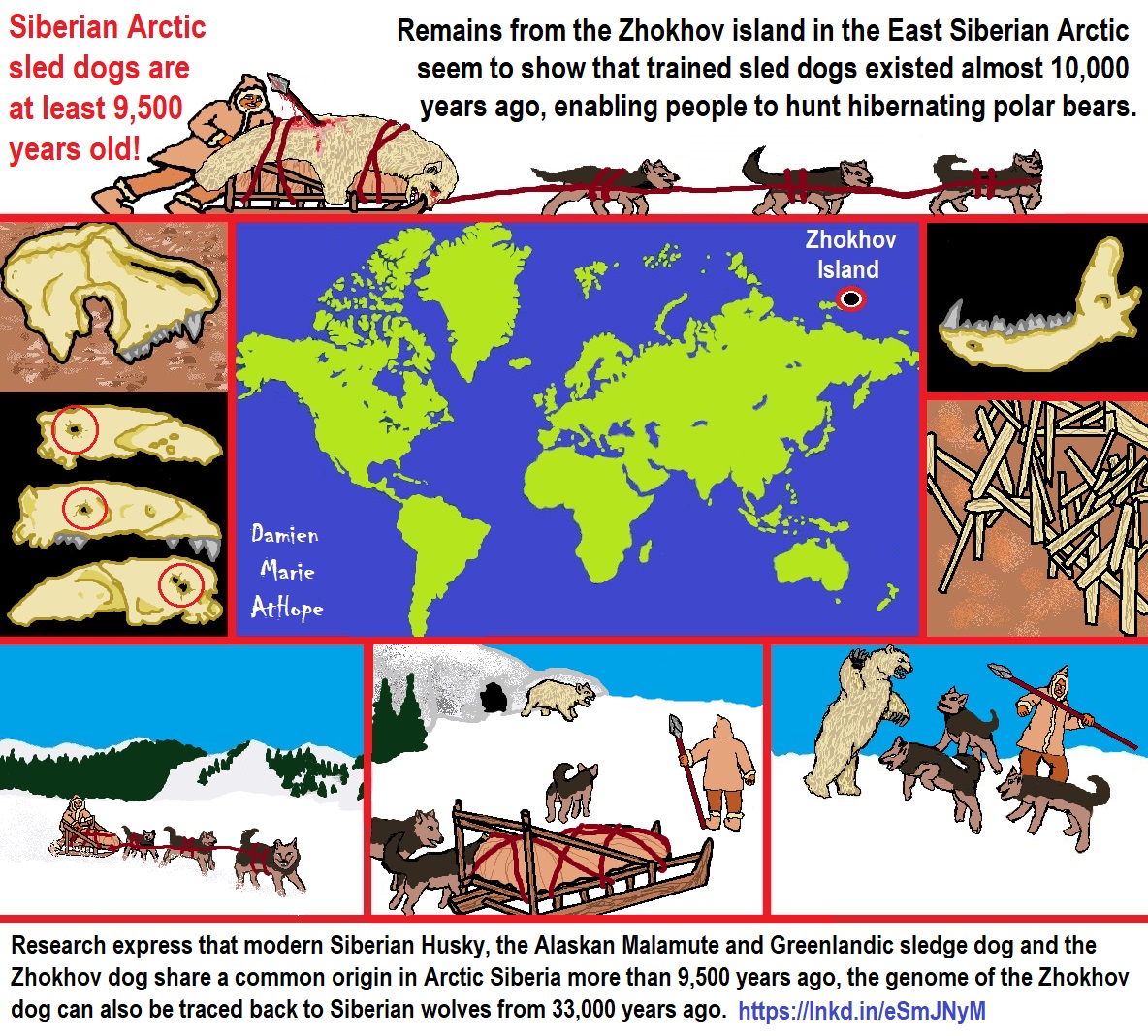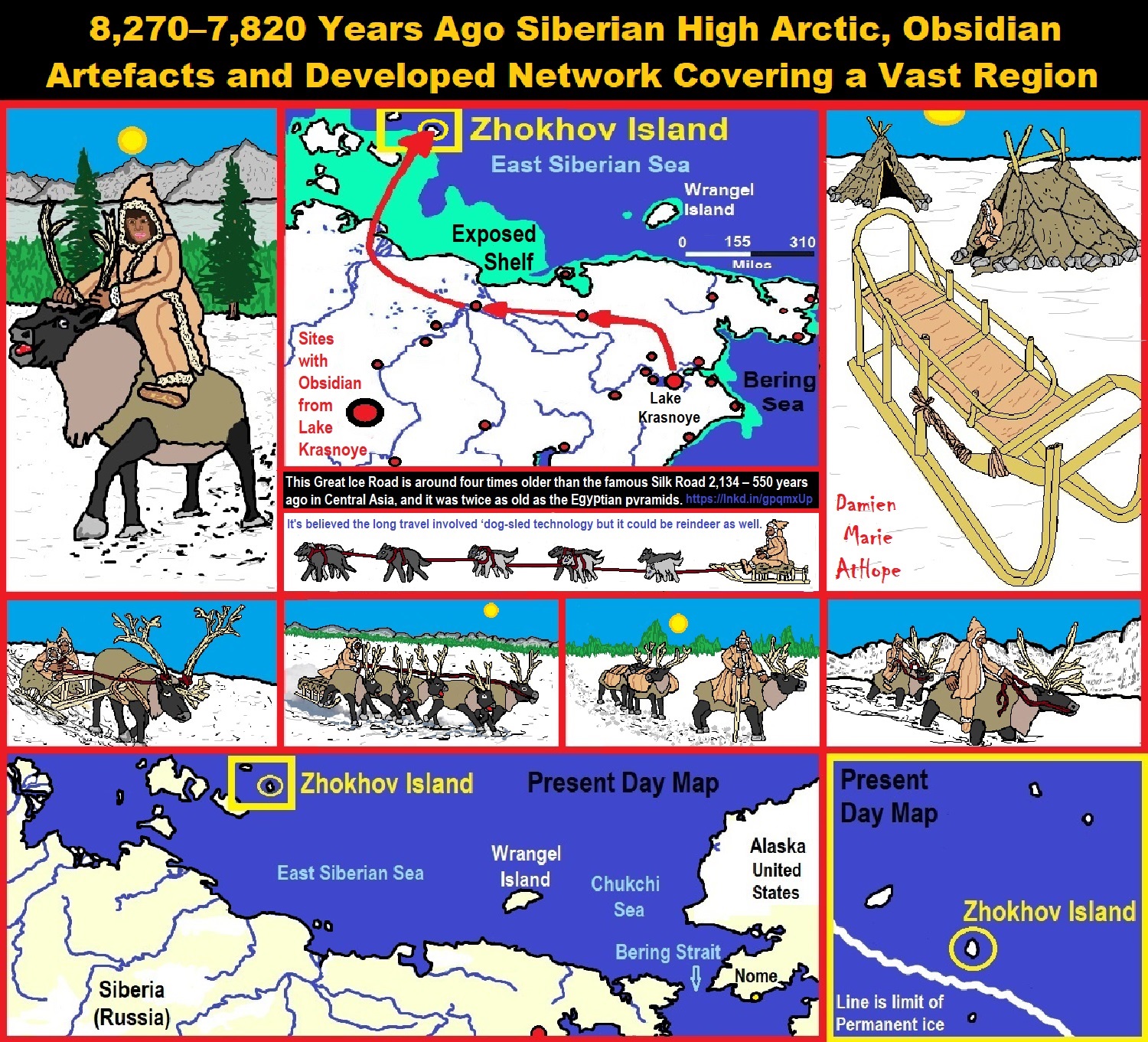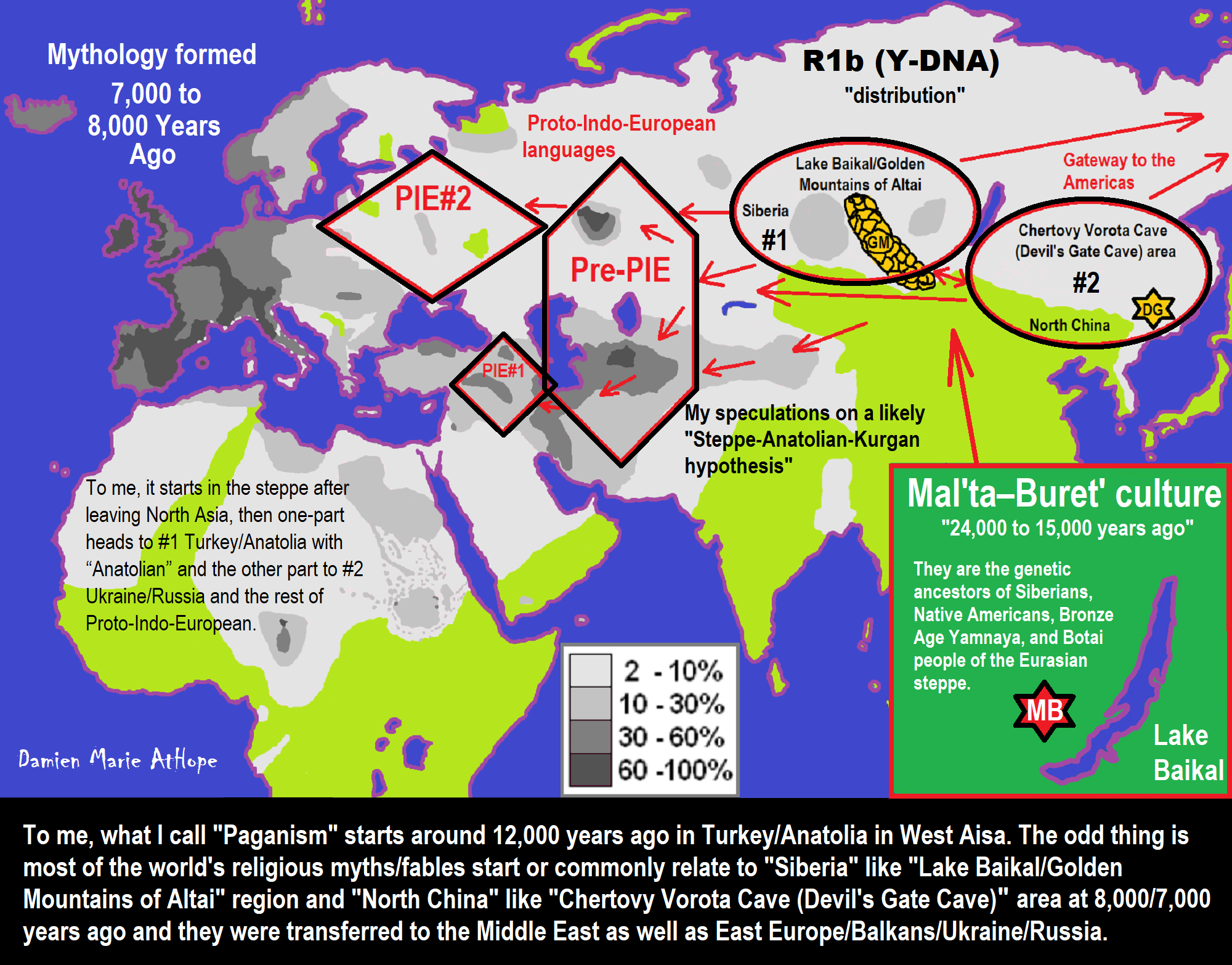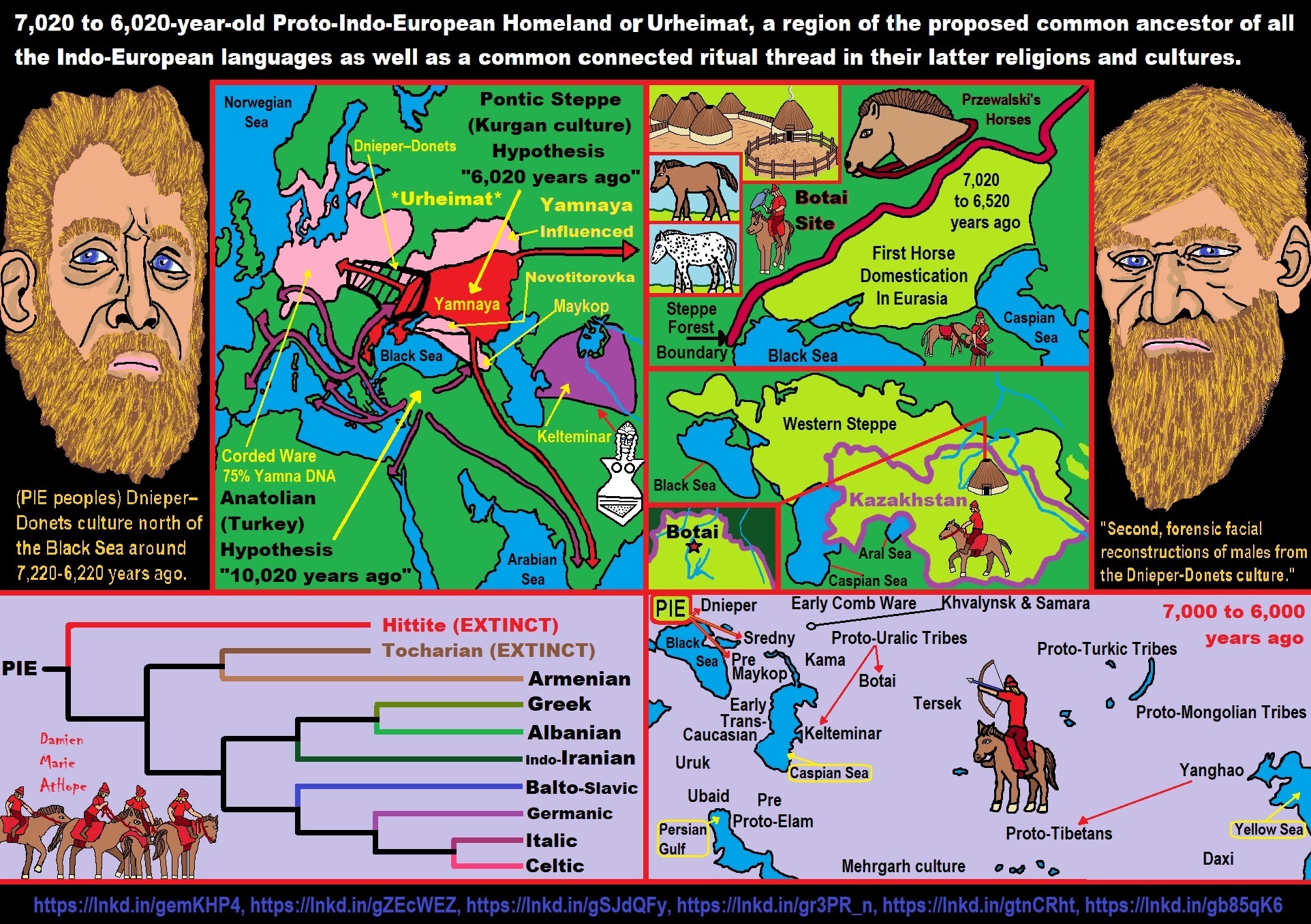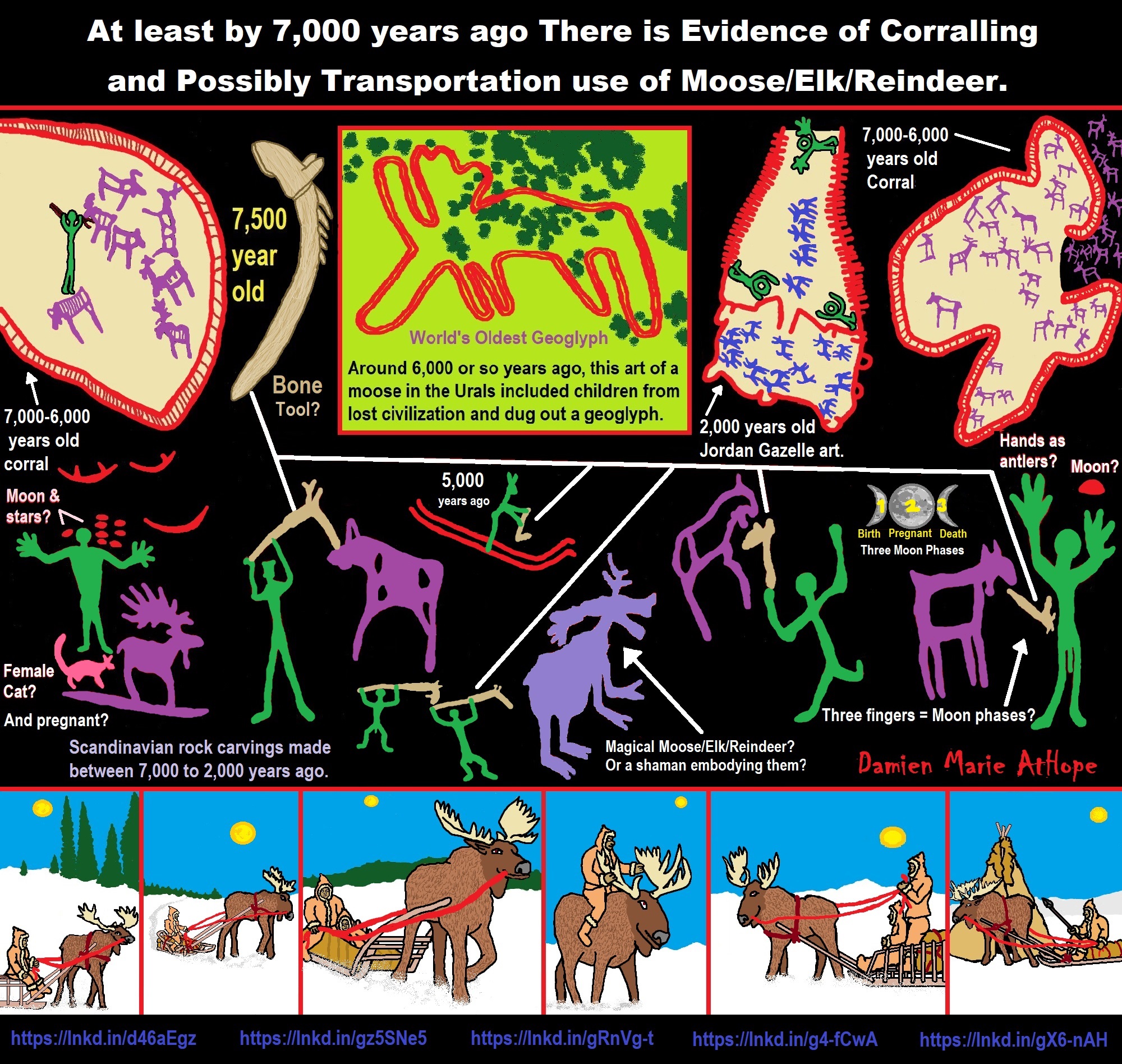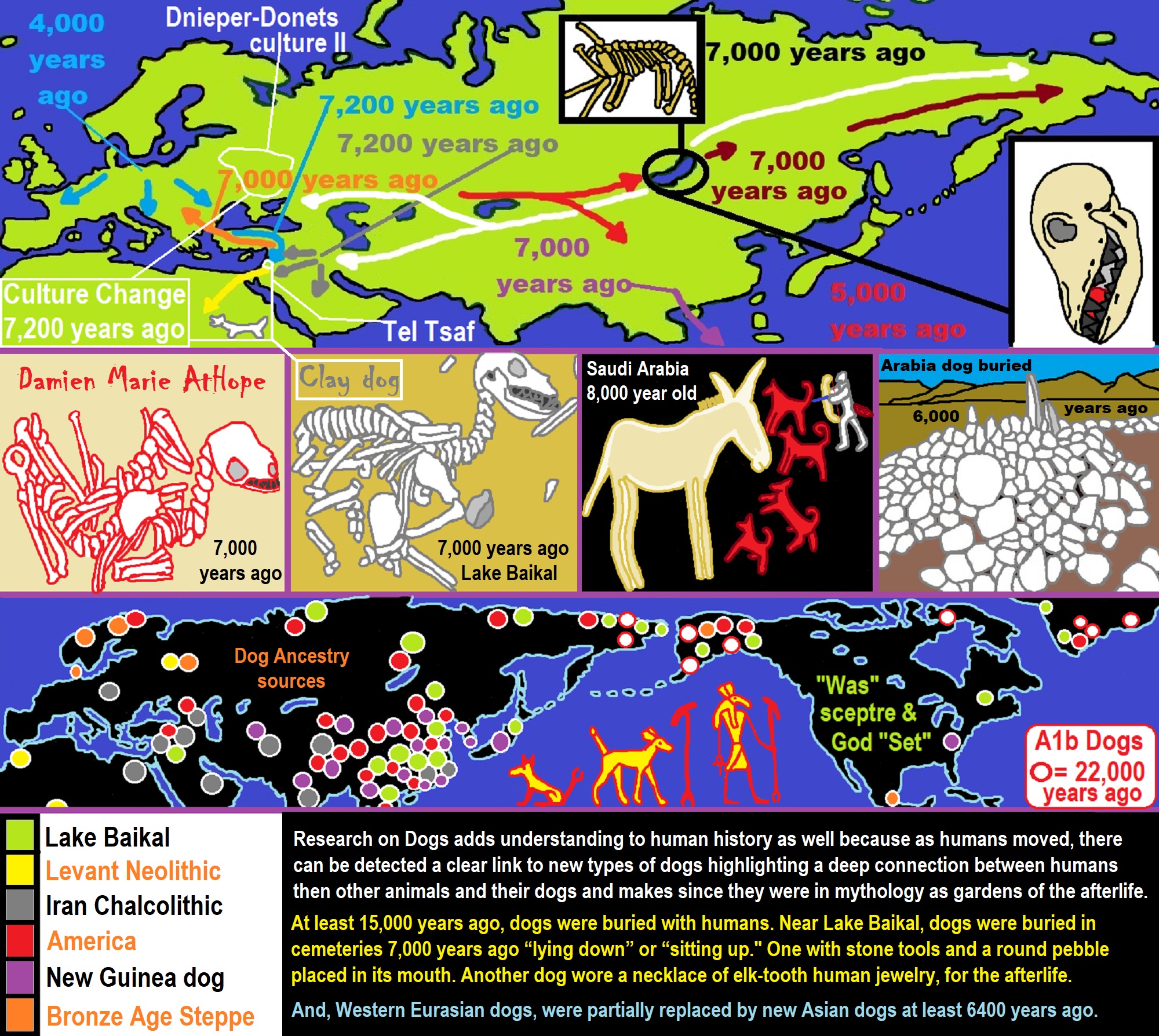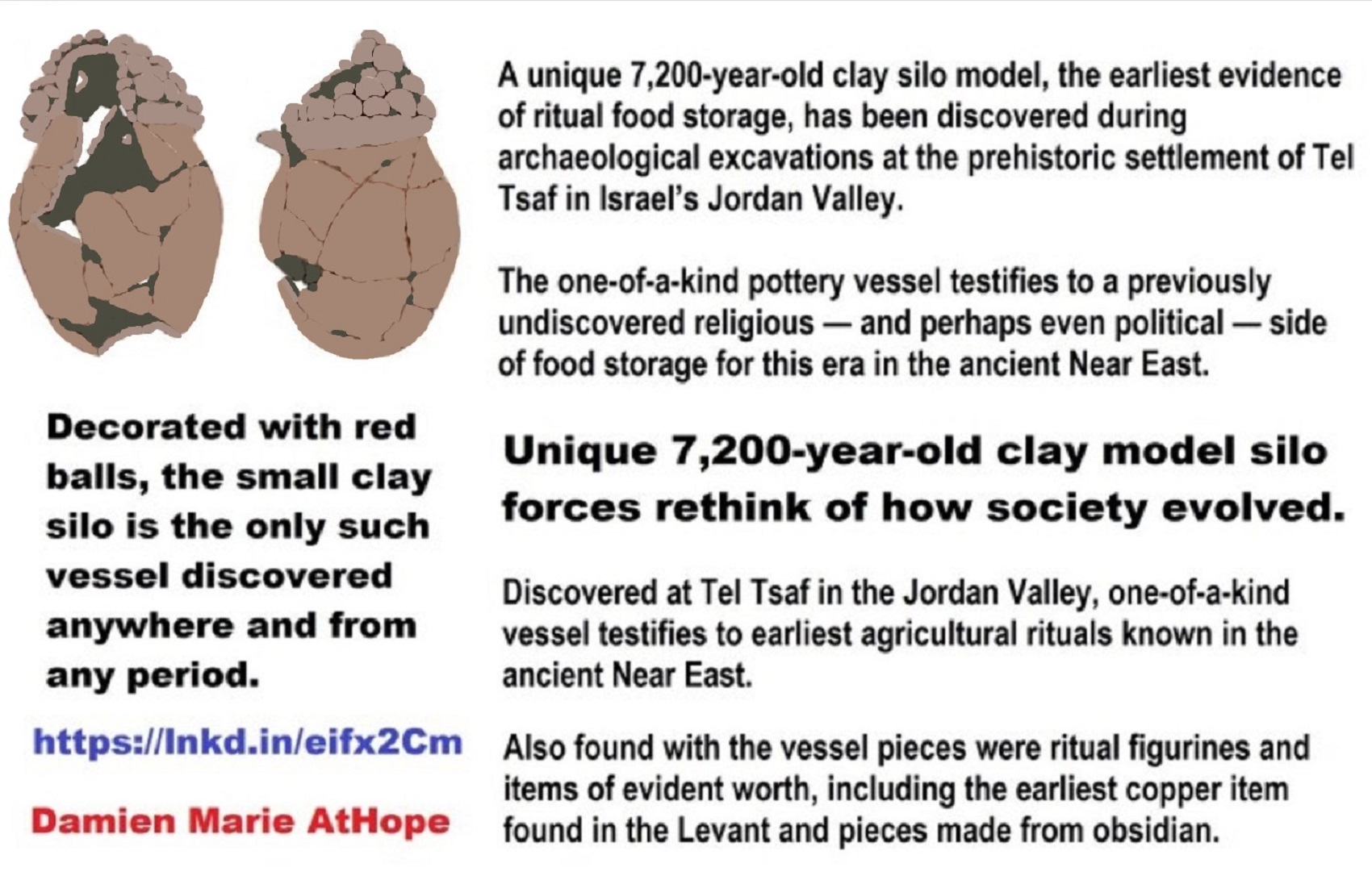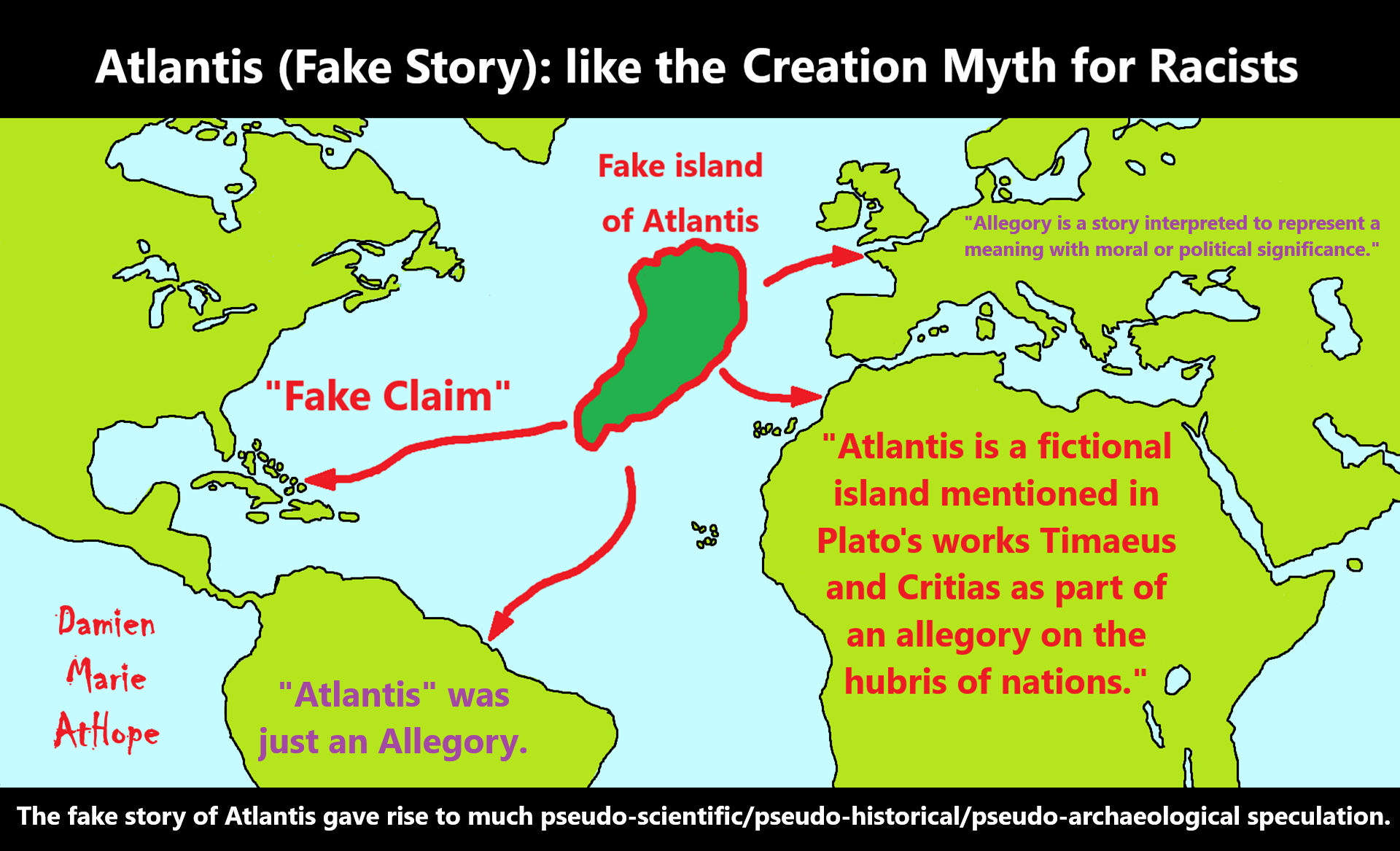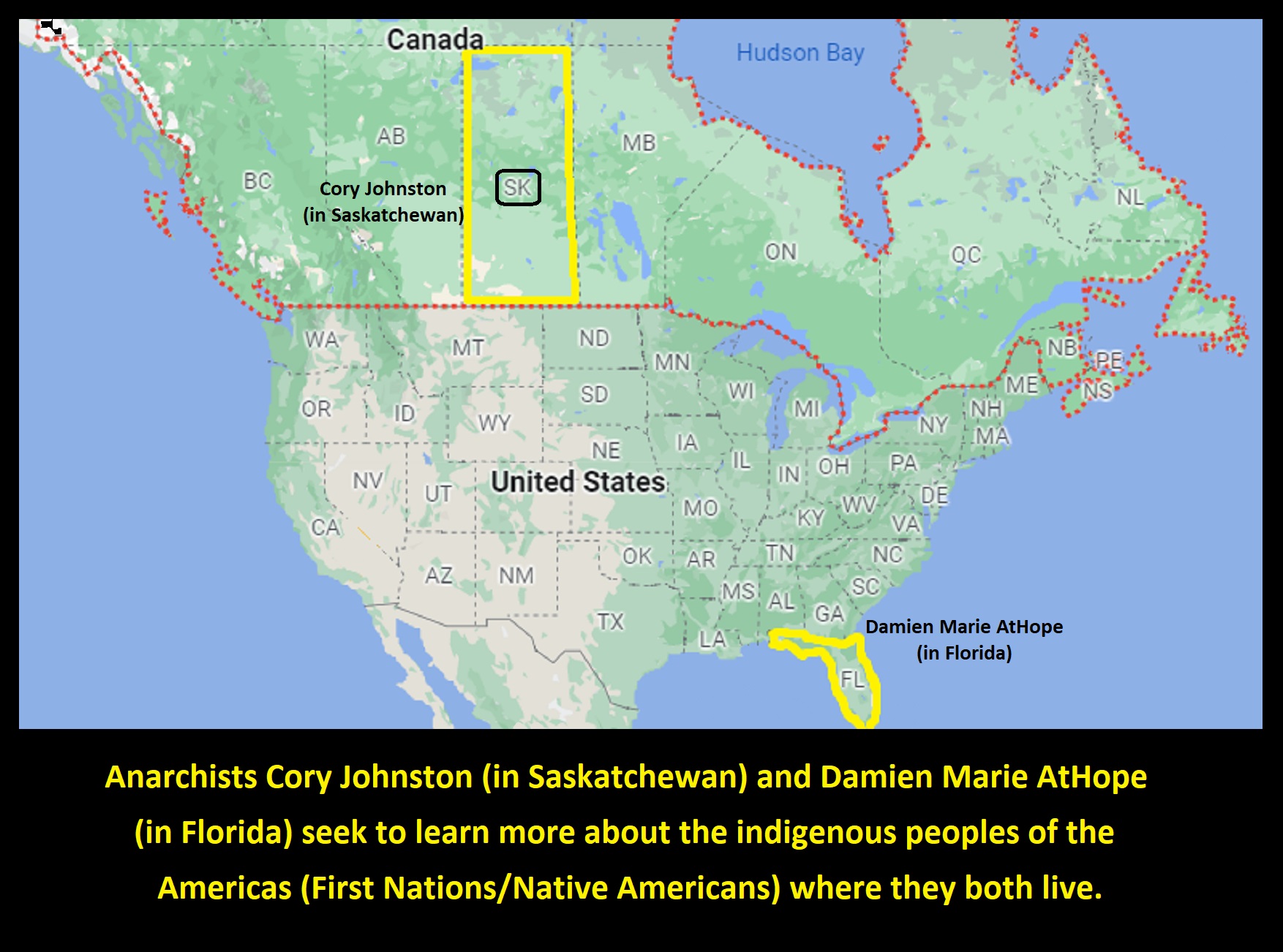
Ancient North Eurasian (ANE)
Ancient Beringian/Ancestral Native American (AB/ANA)
Eastern Hunter-Gatherer (EHG)
Western Hunter-Gatherers (WHG)
Western Steppe Herders (WSH)
Scandinavian Hunter-Gatherer (SHG)
Early European Farmers (EEF)
Jōmon people (Ainu people OF Hokkaido Island)
Neolithic Iranian farmers (Iran_N) (Iran Neolithic)
Haplogroup R possible time of origin about 27,000 years in Central Asia, South Asia, or Siberia:
- Mal’ta–Buret’ culture (24,000-15,000 years ago)
- Afontova Gora culture (21,000-12,000 years ago)
- Trialetian culture (16,000–8000 years ago)
- Samara culture (7,000-6,500 years ago)
- Khvalynsk culture (7,000-6,500 years ago)
- Afanasievo culture (5,300-4,500 years ago)
- Yamna/Yamnaya Culture (5,300-4,500 years ago)
- Andronovo culture (4,000–2,900 years ago) ref
Haplogroup migrations related to the Ancient North Eurasians: I added stuff to this map to help explain.
“The human fossil remains of Afontova Gora 2, an Ancient North Eurasian genetic-related male burial with Y-DNA haplogroup Q1a1-F746, dated to 17,000 years ago, showed close genetic affinities to Mal’ta 1 (Mal’ta boy). Afontova Gora 2 also showed a greater genetic affinity for the Karitiana people (an indigenous people of Brazil) than for the Han Chinese.” ref
People reached Lake Baikal Siberia around 25,000 years ago. They (to Damien) were likely Animistic Shamanists who were also heavily totemistic as well. Being animistic thinkers they likely viewed amazing things in nature as a part of or related to something supernatural/spiritual (not just natural as explained by science): spirit-filled, a sprit-being relates to or with it, it is a sprit-being, it is a supernatural/spiritual creature, or it is a great spirit/tutelary deity/goddess-god. From there comes mythology and faith in things not seen but are believed to somehow relate or interact with this “real world” we know exists.
Both areas of Lake Baikal, one on the west side with Ancient North Eurasian culture and one on the east side with Ancient Northern East Asian culture (later to become: Ancient Northeast Asian culture) areas are the connected areas that (to Damien) are the origin ancestry religion area for many mythologies and religious ideas of the world by means of a few main migrations and many smaller ones leading to a distribution of religious ideas that even though are vast in distance are commonly related to and centering on Lake Baikal and its surrounding areas like the Amur region and Altai Mountains region.
To an Animistic Thinker: “Things are not just as they seem, they may have a spirit, or spirit energy relates to them”
To a Totemistic Thinker: “Things are not just as they seem, they may have a spirit, or spirit energy relates to them; they may have religio-cultural importance.”
“Ancient North Eurasian population had Haplogroups R, P, U, and Q DNA types: defined by maternal West-Eurasian ancestry components (such as mtDNA haplogroup U) and paternal East-Eurasian ancestry components (such as yDNA haplogroup P1 (R*/Q*).” ref
Racists say that the Afontova Gora culture had the first light skin and light hair mt-DNA R1b, which from Afontova Gora 3, a female not related close to native Americans as the DNA went west, not east. And they claim this culture proves light skin and light hair went to the Americas (teaching the dark people) because this culture is closest to South Americans, but they leave out that relates to the male DNA of Afontova Gora 2 Y-DNA Q. Haplogroup Q-M242 has been found in approximately 94% of Indigenous peoples of Mesoamerica and South America. ref, ref
- “Afontova Gora culture relate to Ancient North Eurasian DNA.” ref
- “Ancient North Eurasian DNA (Haplogroups R and Q Y-DNA) relates to Mal’ta–Buret’ culture.” ref
- “Mal’ta–Buret’ culture DNA relates to 24,000-year-old MA-1 (or Mal’ta boy).” ref
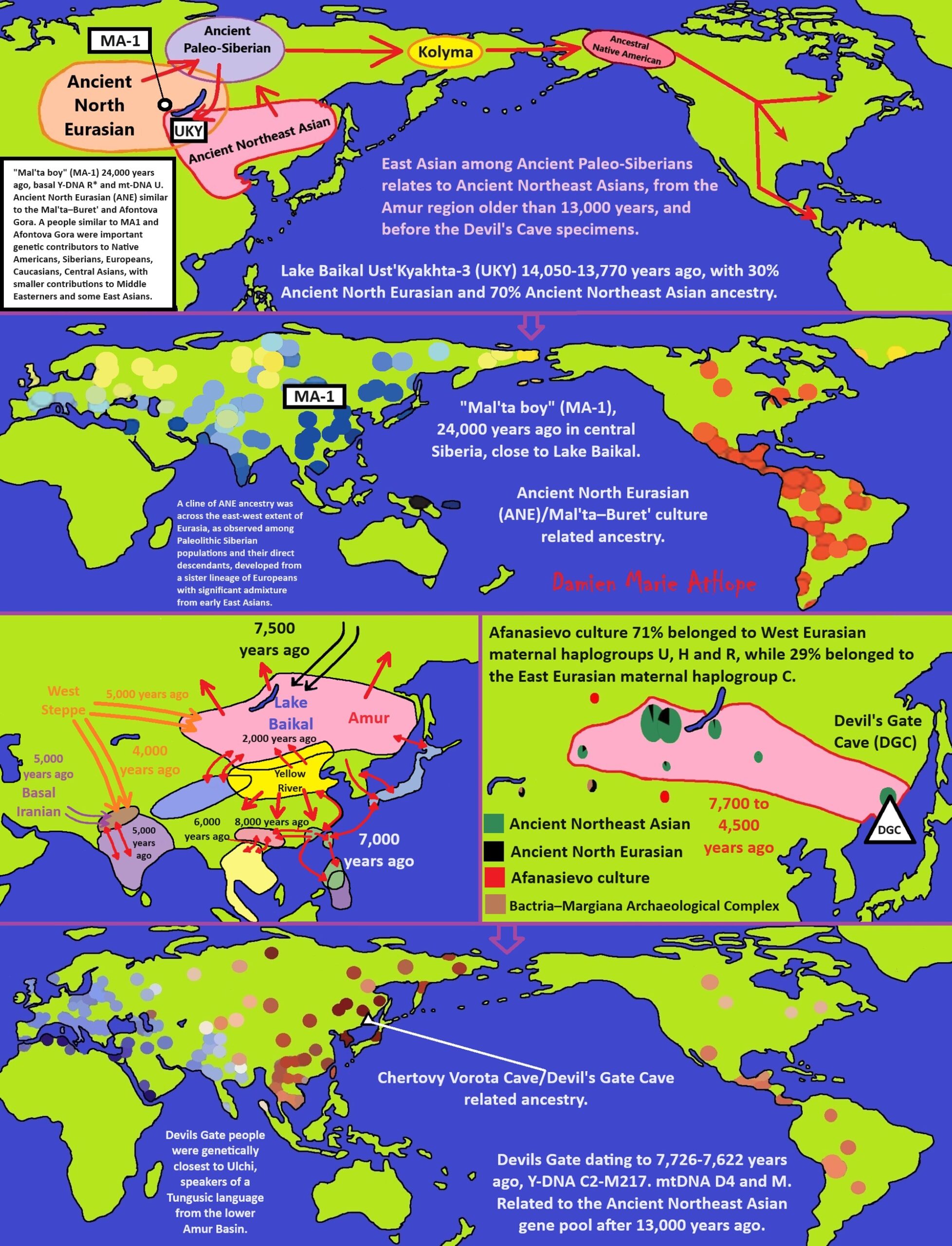
ref, ref, ref, ref, ref, ref, ref, ref, ref, ref, ref, ref, ref, ref, ref
“A 2016 study found that the global maximum of Ancient North Eurasian (ANE) ancestry occurs in modern-day Kets, Mansi, Native Americans, and Selkups. ANE ancestry has spread throughout Eurasia and the Americas in various migrations since the Upper Paleolithic, and more than half of the world’s population today derives between 5 and 42% of their genomes from the Ancient North Eurasians. Significant ANE ancestry can be found in Native Americans, as well as in regions of northern Europe, South Asia, Central Asia, and Siberia. It has been suggested that their mythology may have featured narratives shared by both Indo-European and some Native American cultures, such as the existence of a metaphysical world tree and a fable in which a dog guards the path to the afterlife.” ref
Ancient Northern East Asian/ later became Ancient Northeast Asian
Ancient Paleo-Siberian
Mal’ta–Buret’ culture (Mal’ta boy MA-1)
The Kolyma Shaitans: Legends and Reality (I only use just a small part)
“A unique “shaitan” burial was discovered on the bank of Omuk-Kuel Lake in the Middle-Kolyma ulus in Yakutia. According to the legends, buried in it are mummified remains of a shaman woman who died during a devastating smallpox epidemics in the 18th c. In an attempt to overcome the deadly disease, the shaman’s relatives used her remains as an emeget fetish. The author believes that these legends reflect the real events of those far-away years. The Arabic word “shaitan” came to the Russian language from Turkic languages. According to Islamic tradition, a shaitan is a genie, an evil spirit, a demon. During Russian colonization and Christianization of Siberia, all sacred things used by the aborigines as fetishes, patron spirits of the family, and the tribe, grew to be called “shaitans.” There are various facts, dating to the 18th and 19th cc., confirming that this word also referred to the mummified remains of outstanding shamans.” ref
“In the 1740s, a member of the Second Kamchatka Expedition Yakov Lindenau wrote, “Meat is scratched off the [shaman’s] bones and the bones are put together to form a skeleton, which is dressed in human’s clothes and worshipped as a deity. The Yukagirs place such dressed bones…in their yurts, their number can sometimes reach 10 or 15. If somebody commits even a minor sacrilege with respect to these bones, he stirs up rancor on the part of the Yukagirs… While traveling and hunting, the Yukagirs carry these bones in their sledges, and moreover, in their best sledges pulled by their best deer. When the Yukagirs are going to undertake something really important, they tell fortune using these skeletons: lift a skeleton up, and if it seems light, it means that their enterprise will have a favorable outcome. The Yukagirs call these skeletons stariks (old men), endow them with their best furs, and sit them on beds covered with deer hides, in a circle, as though they are alive.” (Lindenau, 1983, p. 155)” ref
“In the late 19th c., a famous explorer of aboriginal culture V. I. Jochelson noted the changes that occurred in the ritual in the last century and a half. So, the Yukagirs divided among themselves the shaman’s meat dried in the sun and then put it in separate tents. The dead bodies of killed dogs were left there as well. “After that,” V. I. Jochelson writes, “they would divide the shaman’s bones, dry them and wrap in clothes. The skull was an object of worshipping. It was put on top of a trunk (body) cut out of wood. A caftan and two hats – a winter and a summer one – were sewn for the idol. The caftan was all embroidered. On the skull, a special mask was put, with holes for the eyes and the mouth… The figure was placed in the front corner of the home. Before a meal, a piece of food was thrown into the fire and the idol was held above it. This feeding of the idol… was committed before each meal.” (V. I. Jochelson, 2005, pp. 236—237)” ref
“The idol was kept by the children of the dead shaman. One of them was inducted into the shamanism mysteries while his father was still alive. The idol was carried in a wooden box. Sometimes, in line with the air burial ritual, the box was erected on poles or trees, and the idol was taken out only before hunting or a long journey so that the outcome of the enterprise planned could be predicted. With time, the Yukagirs began using wooden idols as charms. V. I. Jochelson notes that by the late 19th c. the Yukagirs had developed a skeptical attitude towards idols and referred to them as “shaitans.” In this way, under the influence of Christianity, the worshipped ancestor’s spirit turned into its opposite – an evil spirit, a devil, a Satan.” ref
Ancestral Native American, Ancient Beringian
14,000-year-old Ust-Kyakhta-3 (UKY) individual found near Lake Baikal
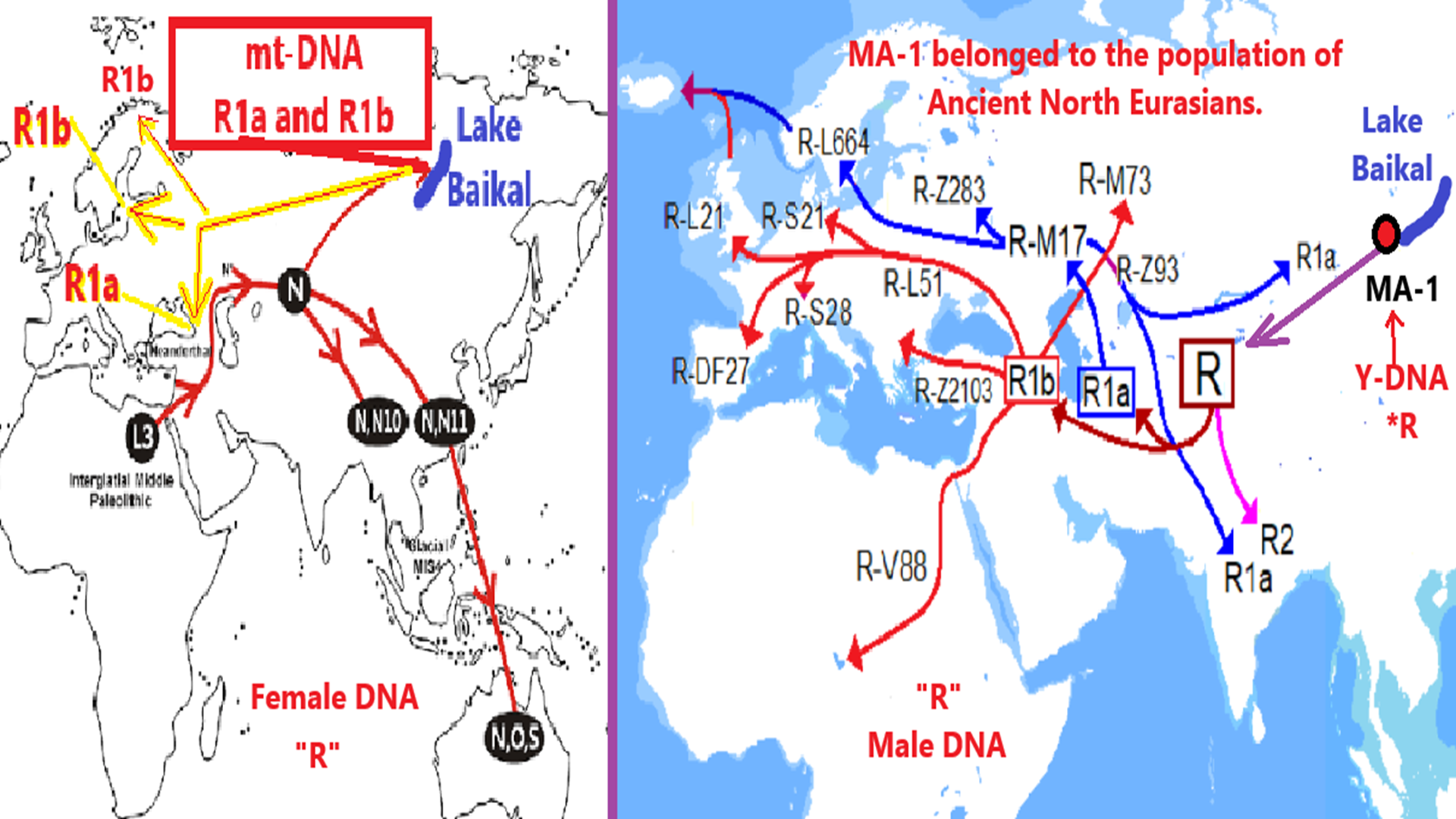
ref, ref, ref, ref, ref, ref, ref
“The Ancient North Eurasian (ANE) lineage, also known as Paleolithic Siberians, is defined by association with the “Mal’ta boy” (MA-1) haplogroup R*, the remains of an individual who lived during the Last Glacial Maximum, 24,000 years ago in near Lake Baikal central Siberia. Ancient North Eurasian associated Y-chromosome haplogroups are P-M45, and its subclades R and Q.” ref
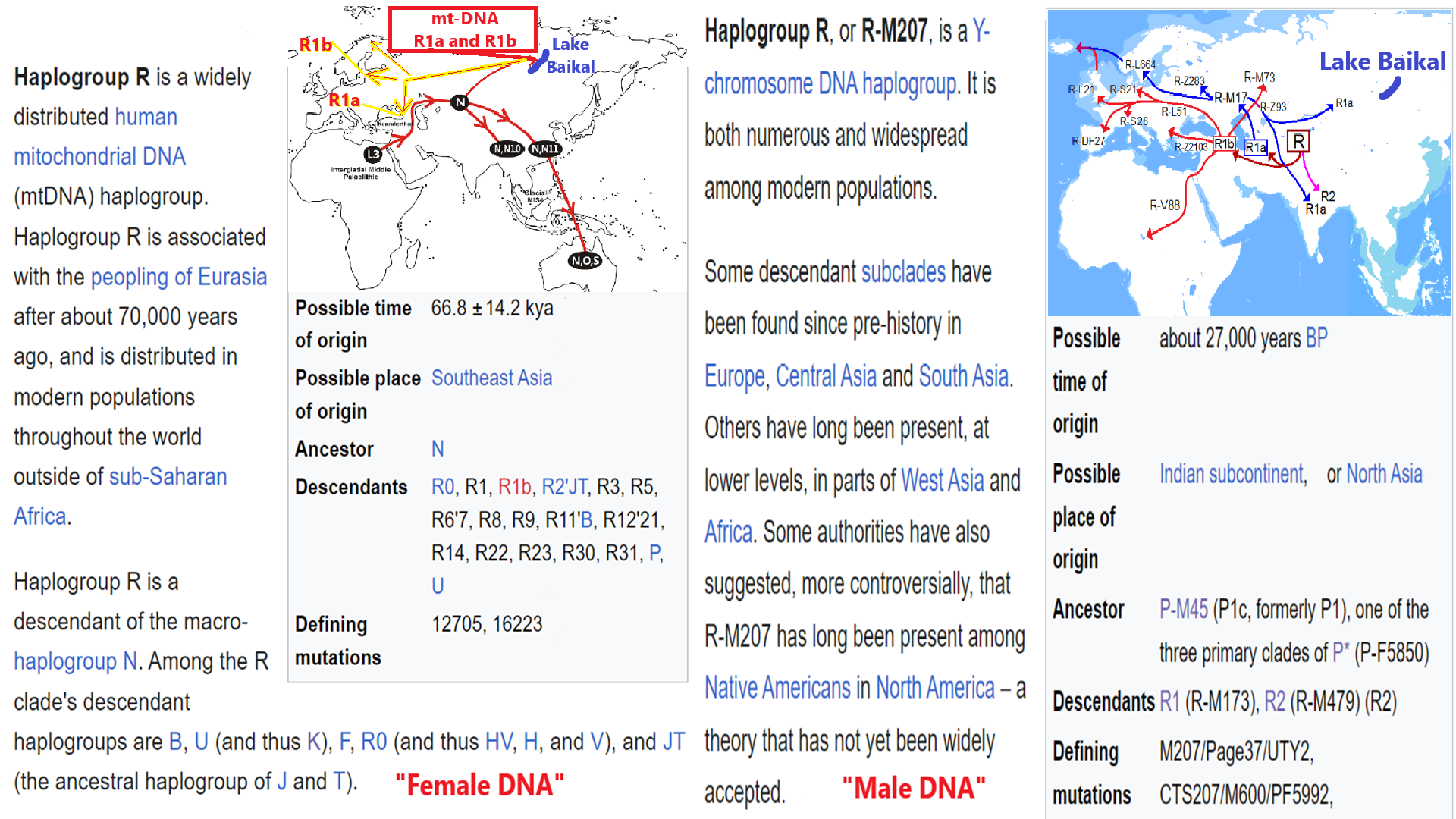
Haplogroup R (mtDNA)
“Haplogroup R (mtDNA) is a widely distributed human mitochondrial DNA (mtDNA) haplogroup. Haplogroup R (mtDNA) is associated with the peopling of Eurasia after about 70,000 years ago, and is distributed in modern populations throughout the world outside of sub-Saharan Africa. Haplogroup R is a descendant of the macro-haplogroup N. Among the R clade’s descendant haplogroups are B, U (and thus K), F, R0 (and thus HV, H, and V), and JT (the ancestral haplogroup of J and T). The Ust’-Ishim man fossil of Siberia, dated ca. 45,000 years old, belongs to haplogroup R* (formerly classified as U*).” ref
“Haplogroup R (mtDNA) has also been observed among Egyptian mummies excavated at the Abusir el-Meleq archaeological site in Northern Egypt, which date from the Pre-Ptolemaic/late New Kingdom, Ptolemaic, and Roman periods. Subclade R2 was observed in the remains of a Neolithic human from western Iran in Tepe Abdul Hosein. Haplogroup R (mtDNA) and its descendants are distributed all over Australasia, Americas, Southeast Asia, South Asia, Central Asia, West Asia, East Asia, Europe, North Africa, and Horn of Africa. The basal R* clade is found among the Soqotri (1.2%), as well as in Northeast Africa (1.5%), the Middle East (0.8%), the Near East (0.8%), and the Arabian Peninsula (0.3%).” ref
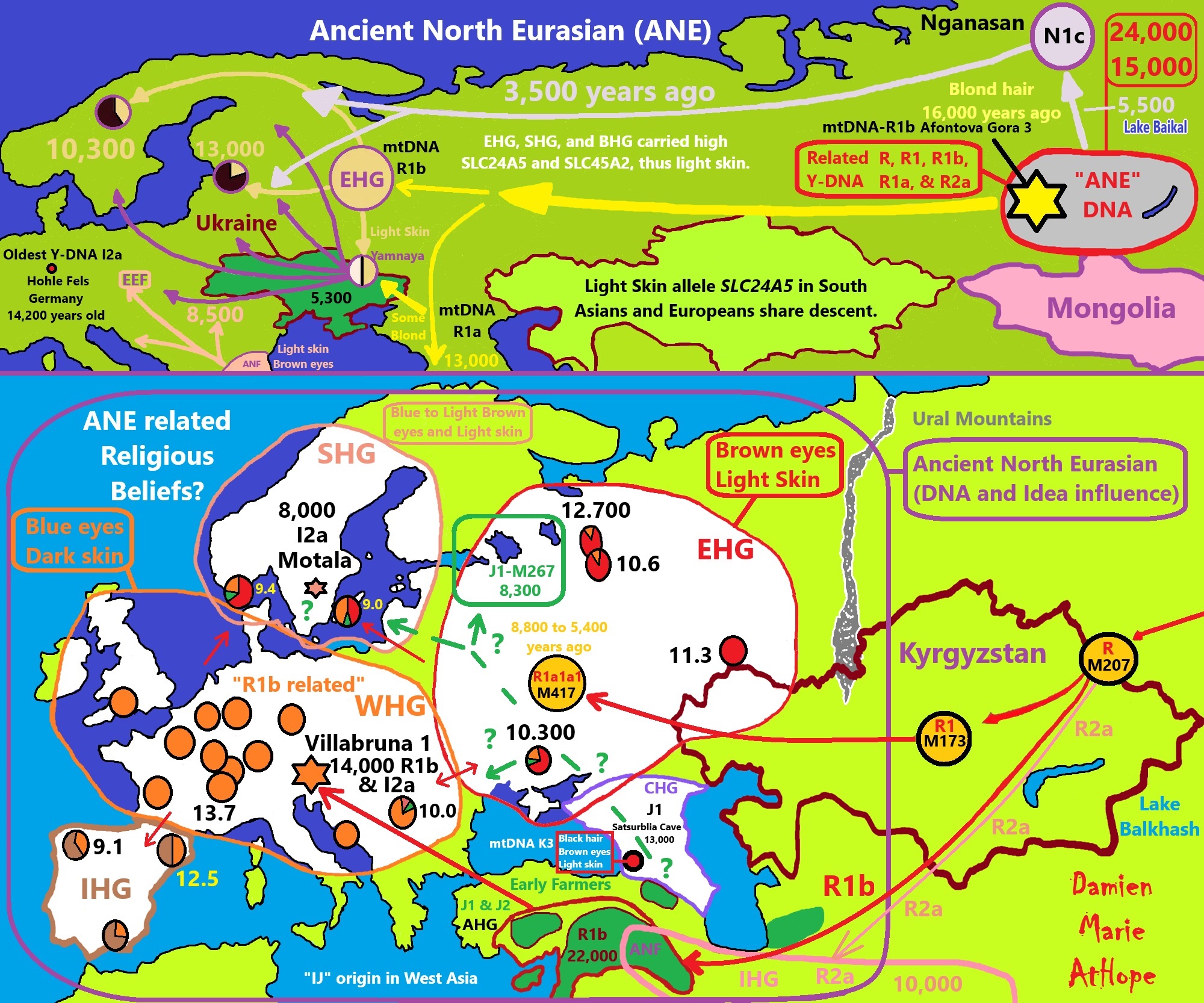
ref, ref, ref, ref, ref, ref, ref, ref, ref, ref, ref, ref, ref, ref, ref, ref, ref, ref, ref, ref, ref, ref, ref, ref, ref, ref, ref, ref, ref
Genetic Relations to Ancient North Eurasians (ANE):
Eastern hunter-gatherer (EHG)
Caucasus hunter-gatherer (CHG)
Zagros/Iranian Hunter-Gatherer (IHG)
Iranian Neolithic Farmers (INF)
Anatolian hunter-gatherer (AHG)
Anatolian Neolithic Farmers (ANF)
Early European Farmers (EEF)
Yamnaya/Steppe Herders (WSH)
Villabruna 1 (burial)/Ripari Villabruna rock shelter in northern Italy (14,000 years old)
Satsurblia Cave (burial) in the Country of Georgia (13,000 years old)
Motala (burial) (8,000 years old)
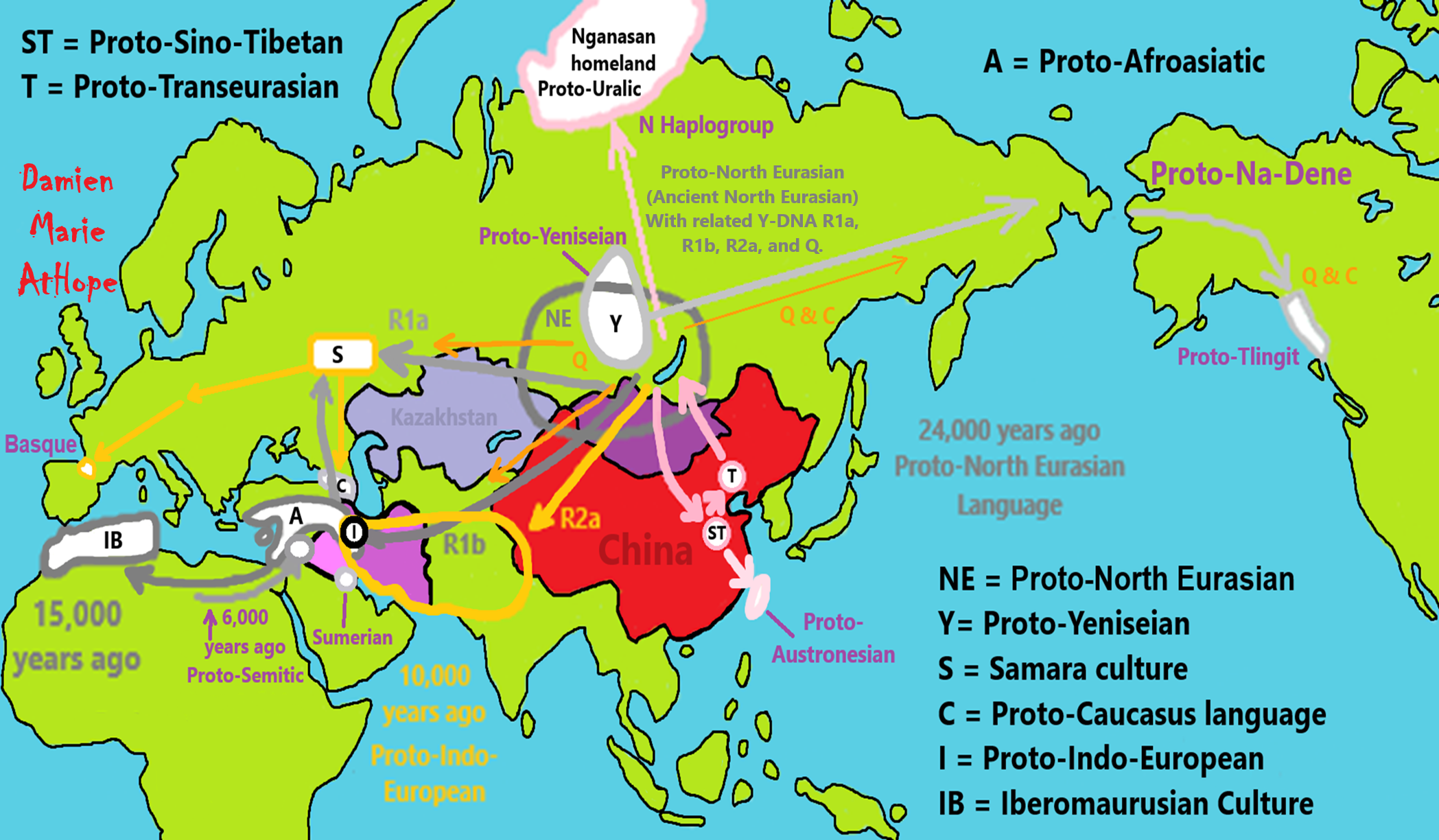
ref, ref, ref, ref, ref, ref, ref, ref, ref, ref, ref, ref, ref, ref, ref, ref, ref, ref, ref, ref, ref, ref, ref, ref, ref, ref, ref, ref, ref, ref, ref
This art above explains my thinking from my life of investigation
I am an anarchist (Social anarchism, Left-wing anarchism, or Socialist anarchism) trying to explain prehistory as I see it after studying it on my own starting 2006. Anarchists are for truth and believe in teaching the plain truth; misinformation is against this, and we would and should fight misinformation and disinformation.
I see anarchism as a social justice issue not limited to some political issue or monetary persuasion. People own themselves, have self/human rights, and deserve freedoms. All humanity is owed respect for its dignity; we are all born equal in dignity and human rights, and no plot of dirt we currently reside on changes this.
I fully enjoy the value (axiology) of archaeology (empirical evidence from fact or artifacts at a site) is knowledge (epistemology) of the past, adding to our anthropology (evidence from cultures both the present and past) intellectual (rational) assumptions of the likely reality of actual events from time past.
I am an Axiological Atheist, Philosopher & Autodidact Pre-Historical Writer/Researcher, Anti-theist, Anti-religionist, Anarcho Humanist, LGBTQI, Race, & Class equality. I am not an academic, I am a revolutionary sharing education and reason to inspire more deep thinking. I do value and appreciate Academics, Archaeologists, Anthropologists, and Historians as they provide us with great knowledge, informing us about our shared humanity.
I am a servant leader, as I serve the people, not myself, not my ego, and not some desire for money, but rather a caring teacher’s heart to help all I can with all I am. From such thoughtfulness may we all see the need for humanism and secularism, respecting all as helpful servant leaders assisting others as often as we can to navigate truth and the beauty of reality.
‘Reality’ ie. real/external world things, facts/evidence such as that confirmed by science, or events taken as a whole documented understanding of what occurred/is likely to have occurred; the accurate state of affairs. “Reason” is not from a mind devoid of “unreason” but rather demonstrates the potential ability to overcome bad thinking. An honest mind, enjoys just correction. Nothing is a justified true belief without valid or reliable reason and evidence; just as everything believed must be open to question, leaving nothing above challenge.
I don’t believe in gods or ghosts, and nor souls either. I don’t believe in heavens or hells, nor any supernatural anything. I don’t believe in Aliens, Bigfoot, nor Atlantis. I strive to follow reason and be a rationalist. Reason is my only master and may we all master reason. Thinking can be random, but reason is organized and sound in its Thinking. Right thinking is reason, right reason is logic, and right logic can be used in math and other scientific methods. I don’t see religious terms Animism, Totemism, Shamanism, or Paganism as primitive but original or core elements that are different parts of world views and their supernatural/non-natural beliefs or thinking.
I am inspired by philosophy, enlightened by archaeology, and grounded by science that religion claims, on the whole, along with their magical gods, are but dogmatic propaganda, myths, and lies. To me, religions can be summed up as conspiracy theories about reality, a reality mind you is only natural and devoid of magic anything. And to me, when people talk as if Atlantis is anything real, I stop taking them seriously. Like asking about the reality of Superman or Batman just because they seem to involve metropolitan cities in their stores. Or if Mother Goose actually lived in a shoe? You got to be kidding.
We are made great in our many acts of kindness, because we rise by helping each other.
NE = Proto-North Eurasian/Ancient North Eurasian/Mal’ta–Buret’ culture/Mal’ta Boy “MA-1” 24,000 years old burial
A = Proto-Afroasiatic/Afroasiatic
S = Samara culture
ST = Proto-Sino-Tibetan/Sino-Tibetan
T = Proto-Transeurasian/Altaic
C = Proto-Northwest Caucasus language/Northwest Caucasian/Languages of the Caucasus
I = Proto-Indo-European/Indo-European
IB = Iberomaurusian Culture/Capsian culture
Natufian culture (15,000–11,500 years ago, Syria, Lebanon, Jordan, the Sinai Peninsula, and the Negev desert)
Nganasan people/Nganasan language
Na-Dene languages/Dené–Yeniseian, Dené–Caucasian
Proto-Semitic/Semitic languages
24,000 years ago, Proto-North Eurasian Language (Ancient North Eurasian) migrations?
My thoughts:
Proto-North Eurasian Language (Ancient North Eurasian) With related Y-DNA R1a, R1b, R2a, and Q Haplogroups.
R1b 22,0000-15,000 years ago in the Middle east creates Proto-Afroasiatic languages moving into Africa around 15,000-10,000 years ago connecting with the Iberomaurusian Culture/Taforalt near the coasts of Morocco, Algeria, and Tunisia.
R2a 10,000 years ago in Iran brings/creates Proto-Indo-European language and also a possibility is R1a in Russia around 9,000 years ago may have had a version of Proto-Indo-European language.
Around 14,000-10,000 years ago??? Proto-North Eurasian Language goes to the Yellow River basin (eventually relating with the Yangshao culture) in China creates Proto-Sino-Tibetan language.
Proto-Sino-Tibetan language then moves to the West Liao River valley (eventually relating with the Hongshan culture) in China creating Proto-Transeurasian (Altaic) language around 9,000 years ago.
N Haplogroups 9,000 years ago with Proto-Transeurasian language possibly moves north to Lake Baikal. Then after living with Proto-North Eurasian Language 24,000-9,000 years ago?/Pre-Proto-Yeniseian language 9,000-7,000 years ago Q Haplogroups (eventually relating with the Ket language and the Ket people) until around 5,500 years ago, then N Haplogroups move north to the Taymyr Peninsula in North Siberia (Nganasan homeland) brings/creates the Proto-Uralic language.
Q Haplogroups with Proto-Yeniseian language /Proto-Na-Dene language likely emerge 8,000/7,000 years ago or so and migrates to the Middle East (either following R2a to Iraq or R1a to Russia (Samara culture) then south to Iraq creates the Sumerian language. It may have also created the Proto-Caucasian languages along the way. And Q Haplogroups with Proto-Yeniseian language to a migration to North America that relates to Na-Dené (and maybe including Haida) languages, of which the first branch was Proto-Tlingit language 5,000 years ago, in the Pacific Northwest.
Sino-Tibetan language then moves more east in China to the Hemudu culture pre-Austronesian culture, next moved to Taiwan creating the Proto-Austronesian language around 6,000-5,500 years ago.
R1b comes to Russia from the Middle East around 7,500 years ago, bringing a version of Proto-Indo-European languages to the (Samara culture), then Q Y-DNA with Proto-Yeniseian language moves south from the (Samara culture) and may have been the language that created the Proto-Caucasian language. And R1b from the (Samara culture) becomes the 4,200 years or so R1b associated with the Basques and Basque language it was taken with R1b, but language similarities with the Proto-Caucasian language implies language ties to Proto-Yeniseian language.
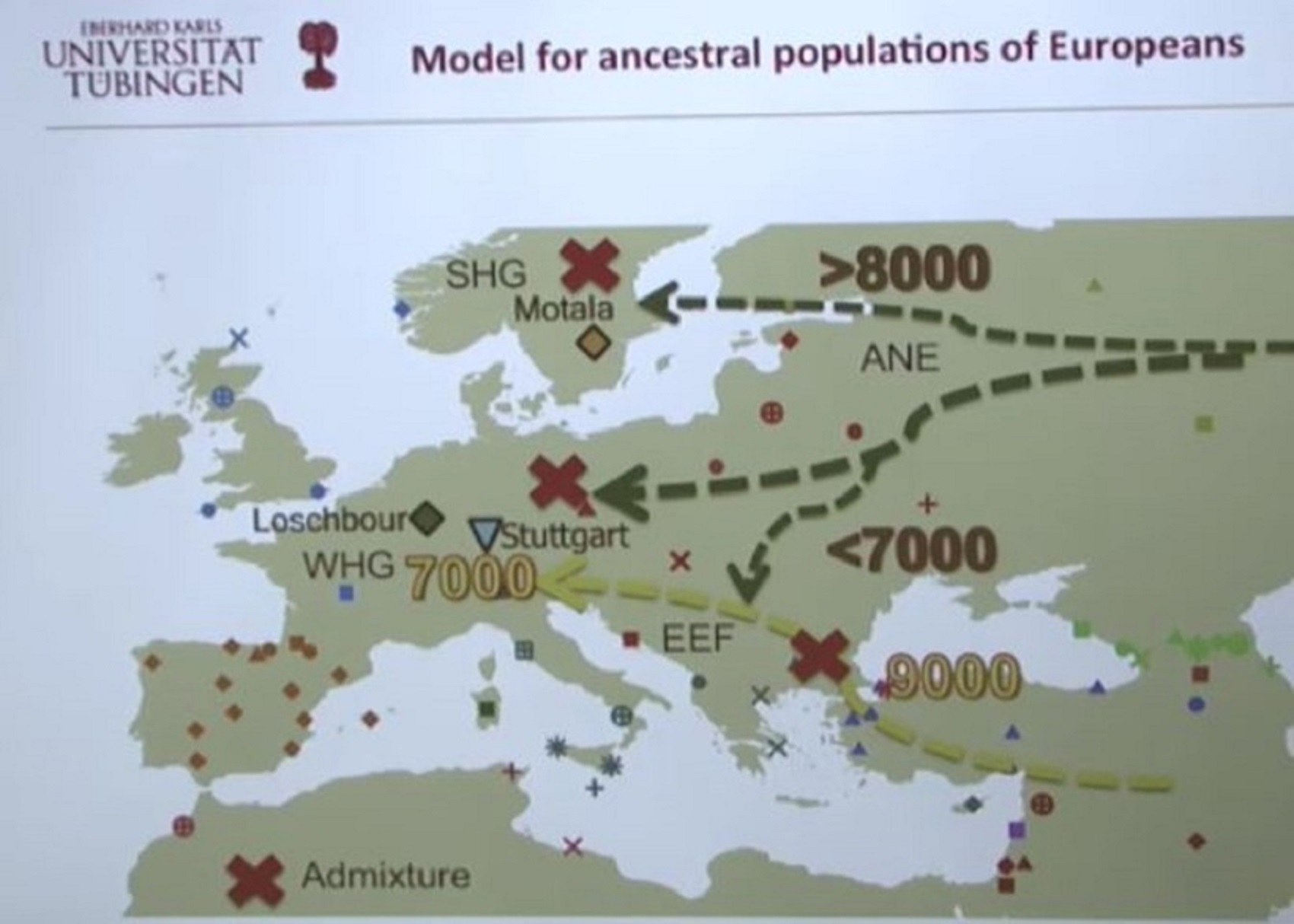
Pic ref
Ancient Human Genomes…Present-Day Europeans – Johannes Krause (Video)
Ancient North Eurasian (ANE)
Eastern Hunter-Gatherer (EHG)
Western Hunter-Gatherers (WHG)
Scandinavian Hunter-Gatherer (SHG)
Early European Farmers (EEF)
A quick look at the Genetic history of Europe
“The most significant recent dispersal of modern humans from Africa gave rise to an undifferentiated “non-African” lineage by some 70,000-50,000 years ago. By about 50–40 ka a basal West Eurasian lineage had emerged, as had a separate East Asian lineage. Both basal East and West Eurasians acquired Neanderthal admixture in Europe and Asia. European early modern humans (EEMH) lineages between 40,000-26,000 years ago (Aurignacian) were still part of a large Western Eurasian “meta-population”, related to Central and Western Asian populations. Divergence into genetically distinct sub-populations within Western Eurasia is a result of increased selection pressure and founder effects during the Last Glacial Maximum (LGM, Gravettian). By the end of the LGM, after 20,000 years ago, A Western European lineage, dubbed West European Hunter-Gatherer (WHG) emerges from the Solutrean refugium during the European Mesolithic. These Mesolithic hunter-gatherer cultures are substantially replaced in the Neolithic Revolution by the arrival of Early European Farmers (EEF) lineages derived from Mesolithic populations of West Asia (Anatolia and the Caucasus). In the European Bronze Age, there were again substantial population replacements in parts of Europe by the intrusion of Ancient North Eurasian (ANE) lineages from the Pontic–Caspian steppes. These Bronze Age population replacements are associated with the Beaker culture archaeologically and with the Indo-European expansion linguistically.” ref
“As a result of the population movements during the Mesolithic to Bronze Age, modern European populations are distinguished by differences in WHG, EEF, and ANE ancestry. Admixture rates varied geographically; in the late Neolithic, WHG ancestry in farmers in Hungary was at around 10%, in Germany around 25%, and in Iberia as high as 50%. The contribution of EEF is more significant in Mediterranean Europe, and declines towards northern and northeastern Europe, where WHG ancestry is stronger; the Sardinians are considered to be the closest European group to the population of the EEF. ANE ancestry is found throughout Europe, with a maximum of about 20% found in Baltic people and Finns. Ethnogenesis of the modern ethnic groups of Europe in the historical period is associated with numerous admixture events, primarily those associated with the Roman, Germanic, Norse, Slavic, Berber, Arab and Turkish expansions. Research into the genetic history of Europe became possible in the second half of the 20th century, but did not yield results with a high resolution before the 1990s. In the 1990s, preliminary results became possible, but they remained mostly limited to studies of mitochondrial and Y-chromosomal lineages. Autosomal DNA became more easily accessible in the 2000s, and since the mid-2010s, results of previously unattainable resolution, many of them based on full-genome analysis of ancient DNA, have been published at an accelerated pace.” ref
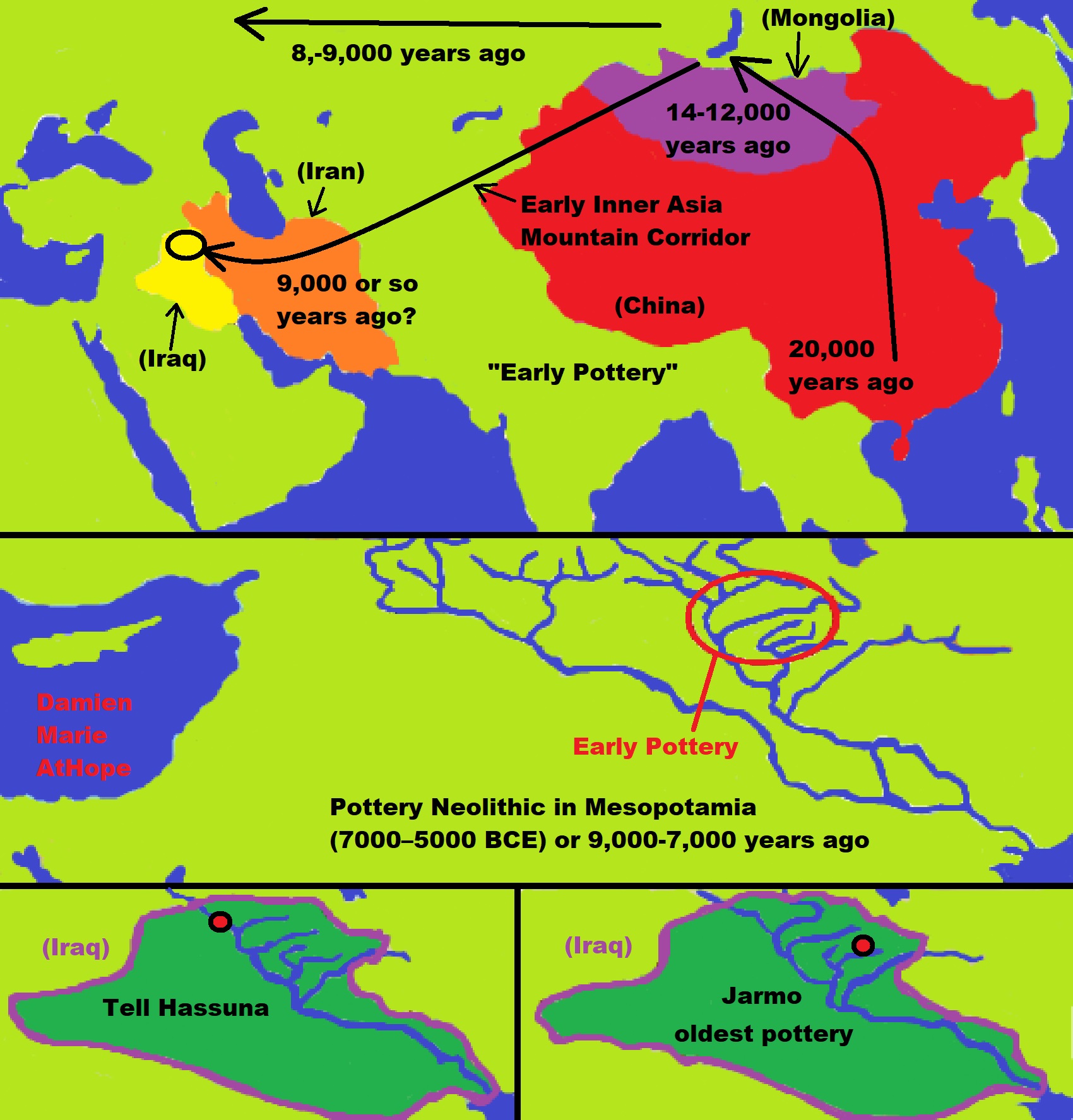
Genetics Reveal Movements of Ancient Siberians
“DNA reveals the previously unknown degree of mixture between Japan, North America, and the Eurasian mainland. Ancient DNA preserved in the icy climate of Siberia has revealed new insights about how ancient humans migrated five to seven thousand years ago.” ref
“In a study published recently in Current Biology, the researchers examined the DNA from 10 different ancient humans, which is quite a lot considering most of them date from 5,500 to 7,500 years old. These remains came from three locations in Siberia — the Altai Mountains, the Kamchatka Peninsula, and the Russian Far East.” ref
Altai Mountains meetings and Shamanism?
“Researchers were surprised to discover a previously unknown population with mixed genetics in the Altai Mountains in southern Siberia. At some point during the last Ice Age, a group of ancient north Eurasians mixed with a population from northeastern Siberia. The corresponding mixture is one that researchers haven’t seen before, the head researcher explained. It’s also not clear where these two groups first met and intermingled since the people were mostly nomadic at the time. It’s possible they met in the region where the remains are found, though, which may have provided a good passage between mountains to the north and the desert to the south. “It’s a perfect meeting point for groups, geographically speaking,” the head researcher explained.” ref
“Five of the Altai Mountains remains — all males — had very similar DNA, despite dating from different times between 7,500 and 5,500 years ago. But the sixth male, which dates to about 6,500 years ago, comes from farther east. The DNA shows this, but so does the archaeological context. The individual was buried with rich burial goods and a costume that the head researcher explained could indicate some sort of shamanism. Moreover, the head researcher explained it’s unclear whether this man is representative of a larger migration between the Altai Mountains and people farther east. But it shows that a degree of movement was occurring between different people at the time.” ref
Japanese Connection?
“Nest, one of the analyzed individuals was found in the Russian Far East. This male isn’t that remarkable at first glance, for the DNA resembles that of other similarly aged people that have been previously analyzed. Or at least three-quarters of the DNA is similar. The other quarter of this man’s genome appears to be Japanese. This discovery is surprising. This man dates back to about 7,000 years ago, but Japan was settled much earlier — possibly 30,000 years ago. This means that people from Japan were traveling back to the mainland and mixing with other humans there. “These hunter-gatherers were also able to cross bodies of water and interact among each other,” the head researcher explained. Overall, these results show how fluid ancient people were in Eurasia and even North America. “These foraging communities were in close contact with each other, they were highly mobile with each other and were admixing,” the head researcher also explained. “We are really talking about large-distance mobility.” ref
Crossing the water to and from the Americas?
“Two males and one female from Kamchatka lived relatively recently — only 500 years ago. The reason it’s interesting is that researchers haven’t previously published any ancient genome information from this region. All three of the remains the head researcher and his colleagues analyzed contained small portions of ancestry from Indigenous Americans. The presence of these markers suggests that Indigenous Americans were also crossing back to Russia prior to the period these individuals were alive. “This probably happened over a long period of time,” the head researcher explained. While researchers had previously known there was gene flow back and forth across the Bering Sea — perhaps for 5,000 years — this finding stretches that area of gene flow further south into the Kamchatka Peninsula.” ref
Here are other supporting articles:
- Americans’ Journeys to Asia Thousands of Years Ago Analysis of ten Eurasian individuals, up to 7,500 years old, gives a new picture of movement across continents
- Genomic study of the Ket: A Paleo-Eskimo-related ethnic group with significant ancient North Eurasian ancestry
- Paleolithic to Bronze Age Siberians Reveal Connections with First Americans and across Eurasia
- The genetic history of admixture across inner Eurasia. The indigenous populations of inner Eurasia, a huge geographic region covering the central Eurasian steppe and the northern Eurasian taiga and tundra, harbor tremendous diversity in their genes, cultures, and languages. In this study, we report novel genome-wide data for 763 individuals from Armenia, Georgia, Kazakhstan, Moldova, Mongolia, Russia, Tajikistan, Ukraine, and Uzbekistan.
- Genetic analysis reveals Europeans descended from at least three ancient groups. Almost all present-day Europeans descend from the mixing of Ancient North Eurasians and two other populations, earlier hunter-gatherers, and ancient Near Eastern farmers. Ancient North Eurasian DNA wasn’t found in either the hunter-gatherers or the early farmers, suggesting the Ancient North Eurasians arrived in the area later, he said. This group appears to have contributed DNA to present-day Europeans as well as to the people who traveled across the Bering Strait into the Americas more than 15,000 years ago.
Animism in Altai Mountain Area?
“Worship of nature, the three worlds in Altai mythology, Altai shamanism, Altai epic myths, Altai annual communal ceremonies marking the season cycles, sacred fire mythology, Prayers/Blessings, Altai magic (tarmalga), afterlife/soul belief, and Shamanistic Healing.”
“The Republic of Altai, (the mountainous Altai), is a republic of Russia located in southern Siberia, and is part of the Russian Federation. The Republic is located about 500km South of Novosibirsk, bordering China, Mongolia, and Kazakhstan. The Altai people, in total, number 76,000, and are made of 6 different groups; Telengit, Altai Kizhi, Tubular, Kumandin, Shor, and Chalkan. This research paper will focus on the 65,000 Altai (Telengit and Altai Kizhi) people who speak Southern Altai fluently. The language is used in arts, media, in education and in everyday life. The majority of the Altai are also fairly fluent in Russian, with the exception of those living in remote villages. I am interested in researching their animistic and shamanistic worldview and practices more thoroughly in order to have increased insight into their culture.” ref
Worship of nature?
“The Altai religious beliefs are based on animism. The Altai worship gods in nature, in trees, rivers, and mountains. In Altai, a wise person is one who knows and observes the laws of nature and who respects and lives in harmony with the forces of nature, which are all dependent on the energy from the sky, fire, and water spirits. There is a higher power (Ulgen), angels, spirits of the mountains, rivers, and springs, spirits of the home, and the ruler of the lower earth (Erlik). Altai’s mountains are sacred places to the clans of the Altai people. Mountains protect clans from evil spirits and facilitate prosperity and well-being. Each clan (seok) has a sacred mountain (yiyk tuu). Each valley, each mountain peak, and each spring has its own spirits, or masters, known in Altai as ‘eezi’.” ref
“The Altai tradition of worshipping mountain, river, and mountain-pass spirits has deep roots and still plays a significant role in the people’s worldview. Mountain spirits often occur in epics, myths, legends, and stories. There are specific rituals undertaken today, through which a particular clan worships at their mountain. The Altai try to pacify nature by bringing presents for the mountains, such as bright-colored ribbons to attach to trees and the sprinkling of alcohol and milk on the top of mountain passes to thank the gods for safe passage. The mountains in turn help people in trouble, and each mountain has its own name and legend. Previously, each traveler, knowing where he was going, and which mountain passes he would cross, would prepare his ribbons and take them with him. Through the tying of the ribbons, the traveler is asking a blessing, but also promising to keep the local traditions and preserve the Altai nature. The tying of the ribbons shows love and loyalty to the Altai spirit. The ribbons are normally white, but yellow ribbons symbolize the sun, blue the sky, red is fire and green symbolizes grass. This tradition is continued today.” ref
Three Worlds?
“There are three worlds in Altai mythology, with the ‘eternal poplar’ which symbolizes a world tree marking the center of the world. The road to the higher and lower levels of the world runs up and down this tree, which unites all the worlds by passing through the middle world where humans dwell. Good white substances rise up to the sky in blessings, and heavy black substances flow down towards the lower world, the realm of Erlik, and his evil forces. The middle world where humans dwell is divided into two; visible and invisible. The flat territory, such as plains and valleys, is the visible realm of man, and the mountains and rivers are the domains of the spirits, where man is a guest and must observe certain rules. These three worlds are interconnected and express the Altai understanding of God through nature.” ref
Shamans?
“Shamans are the link between the world of the living and that of the spirits. In Altai today, there are no official shamans who still use the dark force and worship Erlik. However, shamanistic rituals have played a large role in the history and the culture of the Altai people, and so these still play a large part in making up people’s worldview. Unofficially there are prophets (jarlikchi) who operate privately and use white energies in their rituals. There is a movement within Altai to revive the animistic and shamanist beliefs and practices.” ref
“Altai shamanism is oral in nature and there is no written statement of rules and regulations. The function of the shaman is healing, controlling the weather, exorcism, searching for lost objects and the sending of the spirits of the dead into the next world. The shaman in Altai is called the ‘kam’, who is a mediator between the world of the dead and humans. The shaman communicates with the spirits, using a drum, and is able to send his ‘double’ to different places in the universe. The shaman can also ask the spirits of nature to assist him. The ‘kam’ ability is inherited, and the man predestined to become a shaman, will fall ill in childhood and into a frenzy or trance. Black shamanism involves the worship of Erlik (the demonic Lord of the underworld) and travels to the spirit underworld.” ref
“The drum or tambourine is a special gift given by the gods to the shaman, as evidence that he is qualified. The ceremony of manufacturing and presenting the tambourine goes on for several days watched by a large crowd. The tambourine is played with a special rhythm while the shaman appeals to the gods. If the tambourine skin breaks during the ritual, it means spirits have come to punish the shaman and he will die soon. Other than the tambourine, the other sacred Altai object of worship is the shaman costume. When the shaman strikes the tambourine, the spirits rush towards him, and some settle in his garments and some in the tambourine. The most important spirits go into the shaman himself, with a large intake of breath from the shaman. The shaman clothes include braids, pendants, tissue, animal skins, and parts, as well as images of snakes and monsters.” ref
White Shamanism?
“White shamanism experienced a revival in the early 20th century and a movement was founded called the ‘White Faith’ (‘Ak Jang’). The followers of the ‘White Faith’ excluded contact with the dark spirits and underworld, and only worshipped the white guardians. The highest deity was called ‘Altai-Kudai’ in place of Ulgen. The ‘spirits of place’ were re-named ‘burkhans’ and that is why the ‘White Faith’ is also called ‘Burkhanism’ today. Blood sacrifice to the spirits using cattle was stopped, and so was the use of wine and tobacco in rituals. Their spirit messengers were re-named ‘jarlikchi’. The ‘White Faith’ movement is waiting for the return of the Oirot-khan as a national hero and Saviour. The White Faith group only communicates with the good white spirits and attempts to maintain harmony with nature and to bring blessing through their practices.” ref
Altai epic myths?
“The oral epic story tradition is of great importance to the Altai people, and traditionally these myths and legends were re-told through the medium of throat singing on the two-stringed lute (topshur). Originally, these throat singers were considered to have unusual abilities, as a result of their special relationship to the spirits. The ancient Altai epic myths show the life and history of the Altai people. They are oral masterpieces which been passed down from generation to generation. The epic “Altai Baatyrlar” (Altaian Bogatyrs or heroic warriors) was published in nine volumes (approximately 100,000 lines of poetry), and there are many other unpublished epic tales. The Altai myths also contain plots, heroes and characteristics from other people’s legends, such as the Kyrgyz or the Buryat. These epic stories are told through throat-singing (kay) and it can take a week to sing an epic of 7,000 lines.” ref
“The most famous Altai epic is called ‘Maadai-Kara’ by Elbek Kalkin. Khan Maadai-Kara is an old hero who has already lost his power. He sleeps for sixty days, but when he wakes up, he realizes that a hostile ruler is approaching to seize him, his property, and his people. When his wife gives birth to a son, Khan Maadai-Kara hides his son in the black mountain under the protection of the birch trees. This son is raised by the spirit-owner of Altai in the forests. When his parents are captured by Erlik, he eventually rescues them, and he returns the golden era to Altai. The epic stories are very similar in themes: wars with lords who attack Altai land and property; wars for brides when there are many candidates; or wars for stolen herds of animals. The characteristic of Altai legends is that all the heroes possess magic powers: the hero’s horse knows and sees everything; the wife of the hero can predict all things in advance; and the young girl knows beforehand whom she will marry.” ref
“The Altai also have legends which explain the creation of the world. According to these legends, there were three brothers in heaven who jointly created the world: Ulgen, Tayashi, and Erlik. However, after creating the world they argued amongst themselves about who had put the most effort into creating, and as a result of this argument they split the world into three parts: Ulgen stayed in the heavens, Tayashi came down to earth, and the youngest brother Erlik went to the under-world. From heaven, Ulgen rained down on earth cold, lightning, thunder, snow, and rain, and using this, Tayashi created on earth lakes and rivers, forests, and animals, and all the animals and birds that live in them. Under the earth, Erlik became angry and offended with his brothers, and decided to bring evil on all earth’s inhabitants, resulting in conflict and suffering to this day.” ref
Ceremonies?
“The Altai perform four major communal annual ceremonies, marking the season cycles of the year. They are Altai New Year in March (the ‘year-melt’), the rituals of spring (‘green leaves’), the rituals of autumn (‘yellow leaves’), and the New Year festival (‘white feast’). At the start of the summer, those conducting the ritual ask the higher powers for more livestock, a good harvest, and prosperity. In the autumn, they ask for the protection of livestock over the winter and a good end to a difficult period. These ceremonies are undergoing a period of revival in some Altai villages today.” ref
“During these festivals, milk and white food are cast into the fire, and white ribbons are hung on trees, in dedication to the local spirits and gods. The Altai are trying to gain the approval of the spirits and their blessing on the time ahead, and especially on the livestock, the hunting, and the harvest. There are also games, meals, and competitions organized along with these rituals. Once every two years, all of the Altai Republic gathers for the festival of El-Oyin, (‘nationwide games’) with the aim to maintain the customs and traditions of the Altai people, including sports, competitions, throat singing, and theatrical shows. I was present at the opening ceremony of this festival in 2017, when one of the epic Altai legends was acted out and sung.” ref
“Other ceremonies in Altai include the visitation of healing springs (arzhan) which involves a broad range of religious and healing rituals and procedures, including fasting and abstinence from smoking and alcohol. In order to visit the arzhan, one doesn’t have to be sick. On the contrary, it is considered best to conduct these rituals in order to support one’s life force.” ref
Fire?
“The Altai have a special relationship of respect to fire, and they call fire the ‘head of the family’. The home fire is sacred, so rubbish should not be thrown into it, it should never be extinguished, and gifts are made to the fire. The shaman will begin the ‘kam’ ritual celebrating and turning to the god of mother fire, and she can be asked for assistance in upcoming travels. If the Altai people do not fear fire, the fire will cause destructive fires in the home and in the village. During wedding preparations, while the bride’s hair is plaited, the groom lights a fire which represents the fire of their family life. If the fire burns well, they will have success as a family, and if the fire wanes or goes out, so will their family life. Every family must feed their own fire daily with food and milk offerings, and if a guest arrives with food, that food must first be offered also to the fire. If a family member becomes ill, they are placed on their back and cooled cinders from the hearth are placed on their stomach and rubbed in, while the house owner declares a blessing.” ref
Ails?
“Traditionally the Altai people lived in ails, which are hexagonal constructions made of timber with a conical roof. The door must be orientated towards the east, which is where the sun rises. It is only possible to move counterclockwise round the ail, and the honored guests are always seated in the place of honor near the fireplace. Today Altai families live in Russian houses, but they still use their ails as a summer house.” ref
Prayers and Blessings?
“A lot of the ancient Altai mythology is found in their prayers and blessing (alkysh). Communication with the good spirits of nature of the ‘excluded middle’ in the Altai spiritual worldview takes place by their prayers (ailatkysh) and blessings (alkysh). To read a blessing one needs to specify a certain intention or goal. Here is an example of an Altai blessing:
“Lord God Altai! Spirit of Altai! Precious elements! Give your blessing! May no dark substance curse my path with obstacles. Help me to fulfill my purpose. White substance, give your strength, pure substance, give the consciousness necessary in order to… (personal intention follows). May the spirit of kindness fill our hearts, God Altai, Spirit of Altai! Chok!” ref
“‘Chok’ means, ‘I worship, revere, and bow before you’. When making a blessing, the person should turn towards the East where the sun rises, and then to the peak of a sacred mountain and make a small bow. Men remove their hats and stroke their head several times from the crown to the forehead, and women stroke their hair forwards or push it behind their ears with both hands bending their head. Blessings are normally made at group gatherings, usually held at the new moon before mid-day in the morning sunlight. These blessings strengthen the energy of the soul and provide a way to influence one’s destiny for the better. They always take place outside and provide a link with nature, channeling the good energy of nature towards the person. Such blessings help to strengthen the energy of the soul.” ref
Magic?
“Altai magic (tarmalga) has existed for a very long time, and includes sorcery, wizardry, witchcraft, magic, superstitions, prediction, signs, omens, and incantations. Originally white and black magic existed together. The symbol for white magic in Altai is a leather milk vessel used for holding milk that is sprinkled during prayer. The sign for black magic is a mask, probably explained by the fact that the person loses their true identity when they practice black magic. There are various ritual objects now held in the National Museum in Altai that are covered in symbols and help explain some of the ancient magical practices. Cult signs can be found on flint stones. On the flint stones used in white magic, the morning star was shown, and on those used in black magic, either the evening star or two masks were depicted.” ref
“One of the most important actions of a sorcerer is the banishment of the spirit of illness or demons from a person’s soul. A demon may live in the center of a soul, and an illness can cause a person to be cruel and unkind, causing harm to those around him. Such a person has become a victim of dark energy which has come to live in his soul, banishing the white energy of kindness. If the sorcerer is not able to exorcise the illness, he may ask the assistance of the white shaman or prophet (jarlikchi). The healing rituals take place between the 8th and 15th day of the month when there is the whitest substance in the atmosphere. During the ritual the sorcerer or prophet will say a blessing or an incantation. The sick person may be given a protective amulet made by the prophet to be carried on his person for further protection from dark energies and influences.” ref
“During the ritual, the shaman uses a drum or tambourine, and a ritual object symbolizing images of the shaman’s ancestors on the maternal and paternal life for six generations. This would protect the shaman and his family from accidents, ill-spoken words, and the evil eye, and these objects were also used in divination. Every ritual object would have its own sphere of influence – over hunting, over sick people, over the health of children, over the cattle etc. There are currently no shamans in Altai serving the dark force as in the past. There are prophets (jarlikchi) who use white energies in the rituals and burn heather and juniper. The function of this interaction with the spirit world is protection over the evil dark forces, through incantations, amulets, and other ritual objects.” ref
Death?
In the very ancient Altai culture, death was considered a passage into another life, and a man’s possessions were buried with him. It was believed that a person goes into this life with a horse and goes out with it, so horses were buried with the rich. Nowadays, sometimes a ritual after death may be carried out by a spirit-seer in Altai, who makes offerings to the soul of the deceased. A spirit-seer is invited to the home of the deceased, and he is able to see the soul of the deceased. The soul communicates with the seer, expressing its last wishes before departing. On the seventh day the soul returns home to collect personal belongings needed in the next world and to have refreshments. The seer carries out a ritual to make offerings to the soul of the deceased, which takes place in the evening, with offerings made from an earthenware bowl. Food is placed in the bowl, alcohol is sprinkled on the ground and crockery is smashed.” ref
?On the seventh day the spirit of milk leaves the human body. The door should be kept ajar, and the home should be quiet and unlit. After the fortieth day the spirit of the deceased will never again return to the family home or pursue loved ones. The soul of the deceased may be sent to the underworld to be cleansed if the person has broken the laws of nature during their life. If the deceased appears in a relative’s dream, the prophet may be called to conduct another ritual, aiming to separate the deceased’s soul from the relative’s consciousness. The fire cleansing ritual is carried out in the relatives’ house and words of an incantation are spoken. The purpose of this communication with the soul of the dead is to provide protection for the living, and to allow the soul of the deceased to leave the body in a peaceful way.” ref
Healing?
“Healing has a special significance in the context of traditional Altai Shamanism. Every sickness is perceived as the work of evil, and so the need for healing by supernatural means is one of the crucial needs of the Altai people. An important part of the shaman’s work was healing, as the shamans would banish the spirit of illness or demons from the person’s soul. Now, despite the lack of official shamans, local folk doctors are sometimes preferred over medical doctors. Rituals for healing the sick are still carried out and the sick person may be given an amulet for protection from dark influences. Water is also believed by the Altai people to be a source of strength and healing. They believe that there are spirits who live in the rivers and lakes who are able to heal illness and give long-life.” ref
Blessing and Harmony?
“The gaining of favor and blessing from the good spirits in nature as a family and as a society is a key felt need of the Altai people. There are several important Altai festivals during the year, one of which is Chaga-Bairam, the Altai New Year. This is celebrated in February at the beginning of the new moon. It is an ancient festival which is designed to bring about the development of the Altai people and country, peace and favor to society, fullness and blessing in the family, and health to the cattle and crops to be planted later in the year. The festival begins early in the morning with a ritual to worship the sun of Altai. Sacrifices of milk products are brought on a special altar, ribbons are tied to trees and a fire is lit and fed. Later in the day there is a celebration, including skating on skates and furs, eating national food, and cultural and sport competitions. The Altai are celebrating the soon arrival of spring and the new cycle of the calendar year.” ref
“In June, while a full moon can be seen in the sky, the Altai people celebrated the holiday which was a symbol of the beginning of summer, called ‘Green leaves’. This was the time when the first leaves came out and everything was in blossom, so that people could graze their cattle again. During the holiday they thanked the spirits for a good winter. In autumn they celebrated ‘Yellow leaves’. This holiday is devoted to the master of Altai taiga forest. During this holiday people asked him for warm and ‘full of food’ winters. The Altai people need harmony with nature, good weather, and success in hunting, and these two festivals answered these felt needs. These Altai festivals have not been celebrated during the Soviet era, but currently, there is a revitalization of these rituals and in some places now in Altai these festivals are celebrated.” ref
Protection?
?The Altai people are searching for security and an ability to control basic life issues. They are looking for protection from potential dangers which are perceived to be linked to the spiritual world. One category of protection is from physical dangers: wild animals, weather conditions, road accidents, drowning, getting lost, and so on. These remain very important issues for hunters and professional drivers whose everyday life is endangered by harsh Siberian conditions. Another important category is protection from the influence of evil spirits. In the following paragraphs there is a description of different ways in which the Altai religion provides this protection, which is so eagerly sought.” ref
“In their houses, the Altai hang a protector of their house called a ‘jaik’. In order to set up the ‘jaik’ in the house, an unofficial shaman is invited. Then, each month, at the new moon, the spirit ‘jaik’ is presented with offerings of food. The ‘jaik’ is the defender and protector of the house and the heart of the family. The Altai also burn juniper and the smoke is considered a very valuable smell practically to kill bacteria, but also to cleanse the house and area around from evil spirits. It burns away black substance and strengthens the soul. The fire is also the heart of the family, providing protection, and traditionally was regularly fed to pacify and please the spirits. Moreover, any storm, illness or misfortune which occurs after the failure to observe the fire-feeding ritual may be interpreted as judgement from the spirits. The fire feeding is a way to influence everyday reality and avoid problems. Due to the high esteem shown to fire, the Altai people will never throw rubbish on a fire, spit on it or cross over it.” ref
“Another method to ward off unclean spirits, is the hanging of a bear’s paw over the door of the house. People believe that this paw can ward off unclean spirits. If a cow stops giving milk, it is believed that someone has given the cow the Evil Eye and that bad energy has affected the cow. At this point the owner of the house will take the paw of the bear and do a massage of the cow’s teats. The cow is relieved from stress and the milk will return. Whips are also hung over doors, connected to the belief that unclean spirits are afraid of the whip’s handle, since it is made from a thorny bush. Such a whip can also be used to exorcise unclean spirits from people.” ref
“After eating fatty food in the evening and before going outside, an Altai person will cleanse their mouth with a lit match or a hot branch from the fire. This is believed to stop an evil spirit licking the person’s lips. If they go to bed in an unknown house, they lie down with their head towards the door. Then, when an unclean spirit comes, it will fall on their legs instead of on their heads. In order to be protected from bad dreams at night, the Altai put a knife or match underneath their pillows.” ref
“Mothers also keep the umbilical cord of their children and make a guardian key-ring from it to protect their children. Previously this was sewn into the women’s Altai costume. The key-ring is four-cornered for a boy, and three-cornered for a girl. Above a newborn baby’s cot, Altai people also hang the claws of a wild beast and these will also protect the baby from unclean spirits. If someone kills a duck, above his tail there is a special part containing fat protected by the flapping of the duck’s wings. The hunter cuts off this fatty part and sews it into the clothes of a child, to ward off evil spirits. If some of the feathers, still attached to this fatty part of the duck, start to become fluffy like a dandelion, it is held that the child will grow up healthy.” ref
“A mother may sew small buttons and the claw of a rat into the fur coat of a child to protect it from the evil eye. These charms in Altai are connected often to animals and nature, and many can be obtained through hunting, which is an important part of Altai life and culture. The Altai hunters also have a special amulet that is the patron of their weapons. If the amulet is placed in a special pipe, tobacco is placed over it and it is smoked, then an unclean spirit cannot harm his hunter.” ref
Shamanism in Siberia?
“A large minority of people in North Asia, particularly in Siberia, follow the religio-cultural practices of shamanism. Some researchers regard Siberia as the heartland of shamanism. The people of Siberia comprise a variety of ethnic groups, many of whom continue to observe shamanistic practices in modern times. Many classical ethnographers recorded the sources of the idea of “shamanism” among Siberian peoples.” ref
Terminology in Siberian languages:
- ‘shaman’: saman (Nedigal, Nanay, Ulcha, Orok), sama (Manchu). The variant /šaman/ (i.e., pronounced “shaman”) is Evenk (whence it was borrowed into Russian).
- ‘shaman’: alman, olman, wolmen (Yukagir)
- ‘shaman’: [qam] (Tatar, Shor, Oyrat), [xam] (Tuva, Tofalar)
- The Buryat word for shaman is бөө (böö) [bøː], from early Mongolian böge. Itself borrowed from Proto-Turkic *bögü (“sage, wizard”)
- ‘shaman’: ńajt (Khanty, Mansi), from Proto-Uralic *nojta (c.f. Sámi noaidi)
- ‘shamaness’: [iduɣan] (Mongol), [udaɣan] (Yakut), udagan (Buryat), udugan (Evenki, Lamut), odogan (Nedigal). Related forms found in various Siberian languages include utagan, ubakan, utygan, utügun, iduan, or duana. All these are related to the Mongolian name of Etügen, the hearth goddess, and Etügen Eke ‘Mother Earth’. Maria Czaplicka points out that Siberian languages use words for male shamans from diverse roots, but the words for female shaman are almost all from the same root. She connects this with the theory that women’s practice of shamanism was established earlier than men’s, that “shamans were originally female.” ref
“Siberian shamans’ spirit-journeys (reenacting their dreams wherein they had rescued the soul of the client, “Living with gods: Siberian spirit of the hunt: The British Museum“) were conducted in, e.g., Oroch people, Altai people, and Nganasan people healing séances. Shamanistic practice shows great diversity, even if restricted to Siberia. In some cultures, the music or song related to shamanistic practice may mimic natural sounds, sometimes with onomatopoeia.” ref
“This holds true for the practices of the noaidi among Sami groups. Although the Sami people live outside of Siberia, many of their shamanistic beliefs and practice shared important features with those of some Siberian cultures. The joiks of the Sami were sung on shamanistic rites. Recently, joiks are sung in two different styles: one of these is sung only by young people; the traditional one may be the other, the “mumbling” style, which resembles magic spells. Several surprising characteristics of joiks can be explained by comparing the music ideals, as observed in joiks and contrasted to music ideals of other cultures. Some joiks intend to mimic natural sounds. This can be contrasted to bel canto, which intends to exploit human speech organs on the highest level to achieve an almost “superhuman” sound.” ref
“The intention to mimic natural sounds is present in some Siberian cultures as well: overtone singing, and also shamanic songs of some cultures can be examples.
- In a Soyot shamanic song, sounds of bird and wolf are imitated to represent helping spirits of the shaman.
- The seances of Nganasan shamans were accompanied by women imitating the sounds of the reindeer calf, (thought to provide fertility for those women). In 1931, A. Popov observed the Nganasan shaman Dyukhade Kosterkin imitating the sound of polar bear: the shaman was believed to have transformed into a polar bear.” ref
“Sound mimesis is not restricted to Siberian cultures and is not necessarily linked to shamanistic beliefs or practices. See, for example, Inuit throat singing, a game played by women, an example of Inuit music that employs overtone singing, and, in some cases, the imitation of natural sounds (mostly those of animals, e.g. geese). The imitation of animal sounds can also serve such practical reasons as luring game in hunt.” ref
Uralic?
Samoyedic?
“Among several Samoyedic peoples shamanism was a living tradition also in modern times, especially at groups living in isolation until recent times (Nganasans). There were distinguished several types of shamans among Nenets, Enets, and Selkup people. (The Nganasan shaman used three different crowns, according to the situation: one for upper world, one for underneath word, one for occasion of childbirth.) Nenets people, Enets people, Nganasan people speak Northern Samoyedic languages. They live in North Siberia (Nenets live also in European parts), they provide classical examples. Selkups are the only ones who speak Southern Samoyedic languages nowadays. They live more to the south, and shamanism was in decline also at the beginning of the 20th century, although folklore memories could be recorded even in the 1960s. Other Southern Samoyedic languages were spoken by some peoples living in the Sayan Mountains, but language shift has taken place, making all these languages extinct.” ref
Nenets?
“There were several types of shamans distinguishing ones contacting upper world, ones contacting underneath world, ones contacting the dead.” ref
Nganasan?
“The isolated location of Nganasan people enabled that shamanism was a living phenomenon among them even in the beginning of the 20th century, the last notable Nganasan shaman’s seances could be recorded on film in the 1970s. One of the occasions in which the shaman partook was the clean tent rite, held after the polar night, which included sacrifices.” ref
Sayan Samoyedic?
“Some peoples of the Sayan Mountains spoke once Southern Samoyedic languages. Most of them underwent a language shift in the beginning and middle of the 19th century, borrowing the language of neighboring Turkic peoples. The Kamassian language survived longer: 14 old people spoke it yet in 1914. In the late 20th century, some old people had passive or uncertain knowledge of the language, but collecting reliable scientific data was no longer possible. Today Kamassian is regarded as extinct. The shamanism of Samoyedic peoples in the Sayan Mountains survived longer (if we regard Karagas as a Samoyedic people, although such approaches have been refined: the problem of their origin may be more complex). Diószegi Vilmos could record not only folklore memories in the late 1950s, but he managed also to talk personally to (no longer practicing) shamans, record their personal memories, songs, some of their paraphernalia.” ref
“Whether this shamanism is borrowed entirely from neighboring Turkic peoples, or whether it has some ethnic features, maybe remnants of Samoyedic origin, is unresolved. Comparative considerations suggest, that
- Karagas shamanism is affected by Abakan-Turkic and Buryat influence. Among the various Soyot cultures, the central Soyot groups, keeping cattle and horses, show Khalkha Mongol phenomena in their shamanism, the shamanism of Western Soyots, living on the steppe, is similar to that of Altai Turkic peoples. A shaman story narrates contacts between Soyots and Abakan Turkic peoples in a mythical form.
- Karagas and Eastern (reindeer-breeding, mountain-inhabiting) Soyots. have many similarities in their culture and shamanism. It was these two cultures who presented some ethnic features, phenomena lacking among neighboring Turkic peoples. E.g., the structure of their shamanic drum showed such peculiarity: it had two transoms. It was also these two cultures who showed some features, which could be possibly of Samoyedic origin: the shaman’s headdress, dress, and boots has the effigies symbolizing human organs, mostly bones; in the case of headdress, representation of human face. Also the dress-initiating song of the Karagas shaman Kokuyev contained the expression “my shamanic dress with seven vertebrae”. Hoppál interprets the skeleton-like overlay of the Karagas shaman-dress as symbol of shamanic rebirth, similar remark applies for the skeleton-like iron ornamentation of the (not Samoyedic, but genealogically unclassified, Paleosiberian) Ket shamanic dress, although it may symbolize also the bones of the loon (the helper animal of the shaman). (The theory of Ket origin of the Karagas has already been mentioned above.) The skeleton-like overlay symbolized shamanic rebirth also among some other Siberian cultures.” ref
Hungarian?
“Starting from the late 9th century onwards, the ancestors of the Hungarian people migrated from their Proto-Uralic homeland in Siberia to the Pannonian Basin, an area that includes present-day Hungary. Today, shamanism is no longer widely practiced by Hungarians, but elements of shamanism have been preserved in their folklore. Comparative methods reveal that some motifs used in folktales, fragments of songs, and folk rhymes retain aspects of the ancient belief system. In an effort to prove that shamanistic remnants existed within Hungarian folklore ethnographer, Diószegi Vilmos, compared ethnographic records of Hungarian and neighboring peoples, and works about various shamanic traditions of some Siberian peoples. Mihály Hoppál continued Diószegi Vilmos’s work comparing shamanic beliefs of speakers of Uralic languages with those of several non-Uralic Siberian peoples. Although Ugrian folklore preserves many traces of shamanism, shamanism itself was a dying practice among the Khanty and Mansi people by the 1930s. Shamanism is still practiced by many indigenous peoples, but, among the modern Ugrians, shamanism is largely practiced by the Khanty.” ref
Ket?
“Traditional culture of Ket people was researched by Matthias Castrén, Vasiliy Ivanovich Anuchin, Kai Donner, Hans Findeisen, Yevgeniya Alekseyevna Alekseyenko. Shamanism was a living practice in the 1930s yet, but by the 1960s almost no authentic shaman could be found. Ket shamanism shared features with those of Turkic and Mongolic peoples. Besides that, there were several types of shamans, differing in function (sacral rites, curing), power, and associated animal (deer, bear). Also among Kets (like at several other Siberian peoples, e.g. Karagas), there are examples of using skeleton symbolics, Hoppál interprets it as a symbol of shamanic rebirth, although it may symbolize also the bones of the loon (the helper animal of the shaman, joining air and underwater world, just like the shaman who traveled both to the sky and the underworld as well). The skeleton-like overlay represented shamanic rebirth also among some other Siberian cultures.” ref
Turkic?

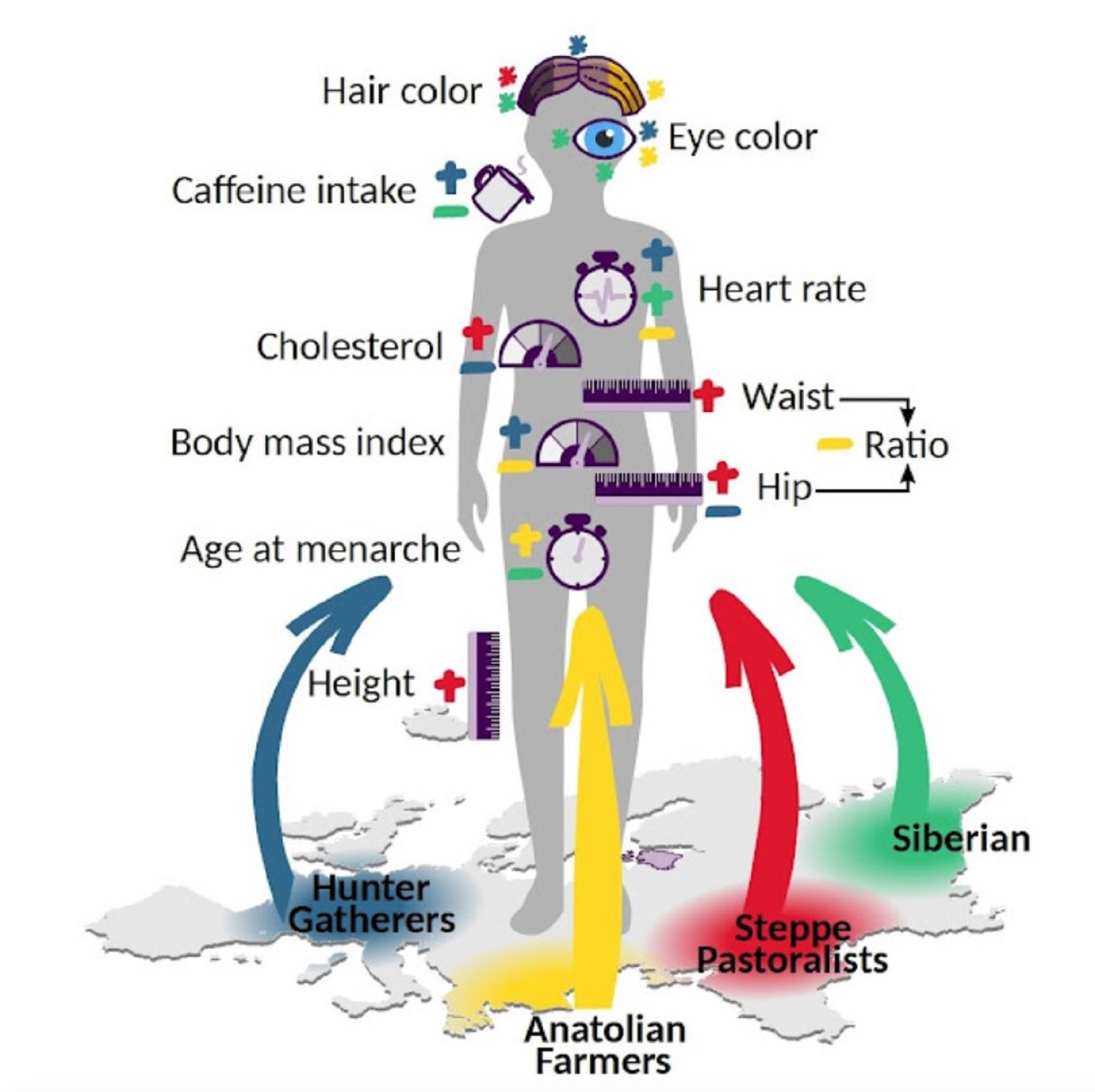
“The ANE lineage is defined by association with the MA-1, or “Mal’ta boy”, remains of 24,000 years ago in central Siberia Mal’ta-Buret’ culture 24,000-15,000 years ago. The Ancient North Eurasians (ANE) samples (Afontova Gora 3, Mal’ta 1, and Yana-RHS) show evidence for minor gene flow from an East Asian-related group (simplified by the Amis, Han, or Tianyuan) but no evidence for ANE-related geneflow into East Asians (Amis, Han, Tianyuan), except the Ainu, of North Japan.” ref
“The ANE lineage is defined by association with the MA-1, or “Mal’ta boy”, remains of 24,000 years ago in central Siberia Mal’ta-Buret’ culture 24,000-15,000 years ago “basal to modern-day Europeans”. Some Ancient North Eurasians also carried East Asian populations, such as Tianyuan Man.” ref
“Bronze-age-steppe Yamnaya and Afanasevo cultures were ANE at around 50% and Eastern Hunter-Gatherer (EHG) at around 75% ANE. Karelia culture: Y-DNA R1a-M417 8,400 years ago, Y-DNA J, 7,200 years ago, and Samara, of Y-haplogroup R1b-P297 7,600 years ago is closely related to ANE from Afontova Gora, 18,000 years ago around the time of blond hair first seen there.” ref
Ancient North Eurasian
“In archaeogenetics, the term Ancient North Eurasian (often abbreviated as ANE) is the name given to an ancestral West Eurasian component that represents descent from the people similar to the Mal’ta–Buret’ culture and populations closely related to them, such as from Afontova Gora and the Yana Rhinoceros Horn Site. Significant ANE ancestry are found in some modern populations, including Europeans and Native Americans.” ref
“The ANE lineage is defined by association with the MA-1, or “Mal’ta boy“, the remains of an individual who lived during the Last Glacial Maximum, 24,000 years ago in central Siberia, Ancient North Eurasians are described as a lineage “which is deeply related to Paleolithic/Mesolithic hunter-gatherers in Europe,” meaning that they diverged from Paleolithic Europeans a long time ago.” ref
“The ANE population has also been described as having been “basal to modern-day Europeans” but not especially related to East Asians, and is suggested to have perhaps originated in Europe or Western Asia or the Eurasian Steppe of Central Asia. However, some samples associated with Ancient North Eurasians also carried ancestry from an ancient East Asian population, such as Tianyuan Man. Sikora et al. (2019) found that the Yana RHS sample (31,600 BP) in Northern Siberia “can be modeled as early West Eurasian with an approximately 22% contribution from early East Asians.” ref
“Populations genetically similar to MA-1 were an important genetic contributor to Native Americans, Europeans, Central Asians, South Asians, and some East Asian groups, in order of significance. Lazaridis et al. (2016:10) note “a cline of ANE ancestry across the east-west extent of Eurasia.” The ancient Bronze-age-steppe Yamnaya and Afanasevo cultures were found to have a noteworthy ANE component at ~50%.” ref
“According to Moreno-Mayar et al. 2018 between 14% and 38% of Native American ancestry may originate from gene flow from the Mal’ta–Buret’ people (ANE). This difference is caused by the penetration of posterior Siberian migrations into the Americas, with the lowest percentages of ANE ancestry found in Eskimos and Alaskan Natives, as these groups are the result of migrations into the Americas roughly 5,000 years ago.” ref
“Estimates for ANE ancestry among first wave Native Americans show higher percentages, such as 42% for those belonging to the Andean region in South America. The other gene flow in Native Americans (the remainder of their ancestry) was of East Asian origin. Gene sequencing of another south-central Siberian people (Afontova Gora-2) dating to approximately 17,000 years ago, revealed similar autosomal genetic signatures to that of Mal’ta boy-1, suggesting that the region was continuously occupied by humans throughout the Last Glacial Maximum.” ref
“The earliest known individual with a genetic mutation associated with blonde hair in modern Europeans is an Ancient North Eurasian female dating to around 16000 BCE from the Afontova Gora 3 site in Siberia. It has been suggested that their mythology may have included a narrative, found in both Indo-European and some Native American fables, in which a dog guards the path to the afterlife.” ref
“Genomic studies also indicate that the ANE component was introduced to Western Europe by people related to the Yamnaya culture, long after the Paleolithic. It is reported in modern-day Europeans (7%–25%), but not of Europeans before the Bronze Age. Additional ANE ancestry is found in European populations through paleolithic interactions with Eastern Hunter-Gatherers, which resulted in populations such as Scandinavian Hunter-Gatherers.” ref
“The Ancient North Eurasians (ANE) split from the ancestors of European peoples somewhere in the Middle East or South-central Asia, and used a northern dispersal route through Central Asia into Northern Asia and Siberia. Genetic analyses show that all ANE samples (Afontova Gora 3, Mal’ta 1, and Yana-RHS) show evidence for minor gene flow from an East Asian-related group (simplified by the Amis, Han, or Tianyuan). In contrast, no evidence for ANE-related geneflow into East Asians (Amis, Han, Tianyuan), except the Ainu, was found.” ref
“Genetic data suggests that the ANE formed during the Terminal Upper-Paleolithic (36+-1,5ka) period from a deeply European-related population, which was once widespread in Northern Eurasia, and from an early East Asian-related group, which migrated northwards into Central Asia and Siberia, merging with this deeply European-related population. These population dynamics and constant northwards geneflow of East Asian-related ancestry would later gave rise to the “Ancestral Native Americans” and Paleosiberians, which replaced the ANE as dominant population of Siberia.” ref
Groups partially derived from the Ancient North Eurasians
“Eastern Hunter-Gatherer (EHG) is a lineage derived predominantly (75%) from ANE. It is represented by two individuals from Karelia, one of Y-haplogroup R1a-M417, dated c. 8.4 kya, the other of Y-haplogroup J, dated c. 7.2 kya; and one individual from Samara, of Y-haplogroup R1b-P297, dated c. 7.6 kya. This lineage is closely related to the ANE sample from Afontova Gora, dated c. 18 kya. After the end of the Last Glacial Maximum, the Western Hunter-Gatherers (WHG) and EHG lineages merged in Eastern Europe, accounting for early presence of ANE-derived ancestry in Mesolithic Europe. Evidence suggests that as Ancient North Eurasians migrated West from Eastern Siberia, they absorbed Western Hunter-Gatherers and other West Eurasian populations as well.” ref
“Caucasian Hunter-Gatherer (CHG) is represented by the Satsurblia individual dated ~13 kya (from the Satsurblia cave in Georgia), and carried 36% ANE-derived admixture. While the rest of their ancestry is derived from the Dzudzuana cave individual dated ~26 kya, which lacked ANE-admixture, Dzudzuana affinity in the Caucasus decreased with the arrival of ANE at ~13 kya Satsurblia.” ref
“Scandinavian Hunter-Gatherer (SHG) is represented by several individuals buried at Motala, Sweden ca. 6000 BC. They were descended from Western Hunter-Gatherers who initially settled Scandinavia from the south, and later populations of EHG who entered Scandinavia from the north through the coast of Norway.” ref
“Iran Neolithic (Iran_N) individuals dated ~8.5 kya carried 50% ANE-derived admixture and 50% Dzudzuana-related admixture, marking them as different from other Near-Eastern and Anatolian Neolithics who didn’t have ANE admixture. Iran Neolithics were later replaced by Iran Chalcolithics, who were a mixture of Iran Neolithic and Near Eastern Levant Neolithic.” ref
“Ancient Beringian/Ancestral Native American are specific archaeogenetic lineages, based on the genome of an infant found at the Upward Sun River site (dubbed USR1), dated to 11,500 years ago. The AB lineage diverged from the Ancestral Native American (ANA) lineage about 20,000 years ago.” ref
“West Siberian Hunter-Gatherer (WSHG) are a specific archaeogenetic lineage, first reported in a genetic study published in Science in September 2019. WSGs were found to be of about 30% EHG ancestry, 50% ANE ancestry, and 20% to 38% East Asian ancestry.” ref
“Western Steppe Herders (WSH) is the name given to a distinct ancestral component that represents descent closely related to the Yamnaya culture of the Pontic–Caspian steppe. This ancestry is often referred to as Yamnaya ancestry or Steppe ancestry.” ref
“Late Upper Paeolithic Lake Baikal – Ust’Kyakhta-3 (UKY) 14,050-13,770 BP were mixture of 30% ANE ancestry and 70% East Asian ancestry.” ref
“Lake Baikal Holocene – Baikal Eneolithic (Baikal_EN) and Baikal Early Bronze Age (Baikal_EBA) derived 6.4% to 20.1% ancestry from ANE, while rest of their ancestry was derived from East Asians. Fofonovo_EN near by Lake Baikal were mixture of 12-17% ANE ancestry and 83-87% East Asian ancestry.” ref
“Hokkaido Jōmon people specifically refers to the Jōmon period population of Hokkaido in northernmost Japan. Though the Jōmon people themselves descended mainly from East Asian lineages, one study found an affinity between Hokkaido Jōmon with the Northern Eurasian Yana sample (an ANE-related group, related to Mal’ta), and suggest as an explanation the possibility of minor Yana gene flow into the Hokkaido Jōmon population (as well as other possibilities). A more recent study by Cooke et al. 2021, confirmed ANE-related geneflow among the Jōmon people, partially ancestral to the Ainu people. ANE ancestry among Jōmon people is estimated at 21%, however, there is a North to South cline within the Japanese archipelago, with the highest amount of ANE ancestry in Hokkaido and Tohoku.” ref
Genetic origins of the Minoans and Mycenaeans
“Mycenaeans (Mycenaean Greece or the Mycenaean civilization: was the last phase of the Bronze Age in Ancient Greece) differed from Minoans (Minoan civilization: was a Bronze Age Aegean civilization on the island of Crete) in deriving additional ancestry from an ultimate source related to the hunter-gatherers of eastern Europe and Siberia, introduced via a proximal source related to either the inhabitants of either the Eurasian steppe or Armenia. Modern Greeks resemble the Mycenaeans, but with some additional dilution of the early Neolithic ancestry. Our results support the idea of continuity but not isolation in the history of populations of the Aegean, before and after the time of its earliest civilizations.” https://www.ncbi.nlm.nih.gov/pmc/articles/PMC5565772/

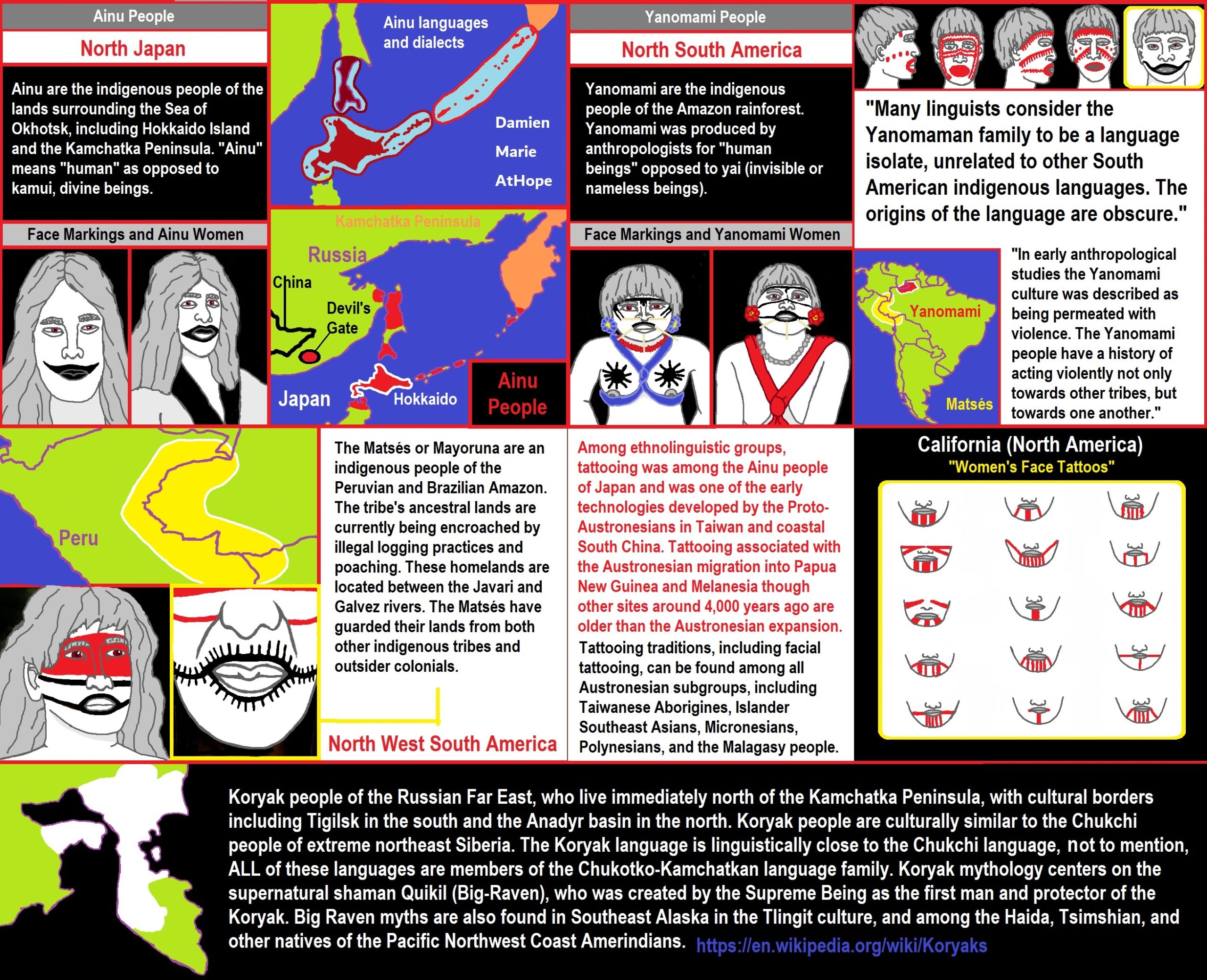
ref, ref, ref, ref, ref, ref, ref, ref, ref, ref
Ainu people
“The Ainu are the indigenous people of the lands surrounding the Sea of Okhotsk, including Hokkaido Island, Northeast Honshu Island, Sakhalin Island, the Kuril Islands, the Kamchatka Peninsula, and Khabarovsk Krai, before the arrival of the Yamato Japanese and Russians. These regions are referred to as Ezo (蝦夷) in historical Japanese texts. In 1966 there were about 300 native Ainu speakers, while in 2008, there were about 100 native Ainu speakers.” ref
Official estimates place the total Ainu population of Japan at 25,000. Unofficial estimates place the total population at 200,000 or higher, as the near-total assimilation of the Ainu into Japanese society has resulted in many individuals of Ainu descent having no knowledge of their ancestry. As of 2000, the number of “pure” Ainu was estimated at about 300 people.” ref
“This people’s most widely known ethnonym, “Ainu” (Ainu: アィヌ; Japanese: アイヌ; Russian: Айны) means “human” in the Ainu language, particularly as opposed to kamui, divine beings. Ainu also identify themselves as “Utari” (“comrade” or “people”). Official documents use both names.” ref
“The Ainu are the native people of Hokkaido, Sakhalin and the Kurils. Early Ainu-speaking groups (mostly hunters and fishermen) migrated also into the Kamchatka Peninsula and into Honshu, where their descendants are today known as the Matagi hunters, who still use a large amount of Ainu vocabulary in their dialect. Other evidence for Ainu-speaking hunters and fishermen migrating down from Northern Hokkaido into Honshu is through the Ainu toponyms which are found in several places of northern Honshu, mostly among the western coast and the Tōhoku region. Evidence for Ainu speakers in the Amur region is found through Ainu loanwords in the Uilta and Ulch people.” ref
“Research suggests that Ainu culture originated from a merger of the Okhotsk and Satsumon cultures. According to Lee and Hasegawa, the Ainu-speakers descend from the Okhotsk people which rapidly expanded from northern Hokkaido into the Kurils and Honshu. These early inhabitants did not speak the Japanese language; some were conquered by the Japanese early in the 9th century. In 1264, the Ainu invaded the land of the Nivkh people. The Ainu also started an expedition into the Amur region, which was then controlled by the Yuan Dynasty, resulting in reprisals by the Mongols who invaded Sakhalin. Active contact between the Wa-jin (the ethnically Japanese, also known as Yamato-jin) and the Ainu of Ezogashima (now known as Hokkaidō) began in the 13th century. The Ainu formed a society of hunter-gatherers, surviving mainly by hunting and fishing. They followed a religion which was based on natural phenomena.” ref
“The Ainu have often been considered to descend from the diverse Jōmon people, who lived in northern Japan from the Jōmon period (c. 14,000 to 300 BCE). One of their Yukar Upopo, or legends, tells that “[t]he Ainu lived in this place a hundred thousand years before the Children of the Sun came”. Recent research suggests that the historical Ainu culture originated from a merger of the Okhotsk culture with the Satsumon culture, cultures thought to have derived from the diverse Jōmon-period cultures of the Japanese archipelago. The Ainu economy was based on farming, as well as on hunting, fishing, and gathering.” ref
“According to Lee and Hasegawa of the Waseda University, the direct ancestors of the later Ainu people formed during the late Jōmon period from the combination of the local but diverse population of Hokkaido, long before the arrival of contemporary Japanese people. Lee and Hasegawa suggest that the Ainu language expanded from northern Hokkaido and may have originated from a relative more recent Northeast Asian/Okhotsk population, which established themselves in northern Hokkaido and had significant impact on the formation of Hokkaido’s Jōmon culture.” ref
“The linguist and historian Joran Smale similarly found that the Ainu language likely originated from the ancient Okhotsk people, which had strong cultural influence on the “Epi-Jōmon” of southern Hokkaido and northern Honshu, but that the Ainu people themselves formed from the combination of both ancient groups. Additionally, he notes that the historical distribution of Ainu dialects and its specific vocabulary corresponds to the distribution of the maritime Okhotsk culture.” ref
“Recently in 2021, it was confirmed that the Hokkaido Jōmon people formed from “Jōmon tribes of Honshu” and from “Terminal Upper-Paleolithic people” (TUP people) indigenous to Hokkaido and Paleolithic Northern Eurasia. The Honshu Jōmon groups arrived about 15,000 BC and merged with the indigenous “TUP people” to form the Hokkaido Jōmon. The Ainu in turn formed from the Hokkaido Jōmon and from the Okhotsk people.” ref
“Another study in 2021 (Sato et al.) analyzed the indigenous populations of northern Japan and the Russian Far East. They concluded that Siberia and northern Japan was populated by two distinct waves: “the southern migration wave seems to have diversified into the local populations in East Asia (defined in this paper as a region including China, Japan, Korea, Mongol, and Taiwan) and Southeast Asia, and the northern wave, which probably runs through the Siberian and Eurasian steppe regions and mixed with the southern wave, probably in Siberia. Archaeologists have considered that bear worship, which is a religious practice widely observed among the northern Eurasian ethnic groups, including the Ainu, Finns, Nivkh, and Sami, was also shared by the Okhotsk people. On the other hand, no traces of such a religious practice have ever been discovered from archaeological sites of the Jomon and Epi-Jomon periods, which were anterior to the Ainu cultural period. This implies that the Okhotsk culture contributed to the forming of the Ainu culture.” ref
Genetics: Genetic history of East Asians and Jōmon people
Paternal lineages
“Genetic testing has shown that the Ainu belong mainly to Y-DNA haplogroup D-M55 (D1a2) and C-M217. Y DNA haplogroup D M55 is found throughout the Japanese Archipelago, but with very high frequencies among the Ainu of Hokkaidō in the far north, and to a lesser extent among the Ryukyuans in the Ryukyu Islands of the far south. Recently it was confirmed that the Japanese branch of haplogroup D M55 is distinct and isolated from other D branches for more than 53,000 years.” ref
“Several studies (Hammer et al. 2006, Shinoda 2008, Matsumoto 2009, Cabrera et al. 2018) suggest that haplogroup D originated somewhere in Central Asia. According to Hammer et al., the ancestral haplogroup D originated between Tibet and the Altai mountains. He suggests that there were multiple waves into Eastern Eurasia.” ref
“A study by Tajima et al. (2004) found two out of a sample of sixteen Ainu men (or 12.5%) belong to Haplogroup C M217, which is the most common Y chromosome haplogroup among the indigenous populations of Siberia and Mongolia. Hammer et al. (2006) found that one in a sample of four Ainu men belonged to haplogroup C M217.” ref
Maternal lineages
“Based on analysis of one sample of 51 modern Ainu, their mtDNA lineages consist mainly of haplogroup Y [11⁄51 = 21.6% according to Tanaka et al. 2004, or 10⁄51 = 19.6% according to Adachi et al. 2009, who have cited Tajima et al. 2004], haplogroup D [9⁄51 = 17.6%, particularly D4 (xD1)], haplogroup M7a (8⁄51 = 15.7%), and haplogroup G1 (8⁄51 = 15.7%). Other mtDNA haplogroups detected in this sample include A (2⁄51), M7b2 (2⁄51), N9b (1⁄51), B4f (1⁄51), F1b (1⁄51), and M9a (1⁄51). Most of the remaining individuals in this sample have been classified definitively only as belonging to macro-haplogroup M.” ref
“According to Sato et al. (2009), who have studied the mtDNA of the same sample of modern Ainus (N=51), the major haplogroups of the Ainu are N9 [14⁄51 = 27.5%, including 10⁄51 Y and 4⁄51 N9 (xY)], D [12⁄51 = 23.5%, including 8⁄51 D (xD5) and 4⁄51 D5], M7 (10⁄51 = 19.6%), and G (10⁄51 = 19.6%, including 8⁄51 G1 and 2⁄51 G2); the minor haplogroups are A (2⁄51), B (1⁄51), F (1⁄51), and M (xM7, M8, CZ, D, G) (1⁄51).” ref
“Studies published in 2004 and 2007 show the combined frequency of M7a and N9b were observed in Jōmons and which are believed by some to be Jōmon maternal contribution at 28% in Okinawans [7⁄50 M7a1, 6⁄50 M7a (xM7a1), 1⁄50 N9b], 17.6% in Ainus [8⁄51 M7a (xM7a1), 1⁄51 N9b], and from 10% [97⁄1312 M7a (xM7a1), 1⁄1312 M7a1, 28⁄1312 N9b] to 17% [15⁄100 M7a1, 2⁄100 M7a (xM7a1)] in mainstream Japanese. In addition, haplogroups D4, D5, M7b, M9a, M10, G, A, B, and F have been found in Jōmon people as well. These mtDNA haplogroups were found in various Jōmon samples and in some modern Japanese people.” ref
“A study by Kanazawa-Kiriyama in 2013 about mitochondrial haplogroups, found that the Ainu people (including samples from Hokkaido and Tōhoku) have a high frequency of N9b, which is also found among Udege people of eastern Siberia, and more common among Europeans than Eastern Asians, but absent from the geographically close Kantō Jōmon period samples, which have a higher frequency of M7a7, which is commonly found among East and Southeast Asians. According to the authors, these results add to the internal-diversity observed among the Jōmon period population and that a significant percentage of the Jōmon period people had ancestry from a Northeast Asian source population, suggested to be the source of the proto-Ainu language and culture, which is not detected in samples from Kantō.” ref
Autosomal DNA
“A 2004 reevaluation of cranial traits suggests that the Ainu resemble the Okhotsk more than they do the Jōmon but there are large variations. This agrees with the references to the Ainu as a merger of Okhotsk and Satsumon referenced above. Similarly, more recent studies link the Ainu to the local Hokkaido Jōmon period samples, such as the 3,800-year-old Rebun sample.” ref
“Genetic analyses of HLA I and HLA II genes as well as HLA-A, -B, and -DRB1 gene frequencies links the Ainu to Indigenous peoples of the Americas. Genetic of variety Asian groups shows Ainu and of Native Americans are place relatively close can be traced back to Paleolithic groups in Siberia.” ref
“Hideo Matsumoto (2009) suggested, based on immunoglobulin analyses, that the Ainu (and Jōmon) have a Siberian origin. Compared with other East Asian populations, the Ainu have the highest amount of Siberian (immunoglobulin) components, higher than mainland Japanese people. A 2012 genetic study has revealed that the closest genetic relatives of the Ainu are the Ryukyuan people, followed by the Yamato people and Nivkh.” ref
“A genetic analysis in 2016 showed that although the Ainu have some genetic relations to the Japanese people and Eastern Siberians (especially Itelmens and Chukchis), they are not directly related to any modern ethnic group. Further, the study detected genetic contribution from the Ainu to populations around the Sea of Okhotsk but no genetic influence on the Ainu themselves. According to the study, the Ainu-like genetic contribution in the Ulch people is about 17.8% or 13.5% and about 27.2% in the Nivkhs. The study also disproved the idea about a relation to Andamanese or Tibetans; instead, it presented evidence of gene flow between the Ainu and “lowland East Asian farmer populations” (represented in the study by the Ami and Atayal in Taiwan, and the Dai and Lahu in Mainland East Asia).” ref
“A genetic study in 2016 about historical Ainu samples from southern Sakhalin (8) and northern Hokkaido (4), found that these samples were closely related to ancient Okhotsk people and various other Northeast Asians, such as indigenous populations in Kamchatka (Itelmens). The authors conclude that this points to heterogeneity among the historical Ainu, as other studies reported a rather isolated position of analyzed Ainu samples from southern Hokkaido.” ref
“Recent autosomal evidence suggests that the Ainu derive a majority of their ancestry from the local Jōmon period people of Hokkaido. A 2019 study by Gakuhari et al., analyzing ancient Jōmon remains, finds about 79.3% Hokkaido Jōmon ancestry in the Ainu. Another 2019 study (by Kanazawa-Kiriyama et al.) finds about 66% Hokkaido Jōmon ancestry. A genetic study in 2021 (Sato et al.) found that the Ainu probably derived about ~49% of their ancestry from the local Hokkaido Jōmon, ~22% from the Okhotsk (samplified by Chukotko-Kamchatkan peoples), and ~29% from the Yamato Japanese.” ref
“Population genomic data from various Jōmon period samples show that their main ancestry component split from other East Asian people at about 15,000 BCE. Following their migration into the Japanese archipelago, they became largely isolated from outside geneflow. However, geneflow from Ancient North Eurasians towards the Jōmon period population was detected along a North to South cline, with a peak among Hokkaido Jōmon.” ref
“A study by Adachi et al. 2018 concluded that: “Our results suggest that the Ainu were formed from the Hokkaido Jomon people, but subsequently underwent considerable admixture with adjacent populations. The present study strongly recommends revision of the widely accepted dual-structure model for the population history of the Japanese, in which the Ainu are assumed to be the direct descendants of the Jomon people.” ref
“The Ainu often resemble Native Americans, but exhibit a variation of phenotypes, ranging from “Caucasian” to East Asian, with many having an intermediate appearance. Physical differences could be observed between different Ainu subgroups and clans. The numerous large Kabata and Hidaka Ainu clans largely resembled Northeast Asians and Northeastern Siberians, rather than Europeans. The physical differences between Ainu and neighboring Japanese and Koreans, was found to be not as large as early historians suggested. Many Ainu men have abundant wavy hair and often have long beards. There was also a number of mixed Russian-Ainu individuals.” ref
“The book of Ainu Life and Legends by author Kyōsuke Kindaichi (published by the Japanese Tourist Board in 1942) contains a physical description of Ainu: “Many have wavy hair, but some straight black hair. Very few of them have wavy brownish hair. Their skins are generally reported to be light brown. But this is due to the fact that they labor on the sea and in briny winds all day. Old people who have long desisted from their outdoor work are often found to be as white as western men. The Ainu have broad faces, beetling eyebrows, and sometimes large sunken eyes, which are generally horizontal and of the so-called European type. Eyes of the Mongolian type are rare but occasionally found among them.” ref
“A comparative study by Brace et al. (2001) showed a closer morphological relation of the Ainu and their Hokkaido Jōmon ancestors with prehistoric and living European groups. The study concludes that part of their ancestors are descended from of a population (dubbed “Eurasians” by Brace et al.) that moved into northern Eurasia eastwards in the Late Pleistocene, which significantly predates the expansion of the modern core population of East Asia from Mainland Southeast Asia. According to the authors, these morphological similarities suggest distant genetic ties at one time, and provides some basis for the long-time claim that the Ainu have an Indo-European component among their ancestry.” ref
“A study by Kura et al. 2014 based on cranial and genetic characteristics suggests a mostly Northeastern Asian (“Arctic“) origin for Ainu people. Thus, despite Ainu sharing some morphological similarities to Caucasoid populations, the Ainu are essentially of North Asiatic origin. Genetic evidence supports a closer relation with Paleosiberian Arctic populations, such as the Chukchi people. A study by Omoto has shown that the Ainu are closer related to other East Asian groups (previously mentioned as ‘Mongoloid’) than to Western Eurasian groups (formerly termed as “Caucasian”), on the basis of fingerprints and dental morphology.” ref
“A study published in the scientific journal “Nature” by Jinam et al. 2015, using genome-wide SNP data comparison, found that a noteworthy amount of Ainu carry gene alleles associated with facial features which are commonly found among Europeans but absent from Japanese people and other East Asians, but these alleles are not found in all tested Ainu samples. These alleles are the reason for their pseudo-Caucasian appearance and likely arrived from Paleolithic Siberia.” ref
“In 2021, it was confirmed that the Hokkaido Jōmon population formed from “Terminal Upper-Paleolithic people” (TUP) indigenous to Hokkaido and Northern Eurasia and from migrants of Jōmon period Honshu. The Ainu themselves formed from these heterogeneous Hokkaido Jōmon and from a more recent Northeast Asian/Okhotsk population. Traditional Ainu culture was quite different from Japanese culture. According to Tanaka Sakurako from the University of British Columbia, the Ainu culture can be included into a wider “northern circumpacific region”, referring to various indigenous cultures of Northeast Asia and “beyond the Bering Strait” in North America.” ref
“Never shaving after a certain age, the men had full beards and moustaches. Men and women alike cut their hair level with the shoulders at the sides of the head, trimmed semicircularly behind. The women tattooed (anchi-piri) their mouths, and sometimes the forearms. The mouth tattoos were started at a young age with a small spot on the upper lip, gradually increasing with size.” ref
“The soot deposited on a pot hung over a fire of birch bark was used for colour. Their traditional dress was a robe spun from the inner bark of the elm tree, called attusi or attush. Various styles were made, and consisted generally of a simple short robe with straight sleeves, which was folded around the body, and tied with a band about the waist. The sleeves ended at the wrist or forearm and the length generally was to the calves. Women also wore an undergarment of Japanese cloth.” ref
“The Ainu hunted from late autumn to early summer. The reasons for this were, among others, that in late autumn, plant gathering, salmon fishing, and other activities of securing food came to an end, and hunters readily found game in fields and mountains in which plants had withered. A village possessed a hunting ground of its own or several villages used a joint hunting territory (iwor). Heavy penalties were imposed on any outsiders trespassing on such hunting grounds or joint hunting territory.” ref
“The Ainu hunted Ussuri brown bears, Asian black bears, Ezo deer (a subspecies of sika deer), hares, red foxes, Japanese raccoon dogs, and other animals. Ezo deer were a particularly important food resource for the Ainu, as were salmon. They also hunted sea eagles such as white-tailed sea eagles, raven, and other birds. The Ainu hunted eagles to obtain their tail feathers, which they used in trade with the Japanese.” ref
“The Ainu hunted with arrows and spears with poison-coated points. They obtained the poison, called surku, from the roots and stalks of aconites. The recipe for this poison was a household secret that differed from family to family. They enhanced the poison with mixtures of roots and stalks of dog’s bane, boiled juice of Mekuragumo (a type of harvestman), Matsumomushi (Notonecta triguttata, a species of backswimmer), tobacco, and other ingredients. They also used stingray stingers or skin covering stingers.” ref
“They hunted in groups with dogs. Before the Ainu went hunting, particularly for bear and similar animals, they prayed to the god of fire, the house guardian god, to convey their wishes for a large catch, and to the god of mountains for safe hunting.” ref
“The Ainu usually hunted bear during the spring thaw. At that time, bears were weak because they had not fed at all during their long hibernation. Ainu hunters caught hibernating bears or bears that had just left hibernation dens. When they hunted bear in summer, they used a spring trap loaded with an arrow, called an amappo. The Ainu usually used arrows to hunt deer. Also, they drove deer into a river or sea and shot them with arrows. For a large catch, a whole village would drive a herd of deer off a cliff and club them to death.” ref
“Fishing was important for the Ainu. They largely caught trout, primarily in summer, and salmon in autumn, as well as “ito” (Japanese huchen), dace, and other fish. Spears called “marek” were often used. Other methods were “tesh” fishing, “uray” fishing and “rawomap” fishing. Many villages were built near rivers or along the coast. Each village or individual had a definite river fishing territory. Outsiders could not freely fish there and needed to ask the owner.” ref
“Men wore a crown called sapanpe for important ceremonies. Sapanpe was made from wood fibre with bundles of partially shaved wood. This crown had wooden figures of animal gods and other ornaments on its center. Men carried an emush (ceremonial sword) secured by an emush at strap to their shoulders.” ref
“Women wore matanpushi, embroidered headbands, and ninkari, earrings. Ninkari was a metal ring with a ball. Matanpushi and ninkari were originally worn by men. Furthermore, aprons called maidari now are a part of women’s formal clothes. However, some old documents say that men wore maidari. Women sometimes wore a bracelet called tekunkani.” ref
“Women wore a necklace called rektunpe, a long, narrow strip of cloth with metal plaques. They wore a necklace that reached the breast called a tamasay or shitoki, usually made from glass balls. Some glass balls came from trade with the Asian continent. The Ainu also obtained glass balls secretly made by the Matsumae clan.” ref
“The Ainu people had various types of marriage. A child was promised in marriage by arrangement between his or her parents and the parents of his or her betrothed or by a go-between. When the betrothed reached a marriageable age, they were told who their spouse was to be. There were also marriages based on mutual consent of both sexes. In some areas, when a daughter reached a marriageable age, her parents let her live in a small room called tunpu annexed to the southern wall of her house. The parents chose her spouse from men who visited her. The age of marriage was 17 to 18 years of age for men and 15 to 16 years of age for women, who were tattooed. At these ages, both sexes were regarded as adults.” ref
“When a man proposed to a woman, he visited her house, ate half a full bowl of rice handed to him by her, and returned the rest to her. If the woman ate the rest, she accepted his proposal. If she did not and put it beside her, she rejected his proposal. When a man became engaged to a woman or they learned that their engagement had been arranged, they exchanged gifts. He sent her a small engraved knife, a workbox, a spool, and other gifts. She sent him embroidered clothes, coverings for the back of the hand, leggings, and other handmade clothes.” ref
“The worn-out fabric of old clothing was used for baby clothes because soft cloth was good for the skin of babies and worn-out material protected babies from gods of illness and demons due to these gods’ abhorrence of dirty things. Before a baby was breast-fed, they were given a decoction of the endodermis of alder and the roots of butterburs to discharge impurities. Children were raised almost naked until about the ages of four to five. Even when they wore clothes, they did not wear belts and left the front of their clothes open. Subsequently, they wore bark clothes without patterns, such as attush, until coming of age.” ref
“Newborn babies were named ayay (a baby’s crying), shipo, poyshi (small excrement), and shion (old excrement). Children were called by these “temporary” names until the ages of two to three. They were not given permanent names when they were born. Their tentative names had a portion meaning “excrement” or “old things” to ward off the demon of ill-health. Some children were named based on their behavior or habits. Other children were named after impressive events or after parents’ wishes for the future of the children. When children were named, they were never given the same names as others.” ref
“Men wore loincloths and had their hair dressed properly for the first time at age 15–16. Women were also considered adults at the age of 15–16. They wore underclothes called mour and had their hair dressed properly and wound waistcloths called raunkut and ponkut around their bodies. When women reached age 12–13, the lips, hands, and arms were tattooed. When they reached age 15–16, their tattoos were completed. Thus were they qualified for marriage.” ref
Religion: Ainu creation myth, Ko-Shintō, and Shamanism in Siberia
See also: Category:Ainu mythology
“The Ainu are traditionally animists, believing that everything in nature has a kamuy (spirit or god) on the inside. The most important include Kamuy-huci, goddess of the hearth, Kim-un-kamuy, god of bears and mountains, and Repun Kamuy, god of the sea, fishing, and marine animals. Kotan-kar-kamuy is regarded as the creator of the world in the Ainu religion.” ref
“The Ainu have no priests by profession; instead the village chief performs whatever religious ceremonies are necessary. Ceremonies are confined to making libations of sake, saying prayers, and offering willow sticks with wooden shavings attached to them. These sticks are called inaw (singular) and nusa (plural). They are placed on an altar used to “send back” the spirits of killed animals. Ainu ceremonies for sending back bears are called Iyomante. The Ainu people give thanks to the gods before eating and pray to the deity of fire in time of sickness. They believe that their spirits are immortal, and that their spirits will be rewarded hereafter by ascending to kamuy mosir (Land of the Gods).” ref
“The Ainu are part of a larger collective of indigenous people who practice “arctolatry” or bear worship. The Ainu believe that the bear holds particular importance as Kim-un Kamuy’s chosen method of delivering the gift of the bear’s hide and meat to humans. John Batchelor reported that the Ainu view the world as being a spherical ocean on which float many islands, a view based on the fact that the sun rises in the east and sets in the west. He wrote that they believe the world rests on the back of a large fish, which when it moves causes earthquakes.” ref
“Ainu assimilated into mainstream Japanese society have adopted Buddhism and Shintō, while some northern Ainu were converted as members of the Russian Orthodox Church. Regarding Ainu communities in Shikotanto (色丹) and other areas that fall within the Russian sphere of cultural influence, there have been cases of church construction as well as reports that some Ainu have decided to profess their Christian faith.” ref
“There have also been reports that the Russian Orthodox Church has performed some missionary projects in the Sakhalin Ainu community. However, not many people have converted and there are only reports of several persons who have converted. Converts have been scorned as “Nutsa Ainu” (Russian Ainu) by other members of the Ainu community. Even so, the reports indicate that many Ainu have kept their faith in the deities of ancient times.” ref
Evolution of blond hair?
“Single nucleotide polymorphisms of the KITLG gene are associated with blonde hair color in various human populations. One of these polymorphisms is associated with blond hair. The earliest known individual with this allele is a female south-central Siberian ANE individual from Afontova Gora 3 site, which is dated to 16130-15749 BCE. It is thus argued that at least some ANE individuals were blonde-haired.” ref
Geneticist David Reich said that the KITLG gene for blond hair probably entered continental Europe in a population migration wave from the Eurasian steppe, by a population carrying substantial Ancient North Eurasian ancestry. Hanel and Carlberg (2020) likewise report that populations bearing Ancient North Eurasian ancestry were responsible for contributing gene alleles lightening European hair color.” ref
‘Ancient North Eurasians’ and Comparative mythology
“Since the term ‘Ancient North Eurasian’ refers to a genetic bridge of connected mating networks, scholars of comparative mythology have argued that they probably shared myths and beliefs that could be reconstructed via the comparison of stories attested within cultures that were not in contact for millennia and stretched from the Pontic–Caspian steppe to the American continent.” ref
“For instance, the mytheme of the dog guarding the Otherworld possibly stems from an older Ancient North Eurasian belief, as suggested by similar motifs found in Indo-European, Native American, and Siberian mythology. In Siouan, Algonquian, Iroquoian, and in Central and South American beliefs, a fierce guard dog was located in the Milky Way, perceived as the path of souls in the afterlife, and getting past it was a test. The Siberian Chukchi and Tungus believed in a guardian-of-the-afterlife dog and a spirit dog that would absorb the dead man’s soul and act as a guide in the afterlife. In Indo-European myths, the figure of the dog is embodied by Cerberus, Sarvarā, and Garmr. Anthony and Brown note that it might be one of the oldest mythemes recoverable through comparative mythology.” ref
“A second canid-related series of beliefs, myths, and rituals connected dogs with healing rather than death. For instance, Ancient Near Eastern and Turkic–Kipchaq myths are prone to associate dogs with healing and generally categorized dogs as impure. A similar myth-pattern is assumed for the Eneolithic site of Botai in Kazakhstan, dated to 3500 BCE or 5,522 years ago, which might represent the dog as an absorber of illness and guardian of the household against disease and evil. In Mesopotamia, the goddess Nintinugga, associated with healing, was accompanied or symbolized by dogs. Similar absorbent-puppy healing and sacrifice rituals were practiced in Greece and Italy, among the Hittites, again possibly influenced by Near Eastern traditions.” ref
Proto-Indo-European mythology
“Proto-Indo-European mythology is the body of myths and deities associated with the Proto-Indo-Europeans, the hypothetical speakers of the reconstructed Proto-Indo-European language. Although the mythological motifs are not directly attested – since Proto-Indo-European speakers lived in preliterate societies – scholars of comparative mythology have reconstructed details from inherited similarities found among Indo-European languages, based on the assumption that parts of the Proto-Indo-Europeans’ original belief systems survived in the daughter traditions.” ref
“The Proto-Indo-European pantheon includes a number of securely reconstructed deities, since they are both cognates – linguistic siblings from a common origin –, and associated with similar attributes and body of myths: such as *Dyḗws Ph₂tḗr, the daylight-sky god; his consort *Dʰéǵʰōm, the earth mother; his daughter *H₂éwsōs, the dawn goddess; his sons the Divine Twins; and *Seh₂ul, a solar goddess. Some deities, like the weather god *Perkʷunos or the herding-god *Péh₂usōn, are only attested in a limited number of traditions – Western (European) and Graeco-Aryan, respectively – and could therefore represent late additions that did not spread throughout the various Indo-European dialects.” ref
“Some myths are also securely dated to Proto-Indo-European times, since they feature both linguistic and thematic evidence of an inherited motif: a story portraying a mythical figure associated with thunder and slaying a multi-headed serpent to release torrents of water that had previously been pent up; a creation myth involving two brothers, one of whom sacrifices the other in order to create the world; and probably the belief that the Otherworld was guarded by a watchdog and could only be reached by crossing a river.” ref
“Various schools of thought exist regarding possible interpretations of the reconstructed Proto-Indo-European mythology. The main mythologies used in comparative reconstruction are Indo-Iranian, Baltic, Roman, and Norse, often supported with evidence from the Celtic, Greek, Slavic, Hittite, Armenian, Illyrian, and Albanian traditions as well.” ref
“The mythology of the Proto-Indo-Europeans is not directly attested and it is difficult to match their language to archaeological findings related to any specific culture from the Chalcolithic. Nonetheless, scholars of comparative mythology have attempted to reconstruct aspects of Proto-Indo-European mythology based on the existence of linguistic and thematic similarities among the deities, religious practices, and myths of various Indo-European peoples. This method is known as the comparative method. Different schools of thought have approached the subject of Proto-Indo-European mythology from different angles.” ref
“The Meteorological or Naturist School holds that Proto-Indo-European myths initially emerged as explanations for natural phenomena, such as the Sky, the Sun, the Moon, and the Dawn. Rituals were therefore centered around the worship of those elemental deities. This interpretation was popular among early scholars, such as Friedrich Max Müller, who saw all myths as fundamentally solar allegories. Although recently revived by some scholars like Jean Haudry and Martin L. West, this school lost most of its scholarly support in the late nineteenth and early twentieth centuries.” ref
“The Ritual School, which first became prominent in the late nineteenth century, holds that Proto-Indo-European myths are best understood as stories invented to explain various rituals and religious practices. Scholars of the Ritual School argue that those rituals should be interpreted as attempts to manipulate the universe in order to obtain its favors. This interpretation reached the height of its popularity during the early twentieth century, and many of its most prominent early proponents, such as James George Frazer and Jane Ellen Harrison, were classical scholars. Bruce Lincoln, a contemporary member of the Ritual School, argues for instance that the Proto-Indo-Europeans believed that every sacrifice was a reenactment of the original sacrifice performed by the founder of the human race on his twin brother.” ref
“The Functionalist School, by contrast, holds that myths served as stories reinforcing social behaviours through the meta-narrative justification of a traditional order. Scholars of the Functionalist School were greatly influenced by the trifunctional system proposed by Georges Dumézil, which postulates a tripartite ideology reflected in a threefold division between a clerical class (encompassing both the religious and social functions of the priests and rulers), a warrior class (connected with the concepts of violence and braveness), and a class of farmers or husbandmen (associated with fertility and craftsmanship), on the basis that many historically known groups speaking Indo-European languages show such a division. Dumézil’s theory had a major influence on Indo-European studies from the mid-20th century onwards, and some scholars continue to operate under its framework, although it has also been criticized as aprioristic and too inclusive, and thus impossible to be proved or disproved.” ref
“The Structuralist School argues that Proto-Indo-European mythology was largely centered around the concept of dualistic opposition. They generally hold that the mental structure of all human beings is designed to set up opposing patterns in order to resolve conflicting elements. This approach tends to focus on cultural universals within the realm of mythology rather than the genetic origins of those myths, such as the fundamental and binary opposition rooted in the nature of marriage proposed by Tamaz V. Gamkrelidze and Vyacheslav Ivanov. It also offers refinements of the trifunctional system by highlighting the oppositional elements present within each function, such as the creative and destructive elements both found within the role of the warrior.” ref
Source mythologies
“One of the earliest attested and thus one of the most important of all Indo-European mythologies is Vedic mythology, especially the mythology of the Rigveda, the oldest of the Vedas. Early scholars of comparative mythology such as Friedrich Max Müller stressed the importance of Vedic mythology to such an extent that they practically equated it with Proto-Indo-European myths. Modern researchers have been much more cautious, recognizing that, although Vedic mythology is still central, other mythologies must also be taken into account.” ref
“Another of the most important source mythologies for comparative research is Roman mythology. Contrary to the frequent erroneous statement made by some authors that “Rome has no myth”, the Romans possessed a very complex mythological system, parts of which have been preserved through the characteristic Roman tendency to rationalize their myths into historical accounts. Despite its relatively late attestation, Norse mythology is still considered one of the three most important of the Indo-European mythologies for comparative research, due to the vast bulk of surviving Icelandic material.” ref
“Baltic mythology has also received a great deal of scholarly attention, as it is linguistically the most conservative and archaic of all surviving branches, but has so far remained frustrating to researchers because the sources are so comparatively late. Nonetheless, Latvian folk songs are seen as a major source of information in the process of reconstructing Proto-Indo-European myth. Despite the popularity of Greek mythology in western culture, Greek mythology is generally seen as having little importance in comparative mythology due to the heavy influence of Pre-Greek and Near Eastern cultures, which overwhelms what little Indo-European material can be extracted from it. Consequently, Greek mythology received minimal scholarly attention until the first decade of the 21st century.” ref
“Although Scythians are considered relatively conservative in regards to Proto-Indo-European cultures, retaining a similar lifestyle and culture, their mythology has very rarely been examined in an Indo-European context and infrequently discussed in regards to the nature of the ancestral Indo-European mythology. At least three deities, Tabiti, Papaios, and Api, are generally interpreted as having Indo-European origins, while the remaining have seen more disparate interpretations. Influence from Siberian, Turkic, and even Near Eastern beliefs, on the other hand, are more widely discussed in literature.” ref
Cosmology: Indo-European cosmogony
“There was a fundamental opposition between the never-aging gods dwelling above in the skies, and the mortal humans living beneath on earth. The earth *dʰéǵʰōm was perceived as a vast, flat, and circular continent surrounded by waters (“the Ocean”). Although they may sometimes be identified with mythical figures or stories, the stars (*h₂stḗr) were not bound to any particular cosmic significance and were perceived as ornamental more than anything else. According to Martin L. West, the idea of the world-tree (axis mundi) is probably a later import from north Asiatic cosmologies: “The Greek myth might be derived from the Near East, and the Indic and Germanic ideas of a pillar from the shamanistic cosmologies of the Finnic and other peoples of central and northern Asia.” ref
Reconstruction
“There is no scholarly consensus as to which of the variants is the most accurate reconstruction of the Proto-Indo-European cosmogonic myth.[38] Bruce Lincoln‘s reconstruction of the Proto-Indo-European motif known as “Twin and Man” is supported by a number of scholars such as Jaan Puhvel, J. P. Mallory, Douglas Q. Adams, David W. Anthony, and, in part, Martin L. West.[39] Although some thematic parallels can be made with traditions of the Ancient Near East (the twins Abel and Cain and their brother Seth), and even Polynesian or South American legends, Lincoln argues that the linguistic correspondences found in descendant cognates of *Manu and *Yemo make it very likely that the myth has a Proto-Indo-European origin.” ref
“According to Edgar C. Polomé, “some elements of the [Scandinavian myth of Ymir] are distinctively Indo-European”, but the reconstruction proposed by Lincoln “makes too [many] unprovable assumptions to account for the fundamental changes implied by the Scandinavian version”. David A. Leeming also notes that the concept of the Cosmic Egg, symbolizing the primordial state from which the universe arises, is found in many Indo-European creation myths.” ref
Creation myth
“Lincoln reconstructs a creation myth involving twin brothers, *Manu- (“Man”) and *Yemo- (“Twin”), as the progenitors of the world and humankind, and a hero named *Trito (“Third”) who ensured the continuity of the original sacrifice. Regarding the primordial state that may have preceded the creation process, West notes that the Vedic, Norse, and, at least partially, the Greek traditions give evidence of an era when the cosmological elements were absent, with similar formula insisting on their non-existence: “neither non-being was nor being was at that time; there was not the air, nor the heaven beyond it…” (Rigveda), “…there was not sand nor sea nor the cool waves; earth was nowhere nor heaven above; Ginnunga Gap there was, but grass nowhere…” (Völuspá), “…there was Chasm and Night and dark Erebos at first, and broad Tartarus, but earth nor air nor heaven there was…” (The Birds).” ref
“In the creation myth, the first man Manu and his giant twin Yemo are crossing the cosmos, accompanied by the primordial cow. To create the world, Manu sacrifices his brother and, with the help of heavenly deities (the Sky-Father, the Storm-God, and the Divine Twins), forges both the natural elements and human beings from his remains. Manu thus becomes the first priest after initiating sacrifice as the primordial condition for the world order, and his deceased brother Yemo the first king as social classes emerge from his anatomy (priesthood from his head, the warrior class from his breast and arms, and the commoners from his sexual organs and legs). Although the European and Indo-Iranian versions differ on this matter, Lincoln argues that the primeval cow was most likely sacrificed in the original myth, giving birth to the other animals and vegetables, since the pastoral way of life of Proto-Indo-Iranian speakers was closer to that of Proto-Indo-European speakers.” ref
My speculations on a likely “Steppe-Anatolian-Kurgan hypothesis”
To me, what I call “Paganism” starts around 12,000 years ago in Turkey/Anatolia in West Aisa. The odd thing is most of the world’s religious myths/fables start or commonly relate to “Siberia” like “Lake Baikal/Golden Mountains of Altai” region and “North China” like “Chertovy Vorota Cave (Devil’s Gate Cave)” area at 8,000/7,000 years ago and they were transferred to the Middle East as well as East Europe/Balkans/Ukraine/Russia.
Steppe-Anatolian-Kurgan hypothesis (by Damien Marie AtHope)
To me, Proto-Indo-European starts in the steppe after leaving North Asia, then one-part heads to #1 Turkey/Anatolia with “Anatolian” and the other part to #2 Ukraine/Russia and the rest of Proto-Indo-European. Mythology starts 7,000-8,000 years ago in North Aisa.
To me, along with this migration of peoples also carried with them a Paganistic-Shamanism with heavy totemism.
To me, paganism starts around 12,00 years ago in Turkey/Anatolia in Western Asia. The odd thing is most of the world’s religious myths/fables start or commonly relate to “Siberia” like “Lake Baikal/Golden Mountains of Altai” region and “North China like Chertovy Vorota Cave (Devil’s Gate Cave) area at about 8,000/7,000 years ago and they were transferred to the middle east and East Europe/Balkans/Ukraine/Russia.”
Mal’ta–Buret’ culture of Siberia and Basal Haplogroup R* or R-M207
“The Mal’ta–Buret‘ culture is an archaeological culture of the Upper Paleolithic (around 24,000 to 15,000 years ago) on the upper Angara River in the area west of Lake Baikal in the Irkutsk Oblast, Siberia, Russian Federation. The type sites are named for the villages of Mal’ta, Usolsky District and Buret’, Bokhansky District (both in Irkutsk Oblast).” ref
“The “Mal’ta Cluster” is composed of three individuals from the Glacial Maximum 24,000-17,000 years ago from the Lake Baikal region of Siberia.” ref
“From about 55,000 years ago to about 15,000 years ago, the mammoth hunters are distinguished by their yurts built of mammoth bones. During that time their physical appearance changed from the rugged Neanderthal type to the more modern type like ourselves. The architecture of the yurts improved until 15,000 years ago, they were neatly constructed with the bones fitted together in patterns. Society seems to have developed too, with larger villages and the yurts arranged along streets. And with a ceremonial lodge as a main feature.” ref
“Blades and Microblades, Percussion and Pressure: Towards the Evolution of Lithic Technologies of the Stone Age Period, Russian Far East around 22,530 to 5,830 years ago. Russian Far East. Cultures and sites locations. 1 Selemja Culture; 2 Gromatukhinskaya and Novopetrovskaya Cultures ; 3 Osipovskaya Culture; 4 Mariinskaya Culture; 5 Ustinovka Culture; 6 Vetka Culture; 7 Ogonki Sites; 8 Ushki Lake sites.” ref
“When the mammoth hunters first arrived in Europe from Siberia, about 30,000 to 35,000 years ago, they brought with them a far more advanced technology and culture to the native Neanderthal population. Although the Neanderthals at the time were not far behind, this new culture was far more advance in so many ways that the European Neanderthals were from that time history. This is referred to as the Aurignacian culture and sites have been across Europe as well as in Siberia. These perhaps represent the first wave of “modern” European settlers as can be traced in the Y chromosomes of European men as originating from South Siberia.” ref
“The next wave of migrants into Europe from Siberia from 28,000 to 22,000 years ago is called the “Gravettian culture”. This is also traceable in the Y chromosome indicating orgins of European men as from South Siberia. Not just more advanced in technology, but also in trading relations and cultural and some kind of political relationship with other peoples. This is shown by the little portable “mother” figurines found at such mammoth hunter sites from across Europe, France, Czech Republic etc. and in South Siberia itself.” ref
The development of this culture can be found in sites in south Siberia such as those of Mal’ta and Buret. Finds from the mammoth-hunter yurts excavated near the Angara River (especally Mal’ta and Buret) sites start at a date of about 24,000 years ago. At Malta, with large and small round houses, partly dug out of the ground (as homes were in the north until into the Iron Age) and built with a low wall of stone and then roofed over with mammoth bones, reindeer antlers etc. – which would have been covered with mammoth hides. At Buret, the people lived together in large dwellings, several families together. There were three hearths in each – one in the center, and one either end.” ref
“Paleolithic art of Europe and Asia falls into two broad categories: mural art and portable art. Mural art is concentrated in southwest France, Spain, and northern Italy. The tradition of portable art, predominantly carvings in ivory and antler, spans the distance across western Europe into North and Central Asia. It is suggested that the broad territory in which the tradition of carving and imagery is shared is evidence of cultural contact and common religious beliefs.” ref
“Female/Mother images have been found right across the mammoth-hunter area. Artistically they vary. Some are very abstract and sophisticated. The mother figurines near the Angara River are mostly naturallistic. They show real women, with braided hair styles, possibly tattoos or body paint, saggy breasts, and in some cases it could represent clothing – a fur onesie or jumpsuit – much as was still worn until recently by the Chukchi and Koryak women in the North Pacific regions. These could be interpreted as protective “mothers” for childbirth, hunting, the home, the tribal territory, the earth and land itself, etc. Clearly many iconic beliefs still held today were already well established some 25,000 years ago.” ref
“Totally there are 39 or 40 known figurines found both on Mal’ta and Buret and although the ancient Siberian Venus figurines ‘are NOT Venuses (not depicting goddesses or gods). At least some if not many are show of ordinary people of seemingly all ages in clothing dating from some 20,000 years ago. Far from being only idealized female forms. many are seemingly male, and others could represent children. It’s true that in the past some of the woolly mammoth tusk carvings were known to be clothed as well as the different types of hats, hairstyles, shoes and accessories. Notably, these were called alluringly Venus in Furs figurines. They were dressed for protection from the Siberian winter, and are possibly the oldest known images anywhere in the world of sewn fur clothing. Through scientific study traces on the surface of the figurines were seen not visible to the naked eye, due to the ravages of time. These traces showed more details of clothes than we had seen previously: bracelets, hats, shoes, bags and even back packs. ” ref
“At one of the three hearths of the long house, were found “mother” dolls together with bracelets, headbands, pins and spatulas (which could be used for applying makeup). This is easily interpreted as the women’s quarters, especially as at the hearth at the other end, was found weapons, tools, jewellry and small ivory images of phallic looking swans – made to wear as pendants. Such swan pendants were also found in the tombs of men.” ref
“MA-1 is the abbreviation of male child remains found near Mal’ta dated to 24,000 years ago, who belonged to a population related to the genetic ancestors of Siberians, American Indians, and Bronze Age Yamnaya people of the Eurasian steppe. In particular, modern-day Native Americans, Kets, Mansi, Nganasans and Yukaghirs were found to be harbour a lot of ancestry related to MA-1.” ref
“24,000-year-old individual (MA-1), from Mal’ta in south-central Siberia. The MA-1 mitochondrial genome belongs to haplogroup U, which has also been found at high frequency among Upper Palaeolithic and Mesolithic European hunter-gatherers and the Y chromosome of MA-1 is basal to modern-day western Eurasians and near the root of most Native American lineages. Similarly, we find autosomal evidence that MA-1 is basal to modern-day western Eurasians and genetically closely related to modern-day Native Americans, with no close affinity to east Asians.” ref
“This suggests that populations related to contemporary western Eurasians had a more north-easterly distribution 24,000 years ago than commonly thought. Furthermore, we estimate that 14 to 38% of Native American ancestry may originate through gene flow from this ancient population. This is likely to have occurred after the divergence of Native American ancestors from east Asian ancestors, but before the diversification of Native American populations in the New World.” ref
“Gene flow from the MA-1 lineage into Native American ancestors could explain why several crania from the First Americans have been reported as bearing morphological characteristics that do not resemble those of east Asians. Sequencing of another south-central Siberian, Afontova Gora-2 dating to approximately 17,000 years ago, revealed similar autosomal genetic signatures as MA-1, suggesting that the region was continuously occupied by humans throughout the Last Glacial Maximum. And findings reveal that western Eurasian genetic signatures in modern-day Native Americans derive not only from post-Columbian admixture, as commonly thought, but also from a mixed ancestry of the First Americans.” ref
“Haplogroup P1 (P-M45), the immediate ancestor of Haplogroup R, likely emerged in Southeast Asia. The SNP M207, which defines Haplogroup R, is believed to have arisen about 27,000 years ago. Only one confirmed example of basal R* has been found, in 24,000 year old remains, known as MA1, found at Mal’ta–Buret’ culture near Lake Baikal in Siberia. R-M207 was found in one out of 132 males from the Kyrgyz people of East Kyrgyzstan who are a Turkic ethnic group native to Central Asia, primarily Kyrgyzstan bordered by Kazakhstan to the north, Uzbekistan to the west and southwest, Tajikistan to the southwest, and China to the east. It is possible that neither of the primary branches of R-M207, namely R1 (R-M173) and R2 (R-M479) still exist in their basal, undivergent forms, i.e. R1* and R2*. Despite the rarity of R* and R1*, the relatively rapid expansion – geographically and numerically – of subclades from R1 in particular, has often been noted: both R1a and R1b comprise young, star-like expansions.” ref
‘The earliest publications on R1b described their ancestor R1, entering Europe from central Asia during a warm period about 30,000 – 40,000 years ago. The last ice age forced R1 to split and take refuge south in Iberia and the Balkans. Time and separation gave us the mutations R1b in Iberia and R1a in the Balkans. That split is roughly what we see today in those regions. That’s clean and simple. The real world is much more complex. R1b and R1a were not alone in Europe. Their interactions with the other major European haplogroups- E, G, I, J and N has to be taken into consideration.” ref
“We know that modern humans survived and flourished in the Iberian refuge during the end of the last ice age, based on mitochondrial DNA studies. [Could someone please run some y-DNA tests on those samples?] The tribes in western Europe, whoever they were, had a 1,000 to 2,500 year head start over the tribes in central and eastern Europe on repopulating the continent. The ice sheets melted and retreated earlier on the west coast than in the rest of Europe. This gave the inhabitants of the Iberian refuge an advantage – a “first-mover” advantage gained by being the first to move north. These first-movers gained a land-monopoly. A tribe with a first-mover advantage and over a 1,000 year head start should have been hard to displace from western Europe. In other anthropological situations, those original inhabitants are forced into niche locations by invading populations, but very rarely are displaced completely. What we see on the west coast of Europe, is a very strong R1b presence and no niche haplogroups of a significant age.” ref
“Haplogroup R1 is very common throughout all of Eurasia except East Asia and Southeast Asia. Its distribution is believed to be associated with the re-settlement of Eurasia following the last glacial maximum. Its main subgroups are R1a and R1b.” ref
“The split of R1a (M420) is computed to ca 25,000 years ago or roughly the last glacial maximum. A large study using 16,244 individuals from over 126 populations from across Eurasia, concluded that there was compelling evidence that “the initial episodes of haplogroup R1a diversification likely occurred in the vicinity of present-day Iran.” ref
“A subclade of haplogroup R1a (especially haplogroup R1a1) is the most common haplogroup in large parts of South Asia, Eastern Europe, Central Asia, Western China, and South Siberia. One subclade of haplogroup R1b (especially R1b1a2), is the most common haplogroup in Western Europe and Bashkortostan which is a federal subject of Russia. It is located between the Volga River and the Ural Mountains.” ref
Haplogroup R possible time of origin about 27,000 years in Central Asia, South Asia, or Siberia:
- Mal’ta–Buret’ culture (24,000-15,000 years ago)
- Afontova Gora culture (21,000-12,000 years ago)
- Trialetian culture (16,000–8000 years ago)
- Samara culture (7,000-6,500 years ago)
- Khvalynsk culture (7,000-6,500 years ago)
- Afanasievo culture (5,300-4,500 years ago)
- Yamna/Yamnaya Culture (5,300-4,500 years ago)
- Andronovo culture (4,000–2,900 years ago) ref
“Sequencing of another south-central Siberian, Afontova Gora-2 dating to approximately 17,000 years ago, revealed similar autosomal genetic signatures as MA-1, suggesting that the region was continuously occupied by humans throughout the Last Glacial Maximum.” ref
“Afontova Gora is a Late Upper Paleolithic Siberian complex of archaeological sites located on the left bank of the Yenisei River near the city of Krasnoyarsk, Russia. Afontova Gora has cultural and genetic links to the people from Mal’ta-Buret’. Afontova Gora II consists of 7 layers. Layer 3 from Afontova Gora II is the most significant: the layer produced the largest amount of cultural artefacts and is the layer where the human fossil remains were discovered. Over 20,000 artefacts were discovered at layer 3: this layer produced over 450 tools and over 250 osseous artefacts (bone, antler, ivory). The human fossil remains of Afontova Gora 2 discovered at Afontova Gora II dated to around 16,930-16,490 years ago. The individual showed close genetic affinities to Mal’ta 1 (Mal’ta boy). Afontova Gora 2 also showed more genetic affinity for the Karitiana people versus Han Chinese. Moreover, human fossil remains consisting of five lower teeth of a young girl (Afontova Gora 3) estimated to be around 14–15 years old is dated to around 16,130-15,749 BC (14,710±60 BP).” ref
“The great majority of European ancestry derives from three distinct sources. 177 First, there is “hunter-gatherer-related” ancestry that is more closely related 178 to Mesolithic hunter-gatherers from Europe than to any other population, and that can be 179 further subdivided into “Eastern” (EHG) and “Western” (WHG) hunter-gatherer-related ancestry. 7 180 Second, there is “NW Anatolian Neolithic-related” ancestry related to the Neolithic farmers of northwest Anatolia and tightly linked to the appearance of agriculture.9,10 181 182 The third source, “steppe-related” ancestry, appears in Western Europe during the Late 183 Neolithic to Bronze Age transition and is ultimately derived from a population related to Yamnaya steppe pastoralists. 184 Steppe-related ancestry itself can be modeled as a mixture of 185 EHG-related ancestry, and ancestry related to Upper Palaeolithic hunter-gatherers of the Caucasus (CHG) and the first farmers of northern Iran.” ref
Map showing Afontova Gora (27) and Mal’ta (29), both circled.
“Afontova Gora is an important site has cultural ties with Mal’ta and Buret’, hundreds of kilometres to the south east. It is on a north flowing river, the Yenisei, Енисея.
The settlement is dated to 20,000 – 18,000 years ago.” ref
Haplogroup R1b (R-M343), is the most frequently occurring paternal lineage in Western Europe, as well as some parts of Russia (e.g. the Bashkir minority) and Central Africa (e.g. Chad and Cameroon). The clade is also present at lower frequencies throughout Eastern Europe, Western Asia, as well as parts of North Africa and Central Asia. R1b also reaches high frequencies in the Americas and Australasia, due largely to immigration from Western Europe. There is an ongoing debate regarding the origins of R1b subclades found at significant levels among some indigenous peoples of the Americas, such as speakers of Algic languages in central Canada. It has been found in Bahrain, Bhutan, Ladakh, Tajikistan, Turkey, and Western China. The point of origin of R1b is thought to lie in Western Eurasia, most likely in Western Asia.” ref
“Within haplogroup R1b, there are extremely large subclades, R-U106 and R-P312. While these subclades are important to the overall picture, their size leads tonoise in the analysis of an R1b origin. It isthe minority branches of R1b (R-L278*, R-V88, R-M73*, R-YSC0000072/PF6426 andR-L23-) that provide the resolution required.(While the data from R-V88 supports anIberian origin, and along the Western Atlantic coast, with R-L278 origins south of the Pyrenees. And the Pyrenees, Spanish Pirineos, French Pyrénées, Catalan Pireneus, mountain chain of southwestern Europe that consists of flat-topped massifs and folded linear ranges. It stretches from the shores of the Mediterranean Sea on the east to the Bay of Biscay on the Atlantic Oceanon the west. The Pyrenees form a high wall between France and Spain that has played a significant role in the history of both countries and of Europe as a whole.” ref, ref
“R1b-V88 originated in Europe about 12 000 years ago and crossed to North Africa by about 8000 years ago; it may formerly have been common in southern Europe, where it has since been replaced by waves of other haplogroups, leaving remnant subclades almost excusively in Sardinia. It first radiated within Africa likely between 7 and 8 000 years ago – at the same time as trans-Saharan expansions within the unrelated haplogroups E-M2 and A-M13 – possibly due to population growth allowed by humid conditions and the adoption of livestock herding in the Sahara. R1b-V1589, the main subclade within R1b-V88, underwent a further expansion around 5500 years ago, likely in the Lake Chad Basin region, from which some lines recrossed the Sahara to North Africa.” ref
“The majority of modern R1b and R1a would have expanded from the Caspian Sea along with the Indo-European languages. And genetic studies support the Kurgan hypothesis regarding the Proto-Indo-European homeland. According to those studies, haplogroups R1b and R1a, now the most common in Europe (R1a is also common in South Asia) would have expanded from the West Eurasian Steppe, along with the Indo-European languages; they also detected an autosomal component present in modern Europeans which was not present in Neolithic Europeans, which would have been introduced with paternal lineages R1b and R1a, as well as Indo-European languages.” ref
The oldest human remains found to carry R1b include:
- Villabruna 1 (individual I9030), found in an Epigravettian culture setting in the Cismon valley (modern Veneto, Italy), who lived circa 14,000 years BP and belonged to R1b-L754,
- numerous individuals from the Mesolithic Iron Gates culture of the central Danube (modern Romania and Serbia), dating from 10,000 to 8,500 BP – most of them falling into R1b-L754;
- two individuals, dating from circa 7,800–6,800 BP, found at the Zvejnieki burial ground, belonging to the Narva culture of the Baltic neolithic, both determined to belong to the R1b-P297 subclade, and;
- the “Samara hunter-gatherer” (I0124/SVP44), who lived approximately 7,522 years ago in the Volga River area and carried R1b-L278. ref
“This burial is from the early Mesolithic stage which is proto-Lepenski Vir. Whereas, the general Lepenski Vir, located in Serbia, Mesolithic Iron Gates culture of the Balkans. Around 11,500/9,200–7,900 years ago.” ref,ref, ref
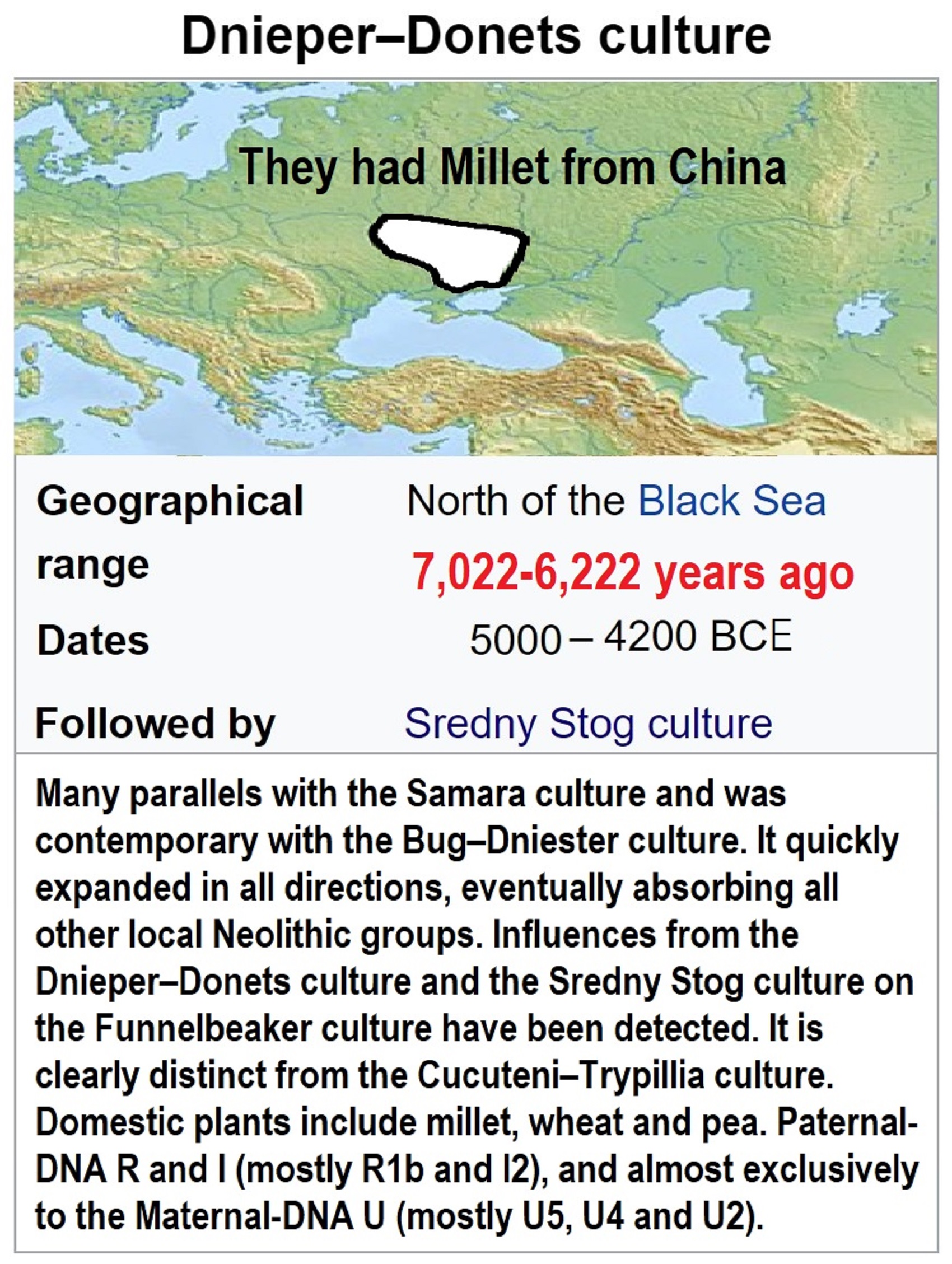
Many parallels with the Samara culture and was contemporary with the Bug–Dniester culture. It quickly expanded in all directions, eventually absorbing all other local Neolithic groups. Influences from the Dnieper–Donets culture and the Sredny Stog culture on the Funnelbeaker culture have been detected. It is clearly distinct from the Cucuteni–Trypillia culture. Domestic plants include millet, wheat, and pea. Paternal-DNA R and I (mostly R1b and I2), and almost exclusively to the Maternal-DNA U (mostly U5, U4, and U2). ref
“Maces of a different type than those of Dnieper-Donets have also been found. The wide adoption of such a status symbol attests to a change in the politics of power.” ref
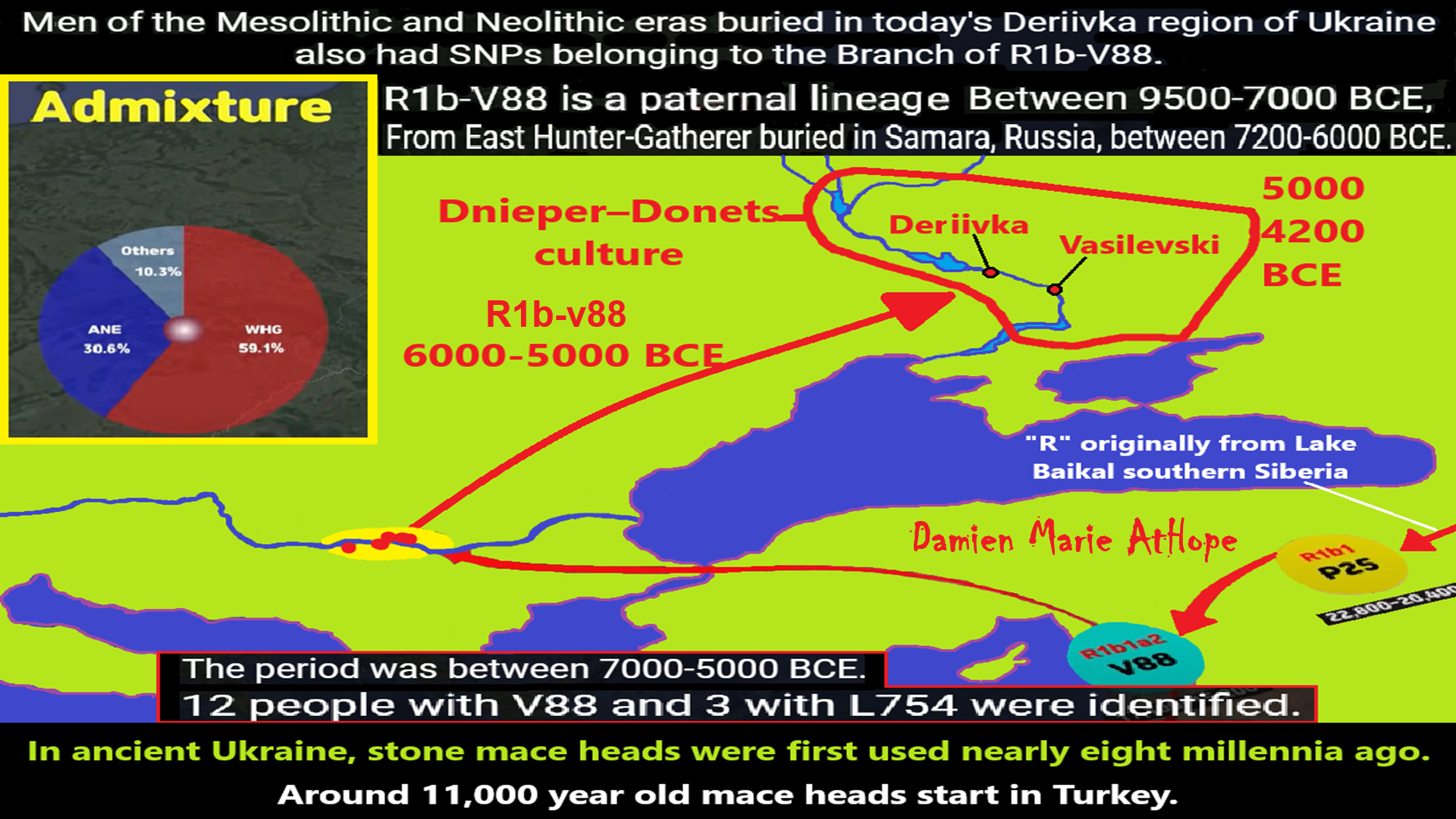
“Mace-heads were symbols of power and were held by people with status.” ref
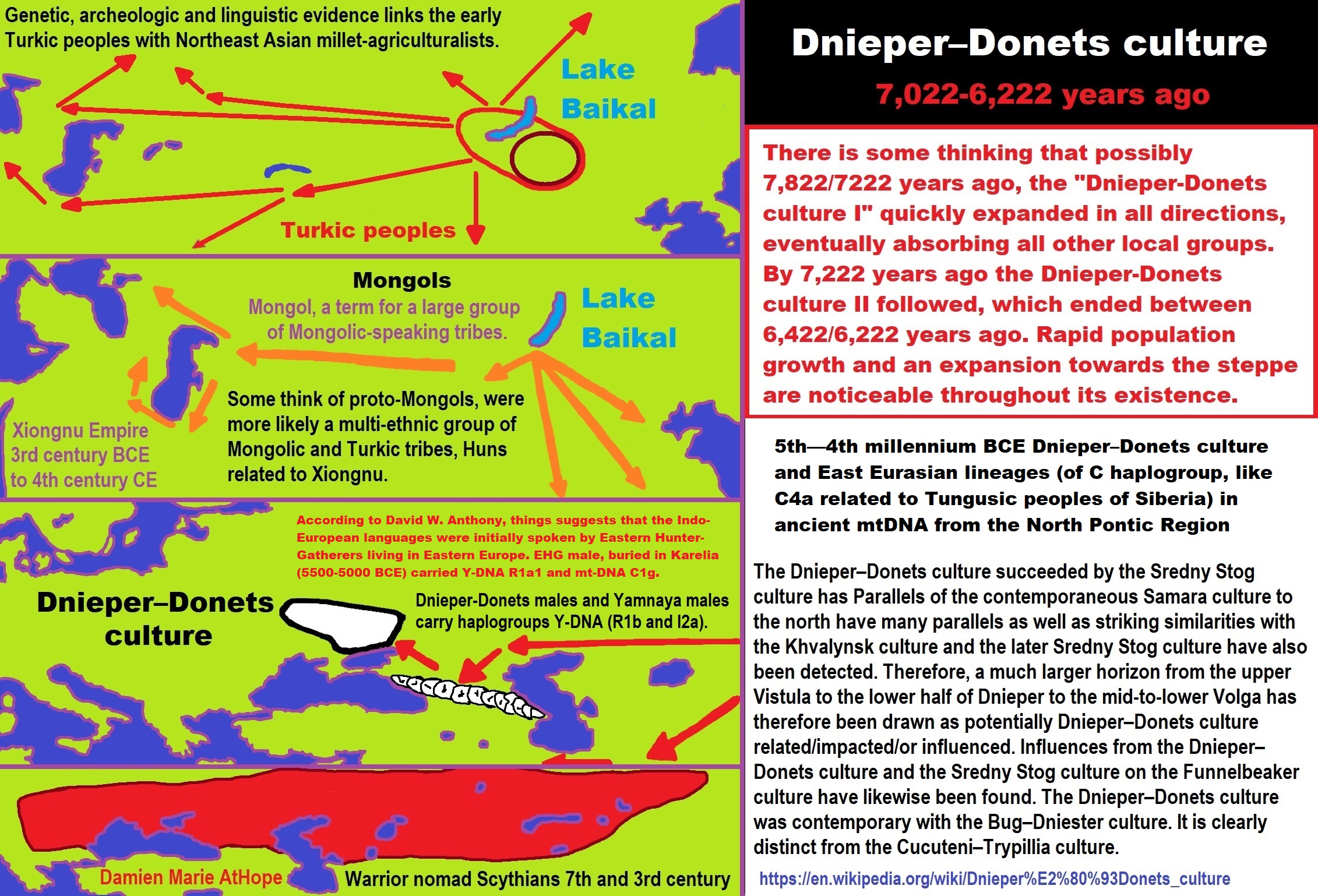
Dnieper–Donets culture
“The Dnieper–Donets culture (ca. 5th—4th millennium BC) was a Mesolithic and later Neolithic culture which flourished north of the Black Sea ca. 5000-4200 BC. It has many parallels with the Samara culture, and was succeeded by the Sredny Stog culture. David Anthony (2007) dated the beginning of the Dnieper-Donets culture I roughly between 5800/5200 BCE. It quickly expanded in all directions, eventually absorbing all other local Neolithic groups. By 5200 BCE the Dnieper-Donets culture II followed (ME: when Millet showed up?), which ended between 4400/4200 BCE.” ref
“The Dnieper–Donets culture was distributed in the areas north of the Black Sea. Throughout its existence, rapid population growth and an expansion towards the steppe is noticeable. There are parallels with the contemporaneous Samara culture to the north. Striking similarities with the Khvalynsk culture and the Sredny Stog culture have also been detected. A much larger horizon from the upper Vistula to the lower half of Dnieper to the mid-to-lower Volga has therefore been drawn.” ref
“Influences from the Dnieper–Donets culture and the Sredny Stog culture on the Funnelbeaker culture have been detected. An origin of the Funnelbeaker culture from the Dnieper–Donets culture has been suggested, but this is very controversial. The Dnieper–Donets culture was contemporary with the Bug–Dniester culture. It is clearly distinct from the Cucuteni–Trypillia culture. The Dnieper–Donets culture is known from more than 200 sites. Few settlements from the Dnieper–Donets culture are known, but a few semi-subterranean huts have been found. These huts were covered in bark.” ref
“The Dnieper–Donets culture was originally a hunter-gatherer culture. The economic evidence from the earliest stages is almost exclusively from hunting and fishing. Among the sources of food hunted and foraged by the Dnieper-Donets people were aurochs, elk, red deer, roe, wild boar, fox, wildcat, hare, bear, and onager. Their diet was primarily high protein, with meat, fish, and nuts being consumed. The Dnieper–Donets culture produced no female figurines.” ref
“From around 5200 BCE, the Dnieper-Donets people began keeping cattle, sheep, and goat. Other domestic animals kept included pig, horse, and dog. During the following centuries, domestic animals from the Dnieper further and further east towards the Volga–Ural steppes, where they appeared ca. 4700-4600 BCE. From about 4200 BCE, the Dnieper–Donets culture adopted agriculture. Domestic plants that have been recovered include millet, wheat, and pea. Evidence from skeletal remains suggests that plants were consumed. The presence of exotic goods in Dnieper-Donets graves indicates exchange relationships with the Caucasus.” ref
Burials in the Dnieper–Donets culture
“The Dnieper–Donets culture is well known for about thirty of its cemeteries that have been discovered. These contain around 800 individuals. It is evident that funerals were complex events that had several phases. Burials are mostly in large pits where the deceased were periodically placed and covered with ocher. The deceased was typically exposed for a time before their bones were collected and buried. On other occasions, the ceased was buried in the flesh without exposure. Deceased Dnieper-Donets people sometimes had only their skulls buried, at other times the entire bodies. The variants of Dnieper-Donets burial often appear in the same pits. Animal bones has also been found in the graves.” ref
“Certain Dnieper-Donets burials are accompanied with copper, crystal, or porphyry ornaments, shell beads, bird-stone tubes, polished stone maces, or ornamental plaques made of boar’s tusk. The items, along with the presence of animal bones and sophisticated burial methods, appear to have been a symbol of power. Certain deceased children were buried with such items, which indicates that wealth was inherited in Dnieper-Donets society. Very similar boar-tusk plaques and copper ornament have been found at contemporary graves of the Samara culture in the middle Volga area.” ref
Maces of a different type than those of Dnieper-Donets have also been found. The wide adoption of such a status symbol attests to a change in the politics of power.” ref
“The Dnieper–Donets culture continued using Mesolothic technology, but later phases see the appearance of polished stone axes, later flint, and the disappearance of microliths. These tools were sometimes deposited in graves. In later times the deceased in the Dnieper–Donets culture were sometimes buried individually. This shift has been suggested as evidence of a shift towards increasing individualism. Dnieper–Donets burials have been found near the settlement of Deriivka, which is associated with the Sredny Stog culture.” ref
Dnieper-Donets pottery
Dnieper-Donets pottery was initially pointed-based, but in later phases, flat-based wares emerge. Their pottery is completely different from those made by the nearby Cucuteni–Trypillia culture. The importance of pottery appears to have increased throughout the existence of the Dnieper–Donets culture, which implies a more sedentary lifestyle. The early use of typical point base pottery interrelates with other Mesolithic cultures that are peripheral to the expanse of the Neolithic farmer cultures.” ref
“The special shape of this pottery has been related to transport by logboat in wetland areas. Especially related are Swifterbant in the Netherlands, Ellerbek and Ertebølle in Northern Germany and Scandinavia, “Ceramic Mesolithic” pottery of Belgium and Northern France (including non-Linear pottery such as La Hoguette, Bliquy, Villeneuve-Saint-Germain), the Roucadour culture in Southwest France and the river and lake areas of Northern Poland and Russia.” ref
Dnieper-Donets Linguistics?
“In accordance with the Kurgan hypothesis, J. Mallory (1997) suggested that the Dnieper-Donets people were Pre–Indo-European-speakers who were absorbed by Proto-Indo-Europeans expanding westwards from steppe-lands further east (ME: when Millet showed up?). David Anthony (2007) believes that the Dnieper-Donets people almost certainly spoke a different language from the people of the Cucuteni–Trypillia culture.” ref
“The areas of the upper Dniester in which the Dnieper–Donets culture was situated have mostly Baltic river names. That and the close relationship between the Dnieper–Donets culture and contemporary cultures of northeast Europe have caused the Dnieper–Donets culture to be identified with the later Balts. The precise role of the culture and its language to the derivation of the Pontic-Caspian cultures, such as Sredny Stog and Yamnaya culture, is open to debate, but the display of recurrent traits points to longstanding mutual contacts or to underlying genetic relations.” ref
“The physical remains recovered from graves of the Dnieper–Donets culture have been classified as “Proto-Europoid“. They are predominantly characterized as late Cro-Magnons with large and more massive features than the gracile Mediterranean peoples of the Balkan Neolithic. Males averaged 172 Centimeters = 5.64304462 Feet in height, which is much taller than contemporary Neolithic populations. Its rugged physical traits are thought to have genetically influenced later Indo-European peoples. Physical anthropologists have pointed out similarities in the physical type of the Dnieper-Donets people with the Mesolithic peoples of Northern Europe. The peoples of the neighboring Sredny Stog culture, which eventually succeeded the Dnieper–Donets culture, were of a more gracile appearance.” ref
Dnieper–Donets culture Genetics
Further information: Deriivka § Genetics
See also: Zvejnieki burial ground § Archaeogenetics, Iron Gates Mesolithic § Genetics, Motala § Archaeogenetics, Khvalynsk § Archaeogenetics, Samara culture § Genetics, Sredny Stog culture § Genetics, Khvalynsk culture § Genetics, Yamnaya culture § Archaeogenetics, Scandinavian Hunter-Gatherer, Pitted Ware culture § Genetics, Kunda culture § Genetics, Narva culture § Genetics, and Pit–Comb Ware culture § Genetics
“Mathieson et al. (2018) analyzed 32 individuals from three Eneolithic cemeteries at Deriivka, Vilnyanka and Vovnigi, which Anthony (2019a) ascribed to the Dnieper–Donets culture. These individuals belonged exclusively to the paternal haplogroups R and I (mostly R1b and I2), and almost exclusively to the maternal haplogroup U (mostly U5, U4, and U2). This suggests that the Dnieper-Donets people were “distinct, locally derived population” of mostly of Eastern Hunter-Gatherer (EHG) descent, with Western Hunter-Gatherer (WHG) admixture. The WHG admixture appears to have increased in the transition from the Mesolithic to the Neolithic.” ref
“Unlike the Yamnaya culture, whose genetic cluster is known as Western Steppe Herder (WSH), in the Dnieper–Donets culture no Caucasian Hunter-Gatherer (CHG) or Early European Farmer (EEF) ancestry has been detected. At the Vilnyanka cemetery, all the males belong to the paternal haplogroup I, which is common among WHGs. David W. Anthony suggests that this influx of WHG ancestry might be the result of EEFs pushing WHGs out of their territories to the east, where WHG males might have mated with EHG females.” ref
“Dnieper-Donets males and Yamnaya males carry the same paternal haplogroups (R1b and I2a), suggesting that the CHG and EEF admixture among the Yamnaya came through EHG and WHG males mixing with EEF and CHG females. According to Anthony, this suggests that the Indo-European languages were initially spoken by EHGs living in Eastern Europe.” ref
Successors to the Dnieper–Donets culture
“The Dnieper–Donets culture was succeeded by the Sredny Stog culture, its eastern neighbor, with whom it co-existed for a time before being finally absorbed. The Dnieper–Donets culture and the Sredny Stog culture were in turn succeeded by the Yamnaya culture. The Mikhaylovka culture, the Novodanilovka group, and the Kemi Oba culture displays evidence of continuity from the Dnieper–Donets culture.” ref
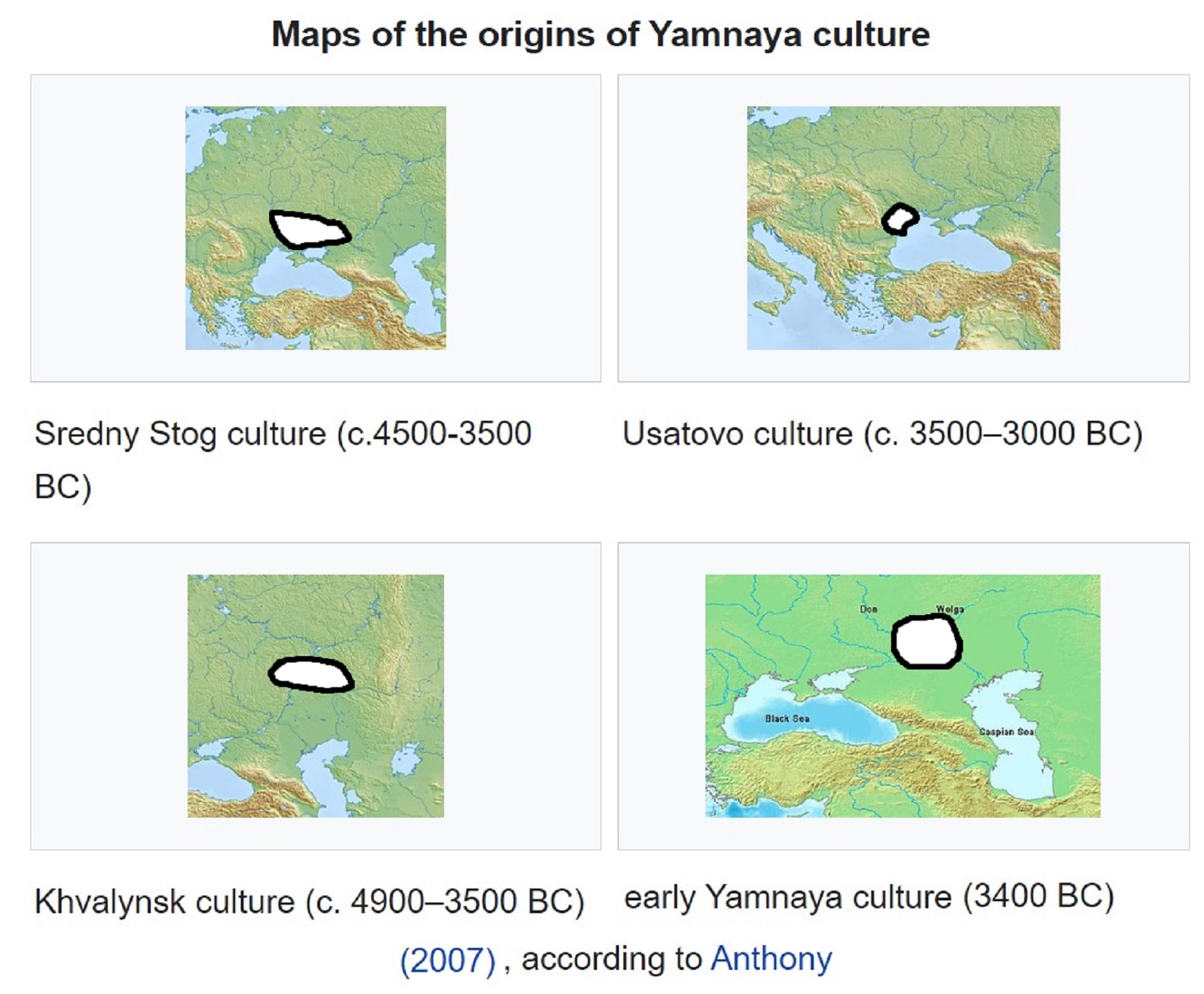
Khvalynsk culture
“The Khvalynsk culture was a Middle Copper Age (for Eastern Europe named “Eneolithic“) culture (c. 4900 – 3500 BCE or 6,922-5,522 years ago) of the middle Volga region, discovered at Khvalynsk on the Volga in Saratov Oblast, Russia. It was preceded by the Early Eneolithic Samara culture, from which it came, and succeeded by the Late Eneolithic, Early Yamna culture, into which it developed. The Khvalynsk culture is associated with speakers of an early stage of the Proto-Indo-European language.” ref
“The Khvalynsk culture extended from Saratov in the north to the North Caucasus in the south, from the Sea of Azov in the west to the Ural River in the east. A good sprinkling of calibrated C-14 readings obtained from material in the graves of the type site date the culture certainly to the approximate window, 5000–4500 BCE. This material is from Khvalynsk I, or Early Khvalynsk. Khvalynsk II, or Late Khvalynsk, is Late Eneolithic. Asko Parpola regards Khvalynsk culture to be c. 5000 to 3800 BCE or 7,022-5,822 years ago.” ref
“Nina Morgunova regards Khvalynsk I as Early Eneolithic, contemporary with the second stage of Samara culture called Ivanovka and Toksky stage, which pottery was influenced by Khvalynsk culture, as a calibrated period of this second stage of Samara culture is 4850–3640 BCE. Marija Gimbutas, however, believed Samara was earlier and placed Khvalynsk I in the Developed Eneolithic. Not enough Samara culture dates and sites exist to settle the question. After c. 4500 BCE, Khvalynsk culture united the lower and middle Volga sites keeping domesticated sheep, goats, cattle, and maybe horses.” ref
“The Khvalynsk type site is a cemetery, 30 m by 26 m, containing about 158 skeletons, mainly in single graves, but some two to five together. They were buried on their backs with knees contracted. Twelve of the graves were covered with stone cairns. Sacrificial areas were found similar to those at Samara, containing horse, cattle, and sheep remains.” ref
“An individual grave was found in 1929 at Krivoluchie with grave goods and the remains placed on ochre, face-up, knees contracted. A 67 m high earthen kurgan at Nalchik, approximately thirty meters in diameter, contained 121 individual graves of remains placed face up, knees contracted, on ochre with a covering of stone.” ref
“Khvalinsk evidences the further development of the kurgan. It began in the Samara with individual graves or small groups sometimes under stone. In the Khvalinsk culture, one finds group graves, which can only be communal on some basis, whether familial or local or both is not clear. With the advent of better methods of recovering ancient DNA, perhaps someday it will be.” ref
“Although there are disparities in the wealth of the grave goods, there seems to be no special marker for the chief. This deficit does not exclude the possibility of a chief. In the later kurgans, one finds that the kurgan is exclusively reserved for a chief and his retinue, with ordinary people excluded.” ref
This development suggests a growing disparity of wealth, which in turn implies a growth in the wealth of the whole community and an increase in population. The explosion of the kurgan culture out of its western steppe homeland must be associated with an expansion of population. The causes of this success and expansion remain obscure.” ref
“We do know that metal was available both in the Caucasus and in the southern Urals. The Khvalynsk graves included metal rings and spiral metal rings. However, there is no indication of any use beyond ornamental. The quality of stone weapons and implements reaches a high point. The Krivoluchie grave, which Gimbutas viewed as that of a chief, contained a long flint dagger and tanged arrowheads, all carefully retouched on both faces. In addition, there is a porphyry axe-head with lugs and a haft hole. These artifacts are of types that not too long after appeared in metal.” ref
“There is also plenty of evidence of personal jewelry: beads of shell, stone and animal teeth, bracelets of stone or bone, pendants of boar tusk. The animals whose teeth came to decorate the putative Indo-Europeans are boar, bear, wolf, deer, and others. Some of these teeth must have been difficult to acquire, a labor perhaps that led to a value being placed upon them. Whether they were money is not known.” ref
“The hard goods leave no record of any great richness. There is some evidence that wealth may have consisted of perishable goods. In fact, in many similar cultures of later times, wealth was reckoned in livestock. A recent study of the surface of the pottery (also of many cultures), which recorded contact with perishable material while the clay was wet, indicates contact with cords and embroidered woven cloth, which the investigators suggest were used to decorate the pot.” ref
“Examination of physical remains of the Kvalynsk people has determined that they were Europoid. A similar physical type prevails among the Sredny Stog culture and the Yamnaya culture, whose peoples were tall and powerfully built. Khvalynsk people were however not as powerfully built as the Sredny Stog and Yamnaya. The people of the Dnieper-Donets culture further west on the other hand, were even more powerfully built than the Yamnaya.” ref
“Recent genetic studies have shown that males of the Khvalynsk culture carried primarily the paternal haplogroup R1b, although a few samples of R1a, I2a2, Q1a, and J have been detected. They belonged to the Western Steppe Herder (WSH) cluster, which is a mixture of Eastern Hunter-Gatherer (EHG) and Caucasian Hunter-Gatherer (CHG) ancestry. This admixture appears to have happened on the eastern Pontic–Caspian steppe starting around 5,000 BCE.” ref
“A male from the contemporary Sredny Stog culture was found to have 80% WSH ancestry of a similar type to the Khvalynsk people, and 20% Early European Farmer (EEF) ancestry. Among the later Yamnaya culture, males carry exclusively R1b and I2. A similar pattern is observable among males of the earlier Dnieper-Donets culture, who carried only R and I and whose ancestry was exclusively EHG with Western Hunter-Gatherer (WHG) admixture.” ref
“The presence of EEF and CHG mtDNA and exclusively EHG and WHG Y-DNA among the Yamnaya and related WSHs suggest that EEF and CHG admixture among them was the result of mixing between EHG and WHG males, and EEF and CHG females. This suggests that the leading clans among the Yamnaya were of EHG paternal origin. According to David W. Anthony, this implies that the Indo-European languages were the result of “a dominant language spoken by EHGs that absorbed Caucasus-like elements in phonology, morphology, and lexicon”.(spoken by CHGs).” ref
Sredny Stog culture
“The Sredny Stog culture (Ukrainian: Середньостогівська культура) is a pre-Kurgan archaeological culture from the 5th millennium BCE. It is named after the Russian term for the Dnieper river islet of today’s Seredny Stih, Ukraine, where it was first located. The Sredny Stog culture was situated across the Dnieper river on both its shores, with sporadic settlements to the west and east. The Sredny Stog culture seems to have had contact with the agricultural Cucuteni-Trypillian culture in the west and was a contemporary of the Khvalynsk culture, to the north-east.” ref
“The Sredny Stog people lived rather mobile lives. This was seen in their temporary settlements, particularly their dwellings, which were simple rectilinear structures. The expert Dmytro Telegin has divided the chronology of Sredny Stog into two distinct phases. Phase II (ca. 4000–3500 BCE) used corded ware pottery which may have originated there, and stone battle-axes of the type later associated with expanding Indo-European cultures to the West. Most notably, it has perhaps the earliest evidence of horse domestication (in phase II), with finds suggestive of cheek-pieces (psalia). However, there is no conclusive proof that those horses were used for riding since they were mainly employed for gathering food.” ref
“In its three largest cemeteries, Alexandria (39 individuals), Igren (17), and Dereivka (14), evidence of inhumation in flat graves (ground level pits) has been found. This parallels the practice of the Cucuteni-Trypillia culture, and is in contrast with the later Yamna culture, which practiced tumuli burials. The culture ended at around 3500 BCE, when the Yamna culture expanded westward replacing Sredny Stog, and coming into direct contact with the Cucuteni-Trypillian culture in the western Ukraine.” ref
“In Sredny Stog culture, the deceased were laid to rest on their backs with the legs flexed. The use of ochre in the burial was practiced, as with the kurgan cultures. For this and other reasons, Yuri Rassamakin suggests that the Sredny Stog culture should be considered as an areal term, with at least four distinct cultural elements co-existing inside the same geographical area.” ref
“In the context of the modified Kurgan hypothesis of Marija Gimbutas, this pre-kurgan archaeological culture could represent the Urheimat (homeland) of the Proto-Indo-European language. Examination of the physical remains of the Sredny Stog people has determined that they were Europoid. A similar physical type prevails among the Yamnaya, who were tall and powerfully built. People of the neighboring Khvalynsk culture were less powerfully built. People of the preceding Dnieper-Donets culture were even more powerfully built than the Sredny Stog and Yamnaya.” ref
“Mathieson et al. (2018) included a genetic analysis of a male buried at Aleksandriya, Kupryansk (Ukraine) ca. 4000 BCE., ascribed to the Sredny Stog culture. He was found to be carrying the paternal haplogroup R1a1a1, and the maternal haplogroup H2a1a. He carried about 80% Western Steppe Herder (WSH) ancestry and about 20% Early European Farmer (EEF) ancestry. This Sredny Stog male was thought to be the first steppe individual found to have been carrying EEF ancestry. As a carrier of the 13910 allele, he was supposed to be the earliest individual ever examined who has had a genetic adaptation to lactase persistence.” ref
“However, the recent publication by David Reich Lab, October 2021, redated the remains of this Aleksandriya individual to 2134-1950 cal BCE, which could actually belong to Srubnaya culture period, as Haplotree Information Project considers this sample I6561 is from around 3622 years ago (c. 1700 BCE), and belongs to Y-DNA R1a-F2597*, corresponding to R1a-Y3. The WSH genetic cluster was a result of mixing between Eastern Hunter-Gatherers (EHGs) from Eastern Europe and Caucasian Hunter-Gatherers (CHGs). This mixing appears to have happened on the eastern Pontic–Caspian steppe starting around 5,000 BCE or 7,022 years ago.” ref
“The WSH ancestry found in the Sredny Stog culture is similar to that of the Khvalynsk culture, among whom there was no EEF admixture. Males of the Khvalynsk culture carried primarily the paternal haplogroup R1b, although a few samples of R1a, I2a2, Q1a, and J have been detected. Succeeding Yamnaya males, however, have been found to have carried only R1b and I2. This is similar to the males of the Dnieper-Donets culture, who carried R and I only and were exclusively EHGs with Western Hunter-Gatherer (WHG) admixture. The results suggest that the Yamnaya emerged through mixing between EHG and WHG males, and EEF and CHG females. This implies that the leading clans of the Yamnaya were of EHG paternal origin. On this basis, David W. Anthony argues that the Indo-European languages were originally spoken by EHGs.” ref
Usatovo culture
“The Usatovo culture is a late variant of the Cucuteni–Trypillia culture which flourished northwest of the Black Sea from 3500-3000 BCE. Within the Kurgan hypothesis, the Usatovo culture represents the domination of native Cucuteni–Trypillia agriculturalists by Indo-European peoples from the steppe. According to Anthony, the roots of the pre-Germanic languages lay in the Usatovo culture.” ref
The Usatovo culture appears to be a mixture of Neolithic elements of Southeast Europe with intrusive cultures from the Pontic steppe. From native Neolithic elements it shares flat graves, figurines, and painted ceramics, while it shares tumulus burials, horses, and shell-tempered coarse wares with steppe cultures. It also displays metallic items such as arsenical bronze and silver, which suggests contacts with the North Caucasus.” ref

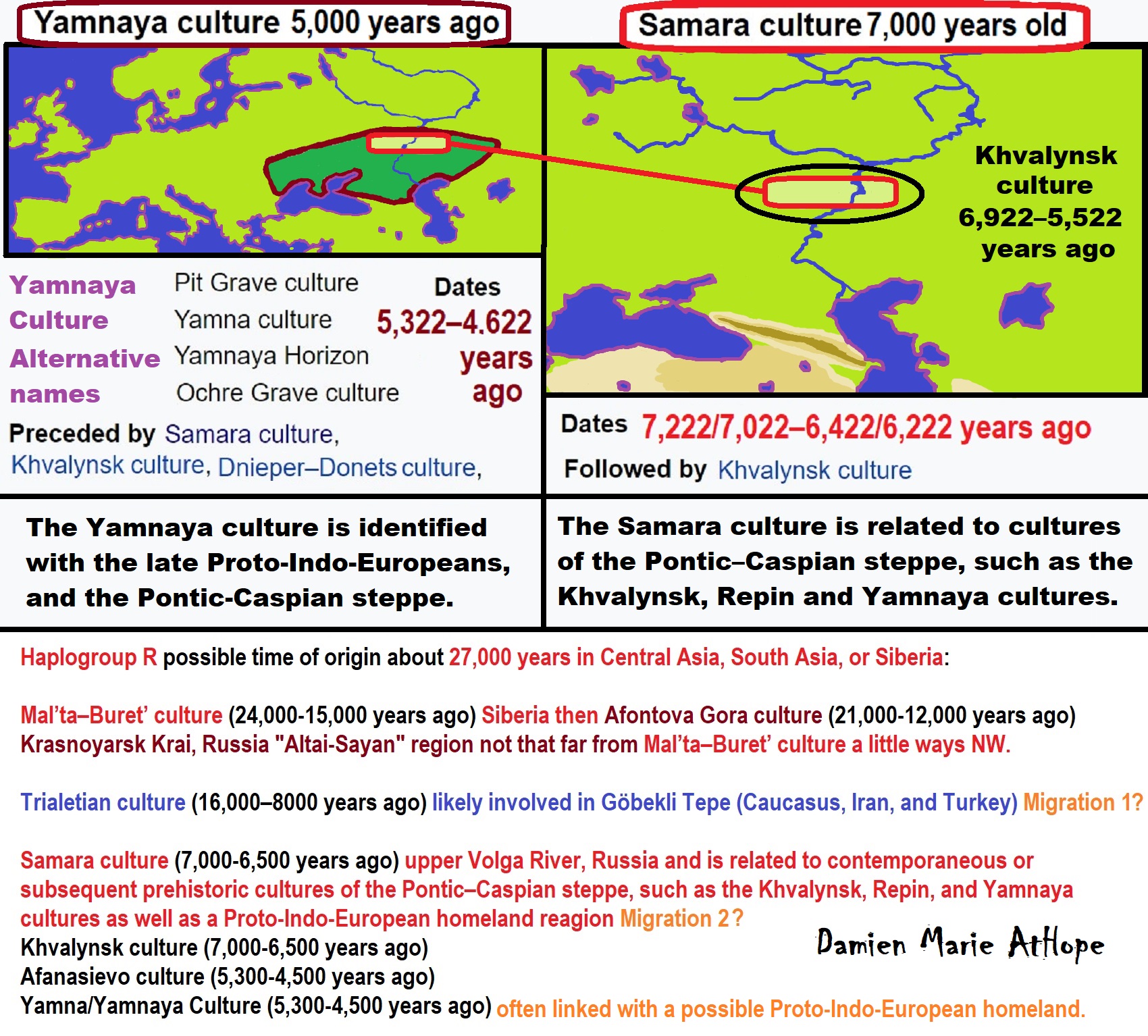

Yamnaya culture
“The Yamnaya culture (Russian: Ямная культура, romanized: Yamnaya kul’tura, Ukrainian: Ямна культура, romanized: Yamna kul’tura lit. ‘culture of pits’), also known as the Yamnaya Horizon, Yamna culture, Pit Grave culture or Ochre Grave culture, was a late Copper Age to early Bronze Age archaeological culture of the region between the Southern Bug, Dniester, and Ural rivers (the Pontic steppe), dating to 3300–2600 BCE. Its name derives from its characteristic burial tradition: Я́мная (romanization: yamnaya) is a Russian adjective that means ‘related to pits (yama)’, and these people used to bury their dead in tumuli (kurgans) containing simple pit chambers.” ref
“The people of the Yamnaya culture were likely the result of a genetic admixture between the descendants of Eastern European Hunter-Gatherers (EHG) and people related to hunter-gatherers from the Caucasus (CHG), an ancestral component which is often named “Steppe ancestry”, with an additional admixture of up to 18% from Early European Farmers. Their material culture was very similar to the Afanasevo culture, and the populations of both cultures are genetically indistinguishable. They lived primarily as nomads, with a chiefdom system and wheeled carts and wagons that allowed them to manage large herds.” ref
“They are also closely connected to Final Neolithic cultures, which later spread throughout Europe and Central Asia, especially the Corded Ware people and the Bell Beaker culture, as well as the peoples of the Sintashta, Andronovo, and Srubnaya cultures. Back migration from Corded Ware also contributed to Sintashta and Andronovo. In these groups, several aspects of the Yamnaya culture are present. Genetic studies have also indicated that these populations derived large parts of their ancestry from the steppes. The Yamnaya culture is identified with the late Proto-Indo-Europeans, and the Pontic-Caspian steppe is the strongest candidate for the Urheimat (original homeland) of the Proto-Indo-European language.” ref
“According to Pavel Dolukhanov (1996) the emergence of the Pit-Grave culture represents a social development of various local Bronze Age cultures, representing “an expression of social stratification and the emergence of chiefdom-type nomadic social structures”, which in turn intensified inter-group contacts between essentially heterogeneous social groups.” ref
“According to Mallory (1999), “The origin of the Yamnaya culture is still a topic of debate,” with proposals for its origins pointing to both Khvalynsk and Sredny Stog. The Khvalynsk culture (4700–3800 BCE) (middle Volga) and the Don-based Repin culture (ca.3950–3300 BCE) in the eastern Pontic-Caspian steppe, and the closely related Sredny Stog culture (c. 4500–3500 BCE) in the western Pontic-Caspian steppe, preceded the Yamnaya culture (3300–2500 BCE).” ref
“According to Anthony (2007), the Yamnaya culture (3300–2600 BCE) originated in the Don–Volga area at ca. 3400 BCE, preceded by the middle Volga-based Khvalynsk culture and the Don-based Repin culture (c. 3950–3300 BCE), arguing that late pottery from these two cultures can barely be distinguished from early Yamnaya pottery. Earlier continuity from eneolithic but largely hunter-gatherer Samara culture and influences from the more agricultural Dnieper–Donets II are apparent.” ref
“Alternatively, Parpola (2015) relates both the Corded ware culture and the Yamnaya culture to the late Tripolye culture. He hypothesizes that “the Tripolye culture was taken over by PIE speakers by c. 4000 BCE,” and that in its final phase the Tripolye culture expanded to the steppes, morphing into various regional cultures which fused with the late Sredny Stog pastoralist cultures, which, he suggests, gave rise to the Yamnaya culture.” ref
“According to Anthony (2007), the early Yamnaya horizon spread quickly across the Pontic–Caspian steppes between c. 3400 and 3200 BCE: The spread of the Yamnaya horizon was the material expression of the spread of late Proto-Indo-European across the Pontic–Caspian steppes.” ref
“[…] The Yamnaya horizon is the visible archaeological expression of a social adjustment to high mobility – the invention of the political infrastructure to manage larger herds from mobile homes based in the steppes. The Yamnaya (Pit-grave) culture was succeeded in its western range by the Catacomb culture (2800–2200 BCE); in the east, by the Poltavka culture (2700–2100 BCE) at the middle Volga. These two cultures were followed by the Srubnaya culture (18th–12th century BCE).” ref

ref, ref, ref, ref, ref, ref, ref, ref, ref, ref, ref, ref, ref, ref
1. Kebaran culture 23,022-16,522 Years Ago, 2. Kortik Tepe 12,422-11,722 Years Ago, 3. Jerf el-Ahmar 11,222 -10,722 Years Ago, 4. Gobekli Tepe 11,152-9,392 Years Ago, 5. Tell Al-‘abrUbaid and Uruk Periods, 6. Nevali Cori 10,422 -10,122 Years Ago, 7. Catal Hoyuk 9,522-7,722 Years Ago


Kostyonki (or Kostenki) (Archaeological Complex)
Tianyuan man (Tianyuan Cave 42,000 and 39,000 years old)
Gravettian Culture (known for Venus figurines)
Pavlovian culture (Art or religious finds are bone carvings and figurines of humans and animals)
Dolní Věstonice (archaeological site)
Ancient North Eurasian (ANE)
Mal’ta–Buret’ Culture (Mal’ta Venus figurines)
Afontova Gora (Siberian Complex of Archaeological sites)
Eastern Hunter-Gatherer (EHG)
Western Hunter-Gatherers (WHG)
Yamnaya Culture (Identified with the Late Proto-Indo-Europeans)
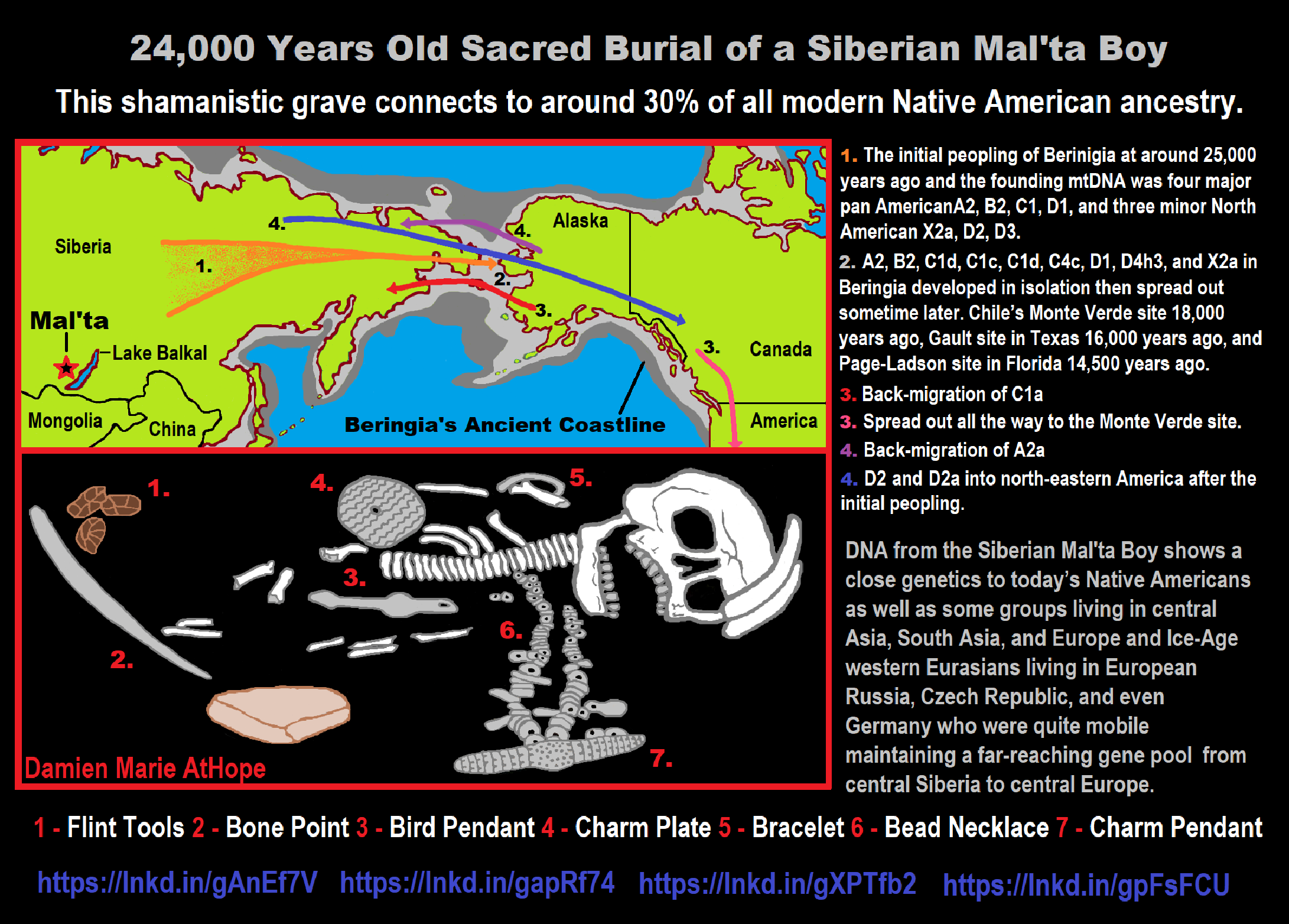
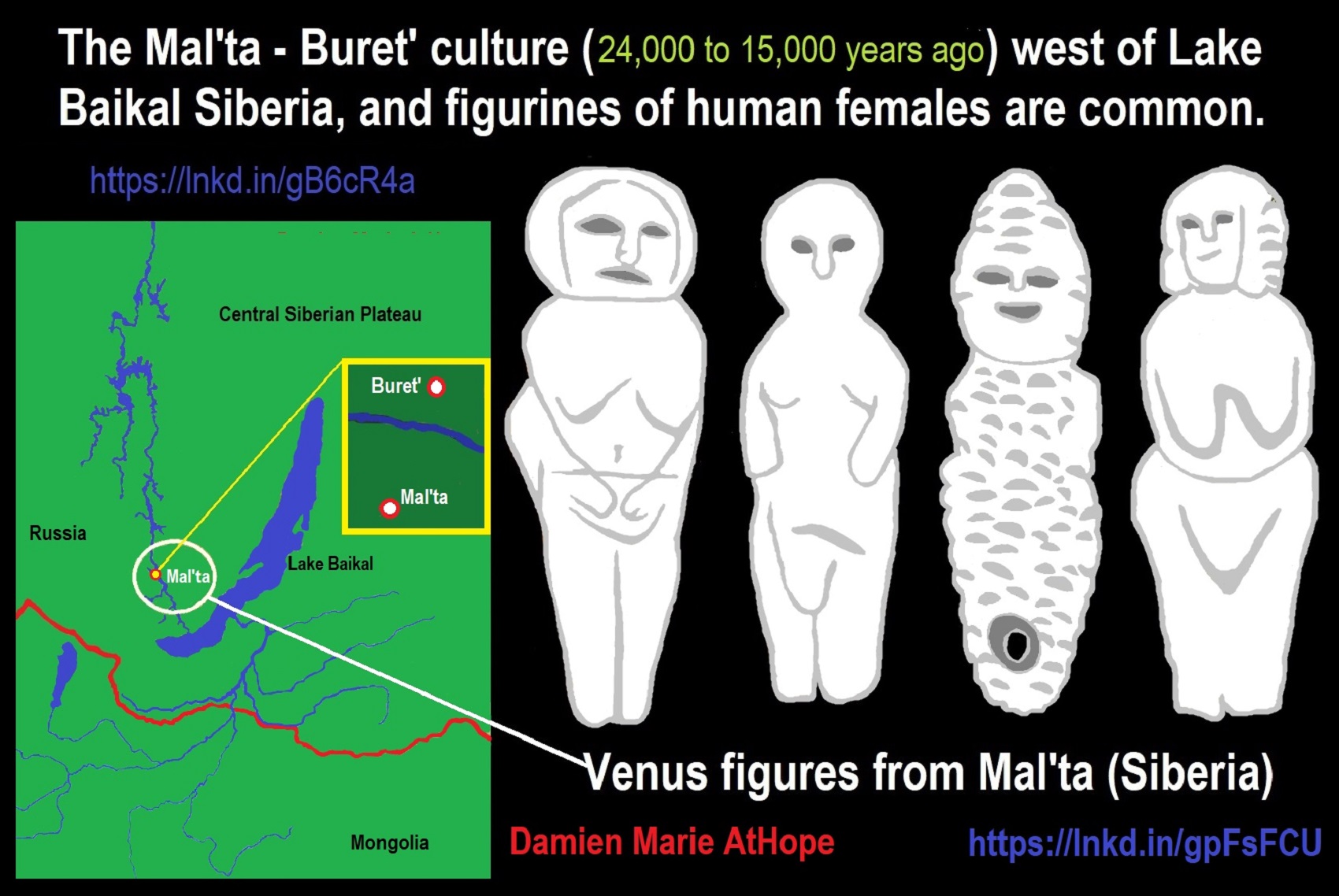
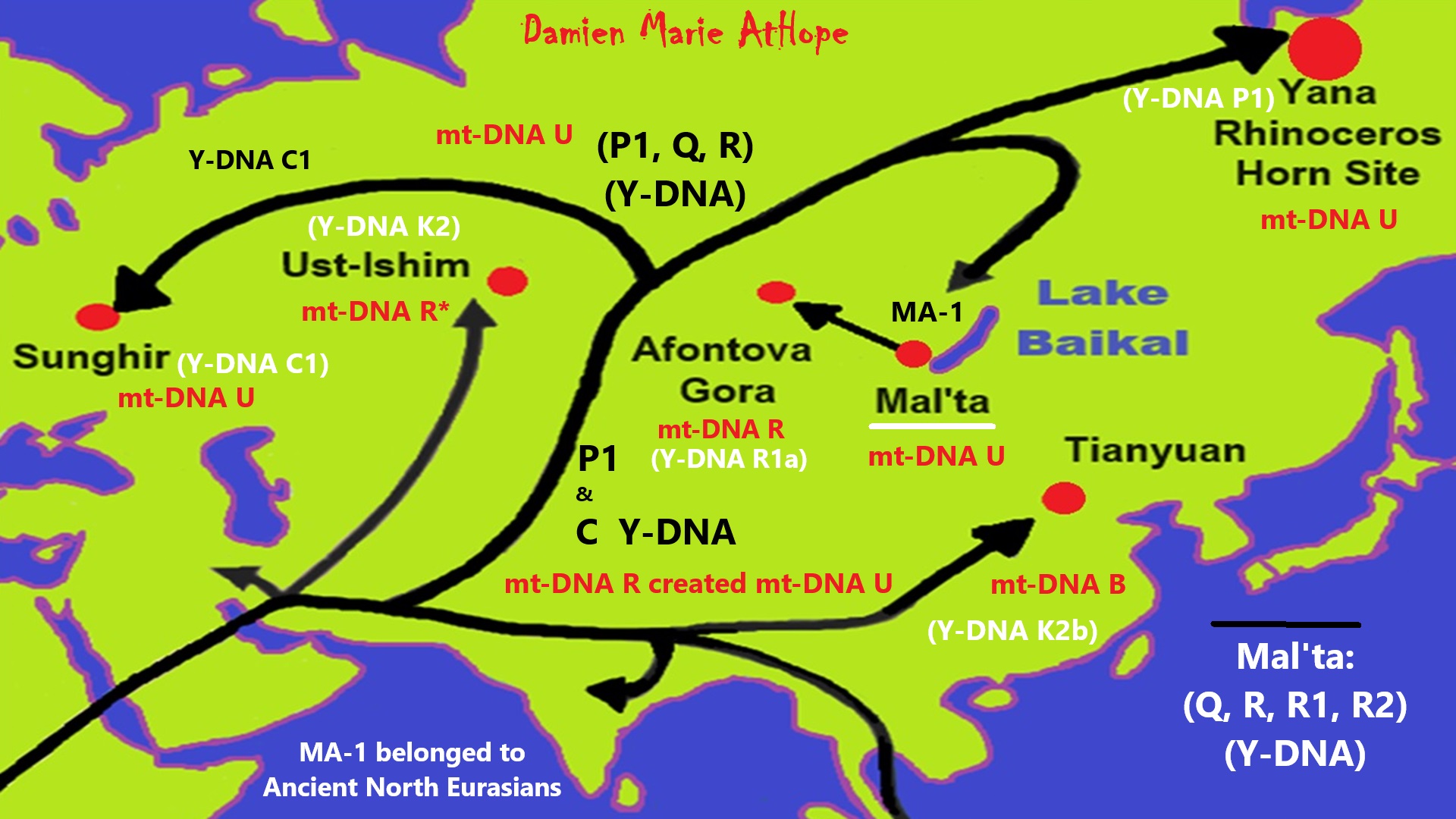
ref, ref, ref, ref, ref, ref, ref, ref, ref, ref, ref, ref, ref
“The genetic prehistory of humans in Asia, based on research using sequence data from humans who lived in Asia as early as 45,000 years ago. Genetic studies comparing present-day Australasians and Asians show that they likely derived from a single dispersal out of Africa, rapidly differentiating into three main lineages: one that persists partially in South Asia, one that is primarily found today in Australasia, and one that is widely represented across Siberia, East Asia, and Southeast Asia. Studies of ancient DNA from human remains in Asia dating from as far back as 45,000 years have greatly increased our understanding of the population dynamics leading to the current Asian populations.” ref
Ust’-Ishim man: Y-DNA haplogroupK2 and mt-DNA haplogroupR*
Tianyuan man: Y-DNA haplogroup K2b and mt-DNA haplogroup B
Yana Rhinoceros Horn Site: Y-DNA haplogroup P1 and mt-DNA haplogroup U
Sungir/Gravettian burials: Y-DNA haplogroup C1 and mt-DNA haplogroups U8c & U2
Ancient North Eurasians: Y-chromosome haplogroups P and its subclades R and Q and mt-DNA haplogroups U and R
Mal’ta–Buret’ culture: basalY-DNA haplogroup R* and mt-DNA haplogroup U
“MA-1 is the only known example of basal Y-DNA R* (R-M207*) – that is, the only member of haplogroup R* that did not belong to haplogroups R1, R2 or secondary subclades of these. The mitochondrial DNA of MA-1 belonged to an unresolved subclade of haplogroup U.” ref
“ANE ancestry has spread throughout Eurasia and the Americas in various migrations since the Upper Paleolithic, and more than half of the world’s population today derives between 5 and 42% of their genomes from the Ancient North Eurasians. Significant ANE ancestry can be found in Native Americans, as well as in Europe, South Asia, Central Asia, and Siberia. It has been suggested that their mythology may have featured narratives shared by both Indo-European and some Native American cultures, such as the existence of a metaphysical world tree and a fable in which a dog guards the path to the afterlife.” ref
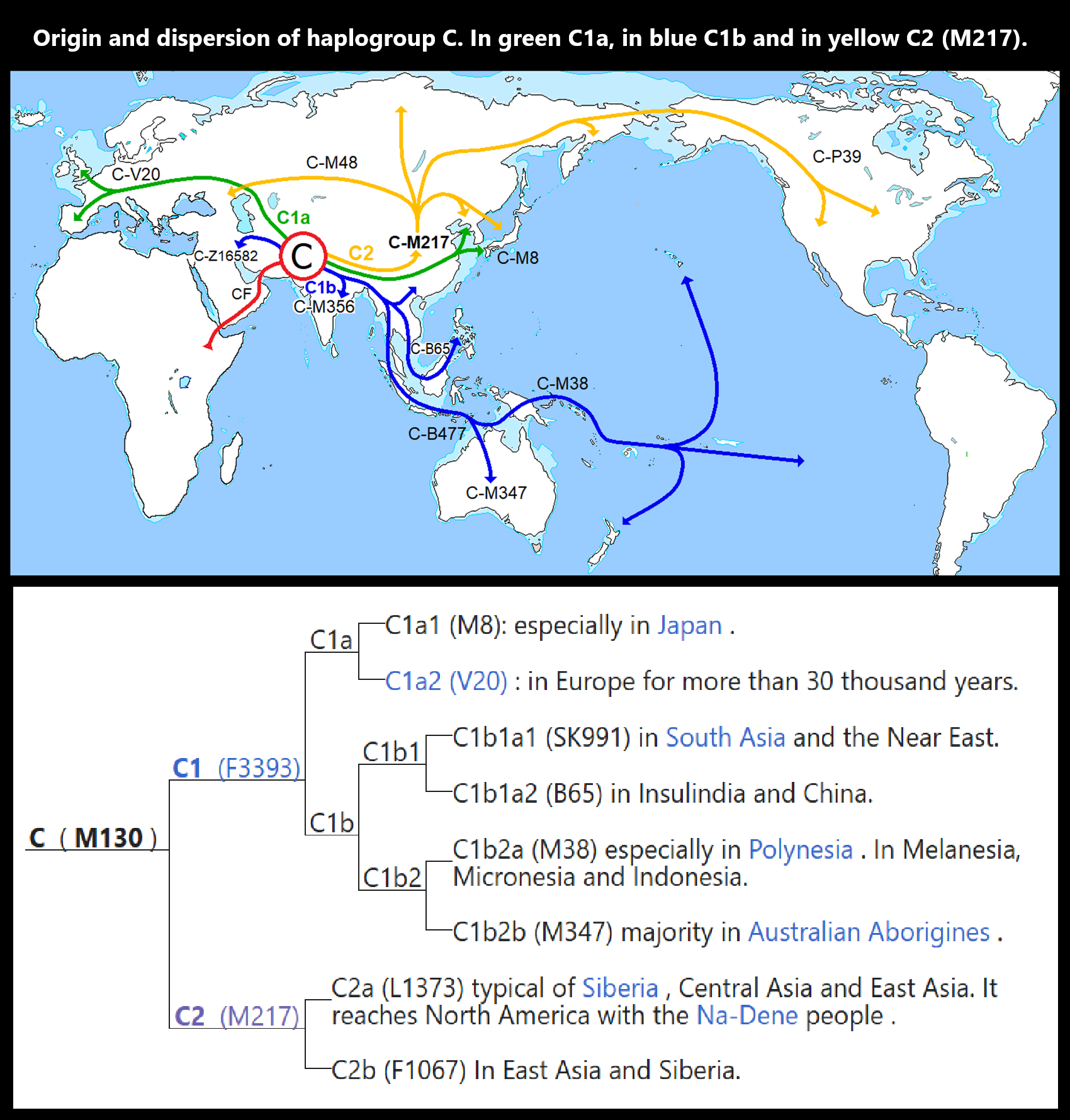
“Origin and dispersion of haplogroup C Y-DNA. In green C1a (CTS11043), in blue C1b (F1370), and in yellow C2 (M217), formerly called C3. Siberian migrations 6,000 to 8,000 years ago gave rise to the Na–Dene peoples and brought haplogroup C to the New World, especially northwestern North America.” ref, ref
Y-DNA Haplogroup C1
“Haplogroup C1 (Y-DNA) also known as C-F3393, is a major Y-chromosome haplogroup. It is one of two primary branches of the broader Haplogroup C, the other being C2 (also known as C-M217; the former Haplogroup C3). The basal paragroup, C1* (C-F3393*), has not been found in samples from living or dead males. Of the two primary branches, C1b is common in parts of Oceania and Asia. The other primary branch, C1a, is extremely rare worldwide and has been found mainly amongst individuals native to Japan or Europe and among Upper Paleolithic Europeans, with single cases known from Nepal and Jeju Island through academic studies, and from an ethnic Armenian, an ethnic Kabyle, and an ethnic Han from Linghai through commercial testing.” ref
C1a (CTS11043)
“Basal C1a* (CTS11043) was found in an Upper Paleolithic Europeans (Aurignacians), GoyetQ116-1, and Pestera Muerii2. Among the most interesting findings of recent genetic research is that living members of C1a are also rare and distributed geographically in an extremely bifurcated pattern. C1a1 or C-M8 is now found regularly only with low frequency (approximately 5% to 6% of all samples) in Japan. It also has been found sporadically among thousands of males from Korea and hundreds of thousands of males from China who have had their Y-DNA tested.” ref
“C1a2 (known previously as C6) or C-V20 now appears to be found only among European, Algerian, Turks, Armenian, and Nepali males. C1a2 was present in the remains in Europe by the Upper Paleolithic, including the Vestonice cluster (Vestonice16) (i.e. remains found in the modern Czech Republic). It was also found in the 7,000-year-old (Mesolithic) remains of a WHG (Western Hunter-Gatherers) known as “La Braña 1”, found in La Braña-Arintero, León, Spain. La Braña 1 was part of the so-called Villabruna cluster, named after a site in northeast Italy. By the time of the Villabruna cluster, however, the dominant Y-DNA haplogroup in Western Europe was I2. (And the balance was again altered by the mass migrations into Europe of Neolithic Middle Eastern farmer and Bronze Age Indo-Europeans.) further: a male from the Great Hungarian Plain, approximately contemporaneous to the La Braña man also carried it, as did the 30,000-year-old remains of a Vestonice Cluster hunter-gatherer from the Pavlov-Dolní Věstonice area (Czech Republic), as well as a 34,000 years old Russian hunter gatherers from Sungir (Sunghir 1/2/3/4).” ref
C1b (F1370)
“Basal C1b* (F1370) has been identified in the remains of an individual known as Kostenki-14 who died circa 37,000 years BP (Upper Paleolithic) that was found at the Kostyonki archaeological site in western Russia. It has also been found in a small number of males from the Middle East. C1b2 (C-B477) is the common ancestor of C-M38 and C-M347. It is likely that more than 40% of Indigenous Australian males, before contact with European settlers, belonged to the subclade C1b2b (C-M347) known previously as C4. Within C-M347 at least two subclades have been identified: C1b2b1 (DYS390.1del,M210) and an as yet unresolved offshoot of the C1b2b1 paragroup (i.e. M347xDYS390.1del, M210). C1b2a (M38), previously known as C2, is virtually restricted to Island South East Asia, New Guinea, Melanesia, and Polynesia. Of its subclades, C1b2a1a (P33) is found at a high frequency among Polynesians.” ref
“Some members of populations in parts of Asia have been found to carry Y-DNA that belongs to haplogroup C1b1-AM00694/K281. C1b1b-B68 has been found in a Dusun in Brunei. C1b1a-B66/Z16458 has three primary subclades: C1b1a1-M356, C1b1a2-B65, and C1b1a3-Z16582. C1b1a3-Z16582 has been found in some individuals from Saudi Arabia and Iraq. C1b1a2-B65 comprises two subclades, C1b1a2a-B67 and C1b1a2b-F725. C1b1a2a-B67 has been found in two Lebbo’ people from Borneo, an individual from Hadakewa on Lembata, and four individuals from Flores (one from Rampasasa and three from Cibal). The TMRCA of C-B67 has been estimated to be 17,007 (95% CI 19,608 <-> 14,627) years before present, with the Lebbo’ individuals from Borneo belonging to a branch that is basal to the rest. C1b1a2b-F725 has been found in Han Chinese in China (Guangdong, Hunan, and Shaanxi), Dai people in Yunnan, Murut people in Brunei, Malay people in Singapore, and Aeta people in the Philippines. C1b1a1-M356 has been found with overall low frequency in South Asia, Central Asia, and Southwest Asia.” ref

ref, ref, ref, ref, ref, ref, ref, ref, ref, ref, ref, ref, ref, ref, ref, ref, ref, ref, ref
Here are my thoughts/speculations on where I believe is the possible origin of shamanism, which may have begun sometime around 35,000 to 30,000 years ago seen in the emergence of the Gravettian culture, just to outline his thinking, on what thousands of years later led to evolved Asian shamanism, in general, and thus WU shamanism as well. In both Europe-related “shamanism-possible burials” and in Gravettian mitochondrial DNA is a seeming connection to Haplogroup U. And the first believed Shaman proposed burial belonged to Eastern Gravettians/Pavlovian culture at Dolní Věstonice in southern Moravia in the Czech Republic, which is the oldest permanent human settlement that has ever been found. It is at Dolní Věstonice where approximately 27,000-25,000 years ago a seeming female shaman was buried and also there was an ivory totem portrait figure, seemingly of her.
And my thoughts on how cultural/ritual aspects were influenced in the area of Göbekli Tepe. I think it relates to a few different cultures starting in the area before the Neolithic. Two different groups of Siberians first from northwest Siberia with U6 haplogroup 40,000 to 30,000 or so. Then R Haplogroup (mainly haplogroup R1b but also some possible R1a both related to the Ancient North Eurasians). This second group added its “R1b” DNA of around 50% to the two cultures Natufian and Trialetian. To me, it is likely both of these cultures helped create Göbekli Tepe. Then I think the female art or graffiti seen at Göbekli Tepe to me possibly relates to the Epigravettians that made it into Turkey and have similar art in North Italy. I speculate that possibly the Totem pole figurines seen first at Kostenki, next went to Mal’ta in Siberia as seen in their figurines that also seem “Totem-pole-like”, and then with the migrations of R1a it may have inspired the Shigir idol in Russia and the migrations of R1b may have inspired Göbekli Tepe.
Göbekli Tepe Shamanism
From the journal Praehistorische Zeitschrift
“Abstract: The term shamanism is widely used in archaeology to describe early belief systems. Sometimes, this has taken the form of a one-size-fits-all-explanation, without a discussion of the concept or the cultural contexts it was applied to. Recently, the Early Neolithic (9600–7000 BCE) of southwestern Asia has become a focal point of this discussion. Sites like Nevalı Çori, Göbekli Tepe, Jerf el Ahmar, Körtik Tepe, Tell Abr’3, Tell Qaramel, Wadi Faynan 16, Karahantepe and Sayburç have produced rich evidence, mostly of an iconographical nature, that seems to offer direct insights into early belief systems. The current contribution uses one of the best-researched sites, Göbekli Tepe, as a case study to develop criteria for the identification of shamanism in the archaeological record.” ref
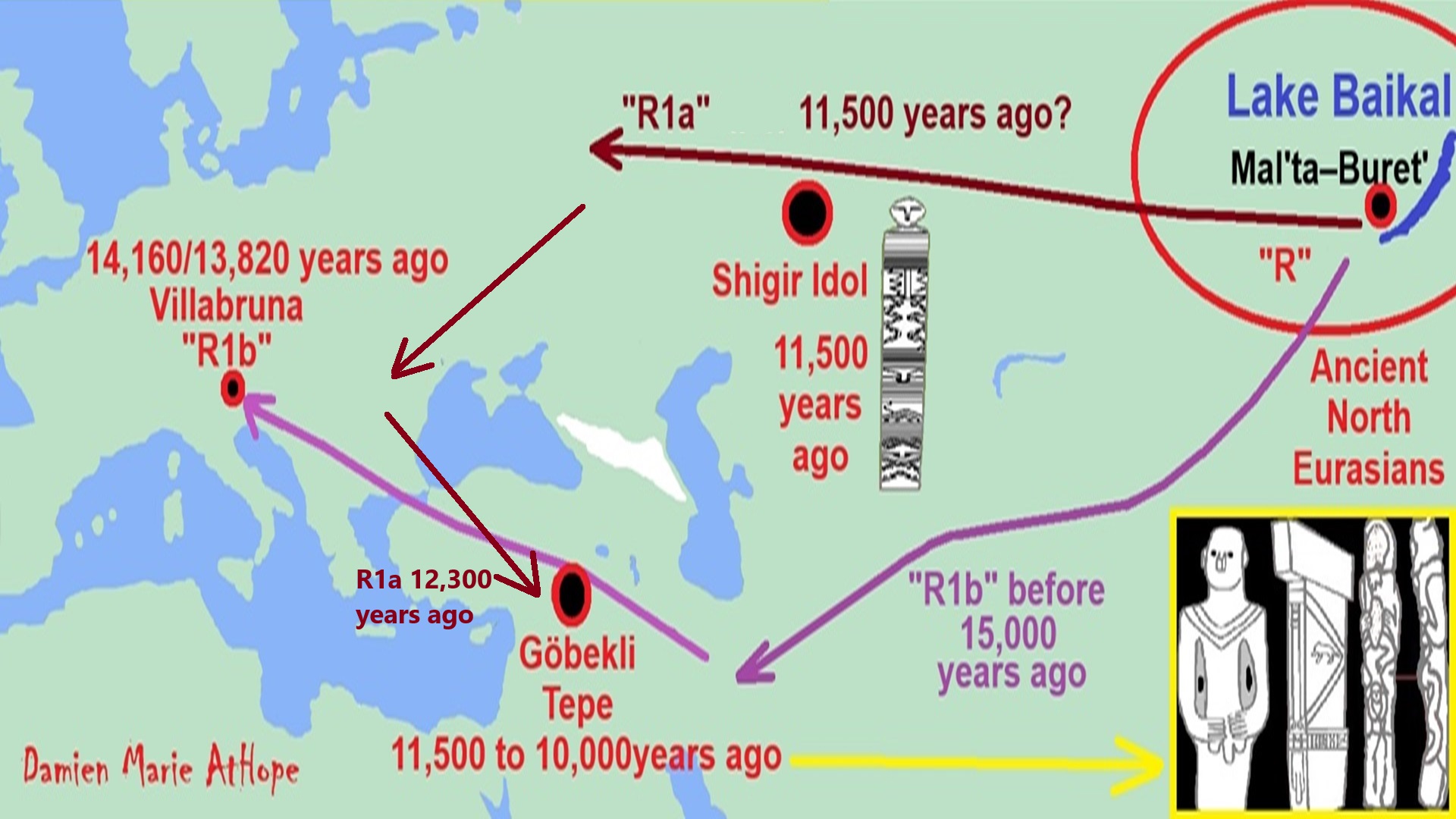
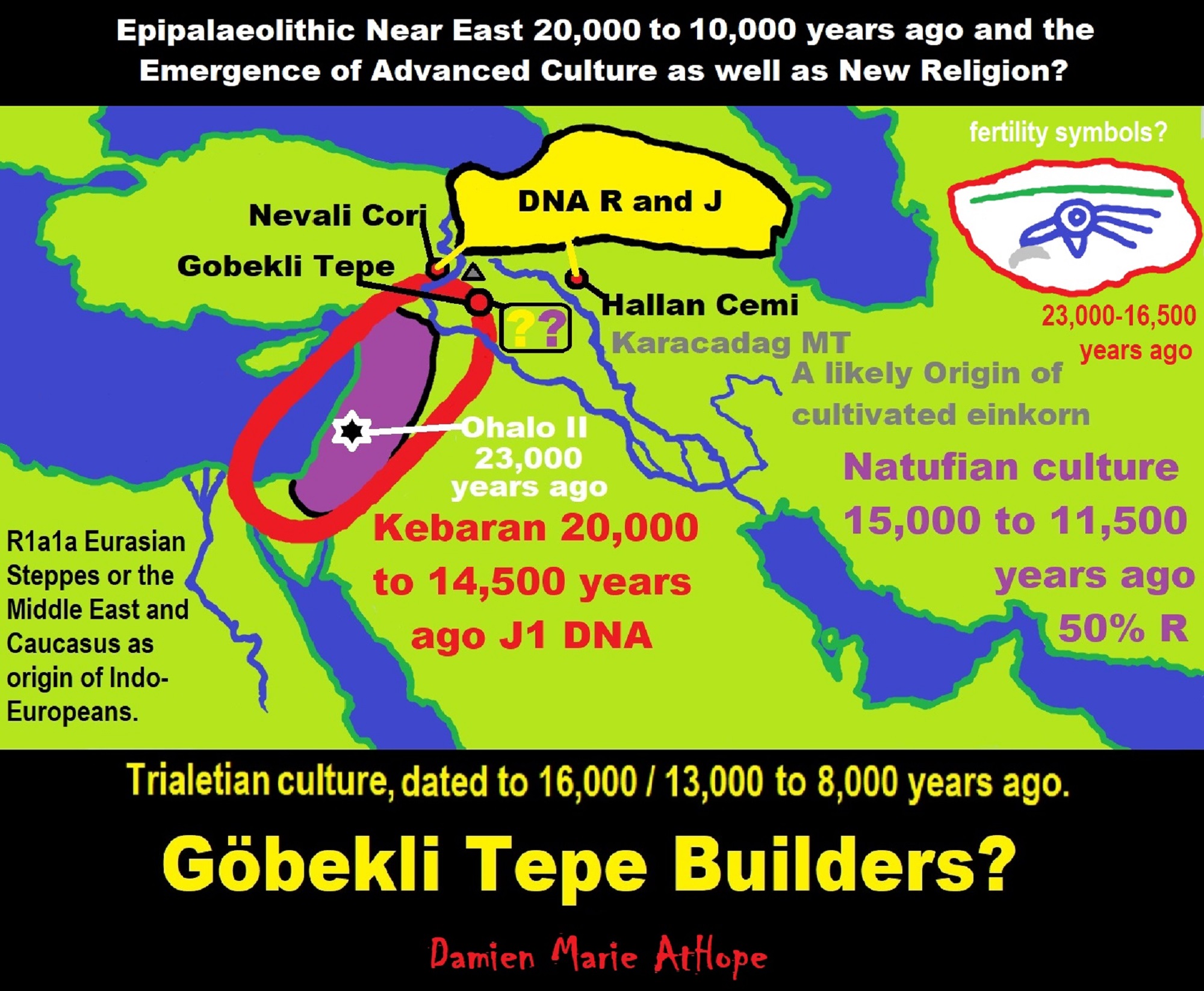
ref, ref, ref, ref, ref, ref, ref
Trialetian culture (16,000–8000 years ago) the Caucasus, Iran, and Turkey, likely involved in Göbekli Tepe. Migration 1?
Haplogroup R possible time of origin about 27,000 years in Central Asia, South Asia, or Siberia:
- Mal’ta–Buret’ culture (24,000-15,000 years ago)
- Afontova Gora culture (21,000-12,000 years ago)
- Trialetian culture (16,000–8000 years ago)
- Samara culture (7,000-6,500 years ago)
- Khvalynsk culture (7,000-6,500 years ago)
- Afanasievo culture (5,300-4,500 years ago)
- Yamna/Yamnaya Culture (5,300-4,500 years ago)
- Andronovo culture (4,000–2,900 years ago) ref
Trialetian sites
Caucasus and Transcaucasia:
- Edzani (Georgia)
- Chokh (Azerbaijan), layers E-C200
- Kotias Klde, layer B” ref
Eastern Anatolia:
- Hallan Çemi (from ca. 8.6-8.5k BC to 7.6-7.5k BCE)
- Nevali Çori shows some Trialetian admixture in a PPNB context” ref
Trialetian influences can also be found in:
- Cafer Höyük
- Boy Tepe” ref
Southeast of the Caspian Sea:
- Hotu (Iran)
- Ali Tepe (Iran) (from cal. 10,500 to 8,870 BCE)
- Belt Cave (Iran), layers 28-11 (the last remains date from ca. 6,000 BCE)
- Dam-Dam-Cheshme II (Turkmenistan), layers7,000-3,000 BCE)” ref
“Migration from Siberia behind the formation of Göbeklitepe: Expert states. People who migrated from Siberia formed the Göbeklitepe, and those in Göbeklitepe migrated in five other ways to spread to the world, said experts about the 12,000-year-old Neolithic archaeological site in the southwestern province of Şanlıurfa.“ The upper paleolithic migrations between Siberia and the Near East is a process that has been confirmed by material culture documents,” he said.” ref
“Semih Güneri, a retired professor from Caucasia and Central Asia Archaeology Research Center of Dokuz Eylül University, and his colleague, Professor Ekaterine Lipnina, presented the Siberia-Göbeklitepe hypothesis they have developed in recent years at the congress held in Istanbul between June 11 and 13. There was a migration that started from Siberia 30,000 years ago and spread to all of Asia and then to Eastern and Northern Europe, Güneri said at the international congress.” ref
“The relationship of Göbeklitepe high culture with the carriers of Siberian microblade stone tool technology is no longer a secret,” he said while emphasizing that the most important branch of the migrations extended to the Near East. “The results of the genetic analyzes of Iraq’s Zagros region confirm the traces of the Siberian/North Asian indigenous people, who arrived at Zagros via the Central Asian mountainous corridor and met with the Göbeklitepe culture via Northern Iraq,” he added.” ref
“Emphasizing that the stone tool technology was transported approximately 7,000 kilometers from east to west, he said, “It is not clear whether this technology is transmitted directly to long distances by people speaking the Turkish language at the earliest, or it travels this long-distance through using way stations.” According to the archaeological documents, it is known that the Siberian people had reached the Zagros region, he said. “There seems to be a relationship between Siberian hunter-gatherers and native Zagros hunter-gatherers,” Güneri said, adding that the results of genetic studies show that Siberian people reached as far as the Zagros.” ref
“There were three waves of migration of Turkish tribes from the Southern Siberia to Europe,” said Osman Karatay, a professor from Ege University. He added that most of the groups in the third wave, which took place between 2600-2400 BCE, assimilated and entered the Germanic tribes and that there was a genetic kinship between their tribes and the Turks. The professor also pointed out that there are indications that there is a technology and tool transfer from Siberia to the Göbeklitepe region and that it is not known whether people came, and if any, whether they were Turkish.” ref
“Around 12,000 years ago, there would be no ‘Turks’ as we know it today. However, there may have been tribes that we could call our ‘common ancestors,’” he added. “Talking about 30,000 years ago, it is impossible to identify and classify nations in today’s terms,” said Murat Öztürk, associate professor from İnönü University. He also said that it is not possible to determine who came to where during the migrations that were accepted to have been made thousands of years ago from Siberia. On the other hand, Mehmet Özdoğan, an academic from Istanbul University, has an idea of where “the people of Göbeklitepe migrated to.” ref
“According to Özdoğan, “the people of Göbeklitepe turned into farmers, and they could not stand the pressure of the overwhelming clergy and started to migrate to five ways.” “Migrations take place primarily in groups. One of the five routes extends to the Caucasus, another from Iran to Central Asia, the Mediterranean coast to Spain, Thrace and [the northwestern province of] Kırklareli to Europe and England, and one route is to Istanbul via [Istanbul’s neighboring province of] Sakarya and stops,” Özdoğan said. In a very short time after the migration of farmers in Göbeklitepe, 300 settlements were established only around northern Greece, Bulgaria, and Thrace. “Those who remained in Göbeklitepe pulled the trigger of Mesopotamian civilization in the following periods, and those who migrated to Mesopotamia started irrigated agriculture before the Sumerians,” he said.” ref
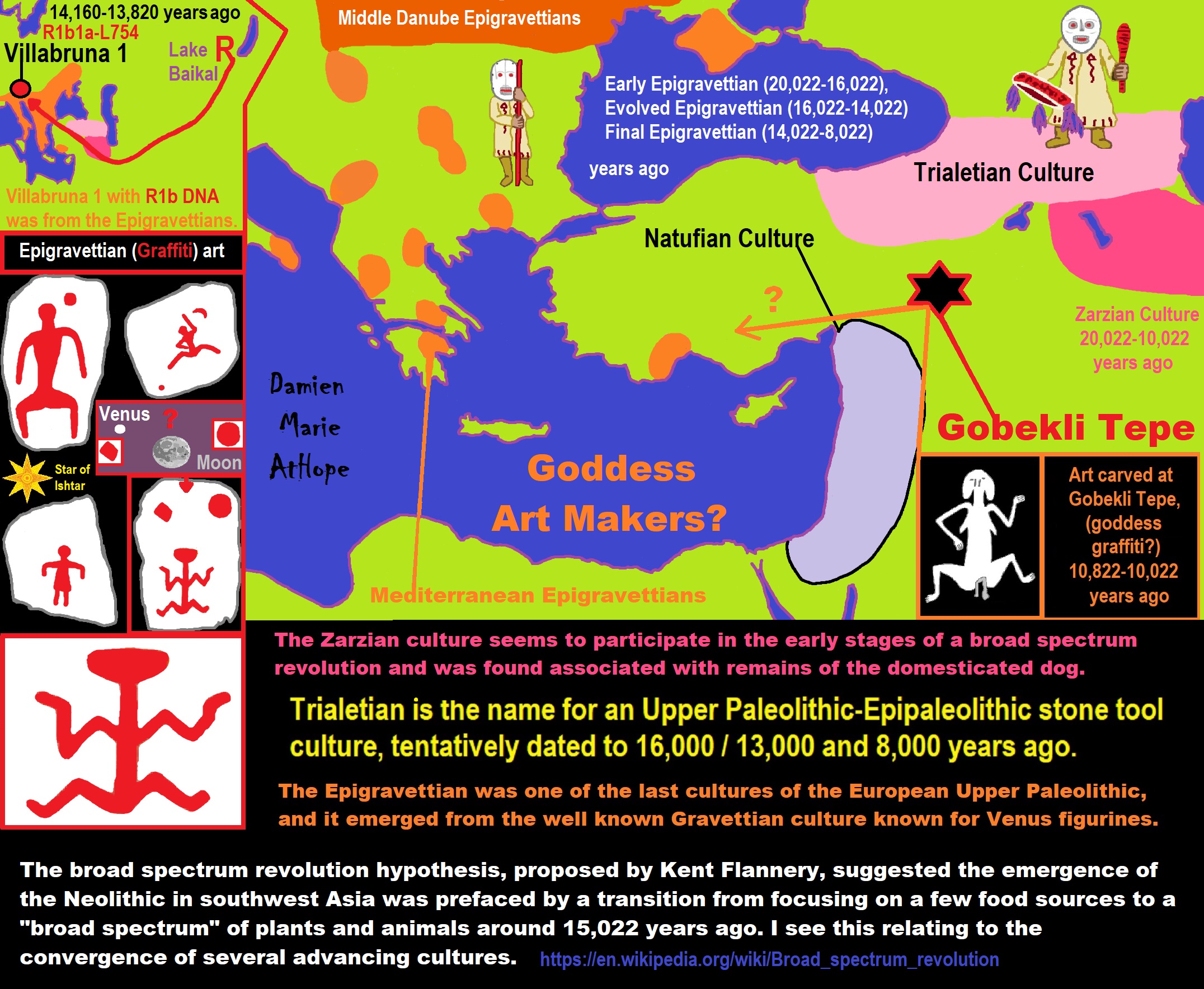
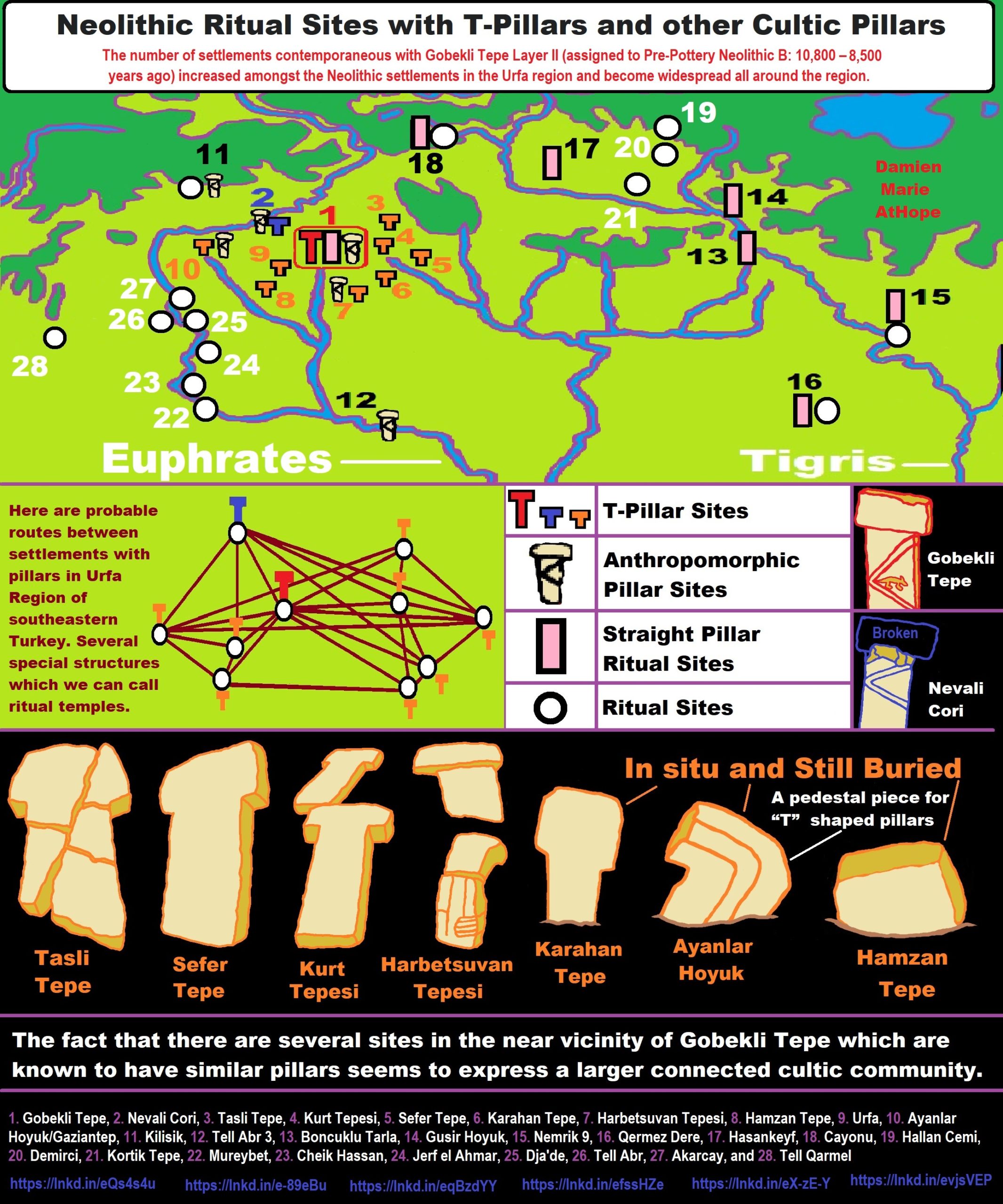
The number of settlements contemporaneous with Gobekli Tepe Layer II (assigned to Pre-Pottery Neolithic B: 10,800 – 8,500 years ago) increased amongst the Neolithic settlements in the Urfa region and become widespread all around the region.
- Gobekli Tepe, 2. Nevali Cori, 3. Tasli Tepe, 4. Kurt Tepesi, 5. Sefer Tepe, 6. Karahan Tepe, 7. Harbetsuvan Tepesi, 8. Hamzan Tepe, 9. Urfa, 10. Ayanlar Hoyuk/Gaziantep, 11. Kilisik, 12. Tell Abr 3, 13. Boncuklu Tarla, 14. Gusir Hoyuk, 15. Nemrik 9, 16. Qermez Dere, 17. Hasankeyf, 18. Cayonu, 19. Hallan Cemi, 20. Demirci, 21. Kortik Tepe, 22. Mureybet, 23. Cheik Hassan, 24. Jerf el Ahmar, 25. Dja’de, 26. Tell Abr, 27. Akarcay, and 28. Tell Qarmel
Göbekli Tepe is not alone, in fact, it is part of a religious/cultural connected ritual culture in the general region. There are several other similar sites with similar T-pillars to Göbekli Tepe or other types of stone pillar providing a seeming connected cult belief or religious culture of pillars seen in the PPNA-PPNB in the northern portion of the Near East.
“The locations of the sites that contain “T” shaped pillars are the main topic that needs more understanding to grasp the larger sociocultural-religious cultural complex in the same general region. Another matter under discussion is to comprehend the differences between the small-scale settlements that contain cult centers and “T” shaped pillars and the larger ones found at Gobekli Tepe layer III. The fact that settlements with “T” shaped pillars contain both the remains of circular domestic buildings and the pillars such as seen at Cayonu and Nevali Cori, which are also known to contain cult and domestic buildings. It is contemplated that such settlements are contemporary with Gobekli Tepe layer II and the cult building known from Nevali Cori based on the similarities and differences of the “T” shaped pillars. In the light of the finds unearthed from the settlements in Şanliurfa region that contain “T” shaped pillars, such settlements should be dated to the end of Late Pre-Pottery Neolithic A (LPPNA) and the Early Pre-Pottery Neolithic B (EPPNB).” ref

ref, ref, ref, ref, ref, ref, ref, ref, ref, ref, ref, ref, ref, ref, ref, ref, ref
“The shaman is, above all, a connecting figure, bridging several worlds for his people, traveling between this world, the underworld, and the heavens. He transforms himself into an animal and talks with ghosts, the dead, the deities, and the ancestors. He dies and revives. He brings back knowledge from the shadow realm, thus linking his people to the spirits and places which were once mythically accessible to all.–anthropologist Barbara Meyerhoff” ref
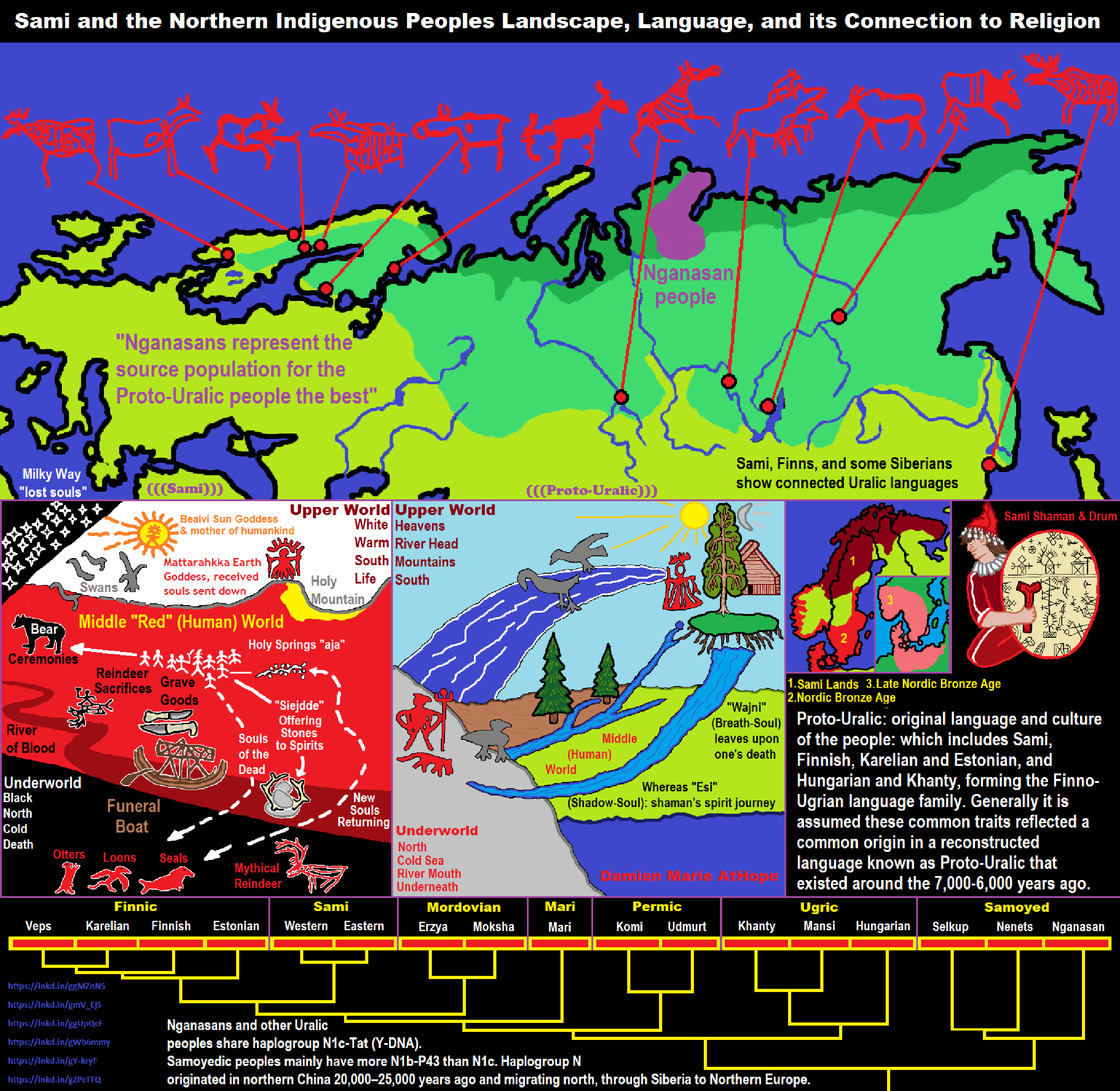

I tried to put all the DNA migrations, that together help explain Sami DNA, and thus some of their cultural influences.
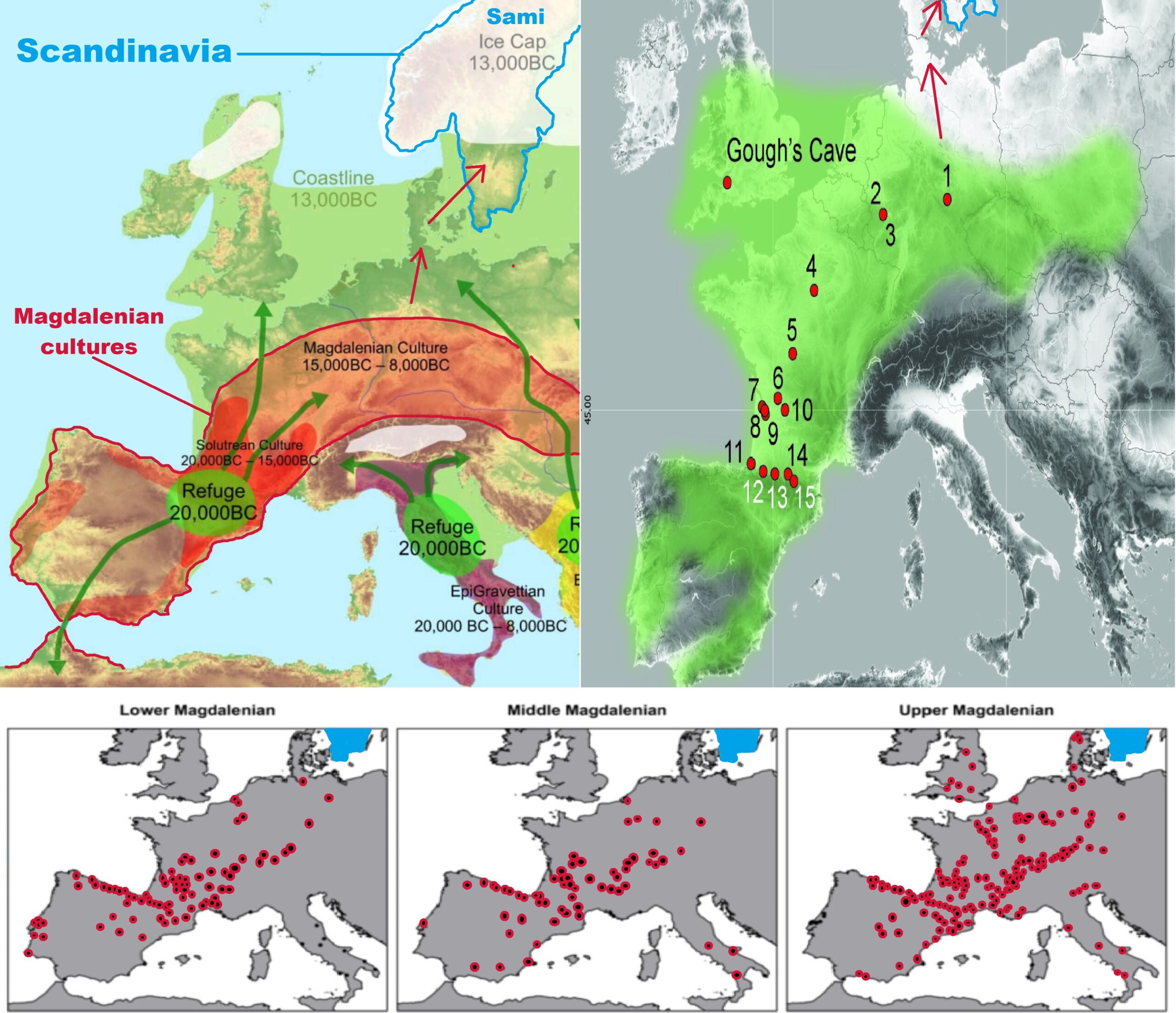
This helps us understand the origins and movements of the Magdalenian cultures, which eventually shared DNA U5 with the earliest Ancestors of the people that would become Sami.
Paleolithic Y-chromosomal haplogroups by chronological period
- Proto-Aurignacian (47,000 to 43,000 years before present; eastern Europe): F
- Aurignacian Culture (43,000 to 28,000 ybp ; all ice-free Europe): CT, C1a, C1b, I
- Gravettian Culture (31,000 to 24,000 ybp ; all ice-free Europe): BT, CT, F, C1a2
- Epiravettian Culture (22,000 to 8,000 ybp ; Italy): R1b1a
- Magdalenian Culture 17,000 to 12,000 ybp ; Western Europe): IJK, I
- Epipaleolithic France (13,000 to 10,000 ybp): I
- Azilian Culture (12,000 to 9,000 ybp ; Western Europe): I2 ref
Paleolithic mitochondrial haplogroups by chronological period
- Proto-Aurignacian (47,000 to 43,000 years before present ; eastern Europe): N, R*
- Aurignacian Culture (43,000 to 28,000 ybp ; all ice-free Europe): M, U, U2, U6
- Gravettian Culture (31,000 to 24,000 ybp ; all ice-free Europe): M, U, U2’3’4’7’8’9, U2 (x5), U5 (x5), U8c (x2)
- Solutrean Culture (22,000 to 17,000 ybp ; France, Spain): U
- Epiravettian Culture (22,000 to 8,000 ybp ; Italy): U2’3’4’7’8’9, U5b2b (x2)
- Magdalenian Culture 17,000 to 12,000 ybp ; Western Europe): R0, R1b, U2’3’4’7’8’9, U5b (x2), U8a (x5)
- Epipaleolithic France (13,000 to 10,000 ybp): U5b1, U5b2a, U5b2b (x2)
- Epipaleolithic Germany (13,000 to 11,000 ybp): U5b1 (x2)
- Azilian Culture (12,000 to 9,000 ybp ; Western Europe): U5b1h ref
Mesolithic Y-chromosomal haplogroups by country
- Ireland: I2a1b, I2a2
- Britain: IJK, I2a2 (x2)
- France: I (x3), I2a1b2
- Luxembourg: I2a1b
- Germany: I2a2a
- Spain: C1a2
- Italy: I, I2a2
- Sweden: I2a1 (x2), I2a1a1a*, I2a1b (x2), I2c2
- Estonia: R1a-YP1272
- Latvia: I2a1 (x2), I2a1b, I2a2a1, I2a2a1b (x2), Q1a2, R1b1a1a-P297 (x7)
- Lithuania: I2a1b, I2a1a2a1a-L233
- Serbia: I, I2 (x2), I2a1, I2a2, I2a2a-M223, I2a2a-Z161 (x2), R, R1b1a-L794 (x8)
- Romania: R, R1, R1b
- Ukraine: IJ, I (x4), I2, I2a1, I2a2, I2a2a, I2a2a1b1-L702 (x2), R1a, R1b1a-L794
- Russia: J, R1a1* (x3), R1a1-YP1301, R1b1a, R1b1a1a-P297 ref
Mesolithic mitochondrial haplogroups by country
Note that the very late Mesolithic Pitted Ware culture (c. 3200–2300 BCE) in Sweden is listed separately as it is possible that intermarriages with Neolithic or Chalcolithic neighbors took place.
- Croatia: U5b2a5
- France: U5a2 (x2), U5b1, U5b1b
- Germany, Luxembourg: U2e, U4, U5a, U5a2c (x2), U5a2c3, U5b (x2), U5b1a, U5b1d1 (x2), U5b2a2, U5b2c1
- Greece: K1c (x2)
- Italy: U5b1
- Lithuania: U4, U5b (x3)
- Poland: U5a, U5b (x2), U5b1b
- Spain: U5b, U5b1, U5b2c1 (x2)
- Russia: C, C1g, C5d, D, H, U2e, U4 (x3), U4a, U4a1, U5a (x3), U5a1 (x2), U5a1d, T, Z1a (x2)
- Sweden: U2e1 (x2), U4b1, U5a1 (x3), U5a2, U5a2d (x2)
- Sweden (Pitted Ware): H, H1f, HV0 (x2), K1a, K1a1 (x3), T2b (x2), U, U4 (x8), U4a1, U4d (x3), U5a, U5a1a’g (x2), U5b (x2), U5b1, U5b2b1a ref
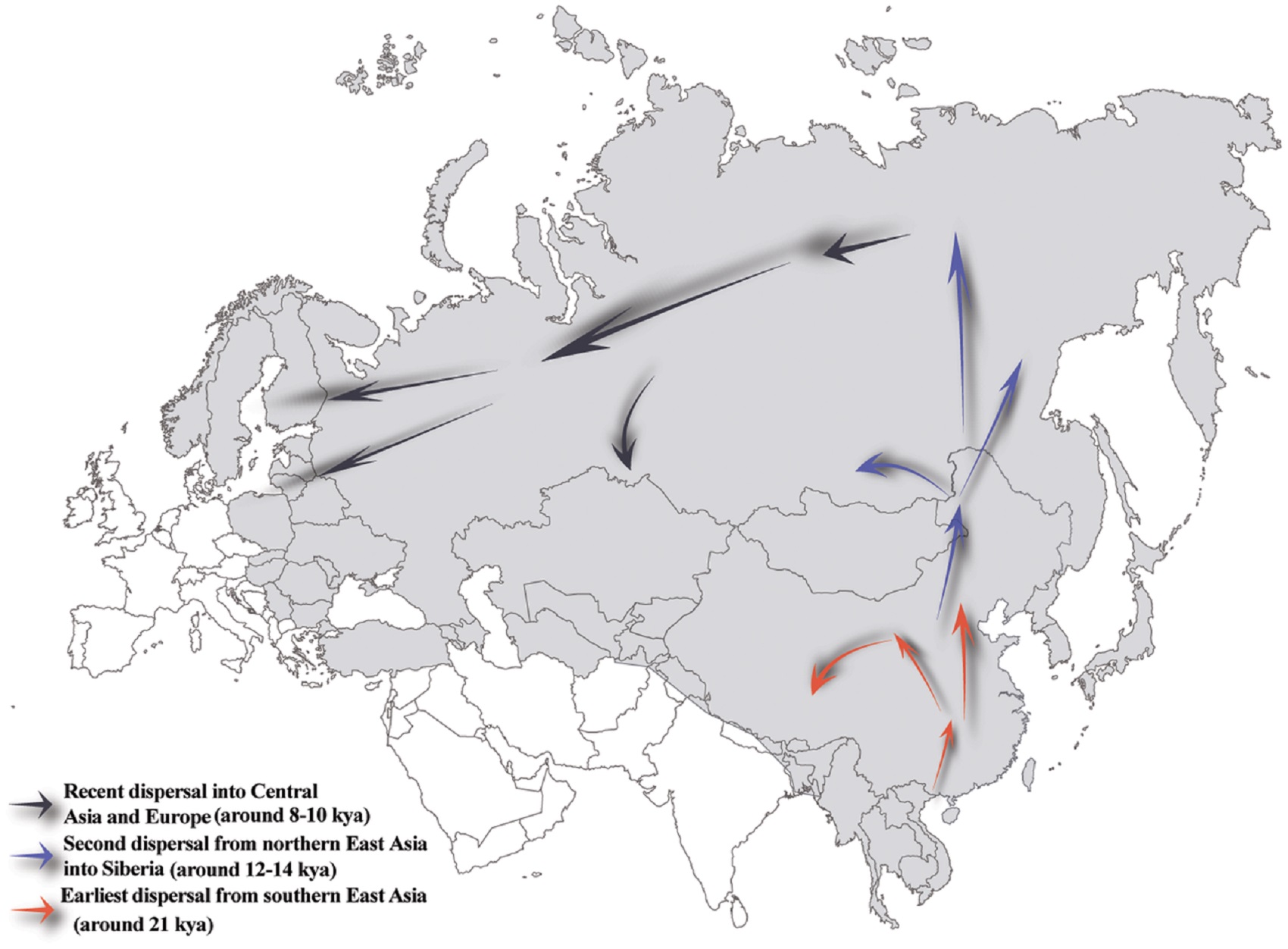
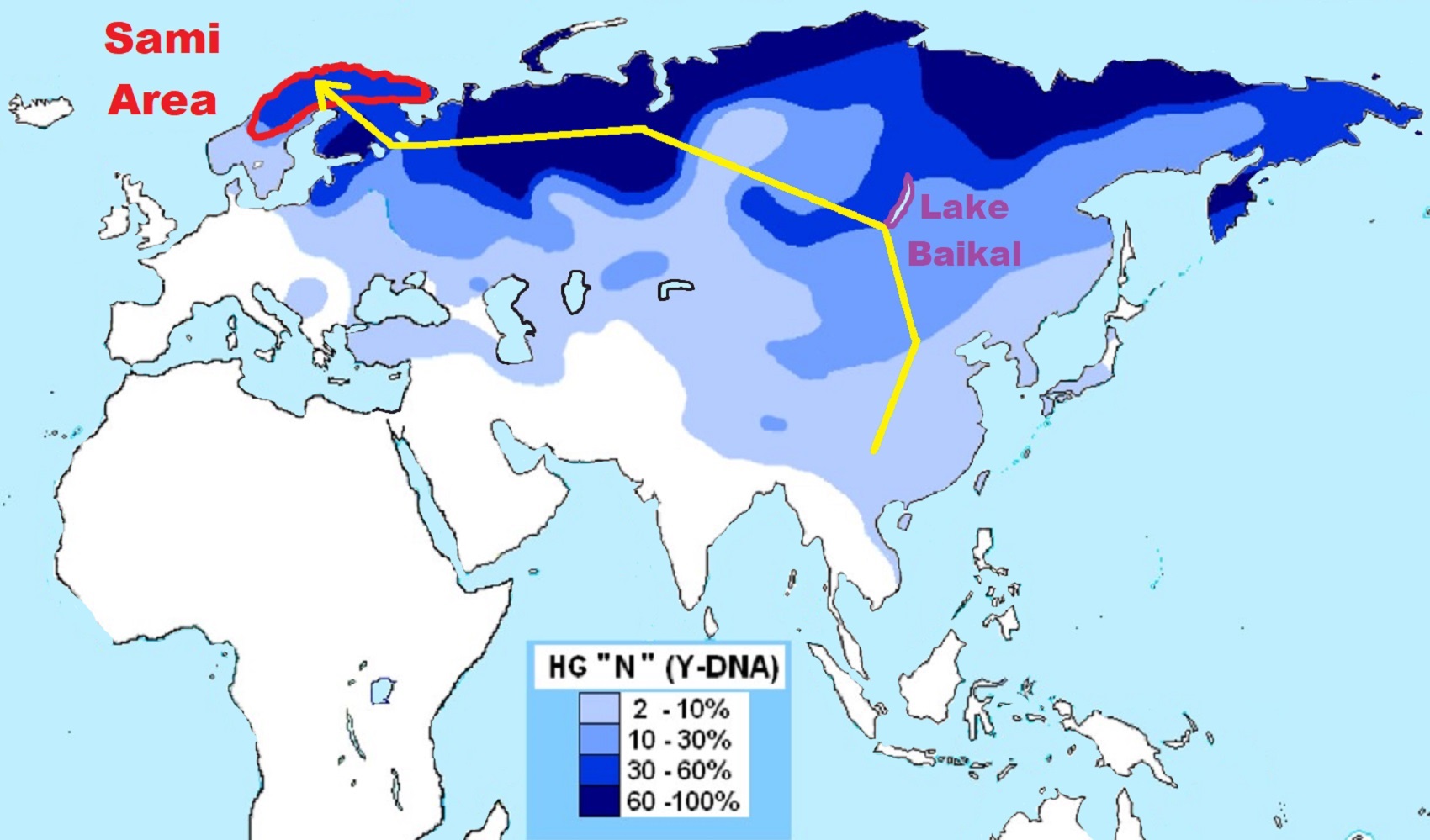
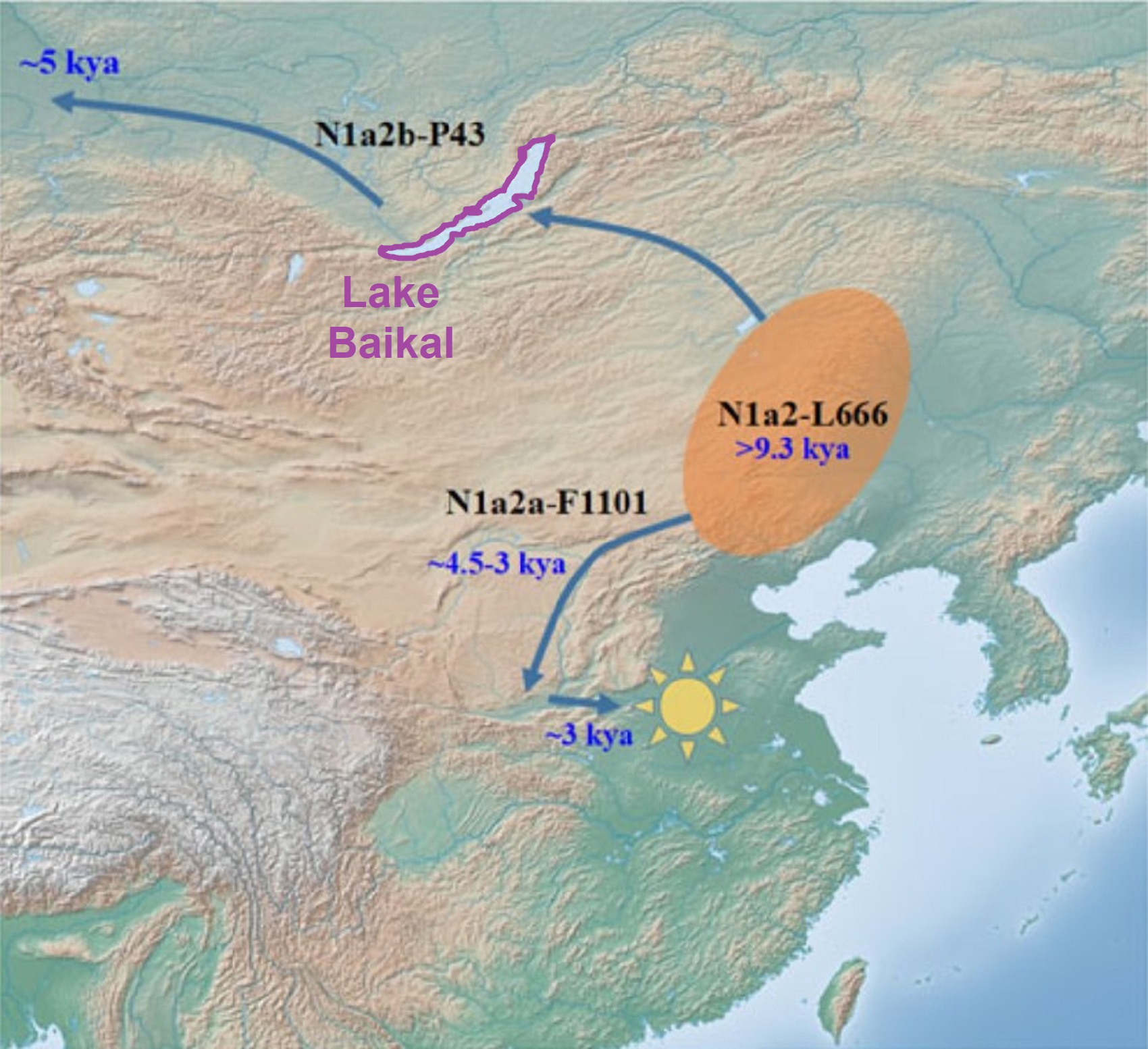
Early history between 9,300 and 4,400 years ago
“As the only two downstream clades of N1a2-L666, the geographical distribution of N1a2a-F1101 and N1a2b-P43 is very different from each other. Ancient DNA studies have identified early branches of N1a2a-F1101 and N1a2b-P43 in sites in the Baikal region (de Barros Damgaard et al., 2018; Kilinc et al., 2021; Ma et al., 2021). The most recent branch of N1a2-L666 is N1a1-M46, the main paternal type of the Uralic population (Ilumäe et al., 2016). The first two early branches under N1a1-M46, N1a1b-Y149447, and N1a1a3-F4065, are mainly distributed in northeast China (https://www.yfull.com/tree/N/) (Hu et al., 2015). Therefore, we speculate that the initial spread of haplogroup N1a2-L666 may have been in the southwestern part of northeastern China (Figure 3).” ref
“The researchers proposed that this region is also the initial diffusion center of N1a1-M46, while the diffusion of N1a1-M46 (>12,000 years ago) happened earlier than that of N1a2-L666 (<9,300 years ago) (Hu et al., 2015). In the early Holocene (about 11,200-8,000 years ago), with climate change and the rise of early agricultural populations in northern China, a part of the descendants of the ancestor group, representing by sub-lineage N1a2b-P43, spread to the high latitude region of Siberia, eventually becoming part of the Ural-speaking populations. The other part, representing by sub-lineage N1a2a-F1101, remained in the local area and participated in the formation of the northern Chinese populations in the later historical period (Figure 3).” ref
“A bottleneck period of 5,000 years was observed early in the evolution of N1a2a-F1101 (Figure 1, Supplementary Table S1). Similar lengthy bottleneck periods were observed in downstream structures of N1a2b-P43, N1a1-M46, and Q1a1a-M120 (Ilumäe et al., 2016; Sun et al., 2019). This evolutionary pattern is very different from the expansion pattern of ancient agricultural populations in East Asia, which continued to expand since the beginning of Neolithic age (Yan et al., 2014). The differentiation of the downstream clades of Q-M242 and N-231 presents a similar structure, i.e., downstream clades with high-frequency distribution both in East Asia and Siberia, respectively. Therefore, we speculate that in the bottleneck interval, ancient populations with Q1a1a-M120 and N1a2a-F1101 as the main paternal lineages are likely to exist in the form of prehistoric hunter-gatherer populations in the border between the eastern Eurasian steppe and the northern-northeastern China. The drought and harsh natural environment of this area had a great influence on the evolution of the two paternal lineages in later historical periods.” ref
Expansion during the chalcolithic age and bronze age
“During the Chalcolithic age (about 4.5 kya-4.0 kya) in East Asia, copper, cattle, and wheat were introduced to the East Asian heartland (Liu and Chen, 2003; Liu, 2004; Liu and Chen, 2017). Archaeologists have suggested that the elements may have spread from the northern boundary of China through the Eurasian steppe. However, the demographic context of this important cultural process is very ambiguous. Around 4,000 years ago, the Bronze culture arose in the agro-pastoral region of northwestern China and later spread across East Asia and Southeast Asia. The mixing of the bronze culture of agriculture and animal husbandry with the people of the middle and lower reaches of the Yellow River contributed to the establishment of three dynasties of the Bronze Age in ancient China, namely the Xia, Shang, and Zhou dynasties (Liu and Chen, 2003; Liu, 2004; Liu and Chen, 2017).” ref
“As discussed above, ancient populations with Q1a1a-M120 and N1a2a-F1101 as the main paternal lineages may have played a mediating role in the spread of the Copper and Bronze cultures from the eastern Eurasian steppe to the central East Asian region, due to their area of activity in the junction zone. Due to the same reason, these two paternal lines experienced a very significant spread during the Bronze Age, becoming important patrilineal lineages that occupied an upper political position in the Bronze Age, and were frequently detected in the tombs of chiefs and nobles of the time (Zhao et al., 2014; Sun et al., 2019; Ma et al., 2021; Wei et al., 2022). An interesting thing is that the significant expansion of N1a2a-F1101 occurred after 3,300 years ago, significantly later than the major expansion period of Q1a1a-M120 (4.2 kya-3 kya, Figure 1).” ref
“Nevertheless, several downstream clades of Q1a1a-M120, like F4759 and F4689, exhibit simultaneous expansion with N1a2a1a1a1a1-F710 (Sun et al., 2019). Ancient DNA data suggest that these two paternal lineages were concentrated in ancient populations in northwest China, and co-occurred in some tombs (Zhao et al., 2014; Ma et al., 2021; Wei et al., 2022). These ancient DNA studies also suggest that N1a2a-F1101 is likely the paternal lineage of the royal family of the Zhou Dynasty, while Q1a1a-M120 is the main paternal lineage of the Rong-Di populations (Means “Barbarians” in ancient Chinese). Both paternal lineages became the main paternal component of the Chinese group in later generations. In conclusion, we speculate that Q1a1a-M120 and N1a2a-F1101 together constitute the main paternal lineages of the populations that worked as farmers and pastoralists in northwest China during the Copper-Bronze Age. They played a key role in the emergence of bronze culture, early states, and early civilizations in the central region of ancient China.” ref
Bronze age globalization in East Asia
“As, discussed in the Introduction section, Bronze Age globalization has led to the mass replacement and mixing of populations in multiple parts of Eurasia (Allentoft et al., 2015). In East Asia, however, the situation is quite different. Ancient DNA shows that during the Copper-Bronze Age, the populations in the central East Asian region did not experience large-scale replacement, and the genetic components from Indo-Europeans are nearly absent. Based on previous literature and the results of this paper, we suggest that the Gobi Desert on the border between China and Mongolia may have hindered the spread of the Bronze culture and Indo-European-related populations. The hunter-gatherer communities that originally operated in the north and south of the Gobi Desert relied on their familiarity with the environment and long-distance material exchange networks to spread relevant cultural elements as intermediaries. In later historical periods, they became the main founders of the bronze culture populations in northwest China.” ref
“These demographic histories led to the spread of Bronze culture into central East Asia as a form of cultural diffusion, unlike what happened in other parts of Eurasia during the Bronze Age period of globalization. In summary, we constructed a high-resolution phylogeny for Y-chromosome haplogroup N1a2a-F1101, one of the main paternal lineages of modern Chinese. We explored the demographic of this paternal haplogroup in the past 9,000 years. We also discussed the activity of ancient populations with this lineage and their role during the appearance of Bronze Age culture, the formation of early state and early civilizations in the central region of China. The newly-discovered sub-branches and variants will assist in exploring the formation process of gene pool of Chinese populations and their cultural traditions.” ref
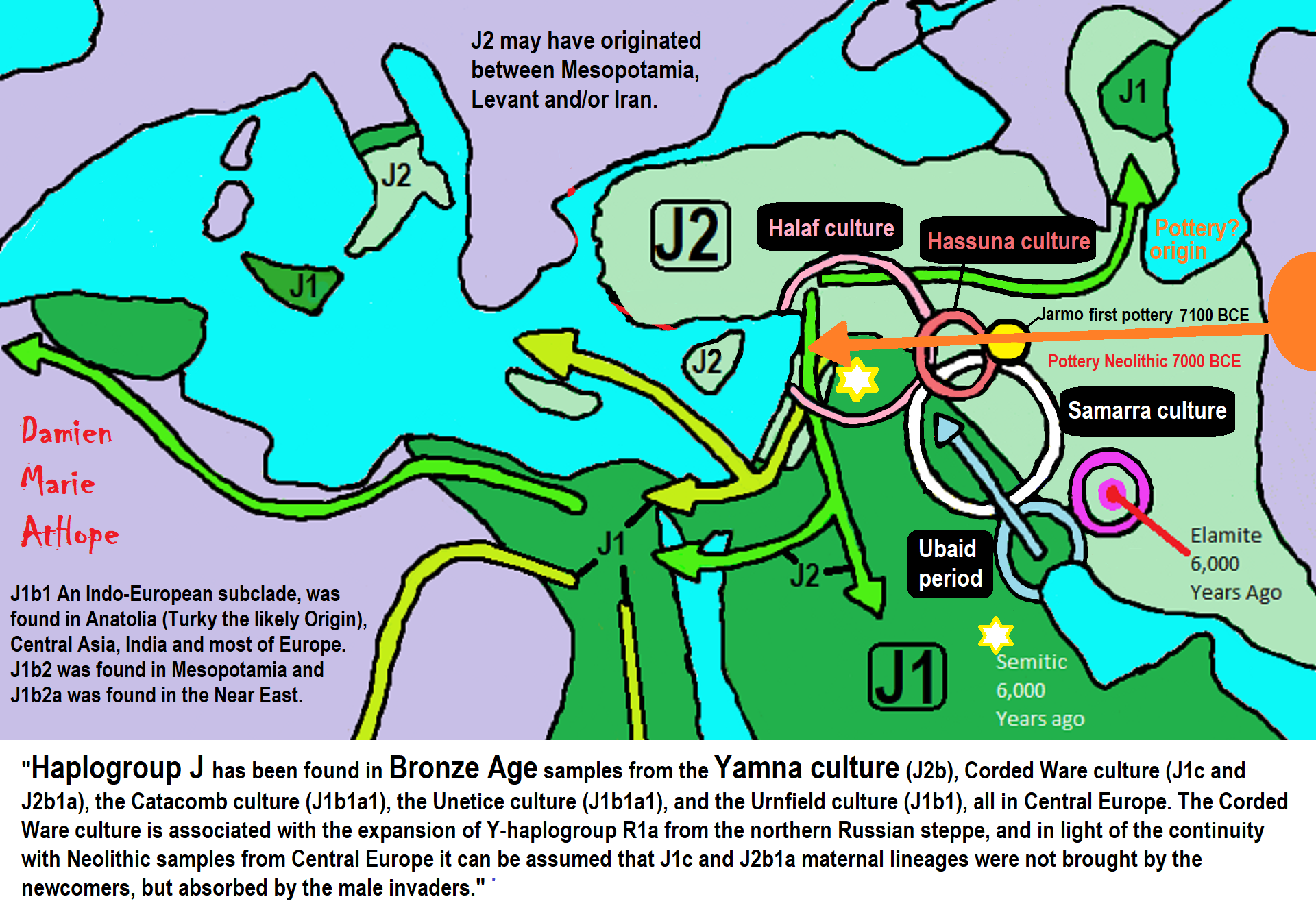
But is Atlantis real?
No. Atlantis (an allegory: “fake story” interpreted to reveal a hidden meaning) can’t be found any more than one can locate the Jolly Green Giant that is said to watch over frozen vegetables. Lol


May Reason Set You Free
There are a lot of truly great things said by anarchists in history, and also some deeply vile things, too, from not supporting Women’s rights to Anti-Semitism. There are those who also reject those supporting women’s rights as well as fight anti-Semitism. This is why I push reason as my only master, not anarchist thinking, though anarchism, to me, should see all humans everywhere as equal in dignity and rights.
We—Cory and Damien—are following the greatness that can be found in anarchist thinking.
As an Anarchist Educator, Damien strives to teach the plain truth. Damien does not support violence as my method to change. Rather, I choose education that builds Enlightenment and Empowerment. I champion Dignity and Equality. We rise by helping each other. What is the price of a tear? What is the cost of a smile? How can we see clearly when others pay the cost of our indifference and fear? We should help people in need. Why is that so hard for some people? Rich Ghouls must End. Damien wants “billionaires” to stop being a thing. Tax then into equality. To Damien, there is no debate, Capitalism is unethical. Moreover, as an Anarchist Educator, Damien knows violence is not the way to inspire lasting positive change. But we are not limited to violence, we have education, one of the most lasting and powerful ways to improve the world. We empower the world by championing Truth and its supporters.
Anarchism and Education
“Various alternatives to education and their problems have been proposed by anarchists which have gone from alternative education systems and environments, self-education, advocacy of youth and children rights, and freethought activism.” ref
“Historical accounts of anarchist educational experiments to explore how their pedagogical practices, organization, and content constituted a radical alternative to mainstream forms of educational provision in different historical periods.” ref
“The Ferrer school was an early 20th century libertarian school inspired by the anarchist pedagogy of Francisco Ferrer. He was a proponent of rationalist, secular education that emphasized reason, dignity, self-reliance, and scientific observation. The Ferrer movement’s philosophy had two distinct tendencies: non-didactic freedom from dogma and the more didactic fostering of counter-hegemonic beliefs. Towards non-didactic freedom from dogma, and fulfilled the child-centered tradition.” ref

Teach Real History: all our lives depend on it.
Damien sees lies about history as crimes against humanity. And we all must help humanity by addressing “any and all” who make harmful lies about history.
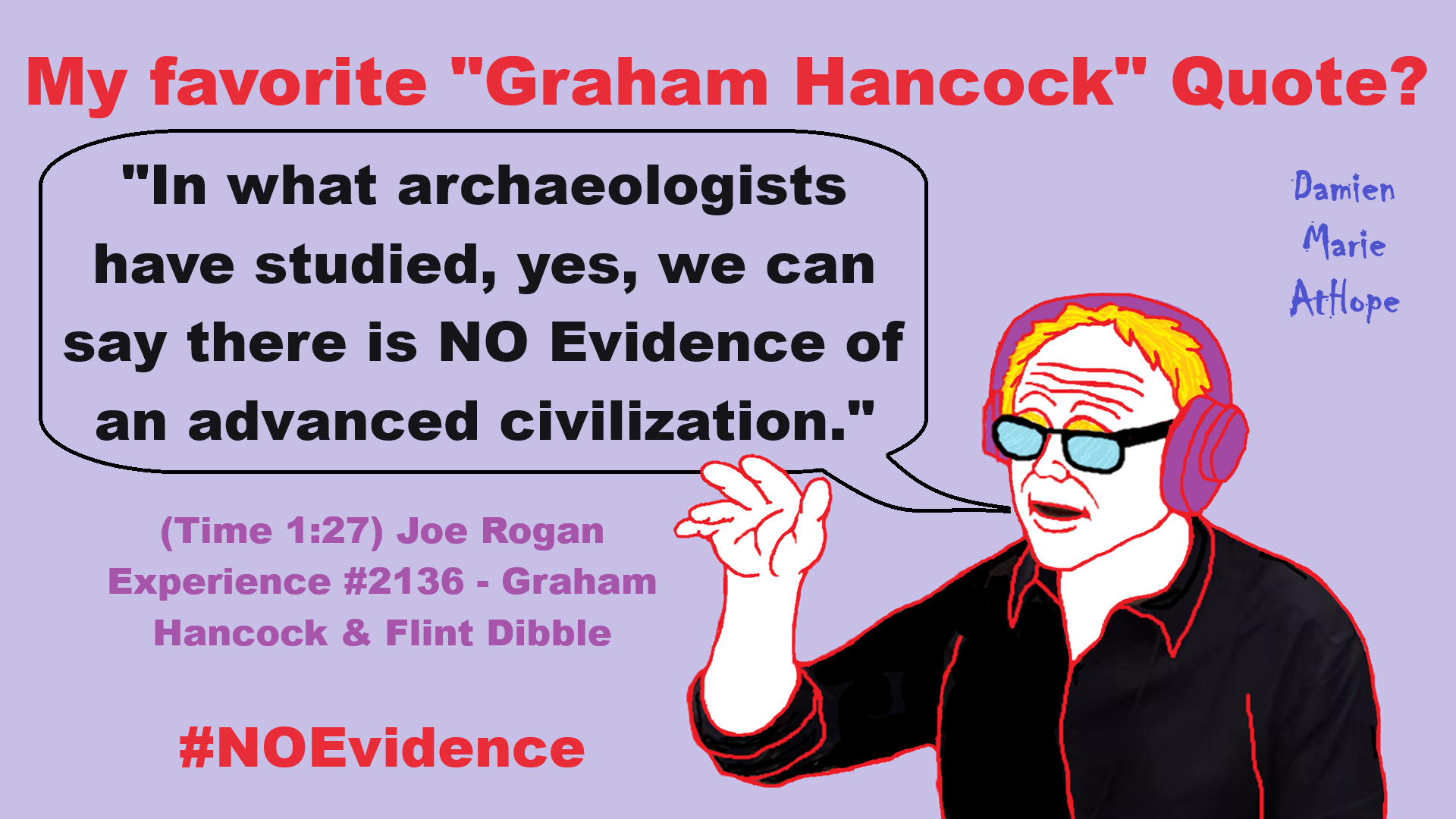
My favorite “Graham Hancock” Quote?
“In what archaeologists have studied, yes, we can say there is NO Evidence of an advanced civilization.” – (Time 1:27) Joe Rogan Experience #2136 – Graham Hancock & Flint Dibble

People don’t commonly teach religious history, even that of their own claimed religion. No, rather they teach a limited “pro their religion” history of their religion from a religious perspective favorable to the religion of choice.

Do you truly think “Religious Belief” is only a matter of some personal choice?
Do you not see how coercive one’s world of choice is limited to the obvious hereditary belief, in most religious choices available to the child of religious parents or caregivers? Religion is more commonly like a family, culture, society, etc. available belief that limits the belief choices of the child and that is when “Religious Belief” is not only a matter of some personal choice and when it becomes hereditary faith, not because of the quality of its alleged facts or proposed truths but because everyone else important to the child believes similarly so they do as well simply mimicking authority beliefs handed to them. Because children are raised in religion rather than being presented all possible choices but rather one limited dogmatic brand of “Religious Belief” where children only have a choice of following the belief as instructed, and then personally claim the faith hereditary belief seen in the confirming to the belief they have held themselves all their lives. This is obvious in statements asked and answered by children claiming a faith they barely understand but they do understand that their family believes “this or that” faith, so they feel obligated to believe it too. While I do agree that “Religious Belief” should only be a matter of some personal choice, it rarely is… End Hereditary Religion!

Animism: Respecting the Living World by Graham Harvey
“How have human cultures engaged with and thought about animals, plants, rocks, clouds, and other elements in their natural surroundings? Do animals and other natural objects have a spirit or soul? What is their relationship to humans? In this new study, Graham Harvey explores current and past animistic beliefs and practices of Native Americans, Maori, Aboriginal Australians, and eco-pagans. He considers the varieties of animism found in these cultures as well as their shared desire to live respectfully within larger natural communities. Drawing on his extensive casework, Harvey also considers the linguistic, performative, ecological, and activist implications of these different animisms.” ref

We are like believing machines we vacuum up ideas, like Velcro sticks to almost everything. We accumulate beliefs that we allow to negatively influence our lives, often without realizing it. Our willingness must be to alter skewed beliefs that impend our balance or reason, which allows us to achieve new positive thinking and accurate outcomes.

My thoughts on Religion Evolution with external links for more info:
- (Pre-Animism Africa mainly, but also Europe, and Asia at least 300,000 years ago), (Pre-Animism – Oxford Dictionaries)
- (Animism Africa around 100,000 years ago), (Animism – Britannica.com)
- (Totemism Europe around 50,000 years ago), (Totemism – Anthropology)
- (Shamanism Siberia around 30,000 years ago), (Shamanism – Britannica.com)
- (Paganism Turkey around 12,000 years ago), (Paganism – BBC Religion)
- (Progressed Organized Religion “Institutional Religion” Egypt around 5,000 years ago), (Ancient Egyptian Religion – Britannica.com)
- (CURRENT “World” RELIGIONS after 4,000 years ago) (Origin of Major Religions – Sacred Texts)
- (Early Atheistic Doubting at least by 2,600 years ago) (History of Atheism – Wikipedia)
“Religion is an Evolved Product” and Yes, Religion is Like Fear Given Wings…
Atheists talk about gods and religions for the same reason doctors talk about cancer, they are looking for a cure, or a firefighter talks about fires because they burn people and they care to stop them. We atheists too often feel a need to help the victims of mental slavery, held in the bondage that is the false beliefs of gods and the conspiracy theories of reality found in religions.
Understanding Religion Evolution:
- Pre-Animism (at least 300,000 years ago)
- Animism (Africa: 100,000 years ago)
- Totemism (Europe: 50,000 years ago)
- Shamanism (Siberia: 30,000 years ago)
- Paganism (Turkey: 12,000 years ago)
- Progressed organized religion (Egypt: 5,000 years ago), (Egypt, the First Dynasty 5,150 years ago)
- CURRENT “World” RELIGIONS (after 4,000 years ago)
- Early Atheistic Doubting (at least by 2,600 years ago)
“An Archaeological/Anthropological Understanding of Religion Evolution”
It seems ancient peoples had to survived amazing threats in a “dangerous universe (by superstition perceived as good and evil),” and human “immorality or imperfection of the soul” which was thought to affect the still living, leading to ancestor worship. This ancestor worship presumably led to the belief in supernatural beings, and then some of these were turned into the belief in gods. This feeble myth called gods were just a human conceived “made from nothing into something over and over, changing, again and again, taking on more as they evolve, all the while they are thought to be special,” but it is just supernatural animistic spirit-belief perceived as sacred.
Quick Evolution of Religion?
Pre-Animism (at least 300,000 years ago) pre-religion is a beginning that evolves into later Animism. So, Religion as we think of it, to me, all starts in a general way with Animism (Africa: 100,000 years ago) (theoretical belief in supernatural powers/spirits), then this is physically expressed in or with Totemism (Europe: 50,000 years ago) (theoretical belief in mythical relationship with powers/spirits through a totem item), which then enlists a full-time specific person to do this worship and believed interacting Shamanism (Siberia/Russia: 30,000 years ago) (theoretical belief in access and influence with spirits through ritual), and then there is the further employment of myths and gods added to all the above giving you Paganism (Turkey: 12,000 years ago) (often a lot more nature-based than most current top world religions, thus hinting to their close link to more ancient religious thinking it stems from). My hypothesis is expressed with an explanation of the building of a theatrical house (modern religions development). Progressed organized religion (Egypt: 5,000 years ago) with CURRENT “World” RELIGIONS (after 4,000 years ago).
Historically, in large city-state societies (such as Egypt or Iraq) starting around 5,000 years ago culminated to make religion something kind of new, a sociocultural-governmental-religious monarchy, where all or at least many of the people of such large city-state societies seem familiar with and committed to the existence of “religion” as the integrated life identity package of control dynamics with a fixed closed magical doctrine, but this juggernaut integrated religion identity package of Dogmatic-Propaganda certainly did not exist or if developed to an extent it was highly limited in most smaller prehistoric societies as they seem to lack most of the strong control dynamics with a fixed closed magical doctrine (magical beliefs could be at times be added or removed). Many people just want to see developed religious dynamics everywhere even if it is not. Instead, all that is found is largely fragments until the domestication of religion.
Religions, as we think of them today, are a new fad, even if they go back to around 6,000 years in the timeline of human existence, this amounts to almost nothing when seen in the long slow evolution of religion at least around 70,000 years ago with one of the oldest ritual worship. Stone Snake of South Africa: “first human worship” 70,000 years ago. This message of how religion and gods among them are clearly a man-made thing that was developed slowly as it was invented and then implemented peace by peace discrediting them all. Which seems to be a simple point some are just not grasping how devastating to any claims of truth when we can see the lie clearly in the archeological sites.
I wish people fought as hard for the actual values as they fight for the group/clan names political or otherwise they think support values. Every amount spent on war is theft to children in need of food or the homeless kept from shelter.
Here are several of my blog posts on history:
- To Find Truth You Must First Look
- (Magdalenian/Iberomaurusian) Connections to the First Paganists of the early Neolithic Near East Dating from around 17,000 to 12,000 Years Ago
- Natufians: an Ancient People at the Origins of Agriculture and Sedentary Life
- Possible Clan Leader/Special “MALE” Ancestor Totem Poles At Least 13,500 years ago?
- Jewish People with DNA at least 13,200 years old, Judaism, and the Origins of Some of its Ideas
- Baltic Reindeer Hunters: Swiderian, Lyngby, Ahrensburgian, and Krasnosillya cultures 12,020 to 11,020 years ago are evidence of powerful migratory waves during the last 13,000 years and a genetic link to Saami and the Finno-Ugric peoples.
- The Rise of Inequality: patriarchy and state hierarchy inequality
- Fertile Crescent 12,500 – 9,500 Years Ago: fertility and death cult belief system?
- 12,400 – 11,700 Years Ago – Kortik Tepe (Turkey) Pre/early-Agriculture Cultic Ritualism
- Ritualistic Bird Symbolism at Gobekli Tepe and its “Ancestor Cult”
- Male-Homosexual (female-like) / Trans-woman (female) Seated Figurine from Gobekli Tepe
- Could a 12,000-year-old Bull Geoglyph at Göbekli Tepe relate to older Bull and Female Art 25,000 years ago and Later Goddess and the Bull cults like Catal Huyuk?
- Sedentism and the Creation of goddesses around 12,000 years ago as well as male gods after 7,000 years ago.
- Alcohol, where Agriculture and Religion Become one? Such as Gobekli Tepe’s Ritualistic use of Grain as Food and Ritual Drink
- Neolithic Ritual Sites with T-Pillars and other Cultic Pillars
- Paganism: Goddesses around 12,000 years ago then Male Gods after 7,000 years ago
- First Patriarchy: Split of Women’s Status around 12,000 years ago & First Hierarchy: fall of Women’s Status around 5,000 years ago.
- Natufians: an Ancient People at the Origins of Agriculture and Sedentary Life
- J DNA and the Spread of Agricultural Religion (paganism)
- Paganism: an approximately 12,000-year-old belief system
- Paganism 12,000 years old: related to “Anarchism and Socialism” (Pre-Capitalism)
- Shaman burial in Israel 12,000 years ago and the Shamanism Phenomena
- Need to Mythicized: gods and goddesses
- 12,000 – 7,000 Years Ago – Paleo-Indian Culture (The Americas)
- 12,000 – 2,000 Years Ago – Indigenous-Scandinavians (Nordic)
- Norse did not wear helmets with horns?
- Pre-Pottery Neolithic Skull Cult around 11,500 to 8,400 Years Ago?
- 10,400 – 10,100 Years Ago, in Turkey the Nevail Cori Religious Settlement
- 9,000-6,500 Years Old Submerged Pre-Pottery/Pottery Neolithic Ritual Settlements off Israel’s Coast
- Catal Huyuk “first religious designed city” around 9,500 to 7,700 years ago (Turkey)
- Cultic Hunting at Catal Huyuk “first religious designed city”
- Special Items and Art as well as Special Elite Burials at Catal Huyuk
- New Rituals and Violence with the appearance of Pottery and People?
- Haplogroup N and its related Uralic Languages and Cultures
- Ainu people, Sámi people, Native Americans, the Ancient North Eurasians, and Paganistic-Shamanism with Totemism
- Ideas, Technology and People from Turkey, Europe, to China and Back again 9,000 to 5,000 years ago?
- First Pottery of Europe and the Related Cultures
- 9,000 years old Neolithic Artifacts Judean Desert and Hills Israel
- 9,000-7,000 years-old Sex and Death Rituals: Cult Sites in Israel, Jordan, and the Sinai
- 9,000-8500 year old Horned Female shaman Bad Dürrenberg Germany
- Neolithic Jewelry and the Spread of Farming in Europe Emerging out of West Turkey
- 8,600-year-old Tortoise Shells in Neolithic graves in central China have Early Writing and Shamanism
- Swing of the Mace: the rise of Elite, Forced Authority, and Inequality begin to Emerge 8,500 years ago?
- Migrations and Changing Europeans Beginning around 8,000 Years Ago
- My “Steppe-Anatolian-Kurgan hypothesis” 8,000/7,000 years ago
- Around 8,000-year-old Shared Idea of the Mistress of Animals, “Ritual” Motif
- Pre-Columbian Red-Paint (red ochre) Maritime Archaic Culture 8,000-3,000 years ago
- 7,522-6,522 years ago Linear Pottery culture which I think relates to Arcane Capitalism’s origins
- Arcane Capitalism: Primitive socialism, Primitive capital, Private ownership, Means of production, Market capitalism, Class discrimination, and Petite bourgeoisie (smaller capitalists)
- 7,500-4,750 years old Ritualistic Cucuteni-Trypillian culture of Moldova, Romania, and Ukraine
- Roots of a changing early society 7,200-6,700 years ago Jordan and Israel
- Agriculture religion (Paganism) with farming reached Britain between about 7,000 to 6,500 or so years ago and seemingly expressed in things like Western Europe’s Long Barrows
- My Thoughts on Possible Migrations of “R” DNA and Proto-Indo-European?
- “Millet” Spreading from China 7,022 years ago to Europe and related Language may have Spread with it leading to Proto-Indo-European
- Proto-Indo-European (PIE), ancestor of Indo-European languages: DNA, Society, Language, and Mythology
- The Dnieper–Donets culture and Asian varieties of Millet from China to the Black Sea region of Europe by 7,022 years ago
- Kurgan 6,000 years ago/dolmens 7,000 years ago: funeral, ritual, and other?
- 7,020 to 6,020-year-old Proto-Indo-European Homeland of Urheimat or proposed home of their Language and Religion
- Ancient Megaliths: Kurgan, Ziggurat, Pyramid, Menhir, Trilithon, Dolman, Kromlech, and Kromlech of Trilithons
- The Mytheme of Ancient North Eurasian Sacred-Dog belief and similar motifs are found in Indo-European, Native American, and Siberian comparative mythology
- Elite Power Accumulation: Ancient Trade, Tokens, Writing, Wealth, Merchants, and Priest-Kings
- Sacred Mounds, Mountains, Kurgans, and Pyramids may hold deep connections?
- Between 7,000-5,000 Years ago, rise of unequal hierarchy elite, leading to a “birth of the State” or worship of power, strong new sexism, oppression of non-elites, and the fall of Women’s equal status
- Paganism 7,000-5,000 years old: related to “Anarchism and Socialism” (Capitalism) (World War 0) Elite & their slaves
- Hell and Underworld mythologies starting maybe as far back as 7,000 to 5,000 years ago with the Proto-Indo-Europeans?
- The First Expression of the Male God around 7,000 years ago?
- White (light complexion skin) Bigotry and Sexism started 7,000 years ago?
- Around 7,000-year-old Shared Idea of the Divine Bird (Tutelary and/or Trickster spirit/deity), “Ritual” Motif
- Nekhbet an Ancient Egyptian Vulture Goddess and Tutelary Deity
- 6,720 to 4,920 years old Ritualistic Hongshan Culture of Inner Mongolia with 5,000-year-old Pyramid Mounds and Temples
- First proto-king in the Balkans, Varna culture around 6,500 years ago?
- 6,500–5,800 years ago in Israel Late Chalcolithic (Copper Age) Period in the Southern Levant Seems to Express Northern Levant Migrations, Cultural and Religious Transfer
- KING OF BEASTS: Master of Animals “Ritual” Motif, around 6,000 years old or older…
- Around 6000-year-old Shared Idea of the Solid Wheel & the Spoked Wheel-Shaped Ritual Motif
- “The Ghassulian Star,” a mysterious 6,000-year-old mural from Jordan; a Proto-Star of Ishtar, Star of Inanna or Star of Venus?
- Religious/Ritual Ideas, including goddesses and gods as well as ritual mounds or pyramids from Northeastern Asia at least 6,000 years old, seemingly filtering to Iran, Iraq, the Mediterranean, Europe, Egypt, and the Americas?
- Maykop (5,720–5,020 years ago) Caucasus region Bronze Age culture-related to Copper Age farmers from the south, influenced by the Ubaid period and Leyla-Tepe culture, as well as influencing the Kura-Araxes culture
- 5-600-year-old Tomb, Mummy, and First Bearded Male Figurine in a Grave
- Kura-Araxes Cultural 5,520 to 4,470 years old DNA traces to the Canaanites, Arabs, and Jews
- Minoan/Cretan (Keftiu) Civilization and Religion around 5,520 to 3,120 years ago
- Evolution Of Science at least by 5,500 years ago
- 5,500 Years old birth of the State, the rise of Hierarchy, and the fall of Women’s status
- “Jiroft culture” 5,100 – 4,200 years ago and the History of Iran
- Stonehenge: Paganistic Burial and Astrological Ritual Complex, England (5,100-3,600 years ago)
- Around 5,000-year-old Shared Idea of the “Tree of Life” Ritual Motif
- Complex rituals for elite, seen from China to Egypt, at least by 5,000 years ago
- Around 5,000 years ago: “Birth of the State” where Religion gets Military Power and Influence
- The Center of the World “Axis Mundi” and/or “Sacred Mountains” Mythology Could Relate to the Altai Mountains, Heart of the Steppe
- Progressed organized religion starts, an approximately 5,000-year-old belief system
- China’s Civilization between 5,000-3,000 years ago, was a time of war and class struggle, violent transition from free clans to a Slave or Elite society
- Origin of Logics is Naturalistic Observation at least by around 5,000 years ago.
- Paganism 5,000 years old: progressed organized religion and the state: related to “Anarchism and Socialism” (Kings and the Rise of the State)
- Ziggurats (multi-platform temples: 4,900 years old) to Pyramids (multi-platform tombs: 4,700 years old)
- Did a 4,520–4,420-year-old Volcano In Turkey Inspire the Bible God?
- Finland’s Horned Shaman and Pre-Horned-God at least 4,500 years ago?
- 4,000-year-Old Dolmens in Israel: A Connected Dolmen Religious Phenomenon?
- Creation myths: From chaos, Ex nihilo, Earth-diver, Emergence, World egg, and World parent
- Bronze Age “Ritual” connections of the Bell Beaker culture with the Corded Ware/Single Grave culture, which were related to the Yamnaya culture and Proto-Indo-European Languages/Religions
- Low Gods (Earth/ Tutelary deity), High Gods (Sky/Supreme deity), and Moralistic Gods (Deity enforcement/divine order)
- The exchange of people, ideas, and material-culture including, to me, the new god (Sky Father) and goddess (Earth Mother) religion between the Cucuteni-Trypillians and others which is then spread far and wide
- Koryaks: Indigenous People of the Russian Far East and Big Raven myths also found in Tlingit, Haida, Tsimshian, and other Indigenous People of North America
- 42 Principles Of Maat (Egyptian Goddess of the justice) around 4,400 years ago, 2000 Years Before Ten Commandments
- “Happy Easter” Well Happy Eostre/Ishter
- 4,320-3,820 years old “Shimao” (North China) site with Totemistic-Shamanistic Paganism and a Stepped Pyramid
- 4,250 to 3,400 Year old Stonehenge from Russia: Arkaim?
- 4,100-year-old beaker with medicinal & flowering plants in a grave of a woman in Scotland
- Early European Farmer ancestry, Kelif el Boroud people with the Cardial Ware culture, and the Bell Beaker culture Paganists too, spread into North Africa, then to the Canary Islands off West Africa
- Flood Accounts: Gilgamesh epic (4,100 years ago) Noah in Genesis (2,600 years ago)
- Paganism 4,000 years old: related to “Anarchism and Socialism” (First Moralistic gods, then the Origin time of Monotheism)
- When was the beginning: TIMELINE OF CURRENT RELIGIONS, which start around 4,000 years ago.
- Early Religions Thought to Express Proto-Monotheistic Systems around 4,000 years ago
- Kultepe? An archaeological site with a 4,000 years old women’s rights document.
- Single God Religions (Monotheism) = “Man-o-theism” started around 4,000 years ago with the Great Sky Spirit/God Tiān (天)?
- Confucianism’s Tiān (Shangdi god 4,000 years old): Supernaturalism, Pantheism or Theism?
- Yes, Your Male God is Ridiculous
- Mythology, a Lunar Deity is a Goddess or God of the Moon
- Sacred Land, Hills, and Mountains: Sami Mythology (Paganistic Shamanism)
- Horse Worship/Sacrifice: mythical union of Ruling Elite/Kingship and the Horse
- The Amorite/Amurru people’s God Amurru “Lord of the Steppe”, relates to the Origins of the Bible God?
- Bronze Age Exotic Trade Routes Spread Quite Far as well as Spread Religious Ideas with Them
- Sami and the Northern Indigenous Peoples Landscape, Language, and its Connection to Religion
- Prototype of Ancient Analemmatic Sundials around 3,900-3,150 years ago and a Possible Solar Connection to gods?
- Judaism is around 3,450 or 3,250 years old. (“Paleo-Hebrew” 3,000 years ago and Torah 2,500 years ago)
- The Weakening of Ancient Trade and the Strengthening of Religions around 3000 years ago?
- Are you aware that there are religions that worship women gods, explain now religion tears women down?
- Animistic, Totemistic, and Paganistic Superstition Origins of bible god and the bible’s Religion.
- Myths and Folklore: “Trickster gods and goddesses”
- Jews, Judaism, and the Origins of Some of its Ideas
- An Old Branch of Religion Still Giving Fruit: Sacred Trees
- Dating the BIBLE: naming names and telling times (written less than 3,000 years ago, provable to 2,200 years ago)
- Did a Volcano Inspire the bible god?
- Dené–Yeniseian language, Old Copper Complex, and Pre-Columbian Mound Builders?
- No “dinosaurs and humans didn’t exist together just because some think they are in the bible itself”
- Sacred Shit and Sacred Animals?
- Everyone Killed in the Bible Flood? “Nephilim” (giants)?
- Hey, Damien dude, I have a question for you regarding “the bible” Exodus.
- Archaeology Disproves the Bible
- Bible Battle, Just More, Bible Babble
- The Jericho Conquest lie?
- Canaanites and Israelites?
- Accurate Account on how did Christianity Began?
- Let’s talk about Christianity.
- So the 10 commandments isn’t anything to go by either right?
- Misinformed christian
- Debunking Jesus?
- Paulism vs Jesus
- Ok, you seem confused so let’s talk about Buddhism.
- Unacknowledged Buddhism: Gods, Savior, Demons, Rebirth, Heavens, Hells, and Terrorism
- His Foolishness The Dalai Lama
- Yin and Yang is sexist with an ORIGIN around 2,300 years ago?
- I Believe Archaeology, not Myths & Why Not, as the Religious Myths Already Violate Reason!
- Archaeological, Scientific, & Philosophic evidence shows the god myth is man-made nonsense.
- Aquatic Ape Theory/Hypothesis? As Always, Just Pseudoscience.
- Ancient Aliens Conspiracy Theorists are Pseudohistorians
- The Pseudohistoric and Pseudoscientific claims about “Bakoni Ruins” of South Africa
- Why do people think Religion is much more than supernaturalism and superstitionism?
- Religion is an Evolved Product
- Was the Value of Ancient Women Different?
- 1000 to 1100 CE, human sacrifice Cahokia Mounds a pre-Columbian Native American site
- Feminist atheists as far back as the 1800s?
- Promoting Religion as Real is Mentally Harmful to a Flourishing Humanity
- Screw All Religions and Their Toxic lies, they are all fraud
- Forget Religions’ Unfounded Myths, I Have Substantiated “Archaeology Facts.”
- Religion Dispersal throughout the World
- I Hate Religion Just as I Hate all Pseudoscience
- Exposing Scientology, Eckankar, Wicca and Other Nonsense?
- Main deity or religious belief systems
- Quit Trying to Invent Your God From the Scraps of Science.
- Archaeological, Scientific, & Philosophic evidence shows the god myth is man-made nonsense.
- Ancient Alien Conspiracy Theorists: Misunderstanding, Rhetoric, Misinformation, Fabrications, and Lies
- Misinformation, Distortion, and Pseudoscience in Talking with a Christian Creationist
- Judging the Lack of Goodness in Gods, Even the Norse God Odin
- Challenging the Belief in God-like Aliens and Gods in General
- A Challenge to Christian use of Torture Devices?
- Yes, Hinduism is a Religion
- Trump is One of the Most Reactionary Forces of Far-right Christian Extremism
- Was the Bull Head a Symbol of God? Yes!
- Primate Death Rituals
- Christian – “God and Christianity are objectively true”
- Australopithecus afarensis Death Ritual?
- You Claim Global Warming is a Hoax?
- Doubter of Science and Defamer of Atheists?
- I think that sounds like the Bible?
- History of the Antifa (“anti-fascist”) Movements
- Indianapolis Anti-Blasphemy Laws #Free Soheil Rally
- Damien, you repeat the golden rule in so many forms then you say religion is dogmatic?
- Science is a Trustable Methodology whereas Faith is not Trustable at all!
- Was I ever a believer, before I was an atheist?
- Atheists rise in reason
- Mistrust of science?
- Open to Talking About the Definition of ‘God’? But first, we address Faith.
- ‘United Monarchy’ full of splendor and power – Saul, David, and Solomon? Most likely not.
- Is there EXODUS ARCHAEOLOGY? The short answer is “no.”
- Lacking Proof of Bigfoots, Unicorns, and Gods is Just a Lack of Research?
- Religion and Politics: Faith Beliefs vs. Rational Thinking
- Hammer of Truth that lying pig RELIGION: challenged by an archaeologist
- “The Hammer of Truth” -ontology question- What do You Mean by That?
- Navigation of a bad argument: Ad Hominem vs. Attack
- Why is it Often Claimed that Gods have a Gender?
- Why are basically all monotheistic religions ones that have a male god?
- Shifting through the Claims in support of Faith
- Dear Mr. AtHope, The 20th Century is an Indictment of Secularism and a Failed Atheist Century
- An Understanding of the Worldwide Statistics and Dynamics of Terrorist Incidents and Suicide Attacks
- Intoxication and Evolution? Addressing and Assessing the “Stoned Ape” or “Drunken Monkey” Theories as Catalysts in Human Evolution
- Sacred Menstrual cloth? Inanna’s knot, Isis knot, and maybe Ma’at’s feather?
- Damien, why don’t the Hebrews accept the bible stories?
- Dealing with a Troll and Arguing Over Word Meaning
- Knowledge without Belief? Justified beliefs or disbeliefs worthy of Knowledge?
- Afrocentrism and African Religions
- Crecganford @crecganford offers history & stories of the people, places, gods, & culture
- Empiricism-Denier?
I am not an academic. I am a revolutionary that teaches in public, in places like social media, and in the streets. I am not a leader by some title given but from my commanding leadership style of simply to start teaching everywhere to everyone, all manner of positive education.



To me, Animism starts in Southern Africa, then to West Europe, and becomes Totemism. Another split goes near the Russia and Siberia border becoming Shamanism, which heads into Central Europe meeting up with Totemism, which also had moved there, mixing the two which then heads to Lake Baikal in Siberia. From there this Shamanism-Totemism heads to Turkey where it becomes Paganism.




Not all “Religions” or “Religious Persuasions” have a god(s) but
All can be said to believe in some imaginary beings or imaginary things like spirits, afterlives, etc.

Paganism 12,000-4,000 years old
12,000-7,000 years old: related to (Pre-Capitalism)
7,000-5,000 years old: related to (Capitalism) (World War 0) Elite and their slaves!
5,000 years old: related to (Kings and the Rise of the State)
4,000 years old: related to (First Moralistic gods, then the Origin time of Monotheism)

ref, ref, ref, ref, ref, ref, ref, ref, ref, ref, ref, ref, ref, ref, ref, ref, ref, ref, ref, ref, ref
Low Gods “Earth” or Tutelary deity and High Gods “Sky” or Supreme deity
“An Earth goddess is a deification of the Earth. Earth goddesses are often associated with the “chthonic” deities of the underworld. Ki and Ninhursag are Mesopotamian earth goddesses. In Greek mythology, the Earth is personified as Gaia, corresponding to Roman Terra, Indic Prithvi/Bhūmi, etc. traced to an “Earth Mother” complementary to the “Sky Father” in Proto-Indo-European religion. Egyptian mythology exceptionally has a sky goddess and an Earth god.” ref
“A mother goddess is a goddess who represents or is a personification of nature, motherhood, fertility, creation, destruction or who embodies the bounty of the Earth. When equated with the Earth or the natural world, such goddesses are sometimes referred to as Mother Earth or as the Earth Mother. In some religious traditions or movements, Heavenly Mother (also referred to as Mother in Heaven or Sky Mother) is the wife or feminine counterpart of the Sky father or God the Father.” ref
“Any masculine sky god is often also king of the gods, taking the position of patriarch within a pantheon. Such king gods are collectively categorized as “sky father” deities, with a polarity between sky and earth often being expressed by pairing a “sky father” god with an “earth mother” goddess (pairings of a sky mother with an earth father are less frequent). A main sky goddess is often the queen of the gods and may be an air/sky goddess in her own right, though she usually has other functions as well with “sky” not being her main. In antiquity, several sky goddesses in ancient Egypt, Mesopotamia, and the Near East were called Queen of Heaven. Neopagans often apply it with impunity to sky goddesses from other regions who were never associated with the term historically. The sky often has important religious significance. Many religions, both polytheistic and monotheistic, have deities associated with the sky.” ref
“In comparative mythology, sky father is a term for a recurring concept in polytheistic religions of a sky god who is addressed as a “father”, often the father of a pantheon and is often either a reigning or former King of the Gods. The concept of “sky father” may also be taken to include Sun gods with similar characteristics, such as Ra. The concept is complementary to an “earth mother“. “Sky Father” is a direct translation of the Vedic Dyaus Pita, etymologically descended from the same Proto-Indo-European deity name as the Greek Zeûs Pater and Roman Jupiter and Germanic Týr, Tir or Tiwaz, all of which are reflexes of the same Proto-Indo-European deity’s name, *Dyēus Ph₂tḗr. While there are numerous parallels adduced from outside of Indo-European mythology, there are exceptions (e.g. In Egyptian mythology, Nut is the sky mother and Geb is the earth father).” ref
Tutelary deity
“A tutelary (also tutelar) is a deity or spirit who is a guardian, patron, or protector of a particular place, geographic feature, person, lineage, nation, culture, or occupation. The etymology of “tutelary” expresses the concept of safety and thus of guardianship. In late Greek and Roman religion, one type of tutelary deity, the genius, functions as the personal deity or daimon of an individual from birth to death. Another form of personal tutelary spirit is the familiar spirit of European folklore.” ref
“A tutelary (also tutelar) in Korean shamanism, jangseung and sotdae were placed at the edge of villages to frighten off demons. They were also worshiped as deities. Seonangshin is the patron deity of the village in Korean tradition and was believed to embody the Seonangdang. In Philippine animism, Diwata or Lambana are deities or spirits that inhabit sacred places like mountains and mounds and serve as guardians. Such as: Maria Makiling is the deity who guards Mt. Makiling and Maria Cacao and Maria Sinukuan. In Shinto, the spirits, or kami, which give life to human bodies come from nature and return to it after death. Ancestors are therefore themselves tutelaries to be worshiped. And similarly, Native American beliefs such as Tonás, tutelary animal spirit among the Zapotec and Totems, familial or clan spirits among the Ojibwe, can be animals.” ref
“A tutelary (also tutelar) in Austronesian beliefs such as: Atua (gods and spirits of the Polynesian peoples such as the Māori or the Hawaiians), Hanitu (Bunun of Taiwan‘s term for spirit), Hyang (Kawi, Sundanese, Javanese, and Balinese Supreme Being, in ancient Java and Bali mythology and this spiritual entity, can be either divine or ancestral), Kaitiaki (New Zealand Māori term used for the concept of guardianship, for the sky, the sea, and the land), Kawas (mythology) (divided into 6 groups: gods, ancestors, souls of the living, spirits of living things, spirits of lifeless objects, and ghosts), Tiki (Māori mythology, Tiki is the first man created by either Tūmatauenga or Tāne and represents deified ancestors found in most Polynesian cultures). ” ref, ref, ref, ref, ref, ref, ref
Mesopotamian Tutelary Deities can be seen as ones related to City-States
“Historical city-states included Sumerian cities such as Uruk and Ur; Ancient Egyptian city-states, such as Thebes and Memphis; the Phoenician cities (such as Tyre and Sidon); the five Philistine city-states; the Berber city-states of the Garamantes; the city-states of ancient Greece (the poleis such as Athens, Sparta, Thebes, and Corinth); the Roman Republic (which grew from a city-state into a vast empire); the Italian city-states from the Middle Ages to the early modern period, such as Florence, Siena, Ferrara, Milan (which as they grew in power began to dominate neighboring cities) and Genoa and Venice, which became powerful thalassocracies; the Mayan and other cultures of pre-Columbian Mesoamerica (including cities such as Chichen Itza, Tikal, Copán and Monte Albán); the central Asian cities along the Silk Road; the city-states of the Swahili coast; Ragusa; states of the medieval Russian lands such as Novgorod and Pskov; and many others.” ref
“The Uruk period (ca. 4000 to 3100 BCE; also known as Protoliterate period) of Mesopotamia, named after the Sumerian city of Uruk, this period saw the emergence of urban life in Mesopotamia and the Sumerian civilization. City-States like Uruk and others had a patron tutelary City Deity along with a Priest-King.” ref
“Chinese folk religion, both past, and present, includes myriad tutelary deities. Exceptional individuals, highly cultivated sages, and prominent ancestors can be deified and honored after death. Lord Guan is the patron of military personnel and police, while Mazu is the patron of fishermen and sailors. Such as Tu Di Gong (Earth Deity) is the tutelary deity of a locality, and each individual locality has its own Earth Deity and Cheng Huang Gong (City God) is the guardian deity of an individual city, worshipped by local officials and locals since imperial times.” ref
“A tutelary (also tutelar) in Hinduism, personal tutelary deities are known as ishta-devata, while family tutelary deities are known as Kuladevata. Gramadevata are guardian deities of villages. Devas can also be seen as tutelary. Shiva is the patron of yogis and renunciants. City goddesses include: Mumbadevi (Mumbai), Sachchika (Osian); Kuladevis include: Ambika (Porwad), and Mahalakshmi. In NorthEast India Meitei mythology and religion (Sanamahism) of Manipur, there are various types of tutelary deities, among which Lam Lais are the most predominant ones. Tibetan Buddhism has Yidam as a tutelary deity. Dakini is the patron of those who seek knowledge.” ref
“A tutelary (also tutelar) The Greeks also thought deities guarded specific places: for instance, Athena was the patron goddess of the city of Athens. Socrates spoke of hearing the voice of his personal spirit or daimonion:
You have often heard me speak of an oracle or sign which comes to me … . This sign I have had ever since I was a child. The sign is a voice which comes to me and always forbids me to do something which I am going to do, but never commands me to do anything, and this is what stands in the way of my being a politician.” ref
“Tutelary deities who guard and preserve a place or a person are fundamental to ancient Roman religion. The tutelary deity of a man was his Genius, that of a woman her Juno. In the Imperial era, the Genius of the Emperor was a focus of Imperial cult. An emperor might also adopt a major deity as his personal patron or tutelary, as Augustus did Apollo. Precedents for claiming the personal protection of a deity were established in the Republican era, when for instance the Roman dictator Sulla advertised the goddess Victory as his tutelary by holding public games (ludi) in her honor.” ref
“Each town or city had one or more tutelary deities, whose protection was considered particularly vital in time of war and siege. Rome itself was protected by a goddess whose name was to be kept ritually secret on pain of death (for a supposed case, see Quintus Valerius Soranus). The Capitoline Triad of Juno, Jupiter, and Minerva were also tutelaries of Rome. The Italic towns had their own tutelary deities. Juno often had this function, as at the Latin town of Lanuvium and the Etruscan city of Veii, and was often housed in an especially grand temple on the arx (citadel) or other prominent or central location. The tutelary deity of Praeneste was Fortuna, whose oracle was renowned.” ref
“The Roman ritual of evocatio was premised on the belief that a town could be made vulnerable to military defeat if the power of its tutelary deity were diverted outside the city, perhaps by the offer of superior cult at Rome. The depiction of some goddesses such as the Magna Mater (Great Mother, or Cybele) as “tower-crowned” represents their capacity to preserve the city. A town in the provinces might adopt a deity from within the Roman religious sphere to serve as its guardian, or syncretize its own tutelary with such; for instance, a community within the civitas of the Remi in Gaul adopted Apollo as its tutelary, and at the capital of the Remi (present-day Rheims), the tutelary was Mars Camulus.” ref
Household deity (a kind of or related to a Tutelary deity)
“A household deity is a deity or spirit that protects the home, looking after the entire household or certain key members. It has been a common belief in paganism as well as in folklore across many parts of the world. Household deities fit into two types; firstly, a specific deity – typically a goddess – often referred to as a hearth goddess or domestic goddess who is associated with the home and hearth, such as the ancient Greek Hestia.” ref
“The second type of household deities are those that are not one singular deity, but a type, or species of animistic deity, who usually have lesser powers than major deities. This type was common in the religions of antiquity, such as the Lares of ancient Roman religion, the Gashin of Korean shamanism, and Cofgodas of Anglo-Saxon paganism. These survived Christianisation as fairy-like creatures existing in folklore, such as the Anglo-Scottish Brownie and Slavic Domovoy.” ref
“Household deities were usually worshipped not in temples but in the home, where they would be represented by small idols (such as the teraphim of the Bible, often translated as “household gods” in Genesis 31:19 for example), amulets, paintings, or reliefs. They could also be found on domestic objects, such as cosmetic articles in the case of Tawaret. The more prosperous houses might have a small shrine to the household god(s); the lararium served this purpose in the case of the Romans. The gods would be treated as members of the family and invited to join in meals, or be given offerings of food and drink.” ref
“In many religions, both ancient and modern, a god would preside over the home. Certain species, or types, of household deities, existed. An example of this was the Roman Lares. Many European cultures retained house spirits into the modern period. Some examples of these include:
- Brownie (Scotland and England) or Hob (England) / Kobold (Germany) / Goblin / Hobgoblin
- Domovoy (Slavic)
- Nisse (Norwegian or Danish) / Tomte (Swedish) / Tonttu (Finnish)
- Húsvættir (Norse)” ref
“Although the cosmic status of household deities was not as lofty as that of the Twelve Olympians or the Aesir, they were also jealous of their dignity and also had to be appeased with shrines and offerings, however humble. Because of their immediacy they had arguably more influence on the day-to-day affairs of men than the remote gods did. Vestiges of their worship persisted long after Christianity and other major religions extirpated nearly every trace of the major pagan pantheons. Elements of the practice can be seen even today, with Christian accretions, where statues to various saints (such as St. Francis) protect gardens and grottos. Even the gargoyles found on older churches, could be viewed as guardians partitioning a sacred space.” ref
“For centuries, Christianity fought a mop-up war against these lingering minor pagan deities, but they proved tenacious. For example, Martin Luther‘s Tischreden have numerous – quite serious – references to dealing with kobolds. Eventually, rationalism and the Industrial Revolution threatened to erase most of these minor deities, until the advent of romantic nationalism rehabilitated them and embellished them into objects of literary curiosity in the 19th century. Since the 20th century this literature has been mined for characters for role-playing games, video games, and other fantasy personae, not infrequently invested with invented traits and hierarchies somewhat different from their mythological and folkloric roots.” ref
“In contradistinction to both Herbert Spencer and Edward Burnett Tylor, who defended theories of animistic origins of ancestor worship, Émile Durkheim saw its origin in totemism. In reality, this distinction is somewhat academic, since totemism may be regarded as a particularized manifestation of animism, and something of a synthesis of the two positions was attempted by Sigmund Freud. In Freud’s Totem and Taboo, both totem and taboo are outward expressions or manifestations of the same psychological tendency, a concept which is complementary to, or which rather reconciles, the apparent conflict. Freud preferred to emphasize the psychoanalytic implications of the reification of metaphysical forces, but with particular emphasis on its familial nature. This emphasis underscores, rather than weakens, the ancestral component.” ref
“William Edward Hearn, a noted classicist, and jurist, traced the origin of domestic deities from the earliest stages as an expression of animism, a belief system thought to have existed also in the neolithic, and the forerunner of Indo-European religion. In his analysis of the Indo-European household, in Chapter II “The House Spirit”, Section 1, he states:
The belief which guided the conduct of our forefathers was … the spirit rule of dead ancestors.” ref
“In Section 2 he proceeds to elaborate:
It is thus certain that the worship of deceased ancestors is a vera causa, and not a mere hypothesis. …
In the other European nations, the Slavs, the Teutons, and the Kelts, the House Spirit appears with no less distinctness. … [T]he existence of that worship does not admit of doubt. … The House Spirits had a multitude of other names which it is needless here to enumerate, but all of which are more or less expressive of their friendly relations with man. … In [England] … [h]e is the Brownie. … In Scotland this same Brownie is well known. He is usually described as attached to particular families, with whom he has been known to reside for centuries, threshing the corn, cleaning the house, and performing similar household tasks. His favorite gratification was milk and honey.” ref

ref, ref, ref, ref, ref, ref, ref, ref, ref, ref, ref, ref, ref, ref, ref, ref, ref
“These ideas are my speculations from the evidence.”
I am still researching the “god‘s origins” all over the world. So you know, it is very complicated but I am smart and willing to look, DEEP, if necessary, which going very deep does seem to be needed here, when trying to actually understand the evolution of gods and goddesses. I am sure of a few things and less sure of others, but even in stuff I am not fully grasping I still am slowly figuring it out, to explain it to others. But as I research more I am understanding things a little better, though I am still working on understanding it all or something close and thus always figuring out more.
Sky Father/Sky God?
“Egyptian: (Nut) Sky Mother and (Geb) Earth Father” (Egypt is different but similar)
Turkic/Mongolic: (Tengri/Tenger Etseg) Sky Father and (Eje/Gazar Eej) Earth Mother *Transeurasian*
Hawaiian: (Wākea) Sky Father and (Papahānaumoku) Earth Mother *Austronesian*
New Zealand/ Māori: (Ranginui) Sky Father and (Papatūānuku) Earth Mother *Austronesian*
Proto-Indo-European: (Dyḗus/Dyḗus ph₂tḗr) Sky Father and (Dʰéǵʰōm/Pleth₂wih₁) Earth Mother
Indo-Aryan: (Dyaus Pita) Sky Father and (Prithvi Mata) Earth Mother *Indo-European*
Italic: (Jupiter) Sky Father and (Juno) Sky Mother *Indo-European*
Etruscan: (Tinia) Sky Father and (Uni) Sky Mother *Tyrsenian/Italy Pre–Indo-European*
Hellenic/Greek: (Zeus) Sky Father and (Hera) Sky Mother who started as an “Earth Goddess” *Indo-European*
Nordic: (Dagr) Sky Father and (Nótt) Sky Mother *Indo-European*
Slavic: (Perun) Sky Father and (Mokosh) Earth Mother *Indo-European*
Illyrian: (Deipaturos) Sky Father and (Messapic Damatura’s “earth-mother” maybe) Earth Mother *Indo-European*
Albanian: (Zojz) Sky Father and (?) *Indo-European*
Baltic: (Perkūnas) Sky Father and (Saulė) Sky Mother *Indo-European*
Germanic: (Týr) Sky Father and (?) *Indo-European*
Colombian-Muisca: (Bochica) Sky Father and (Huythaca) Sky Mother *Chibchan*
Aztec: (Quetzalcoatl) Sky Father and (Xochiquetzal) Sky Mother *Uto-Aztecan*
Incan: (Viracocha) Sky Father and (Mama Runtucaya) Sky Mother *Quechuan*
China: (Tian/Shangdi) Sky Father and (Dì) Earth Mother *Sino-Tibetan*
Sumerian, Assyrian and Babylonian: (An/Anu) Sky Father and (Ki) Earth Mother
Finnish: (Ukko) Sky Father and (Akka) Earth Mother *Finno-Ugric*
Sami: (Horagalles) Sky Father and (Ravdna) Earth Mother *Finno-Ugric*
Puebloan-Zuni: (Ápoyan Ta’chu) Sky Father and (Áwitelin Tsíta) Earth Mother
Puebloan-Hopi: (Tawa) Sky Father and (Kokyangwuti/Spider Woman/Grandmother) Earth Mother *Uto-Aztecan*
Puebloan-Navajo: (Tsohanoai) Sky Father and (Estsanatlehi) Earth Mother *Na-Dene*
ref, ref, ref, ref, ref, ref, ref, ref, ref, ref, ref, ref, ref, ref, ref, ref, ref, ref, ref, ref, ref, ref, ref, ref, ref, ref, ref

Hinduism around 3,700 to 3,500 years old. ref
Judaism around 3,450 or 3,250 years old. (The first writing in the bible was “Paleo-Hebrew” dated to around 3,000 years ago Khirbet Qeiyafa is the site of an ancient fortress city overlooking the Elah Valley. And many believe the religious Jewish texts were completed around 2,500) ref, ref
Judaism is around 3,450 or 3,250 years old. (“Paleo-Hebrew” 3,000 years ago and Torah 2,500 years ago)
“Judaism is an Abrahamic, its roots as an organized religion in the Middle East during the Bronze Age. Some scholars argue that modern Judaism evolved from Yahwism, the religion of ancient Israel and Judah, by the late 6th century BCE, and is thus considered to be one of the oldest monotheistic religions.” ref
“Yahwism is the name given by modern scholars to the religion of ancient Israel, essentially polytheistic, with a plethora of gods and goddesses. Heading the pantheon was Yahweh, the national god of the Israelite kingdoms of Israel and Judah, with his consort, the goddess Asherah; below them were second-tier gods and goddesses such as Baal, Shamash, Yarikh, Mot, and Astarte, all of whom had their own priests and prophets and numbered royalty among their devotees, and a third and fourth tier of minor divine beings, including the mal’ak, the messengers of the higher gods, who in later times became the angels of Judaism, Christianity and Islam. Yahweh, however, was not the ‘original’ god of Israel “Isra-El”; it is El, the head of the Canaanite pantheon, whose name forms the basis of the name “Israel”, and none of the Old Testament patriarchs, the tribes of Israel, the Judges, or the earliest monarchs, have a Yahwistic theophoric name (i.e., one incorporating the name of Yahweh).” ref
“El is a Northwest Semitic word meaning “god” or “deity“, or referring (as a proper name) to any one of multiple major ancient Near Eastern deities. A rarer form, ‘ila, represents the predicate form in Old Akkadian and in Amorite. The word is derived from the Proto-Semitic *ʔil-, meaning “god”. Specific deities known as ‘El or ‘Il include the supreme god of the ancient Canaanite religion and the supreme god of East Semitic speakers in Mesopotamia’s Early Dynastic Period. ʼĒl is listed at the head of many pantheons. In some Canaanite and Ugaritic sources, ʼĒl played a role as father of the gods, of creation, or both. For example, in the Ugaritic texts, ʾil mlk is understood to mean “ʼĒl the King” but ʾil hd as “the god Hadad“. The Semitic root ʾlh (Arabic ʾilāh, Aramaic ʾAlāh, ʾElāh, Hebrew ʾelōah) may be ʾl with a parasitic h, and ʾl may be an abbreviated form of ʾlh. In Ugaritic the plural form meaning “gods” is ʾilhm, equivalent to Hebrew ʾelōhîm “powers”. In the Hebrew texts this word is interpreted as being semantically singular for “god” by biblical commentators. However the documentary hypothesis for the Old Testament (corresponds to the Jewish Torah) developed originally in the 1870s, identifies these that different authors – the Jahwist, Elohist, Deuteronomist, and the Priestly source – were responsible for editing stories from a polytheistic religion into those of a monotheistic religion. Inconsistencies that arise between monotheism and polytheism in the texts are reflective of this hypothesis.” ref
Jainism around 2,599 – 2,527 years old. ref
Confucianism around 2,600 – 2,551 years old. ref
Buddhism around 2,563/2,480 – 2,483/2,400 years old. ref
Christianity around 2,o00 years old. ref
Shinto around 1,305 years old. ref
Islam around 1407–1385 years old. ref

Knowledge to Ponder:
Stars/Astrology:
- Possibly, around 30,000 years ago (in simpler form) to 6,000 years ago, Stars/Astrology are connected to Ancestors, Spirit Animals, and Deities.
- The star also seems to be a possible proto-star for Star of Ishtar, Star of Inanna, or Star of Venus.
- Around 7,000 to 6,000 years ago, Star Constellations/Astrology have connections to the “Kurgan phenomenon” of below-ground “mound” stone/wood burial structures and “Dolmen phenomenon” of above-ground stone burial structures.
- Around 6,500–5,800 years ago, The Northern Levant migrations into Jordon and Israel in the Southern Levant brought new cultural and religious transfer from Turkey and Iran.
- “The Ghassulian Star,” a mysterious 6,000-year-old mural from Jordan may have connections to the European paganstic kurgan/dolmens phenomenon.
“Astrology is a range of divinatory practices, recognized as pseudoscientific since the 18th century, that claim to discern information about human affairs and terrestrial events by studying the apparent positions of celestial objects. Different cultures have employed forms of astrology since at least the 2nd millennium BCE, these practices having originated in calendrical systems used to predict seasonal shifts and to interpret celestial cycles as signs of divine communications. Most, if not all, cultures have attached importance to what they observed in the sky, and some—such as the Hindus, Chinese, and the Maya—developed elaborate systems for predicting terrestrial events from celestial observations. Western astrology, one of the oldest astrological systems still in use, can trace its roots to 19th–17th century BCE Mesopotamia, from where it spread to Ancient Greece, Rome, the Islamicate world and eventually Central and Western Europe. Contemporary Western astrology is often associated with systems of horoscopes that purport to explain aspects of a person’s personality and predict significant events in their lives based on the positions of celestial objects; the majority of professional astrologers rely on such systems.” ref
Around 5,500 years ago, Science evolves, The first evidence of science was 5,500 years ago and was demonstrated by a body of empirical, theoretical, and practical knowledge about the natural world. ref
Around 5,000 years ago, Origin of Logics is a Naturalistic Observation (principles of valid reasoning, inference, & demonstration) ref
Around 4,150 to 4,000 years ago: The earliest surviving versions of the Sumerian Epic of Gilgamesh, which was originally titled “He who Saw the Deep” (Sha naqba īmuru) or “Surpassing All Other Kings” (Shūtur eli sharrī) were written. ref
Hinduism:
- 3,700 years ago or so, the oldest of the Hindu Vedas (scriptures), the Rig Veda was composed.
- 3,500 years ago or so, the Vedic Age began in India after the collapse of the Indus Valley Civilization.
Judaism:
- around 3,000 years ago, the first writing in the bible was “Paleo-Hebrew”
- around 2,500 years ago, many believe the religious Jewish texts were completed
Myths: The bible inspired religion is not just one religion or one myth but a grouping of several religions and myths
- Around 3,450 or 3,250 years ago, according to legend, is the traditionally accepted period in which the Israelite lawgiver, Moses, provided the Ten Commandments.
- Around 2,500 to 2,400 years ago, a collection of ancient religious writings by the Israelites based primarily upon the Hebrew Bible, Tanakh, or Old Testament is the first part of Christianity’s bible.
- Around 2,400 years ago, the most accepted hypothesis is that the canon was formed in stages, first the Pentateuch (Torah).
- Around 2,140 to 2,116 years ago, the Prophets was written during the Hasmonean dynasty, and finally the remaining books.
- Christians traditionally divide the Old Testament into four sections:
- The first five books or Pentateuch (Torah).
- The proposed history books telling the history of the Israelites from their conquest of Canaan to their defeat and exile in Babylon.
- The poetic and proposed “Wisdom books” dealing, in various forms, with questions of good and evil in the world.
- The books of the biblical prophets, warning of the consequences of turning away from God:
- Henotheism:
- Exodus 20:23 “You shall not make other gods besides Me (not saying there are no other gods just not to worship them); gods of silver or gods of gold, you shall not make for yourselves.”
- Polytheism:
- Judges 10:6 “Then the sons of Israel again did evil in the sight of the LORD, served the Baals and the Ashtaroth, the gods of Aram, the gods of Sidon, the gods of Moab, the gods of the sons of Ammon, and the gods of the Philistines; thus they forsook the LORD and did not serve Him.”
- 1 Corinthians 8:5 “For even if there are so-called gods whether in heaven or on earth, as indeed there are many gods and many lords.”
- Monotheism:
- Isaiah 43:10 “You are my witnesses,” declares the LORD, “and my servant whom I have chosen, so that you may know and believe me and understand that I am he. Before me no god was formed, nor will there be one after me.
Around 2,570 to 2,270 Years Ago, there is a confirmation of atheistic doubting as well as atheistic thinking, mainly by Greek philosophers. However, doubting gods is likely as old as the invention of gods and should destroy the thinking that belief in god(s) is the “default belief”. The Greek word is apistos (a “not” and pistos “faithful,”), thus not faithful or faithless because one is unpersuaded and unconvinced by a god(s) claim. Short Definition: unbelieving, unbeliever, or unbelief.

Expressions of Atheistic Thinking:
- Around 2,600 years ago, Ajita Kesakambali, ancient Indian philosopher, who is the first known proponent of Indian materialism. ref
- Around 2,535 to 2,475 years ago, Heraclitus, Greek pre-Socratic philosopher, a native of the Greek city Ephesus, Ionia, on the coast of Anatolia, also known as Asia Minor or modern Turkey. ref
- Around 2,500 to 2,400 years ago, according to The Story of Civilization book series certain African pygmy tribes have no identifiable gods, spirits, or religious beliefs or rituals, and even what burials accrue are without ceremony. ref
- Around 2,490 to 2,430 years ago, Empedocles, Greek pre-Socratic philosopher and a citizen of Agrigentum, a Greek city in Sicily. ref
- Around 2,460 to 2,370 years ago, Democritus, Greek pre-Socratic philosopher considered to be the “father of modern science” possibly had some disbelief amounting to atheism. ref
- Around 2,399 years ago or so, Socrates, a famous Greek philosopher was tried for sinfulness by teaching doubt of state gods. ref
- Around 2,341 to 2,270 years ago, Epicurus, a Greek philosopher known for composing atheistic critics and famously stated, “Is God willing to prevent evil, but not able? Then he is not omnipotent. Is he able, but not willing? Then he is malevolent. Is he both able and willing? Then whence cometh evil? Is he neither able nor willing? Then why call him god?” ref
This last expression by Epicurus, seems to be an expression of Axiological Atheism. To understand and utilize value or actually possess “Value Conscious/Consciousness” to both give a strong moral “axiological” argument (the problem of evil) as well as use it to fortify humanism and positive ethical persuasion of human helping and care responsibilities. Because value-blindness gives rise to sociopathic/psychopathic evil.

“Theists, there has to be a god, as something can not come from nothing.”
Well, thus something (unknown) happened and then there was something. This does not tell us what the something that may have been involved with something coming from nothing. A supposed first cause, thus something (unknown) happened and then there was something is not an open invitation to claim it as known, neither is it justified to call or label such an unknown as anything, especially an unsubstantiated magical thinking belief born of mythology and religious storytelling.


While hallucinogens are associated with shamanism, it is alcohol that is associated with paganism.
The Atheist-Humanist-Leftist Revolutionaries Shows in the prehistory series:
Show two: Pre-animism 300,000 years old and animism 100,000 years old: related to “Anarchism and Socialism”
Show tree: Totemism 50,000 years old: related to “Anarchism and Socialism”
Show four: Shamanism 30,000 years old: related to “Anarchism and Socialism”
Show five: Paganism 12,000 years old: related to “Anarchism and Socialism”
Show six: Emergence of hierarchy, sexism, slavery, and the new male god dominance: Paganism 7,000-5,000 years old: related to “Anarchism and Socialism” (Capitalism) (World War 0) Elite and their slaves!
Prehistory: related to “Anarchism and Socialism” the division of labor, power, rights, and recourses: VIDEO
Pre-animism 300,000 years old and animism 100,000 years old: related to “Anarchism and Socialism”: VIDEO
Totemism 50,000 years old: related to “Anarchism and Socialism”: VIDEO
Shamanism 30,000 years old: related to “Anarchism and Socialism”: VIDEO
Paganism 12,000 years old: related to “Anarchism and Socialism” (Pre-Capitalism): VIDEO
Paganism 7,000-5,000 years old: related to “Anarchism and Socialism” (Capitalism) (World War 0) Elite and their slaves: VIEDO
Paganism 5,000 years old: progressed organized religion and the state: related to “Anarchism and Socialism” (Kings and the Rise of the State): VIEDO
Paganism 4,000 years old: related to “Anarchism and Socialism” (First Moralistic gods, then the Origin time of Monotheism): VIEDO
I do not hate simply because I challenge and expose myths or lies any more than others being thought of as loving simply because of the protection and hiding from challenge their favored myths or lies.
The truth is best championed in the sunlight of challenge.
An archaeologist once said to me “Damien religion and culture are very different”
My response, So are you saying that was always that way, such as would you say Native Americans’ cultures are separate from their religions? And do you think it always was the way you believe?
I had said that religion was a cultural product. That is still how I see it and there are other archaeologists that think close to me as well. Gods too are the myths of cultures that did not understand science or the world around them, seeing magic/supernatural everywhere.
I personally think there is a goddess and not enough evidence to support a male god at Çatalhöyük but if there was both a male and female god and goddess then I know the kind of gods they were like Proto-Indo-European mythology.
This series idea was addressed in, Anarchist Teaching as Free Public Education or Free Education in the Public: VIDEO
Our 12 video series: Organized Oppression: Mesopotamian State Force and the Politics of power (9,000-4,000 years ago), is adapted from: The Complete and Concise History of the Sumerians and Early Bronze Age Mesopotamia (7000-2000 BC): https://www.youtube.com/watch?v=szFjxmY7jQA by “History with Cy“
Show #1: Mesopotamian State Force and the Politics of Power (Samarra, Halaf, Ubaid)
Show #2: Mesopotamian State Force and the Politics of Power
Show #3: Mesopotamian State Force and the Politics of Power (Uruk and the First Cities)
Show #4: Mesopotamian State Force and the Politics of Power (First Kings)
Show #5: Mesopotamian State Force and the Politics of Power (Early Dynastic Period)
Show #6: Mesopotamian State Force and the Politics of Power
Show #7: Mesopotamian State Force and the Politics of Power (Sargon and Akkadian Rule)
Show #9: Mesopotamian State Force and the Politics of Power (Gudea of Lagash and Utu-hegal)
Show #12: Mesopotamian State Force and the Politics of Power (Aftermath and Legacy of Sumer)

The “Atheist-Humanist-Leftist Revolutionaries”
Cory Johnston ☭ Ⓐ Atheist Leftist @Skepticallefty & I (Damien Marie AtHope) @AthopeMarie (my YouTube & related blog) are working jointly in atheist, antitheist, antireligionist, antifascist, anarchist, socialist, and humanist endeavors in our videos together, generally, every other Saturday.
Why Does Power Bring Responsibility?
Think, how often is it the powerless that start wars, oppress others, or commit genocide? So, I guess the question is to us all, to ask, how can power not carry responsibility in a humanity concept? I know I see the deep ethical responsibility that if there is power their must be a humanistic responsibility of ethical and empathic stewardship of that power. Will I be brave enough to be kind? Will I possess enough courage to be compassionate? Will my valor reach its height of empathy? I as everyone, earns our justified respect by our actions, that are good, ethical, just, protecting, and kind. Do I have enough self-respect to put my love for humanity’s flushing, over being brought down by some of its bad actors? May we all be the ones doing good actions in the world, to help human flourishing.
I create the world I want to live in, striving for flourishing. Which is not a place but a positive potential involvement and promotion; a life of humanist goal precision. To master oneself, also means mastering positive prosocial behaviors needed for human flourishing. I may have lost a god myth as an atheist, but I am happy to tell you, my friend, it is exactly because of that, leaving the mental terrorizer, god belief, that I truly regained my connected ethical as well as kind humanity.
Cory and I will talk about prehistory and theism, addressing the relevance to atheism, anarchism, and socialism.
At the same time as the rise of the male god, 7,000 years ago, there was also the very time there was the rise of violence, war, and clans to kingdoms, then empires, then states. It is all connected back to 7,000 years ago, and it moved across the world.
Cory Johnston: https://damienmarieathope.com/2021/04/cory-johnston-mind-of-a-skeptical-leftist/?v=32aec8db952d
The Mind of a Skeptical Leftist (YouTube)
Cory Johnston: Mind of a Skeptical Leftist @Skepticallefty
The Mind of a Skeptical Leftist By Cory Johnston: “Promoting critical thinking, social justice, and left-wing politics by covering current events and talking to a variety of people. Cory Johnston has been thoughtfully talking to people and attempting to promote critical thinking, social justice, and left-wing politics.” http://anchor.fm/skepticalleft
Cory needs our support. We rise by helping each other.
Cory Johnston ☭ Ⓐ @Skepticallefty Evidence-based atheist leftist (he/him) Producer, host, and co-host of 4 podcasts @skeptarchy @skpoliticspod and @AthopeMarie
Damien Marie AtHope (“At Hope”) Axiological Atheist, Anti-theist, Anti-religionist, Secular Humanist. Rationalist, Writer, Artist, Poet, Philosopher, Advocate, Activist, Psychology, and Armchair Archaeology/Anthropology/Historian.
Damien is interested in: Freedom, Liberty, Justice, Equality, Ethics, Humanism, Science, Atheism, Antiteism, Antireligionism, Ignosticism, Left-Libertarianism, Anarchism, Socialism, Mutualism, Axiology, Metaphysics, LGBTQI, Philosophy, Advocacy, Activism, Mental Health, Psychology, Archaeology, Social Work, Sexual Rights, Marriage Rights, Woman’s Rights, Gender Rights, Child Rights, Secular Rights, Race Equality, Ageism/Disability Equality, Etc. And a far-leftist, “Anarcho-Humanist.”
I am not a good fit in the atheist movement that is mostly pro-capitalist, I am anti-capitalist. Mostly pro-skeptic, I am a rationalist not valuing skepticism. Mostly pro-agnostic, I am anti-agnostic. Mostly limited to anti-Abrahamic religions, I am an anti-religionist.
To me, the “male god” seems to have either emerged or become prominent around 7,000 years ago, whereas the now favored monotheism “male god” is more like 4,000 years ago or so. To me, the “female goddess” seems to have either emerged or become prominent around 11,000-10,000 years ago or so, losing the majority of its once prominence around 2,000 years ago due largely to the now favored monotheism “male god” that grow in prominence after 4,000 years ago or so.
My Thought on the Evolution of Gods?
Animal protector deities from old totems/spirit animal beliefs come first to me, 13,000/12,000 years ago, then women as deities 11,000/10,000 years ago, then male gods around 7,000/8,000 years ago. Moralistic gods around 5,000/4,000 years ago, and monotheistic gods around 4,000/3,000 years ago.
To me, animal gods were likely first related to totemism animals around 13,000 to 12,000 years ago or older. Female as goddesses was next to me, 11,000 to 10,000 years ago or so with the emergence of agriculture. Then male gods come about 8,000 to 7,000 years ago with clan wars. Many monotheism-themed religions started in henotheism, emerging out of polytheism/paganism.


Damien Marie AtHope (Said as “At” “Hope”)/(Autodidact Polymath but not good at math):
Axiological Atheist, Anti-theist, Anti-religionist, Secular Humanist, Rationalist, Writer, Artist, Jeweler, Poet, “autodidact” Philosopher, schooled in Psychology, and “autodidact” Armchair Archaeology/Anthropology/Pre-Historian (Knowledgeable in the range of: 1 million to 5,000/4,000 years ago). I am an anarchist socialist politically. Reasons for or Types of Atheism
My Website, My Blog, & Short-writing or Quotes, My YouTube, Twitter: @AthopeMarie, and My Email: damien.marie.athope@gmail.com

